2013 Scion FR-S: What's It Like to Live With?
Read the latest updates in our long-term road test of the 2013 Scion FR-S as our editors live with this car for a year.
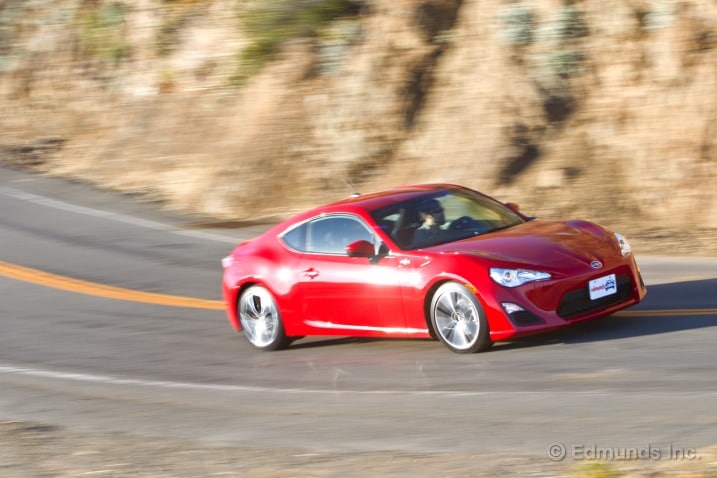
What do you want to know about?
- In the Rough
- Like The New Commerical
- Engine Break-In Procedure
- Love the Details
- Patience is a Virtue
- Good Shifter, But Not Great
- The Boxer Briefs
- Wheel of Misfortune
- Leno Talks FR-S
- Scion Talks Torsen Limited Slip Differential
- Shape Association
- I Expected More
- Track Tested
- Suspension Walkaround
- Rear Seats Of Little Use
- Photographic Evidence of Usable Backseat
- Looks Fast
- A Look Underneath
- A Closer Look at Interior Materials
- Closest Rival?
- Dog Report
- Generations
- Origins
- Singular
- Cooling Things Down Quickly
- I'm a Believer
- The Hyphen Counts
- It Still Works After All This Time
- Battle of the Acronyms
- Inspiring Tuners Everywhere
- Not Looking a Gift Horse in the Mouth
- Wheel Selection Conundrum
- Wheel Selection Conundrum, Part II
- Styling Critique
- Kulinary Mille 2012, Part One
- Spotted in the Wild
- Kulinary Mille 2012, Part Two
- Kulinary Mille 2012, the Finale
- Enfolded
- Good Thing I Can't Drive
- First Service
- Hits All the Right Notes
- What Kind of Engine Does It Have Again?
- The Dread Fits. Just
- Kids Say the Darndest Things
- Adding Lightness
- No Wheel Buttons
- Proper Roof
- My Imaginary Friend
- Apexi RS Evolution Extreme Catback Exhaust
- How To Ruin/Improve It?
- Not A Hatchback
- The New Exhaust
- Hanging New License Plates
- New Shoes
- Digital Versus Analog
- Installing Mag Locks
- Tested. Again.
- New Wheel Lug Wrench
- Nature Hike
- Mr. RX-7 Speaks
- Guy Magnet
- Volk Racing Wheels And New Tires Tested
- Great Cockpit
- Overseas Video
- Signposts to Confusion
- Feels Like a Really Finished Product
- Hottest Clown Car Ever
- Turns Me On/Off
- My Pick for an AE86
- Sales So Far
- Crash!
- Useless Speedometer
- Another Nice Detail
- The Stitching
- Driver Grade
- Tire Impressions
- In the Rough
- My Fairlady
- Retro Rockets
- A Closer Look At Volk Racing TE37SL Wheels
- Pain in the Neck
- How Big Is the Trunk Anyway?
- Sales So Far
- Attention
- Some Perspective
- The Perks Of Short Legs
- Not Getting Used To This Thing
- It Is So Choice
- A Communicative Companion
- No Release
- Begging To Be Autocrossed
- Choosing Between a FR-S or BRZ
- The Firs and the Breeze
- Downforce Overkill Award
- In-Car Engine Sound Video
- Rear Seat Access
- The Satisfying Shift
- The Daily Driver
- Aftermarket Wheel Opinion
- Would You Get The Automatic?
- A Helping Hand
- Quick Bluetooth
- Which Would You Choose
- Back to Basics
- Coffee Is For Closers
- Autocross Prep
- Black Friday Autocross, Arrivals
- Focus, FR-S, BRZ, Mini: What Should Blake Buy?
- Black Friday Autocross, Lap One
- Black Friday Autocross, Lap Four
- Black Friday Autocross, New Tires, Faster Laps
- Off to a Wet Track Day
- Skipping Ahead
- Animal Style
- New to the Fold
- Judging a Coupe by its Color
- ECM Service Campaign
- Track Day Road Trip, Part I
- This Shifts Better
- Wind It Out
- Two Coupes Enter
- Track Day Road Trip, Part II
- Track Day Road Trip, Part III
- Fuel Economy Update for January
- Track Day Road Trip, Part IV
- Oversensitive Airbag Sensor
- My Kind of Sports Car
- FR-S Brotherhood
- Dog Hair Be Gone
- Lock Your Trunk?
- One of the Year's 10 Least Expensive Coupes
- These Wheels Are Great, But I'd Keep the Stock Set at the Ready
- Not Faking the Funk
- Broken Shift Knob Cap
- A Grown-Up Play Date
- Needs New Brake Pads
- Faster Than Ever
- BRZEdit Reflash Tuning By MP Tuning
- Fuel Economy Update for March
- 15,000 Miles
- A Proper Tachometer
- Easy-Cleaning Wheels
- Family Style
- Earthy
- It's a Small Thing, But
- Fuel Economy Update for April
- Cross-Section Impressions
- Scifosi
- Not a Brick
- 15,000-Mile Service
- Caption This
- Transporting Hazardous Cargo
- Fuel Economy Update for May
- Unexpected Features
- Noisy Tires
- Aftermarket Exhaust Looks Loud but Isn't
- Unprocessed, Please
- Stellar Handling
- Fifty-Fifty
- Adding Camber
- Forced Induction
- Track: Yes. Road Trip: No
- Fuel Economy Update for June
- Hanchey Vehicle Technologies Camber Plates
- Hancha Adjustable Rear Lower Control Arms
- En Route To Mazda Raceway Laguna Seca
- Mazda Raceway Laguna Seca Track Weekend
- Innovate Motorsports Supercharger Kit Installed
- Innovate Motorsports Supercharger Kit Dyno-Tested
- Needs Brake Cooling
- Broken Shift Knob
- 20,000-Mile Milestone
- FR-S on GMR. With Supercharger
- Fuel Economy Update for July
- Innovate Motorsports Supercharger Kit Acceleration
- Appropriate Power
- Real-World Acceleration
- 86fest
- Painful Shifter
- Saturday Morning
- Stability Control Now a Must
- Driveability With Supercharger
- Photo Shoot
- Fuel Economy Update for August
- BFGoodrich G-Force Rival Tires Installed
- Supercharger Whine (Video)
- Multi-Purpose Sports Car
- Supercharger Is Subtle but Effective
- Fuel Economy Update for September
- Stability Control No Longer a Must
- BF Goodrich G-Force Rival Impressions
- Fuel Economy Update for October
- Intercooled Innovate Motorsports Supercharger Kit
- Hidden Fuel Filler Arrow
- Does the Gearbox Fit?
- What I'll Miss
- What I Won't Miss
- Fuel Economy Update for December
- Sold to Carmax
- Fixed
- Yellow?
- Wrap-Up
In the Rough
You might have guessed this was coming. We could have told you the 2013 Scion FR-S was headed for the long-term test fleet back in October of 2009. Sure, we didn't know then that the Toyota FT-86 would come to the U.S. as a Scion, nor that it would take three years to make it here, but the idea of a half-Toyota, half-Subaru, lightweight, rear-drive, boxer-powered sports car following in the footsteps of the AE86 hooked us instantly.
Sure, it was entirely possible that this whole thing could go really, terribly wrong, (You read the part about this being a Subaru and Toyota collaboration, right?) but then we drove the Scion FR-S and knew we had to have more.
We didn't exactly scream, "Shut up and take our money!" to the Scion dealer the second its order books opened, but pretty close. Our 2013 Scion FR-S was one of the first ones delivered to our area and now it's all ours for the next 12 months and 20,000 miles.
What We Got
There are very few options available for the 2013 Scion FR-S. You can get it in an orange-ish color, red, blue, black, gray or white. You can get an automatic. You can also get some mud guards, an ashtray, wheel locks and an $845 bespoke premium audio system with a touchscreen.
We got ours in red with a manual transmission. That's it. That's the way it should be.
The FR-S already includes as standard 17-inch wheels, a Torsen limited slip, a 300-watt radio with eight speakers, Bluetooth and USB input, leather-trimmed wheel and shifter, aluminum pedals and, of course, the 2.0-liter boxer four-cylinder that puts out 200 horsepower.
Our Firestorm (red) 2013 Scion FR-S carried a sticker price of $24,930 and that's what we paid. Considering some stories from other high-profile, high-demand, all-new cars, we consider MSRP a fair deal.
Why We Got It
Here's where things get fun. If you've been following the Long-Term Road Tests fanatically, you'll know that we're not only adding the FR-S to the long-term fleet, but we're also getting its sibling, the 2013 Subaru BRZ, at a later date. (We purchased the Scion, whereas Subaru will be loaning us a BRZ.)
In that posting, reader Aspade asked the question on everyone's mind. "The FR-S and BRZ, either one is interesting but why both? I'm curious about the minor differences as well but that doesn't take a year to find out."
True, it doesn't. That's why our 2013 Scion FR-S will be a project car. Two-hundred hp feels good in this car, but we know that TRD is developing a supercharger and, at the very least, HKS and Greddy are working on turbos. Any of those options will make the FR-S feel better. We also know that Tein, Cusco and RS-R are working on suspension kits. There are also tires and wheels coming to market, and intakes and exhaust are on their way, too.
We haven't yet mapped out how far we're going to take this one, but let's just say that the 14.8-second quarter-mile at 93.8 mph, 0.88g skid pad performance and 67.3-mph slalom time we recorded in our first test are the first gates to break down. Hopefully that 85.1dB full-throttle run will get knocked up a decibel or so, too.
Bone stock, the 2013 Scion FR-S is a capable and rewarding car to drive. It's the kind of soul-satisfying experience that doesn't translate well to an Excel spreadsheet and will be lost on the guys without a mountain road or racetrack nearby.
Once this thing finally has the sauce and the grip to keep up with its chassis, however...well, we'll see. Follow along with our 2013 Scion FR-S build on the Long-Term Road Test Blog over the next 12 months as we put 20,000 miles — and who knows what else — on our new toy.
Current Odometer: 677
Best Fuel Economy: 27.2
Worst Fuel Economy: 24.6
Average Fuel Economy (over the life of the vehicle): 26.2
Edmunds purchased this vehicle for the purposes of evaluation.

Have you seen Scion's first TV spot for the FR-S? It's pretty cool with a red FR-S drifting on a two-lane road. I've since watched "Bringing Sport Back" a few times now on YouTube, which is something I can't say about any other Scion ad.

We know you have eagerly awaited the introduction of our 2013 Scion FR-S to the long-term fleet. And we know you've also quietly anticipated this exact moment, when the Scion-recommended engine break-in procedure is staring you in the face.
Yes, there are three zeros behind that one. A 1,000-mile break-in. It is excrutiating, but within reach.

I've only been in our Scion FR-S for a short period of time, and I wasn't even behind the wheel. But I've got to say, the styling of this car is beautiful in my opinion. I don't think there is anything revolutionary about it's look, but it's a simply a smart looking sports car.
think just about anyone would say the exterior looks sporty, but there are a few details I really like about our interior.
First is the stitching found throughout the interior. Red thread set against black is a great look.

I also really like the metallic trim on the dash whose patterned exterior can be found matched to the gauges.


This is probably one of the best looking cars to debut this year. Can't wait to see how it's tenure here at Edmunds plays out.

That's a virtue I sorely lack. I detest waiting for things, be they FedEx Ground, video game release dates, federally mandated waiting periods or break-in periods for cars/motorcycles. Thursday afternoon, the sign-out sheet made its way to my cubicle and I was offered our new Scion FR-S. There was a problem though. It still had 100 miles remaining in its break-in period.
The thing is, I really don't drive all that much on the weekends. I'll generally log more miles in the early-morning hours on my sportbike then collapse on the bed when I get home. But the curiosity surrounding the FR-S got the better of me.
I left my bike alone in the parking lot in order to push past the 1,000-mile break-in. I took my usual canyon route, keeping the revs right around the 4,000 mark. I thought it'd be torturously boring, but to my surprise, this little coupe is a ton of fun to toss into the curves.
The tires are incredibly loud as you approach the limit of adhesion, howling like a dog when a police car goes code 3 in my neighborhood. If you rush the steering by just a little bit, the steering wheel lightens up and you're greeted by a very manageable amount of understeer. Get the timing and speed right, and the FR-S starts to feel lighter — tip-toeing on the contact patches – and glides right down to the apex. Feed the throttle in right before the apex and the tail just barely starts to swing to the outside.
Wow!
This new long-termer is a real hoot to drive in the tight and twisty bits. It's balanced. Not just weight-wise, but overall. The crappy low-rolling-resistance tires let you have a lot of fun without a lot of speed and the engine has just enough power to get you there. This would be a great car for someone who wants to learn how to drive hard. There's plenty of feedback and it doesn't feel like it'll kill you. Yes, this would make a great high-performance driving school car.
When I finished my loop at the L.A. County line, the odometer was reading 992 miles. On my way back down PCH, it tipped over to 1,000. Instead of heading back home, I decided to make one more pass on the first section of my loop. This time, though, I had the freedom of revs.
To my surprise, it wasn't all that more fun than the first pass, where I was limited to 4,000 rpm. It was less of a pain, for sure, but there really wasn't all that much more power for the engine to give higher in the range. Rev-matched downshifts were a lot easier, though, as I didn't have to worry about peaking the tach, and yes, the FR-S allows for perfectly executed heel-toe shifts.
My biggest fear is that when we start modding this car, the balance will shift. Stickier tires may overwhelm the engine and more power may outrun the suspension. Still, I'm excited to see what the end result will be.

In my last Scion FR-S post, I went on and on about how fun it is to drive in the canyons. But don't think that it's perfect. There was one minor annoyance that I found.
Because I was limited to a 4,000 rpm ceiling on my first pass, I was required to climb into fifth gear from time to time. The problem I found was the downshift from fifth to fourth. Something would catch halfway between the gears and keep me from snapping it into the lower gear quickly.
And that's a shame, because the shifter is great everywhere else. The throw is short and the action is crisp. It was just that fifth to fourth downshift. It doesn't feel like a gear mechanism problem that's not allowing me to downshift, rather, it feels like some linkage if binding up.
It's probably not a big deal, since now that it's done with the break-in and dipping into fifth gear on tight twisty roads will likely be rare.

I've always been a fan of boxer engines. One reason: packaging.
Look at all that room on top of the engine. It's just begging for a supercharger, no? But I fear I might be in the minority when it comes to forced induction (sounds like some sort of religious cult kidnapping, but I digress). Personally, I like superchargers over turbos because in my experiences, they deliver more linear power and, I'm somewhat embarrassed to say this, but, they sound cool.
Sure, turbos sound cool if they hiss and pop, but there's something about that high-pitched supercharger whine. Last year's Shelby GT500 had it, but the new bonkers 662-hp GT500 doesn't. And that was a huge disappointment for me.
What do you think? Turbo or Supercharge?

Another couple of days with our new long-term and it's quickly filling the Mustang- and 911-shaped holes in my heart. Yes, it can be said that it pushes all the right buttons with me, but...
...I can't push some of its buttons!
Look at that picture above. See anything that's missing? That's right, no buttons on the steering wheel. Is it just me, or is this a glaring oversight?
Something like this usually doesn't bother me too much, but the FR-S could certainly use them. Why? Because the main audio controls leave much to be desired.

There's an $845 BeSpoke audio upgrade option that has a touchscreen interface, but I'd vote to fill this double-DIN spot with the Pioneer AppRadio 2 head unit. No, it still won't put buttons on the steering wheel, I know, but perhaps the interface would be better and we can install all sorts of performance apps. Dash Command from Palmer Performance looks particularly interesting.

Ever wondered why it's called a boxer engine? Here's Jay Leno to tell you. Seriously. He's joined by Jack Hollis, Scion's VP and General Manager, in a love fest sure to gag even the most sincere enthusiast. We still love the FR-S.

We all know that our new Long Term 2013 Scion FR-S has a Torsen Limited Slip differential. And we all know that that's a good thing. But do FR-S drivers?
For a number of enthusiasts the FR-S is going to be their first rear-wheel drive car and as such, they're going to encounter some new, and really fun, dynamic differences. Scion's taken up the job of teaching them what's what.

If you haven't guessed by now, our Scion FR-S is quickly becoming my favorite long-termer. It's a hoot to drive and looks sharp, but there are two shapes that remind me of other items that hold a special place in my heart.
First, it's that triangle taillight pictured above. Right off the bat, it reminds me of my Yamaha R1. Yes, other sportbikes have a triangle light, but this one is mine.

It also reminds me of Iron Man's Arc Reactor in the second movie and the Avengers. Sweet (if I grow up, I want to be Tony Stark).

Then there's this vent in the dash.

Now, it's not the same shape, but something about it reminds me of the vent on the hood of my Thunderbird. Perhaps I'm stretching now.

Then again, it also reminds me of the laser thing on the original War of the Worlds spacecraft.

This wasn't the most in-depth post on the FR-S, I know, but for some reason I couldn't get these shapes out of my head. Alright, I'm done now.

While the Scion FR-S exceeded my expectation in regard to driving dynamics, I was a little surprised how small the trunk was.
Seven cubic feet. That's it. But before the commenters accuse me of not grasping the fact that this is a "drivers" car, I will say that it has plenty of space for track-day gear. My old track car only had four cubic feet and fit a mini floor jack, my toolbox, helmet, tire inflator and other junk. My snacks and drinks had to go in the passenger seat or else they'd get roasted in the trunk.
But let's say you need to haul bigger items. If this is your only car, you'll probably have to call a friend or rent something bigger (I had to do that on numerous occasions). Still, it's a small price to pay for so much on-road entertainment.

Edmunds.com tests hundreds of vehicles a year, but not every vehicle gets a full write-up. The numbers still tell a story, though, so we present "IL Track Tested." It's a quick rundown of all the data we collected at the track, along with comments direct from the test drivers. Enjoy.
Part of the appeal of the 2013 Scion FR-S — and its twin, the Subaru BRZ — is that it is such a departure from what we're used to from Scion (and Subaru). After all, before the FR-S, the most exciting, dynamic, stylish car and the closest thing Scion had to a driver's car was the Scion tC, which we last tested as a 2011 model.
The 2011 Scion tC had 180 horsepower routed to the front wheels via a six-speed manual transmission. Our long-term 2013 Scion FR-S makes 200 hp and pushes it to the rear wheels via a six-speed manual.
Scion FR-S Scion tC
0-30 (sec): 2.3 2.7
0-45 (sec): 4.2 4.6
0-60 (sec): 6.5 7.3
0-60 with 1-ft Rollout (sec): 6.2 7.0
0-75 (sec): 9.6 10.9
1/4-mile (sec @ mph): 14.8 @ 93.6 15.5 @ 89.9
30-0 (ft): 28 29
60-0 (ft): 114 123
Skid pad lateral accel (g): 0.89 0.82
Slalom 67.5 65.3
Vehicle: 2013 Scion FR-S
Odometer: 1,153
Date: 6-19-2012
Driver: Mike Monticello
Price: $24,930
Specifications:
Drive Type: Rear-wheel drive
Transmission Type: Six-speed manual
Engine Type: Longitudinal, naturally aspirated flat-4
Displacement (cc/cu-in): 1,998/122
Redline (rpm): 7,400
Horsepower (hp @ rpm): 200 @ 7,000
Torque (lb-ft @ rpm): 151 @ 6,600
Brake Type (front): 11.7-inch vented discs with two-piston sliding calipers
Brake Type (rear): 11.5-inch discs with single-piston sliding calipers
Suspension Type (front): Independent MacPherson struts, coil springs, lower control arms, stabilizer bar
Suspension Type (rear): Independent multilink, coil springs, stabilizer bar
Tire Size (front): 215/45 R17 (87W)
Tire Size (rear): 215/45 R17 (87W)
Tire Brand: Michelin
Tire Model: Primacy HP Green X
Wheel Size: 17-by-7 inches front and rear
Tire Type: Summer performance
As tested Curb Weight (lb): 2,738
Test Results:
Acceleration
0-30 (sec): 2.3 (3.2 w/TC on)
0-45 (sec): 4.2 (5.6 w/TC on)
0-60 (sec): 6.5 (8.2 w/TC on)
0-60 with 1-ft Rollout (sec): 6.2 (7.8 w/TC on)
0-75 (sec): 9.6 (11.5 w/TC on)
1/4-Mile (sec @ mph): 14.8 @ 93.6 (15.9 @ 90.9)
Braking:
30-0 (ft): 28
60-0 (ft): 114
Handling
Slalom (mph): 67.5 ( 65.2 w/TC on)
Skid Pad Lateral acceleration (g): 0.89 ( 0.88 w/TC on )
Db @ Idle: 41.6
Db @ Full Throttle: 80.5
Db @ 70 mph Cruise: 66.5
Acceleration: I tried Jacquot's "big revs, massive wheelspin" technique and while it does work to some extent, such excessive wheelspin had the shift light popping on while still spinning the tires, which caused the car to bog slightly after shifting to 2nd. So 5,000-rpm drop-clutch technique with slightly less wheelspin (but still a lot) proved quickest. Shifter is excellent, very precise, easy to jam home with authority.
Braking: Very firm pedal with nice, short travel. The FR-S stays supremely planted and secure during panic stops, and the pedal remained consistent throughout. First stop was shortest at 114 feet. Fourth stop (out of six) was longest at 118 feet.
Handling:
Skid pad: This is a real throttle-steering car, and it's easy to get too much oversteer which would hurt the skid pad number. But, with small, careful throttle changes (not easy, because throttle is a bit abrupt) you can control the car's angle very nicely.
Slalom: This is a very twitchy, tail-happy car in the quick transitions of the slalom, at least with VSC turned fully off. Planted it's not. Which just goes to show that what works fantastically on a mountain road does not necessarily equate to an easy time in the slalom. The VSC Sport setting and VSC fully on seemed very close in terms of intervention. The Sport setting should allow more freedom. And when it freaks out, it stabs the brakes very aggressively.
Vehicle: 2011 Scion tC
Odometer: 883
Date: 08-17-2010
Driver: Chris Walton
Price: $19,995
Specifications:
Drive Type: Front-wheel drive
Transmission Type: Six-speed manual
Engine Type: Naturally aspirated inline-4
Displacement (cc/cu-in): 2,494/152
Redline (rpm): 6,250
Horsepower (hp @ rpm): 180 @ 6,000
Torque (lb-ft @ rpm): 173 @ 4,100
Brake Type (front): 11.7-inch ventilated disc with single-piston sliding calipers
Brake Type (rear): 11.0-inch ventilated disc with single-piston sliding calipers
Suspension Type (front): Independent, MacPherson struts, coil springs, stabilizer bar
Suspension Type (rear): Independent double wishbone, coil springs, stabilizer bar
Tire Size (front): P225/45R18 91W
Tire Size (rear): P225/45R18 91W
Tire Brand: Yokohama
Tire Model: Avid 834
Tire Type: All season
Wheel size: 18-by-7.5 inches front and rear
Wheel material (front/rear): Cast aluminum
As tested Curb Weight (lb): 3,078
Test Results:
0-30 (sec): 2.7 (2.8 w/TC on)
0-45 (sec): 4.6 (4.8 w/TC on)
0-60 (sec): 7.3 (7.5 w/TC on)
0-60 with 1-ft Rollout (sec): 7.0 (7.2 w/TC on)
0-75 (sec): 10.9 (11.1 w/TC on)
1/4 Mile (sec @ mph): 15.5 @ 89.9 (15.6 @ 89.5 w/TC on)
30-0 (ft): 29
60-0 (ft): 123
Slalom (mph): 65.3 (62.3 stability control on)
Skid Pad Lateral acceleration (g): 0.82 (0.82 stability control on)
Db @ Idle: 41.8
Db @ Full Throttle: 74.8
Db @ 70 mph Cruise: 70.6
Acceleration Comments: Traction control can be avoided with heavy clutch abuse on the launch, but it kills the 1-2 shift. With trac off, the best run "hazed" the tires and allowed (almost) a 1-2 chirp. Long travel on clutch pedal before bite, and medium-length shift throws. Not horrible, but not a Civic either.
Braking Comments: Reasonably flat, always straight, minimal fade. In other words, a textbook "average" performance.
Handling Comments:
Skid pad: With ESC off, there's a healthy dose of understeer. With ESC on, I can hear/feel the brake being applied, but it didn't help with the ultimate result. Steering is vaguely artificially made heavier at this speed.
Slalom: With ESC off, the 6MT tC wasn't as threatening to break the rears as loose as the 6A — maybe I was prepared this time, but it felt more predictable nonetheless. I used the same tiptoe in and whack the throttle for the exit. With ESC on, it dabed a brake at each cone, limiting my ability to go much faster.

Our 2013 Scion FR-S is destined to have new parts thrown at it during its year with us. This may be the first time it finds itself perched on our Rotary 2-post lift, but it will certainly not be the last.
With that in mind, let's consider this early 2013 Scion FR-S suspension walkaround to be a historical documentation of its pristine "before" state. What sort of starting point did the Toyobaru mash-up give us?
And I suppose it goes without saying that everything we'll see on the following pages applies more-or-less equally to the new 2013 Subaru BRZ. Any suspension tuning differences that exist will be pretty much invisible.

MacPherson struts prop up the front end, which is no surprise considering that's what it says on the spec sheet.

Here the lower control arm (yellow) shows itself to be a simple one-piece steel stamping.

Rear drive machines usually steer from the front because a longitudinal engine placement allows room for the steering shaft to run alongside the engine block. But the FR-S and BRZ steering linkage (black) acts from behind the front axle centerline for reasons that will soon become clear (if you haven't guessed them already.)
Meanwhile, this drop link (yellow) connects the 18mm front stabilizer bar directly to the strut housing for maximum efficiency.

So-called rear-steer is necessary here because the Subaru H-4 boxer engine has a cylinder head (white) blocking the pathway to front-mounted steering.
Also, if you've heard the FR-S or BRZ described as a "front-midengine" car, the person who said so is misinformed. Here you can clearly see that a good chunk of cylinder head sits ahead of the front axle centerline. The engine can't go any farther back because the rear-mounted steering needs a place to live. Besides, even if the motor was far enough back to qualify I despise the term "front-midengine" and consider it so much marketing BS and revisionist history.
Keep the discussion focused on what matters — weight dsitribution — and I'll listen. On that front our 2013 Scion FR-S measures 55-percent front/45-percent rear on our own scales.
Meanwhile, efforts to keep weight down and the front end of the car super low have resulted in a forward-facing lower control arm (yellow) and a simple crossmember (green) instead of a full perimeter subframe. A rear-facing structure (orange) braces the crossmember and carries the pivot bushings for the stabilizer bar.

This view shows how an H4 boxer cylinder head (white) acts as an impenetrable barrier that blocks the way for front-acting steering. It also shows how the Scion's rear-mounted steering rack's input shaft (yellow) prevents the engine from being located any farther back.
Meanwhile, the steering rack lacks any hoses, pipes or wires and looks 100-percent manual. Since this car has electronic power steering (EPS) and we don't see any evidence of that here, that can only mean one thing.

And that thing is this: the 2013 Scion FR-S and Subaru BRZ use column-mount EPS. This is the area immpediately under the dash, just above the pedals. It's a pretty small module, which isn't a big surprise, I suppose, because this unit does not overpower the steering overmuch and take away all feel.
Since the steering rack itself is truly manual, I wonder what it would feel like (apart from heavy parking effort) if this were removed and replaced with a straight shaft for zero assist on the track? The number of warning lights that would result on the dash would be truly alarming, I suspect.
No point in trying that experiment, I think, because this steering feels pretty good right out of the box.

A coil-over spring is nothing new where MacPherson struts are concerned. This one differs in that the springs are skinny and concentric with the shock so they can fit in behind the wheel and tire. Typical sedans and crossovers have offset springs with lower springs seats that hover over the top of the tire. That approach allows for higher capacity springs and makes room for the usual transverse engine but demands a tall fender.
Just like the case of the Porsche 911 and Cayman, the use of an inboard strut/spring layout here on the Scion FR-S and Subaru BRZ makes a very low hoodline possible.

Here's something you've never-ever seen on a Scion: the front hub is not connected to a drive axle. I'm not sure if this is a Subaru first, too — they've been around a lot longer — but I can't remember a recent example.
On the subject of recovering Subaru purity with an AWD version of the BRZ, forget it. The engine would have to sit several inches higher and farther forward in order to give the drive axles a suitable place to poke out of the transmission, at which point we'd have a Subaru Impreza.
As for the brakes, we can clearly see dual pistons built into the sliding front calipers.

The calipers contain the first of many instances of the word "Subaru" cast or stamped onto the underside of our 2013 Scion FR-S. I can't remember seeing the Scion or Toyota logo anyplace.
Incidentally, those brake rotors are ventilated cast iron units measuring 11.7 inches in diameter.

Up top, a pair of stress bars reinforces the shock towers and triangulates them with the firewall. We can't help thinking that this layout also leaves room for a Subaru top-mount intercooler and hood scoop. Just sayin'.

No, the underside of the engine is not usually this exposed. I removed a broad undertray that was held on with about a dozen bolts and a handful of clips to get this view of the front suspension crossmember, oil pan and exhaust system.
As you can see, a broad heat shield covers the exhaust manifold that spans the car and collects exhaust gasses from each bank of cylinders. From there it feeds through a series of two catalytic converters (yellow) before it heads for the transmission tunnel.
Note to DIY oil changers: it's probably hot down here for quite awhile after you shut off the engine.

Scion and Subaru call this a double wishbone rear suspension, but we can only see the upper wishbone in this view.

And we can only see the upper one from this angle, too.
This is not a double wishbone rear suspension, despite what the initial Scion and Subaru press kits may say. Well, I guess we could say there are two wishbones if we count one from the left and one from the right, but that's not how the game is played.
We've already established there is an upper wishbone (yellow); that makes one. But down below there are two independent lower links (green), each with it's own bushing and pivot axis. There's also a short toe-control link (white) that is parallel to the main lateral link.
While the two lower links may approximate a lower control arm in spirit, they are not a single piece and do not share a common ball joint or pivot axis. Two discreet links like these do not add up to a wishbone. They just don't.
As of this writing, Scion and Subaru have not yet responded to my inquiry about their use of the term "double wishbone" on their spec sheets. I suspect a translation problem somewhere along the line.
And so the 2013 Scion FR-S has a multinlink rear suspension that employs a single uppper control arm and a trio of (aka multiple) links. Not that there's anything wrong with that, of course.
No matter what you call it, the suspension that Scion/Subaru has fitted back here is quite good out on the road.

Here's another view of the Scion FR-S and Subaru BRZ multilink rear suspension: upper wishbone (yellow), toe link (white), two lower links (green).

Another view of the same bits from a different angle. You've probably noticed by now that all the main bits are steel. The car's isn't meant to be expensive and its small size helps keep unsprung weight in check by the mere fact of its tidy dimensions. Still, more could be done. I guess that's what the aftermarket is for.

Here's a series of isolated views of the parts, starting with the upper wishbone. You can just make out the inner pivots and the subframe they attach to under the lip of the red unibody.

The toe-link has an eccentric cam at it's inner end (yellow) for easy static toe-in adjustment.

This view shows that toe link eccentric (yellow) fron another angle. What is doesn't show is an eccentric at the inner end of the main lateral link (green) for camber adjustment, because there isn't any.
Yes, it seems there's no factory provision for camber adjustment on a car that's likely to be lowered, modified, slalomed and otherwise track-driven by enthusiasts around the world. The aftermarket has already filled this void.

The beefy main lateral link carries most of the important vertical and lateral loads. The FR-S's 14 mm stabilizer bar conects close to the middle at something like a 0.55-to-1 motion ratio, while the coil-over spring and shock assembly attaches farther outboard at 0.75-to-1 or thereabouts.

Rear braking is handled by a single-piston sliding caliper and 11.5-inch ventilated cast-iron rotors. The prominent hat section indicates the parking brake is a secondary drum brake hidden inside.

That's a Torsen limited slip differential right there. It hangs from four bushings, with the rear pair separated into distinct functions: the right one supports it in the vertical direction and the left one regulates side-to-side motions.

The FR-S rides or 215/45R17 Primacy HP summer tires that come straight off the Prius options sheet. The US-spec Prius doesn't offer them because summer tires are taboo on mass-market cars here in the US. But they do exist in other places, such as Europe, so the FR-S was able to parts-bin them.
They're not high-performance summer tires by any means — they've got smallish tread blocks and numerous grooves to supress noise. Still, they work surprisingly well right out of the box. Any effort on Scion's part to make something more exotic may have been wasted, because they know that a large number of FR-S buyers are simply going to bin whatever the car comes with and buy something wider within the first month anyway.

The mounted assemblies are not terribly heavy at 40.6 pounds apiece.

Those of you shopping for wheels may want to know that the stock ones are 17-by-7 inches with 48mm of offset. There seems to be room for more tire under the Scion's fenders, which have lips that feel like they're pre-rolled in the most critical area.

Don't plan on sitting behind me when I'm driving the 2013 Scion FR-S. The front seatback touches the rear seat cushion, you see. I could slide my seat up a notch or three for you, but there's no point. That's not enough to do anyone any good.
To me it looks like the driver would have to stand well under 6-feet tall before an attempt to carry someone in the seat behind would stand the slightest chance of success.
On paper there are 29.9 inches of legroom back there, a very low number that nevertheless seems laughably high and utterly inaccessible unless the seat is positioned a full six inches farther ahead than I have it. Your knees have to go someplace, right?
For me the FR-S is a 2-seater, plain and simple. The same is probably true for many of you, too.
Do I care? Nope. To me this is the hard top Miata — with good front legroom — that Mazda never had the cajones to build. I want one.

OK editor Dan Edmunds just blogged about our 2013 Scion FR-S's tiny backseat but I present Exhibit A that a tall-ish guy can fit back there. The above photo is of my friends ice cream shop Matt and Nick trying on the FR-S for size. Matt (in the backseat) and Nick are both 5'11".
As you can see, Matt's knees come up against the back of the front seat and Nick's are pressed against the dash. They're not necessarily forced into a fetal position but it is still awfully cozy. Matt said that the backseat wasn't unbearable and he could manage taking a short trip back there. But he has a long torso so had to scrunch down a bit or lean his head back to keep it from touching the top.
The seat itself reminded him of an airline seat in that it didn't feel like a "real seat" but like it was stuffed with cheap foam.
Meanwhile, up front, despite glovebox contact with his knees, Nick said he was comfortable.
The two said they wouldn't want to take a road trip to Vegas in it, but that fitting four around town was doable. If anything, the target market, guys like these (young single men), will probably keep those rear seats folded down most of the time. Still, it's nice to have the option of two extra seats in a pinch.


OK, you guys already know this but I'll say it for the record. The 2013 Scion FR-S isn't fast. It handles well, it's fun to drive and it looks good but it's not a fast car. (Hopefully that will change during its time with us. Ahem, turbo kit.) And yet this weekend when I had it as my daily driver, a 'Mustang driver challenged me to a race on the freeway.
Here I was minding my own business, cruising behind a minivan in the second to right lane, when I see this '90s Mustang come speeding up in the far left lane. He must have been going 20 mph faster than everyone else.
Then I see him in my peripheral, just driving alongside me. I didn't look at him but I knew he was looking at me. Then I switched lanes to the right lane since I was exiting soon. That's when he ducked in behind me, and then he jumped back into his original lane. WTH? He continued to taunt me til I finally exited. I assume he saw that "my car" was shiny new as it didn't have its plates yet and figured I'd want to break it in? I don't know, I don't speak "guy."
I received similar reactions from other drivers when I pulled up alongside them at stoplights. Light turned green and they stomped on their accelerator. Whatever.
Reminds me of this Toyota Celica ad.

Last week we posted a Suspension Walkaround of our long-term 2013 Scion FR-S. Well, while it was up on our 2-post Rotary Lift we also banged off some shots of its underbelly. Enjoy.







You've seen plenty of pictures of the exterior of our new long-termer, the 2013 Scion FR-S. Here's a closer look at its interior materials. What do you think? What you'd expect of a $24,930 car?




For comparison's sake, here are photos of the interior materials of possible cross-shopped cars:

Subaru BR-Z notwithstanding, I contend that the closest competitor to the Scion FR-S is the Hyundai Genesis Coupe. Price-wise, they're right in the same ballpark, but in other areas, each car has its advantages and drawbacks. Which to choose?
The Genesis Coupe is easier to live with, I think. It has a bigger trunk, a better interior and is quieter in many respects. If you go on numbers alone, it's practically a dead heat. Acceleration, braking and handling are virtually a tie (when compared to a 2.0T R-Spec Genesis we recently tested, not the base 2.0T).
The FR-S is my choice, though. It's more fun to drive and that is the top selling point for a car I'd purchase. I don't find the Genesis as confidence-inspiring as the Scion and I think the FR-S benefits from more attractive exterior styling when compared to the facelifted Hyundai.
But let's not forget about my beloved Mustang. For around the same price, you can get a 305 hp V6. With a redesign on the horizon, the next Mustang could be a game-changer, but this could be wishful thinking on my part.
What would you pick?

She looks happy, doesn't she?
But actually...

The 2013 Scion FR-S isn't ideal for 52-plus-pound dogs but try doing this in a Miata.


In so many ways, our FR-S reminds me of the earlier Toyota Celicas. Sure, it's lighter, faster and better in every metric, but I think its soul remains intact.
My brother is a Celica guy, much the same way I am/was/will-be-again a Mustang guy. In 1984, he picked-up a new Celica GT-S that looked exactly like this one (louvres and all). I admit that as a teenager, I thought it was pretty rad. He loved that car, polished it endlessly and treated it well. It was stolen and recovered, survived two accidents and when he finally sent it out to pasture, he had logged 240,000 miles on the original engine. He then bought a 2002 Celica GT-S and now has 145,000 miles on it.
Had we been born 30 years later, I think the Scion FR-S would be his car of choice today. It's very capable as a sports car, yet relatively easy to live with. It's fast enough to have fun, but not so much to be a danger or menace. It's a lust-worthy object that isn't out of reach and it's what Toyota has been in need of for a long time. It is, in my estimation, the reincarnation of the Celica.
Scion positions it in the lineage of the Toyota Corolla GTS (AE86), but my associations with Celicas past have me resisting that notion. In any case, I think my brother should consider an FR-S if he ever decides to unload his current Celica. Unless, of course, a new Celica or Supra is on the way.
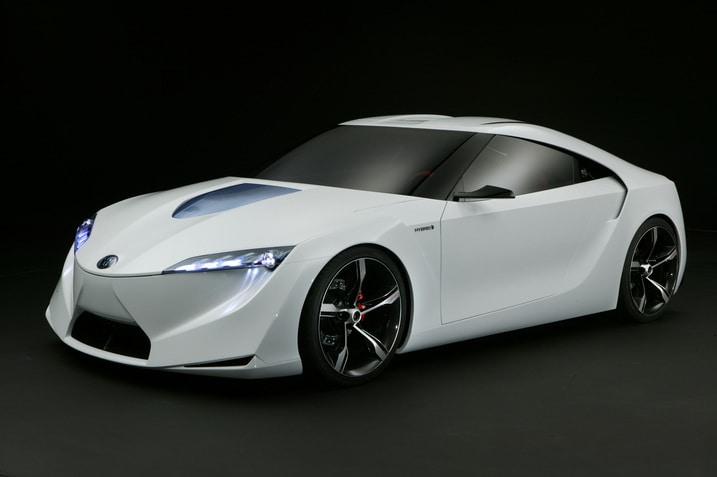
Back in 2007, Toyota unveiled the FT-HS concept. When I saw it up close, I was struck by its sharp lines and compact, athletic stance. It always seemed to be in the back of my mind.

I see a lot of the FT-HS's underlying form in the FR-S, but the beveled edges have been rounded and smoothed over. I still think the FR-S is an attractive little coupe, but imagine if the FT's lines had survived. Yowzah!
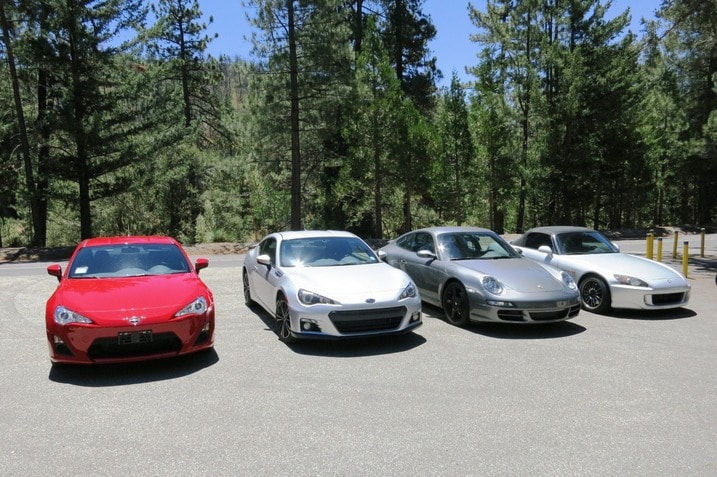
Okay, this car is the real deal. Up until this past weekend, I'd only driven an FR-S for a few hours in Vegas, on track and in town for our Full Test. It'd made a strong impression, but there's no replacement for driving on familiar roads on your own time. This past weekend I had our longterm 2013 Scion FR-S in my care and — unlike few real-world, attainable cars in recent memory — I didn't want to stop driving it.
After a somewhat leisurely drive up Angeles Crest on Saturday with some friends (who brought the above BRZ, 997 and S2000), I made a more vigorous repeat trip on Sunday. It just works. The driving position, the terrific seats, the perfect pedal placement, the flat cornering, quick steering... it all comes together cohesively. Quite simply, there is nothing like this car anywhere near its price.
I am smitten by a $25,000 Scion.
Here's the thing — its brilliant chassis is also just begging — screaming — for its latent potential to be unlocked. Clearly it can exploit more tire (I like Dan Edmunds' comment that the FR-S wears the most all-season-y summer tires in the world) and more power (really, more midrange punch). As this is (or will soon be) a project car, the trick will be doing so while keeping its balance intact; without making it one-dimensional. Should be fun. Already is.

Blog commenter christople asked how well our 2013 Scion FR-S's A/C handles the heat. And after enduring several hot days recently, including an excursion to Angeles Crest during the hottest part of the day, I have to say that I'm impressed by how quickly the Scion's air-conditioner cooled down the cabin. Even after the car was left sitting out in the hot sun for several hours the A/C turned on full blast did away with the hellish heat within seconds, OK, maybe minutes.
The air got nice and frigid. So much so that I found myself quickly turning down the fan to a more subtle "1."
In terms of how the car handled being driven hard with the A/C on full blast, editor JayKav said the engine's A/C load control could be better as you notice the A/C compressor turning on and off when you drive it. The idle dips noticeably every time the A/C compressor turns on.

I am not a sport compact kind of guy. I am definitely not a tuner guy. As such, I'm not exactly going to be fitting in at the FR-S/BRZ Owners of America annual barbecue.
Having said that, I fell in love with our Scion FR-S before I even left the parking garage yesterday en route to the canyons of Malibu. In short, you need to believe the hype: the FR-S is epically fun, easy to drive and surprisingly comfortable. This is just an entirely different animal from the norm and I've honestly never driven a car quite like this. The Miata comes closest, but it's still a different species. Ditto the S2000 and its high-strung engine.
It's the rear-wheel drive. It's the narrow gates and firm mechanical engagement of the gearbox. It's the tiny dimensions and the front fender flares that make the car even easier to place in a corner. It's the talkative steering, the seat-in-the-pants communication and easily detectable limits. It's the engine and its sharp throttle response, rewarding noises and useable powerband. It's the perfectly contoured seat, the spot-on driving position and the fact that I actually fit comfortably in the thing (that's a minor miracle for a small Toyota OR Subaru). It's the fact it's incredibly easy to drive — be it aggressively or just puttering around town. Hell, it's even the strong sound system.
The Scion FR-S is quite simply a grand slam and one of my favorite cars, period. The fact that it's the result of a union between two brands that typically do absolutely zilch for me from a car guy perspective makes it even more impressive. I'm a believer.

I received this mailer the other day — with a coupon attached! Apparently, there's no copyright infringement because of the hyphen.

It's been almost eight months since I got my first seat time in this car. Okay, it was a BRZ prototype that I drove late last year, but close enough. Back then, my time was limited, just a handful of laps around Subaru's proving grounds. Yet even then, it felt like the sports car we had been hoping for.
I was hesitant to call it great until I got behind the wheel again. I also wanted to see if there was much of a difference between the BRZ and FR-S, not to mention what my fellow editors thought about the two cars.
Now that I've seen the various comments on our FR-S, I'm confident my initial instincts were right. And after driving our FR-S last night, I'm glad to see that all the things that felt right about that BRZ prototype are still here. The precise steering, the predictable chassis and the mechanical shifter are all intact. It's hard to pick out the tuning changes of the FR-S versus the BRZ, so I'll wait until I can drive them back to back to compare.
Minor differences aside, this car is a winner. If you're worried about getting your doors blown off by a V6 Camry then this isn't the car for you.

Next week kicks off the second annual Kulinary Mille. I noted a few weeks back that I was planning on taking our long-term NSX. I've had a change of heart.
I still have plenty of love for the NSX, but I simply can't get enough of the FR-S right now. Add that to the fact that the Scion has a functioning stereo with iPod integration and is less likely to leave me stranded somewhere near Maricopa, and this was a no-brainer for me.
Last year, I took our Mustang GT, and it held its own against a collection of Bentleys, Ferraris, AMGs and a Corvette ZR1. I'm confident that the FR-S will be able to set a respectable pace in the canyons, but it'll be clearly outclassed on the highway. And that's fine by me; I'll let them clear the road of Highway Patrolmen as I cruise at sensible speeds.
The Mille starts at the Petersen Automotive Museum Thursday morning and finishes at the Grand Havana Room in Beverly Hills on Sunday. I won't be there for the whole tour, but I'll certainly have my fill of fuel and food.
I'll be tweeting from the road when I have a chance to stop. Follow me, won't you? @Mark_Takahashi

Popped open the hood of our 2013 Scion FR-S for the guys at Apex Speed Technology in West L.A. And, is that a twinkle in their eyes?

When I first saw this odd-looking insert (on the right) in our 2013 Scion FR-S, I decided to do some researching. What is it? Pen holder? Art supply caddy? Parking garage card holder?
I didn't see it on the Scion site or even the aftermarket accessories section.
Turns out it's a multi-function electronic device and coin holder (FT86club.com) and includes slots for the different-sized devices out there. And since our FR-S was in the first shipment, it came with the nifty accessory.
Out of curiosity, I checked with Associate Vehicle & Content Coordinator Rex Tokeshi-Torres to see if our car came with anything else (besides its inherent awesomeness) since I heard that the actual First 86ers were given a lot of schwag like a collector's pen (with instructions), FR-S branded clothes, car cover and even entry to the VIP tent at Formula Drift.
"Nope, that's it," Rex replied. Ah well, I'm not too sad about that since it's not my car anyway. And judging from FR-S forums, none of the post-86er FR-S owners are all that broken up about it either. Just happy to be driving their new car which they seem to love lots.

Use of parts-bin componentry makes the 2013 Scion FR-S affordable. And frustrating when it comes to aftermarket wheels.
For Project FR-S' replacement wheels, we're sticking with 17" diameter in order to have some sidewall for bump absorption, keep unsprung mass gains low and to retain access to a variety of tire choices. What we'll be doing is stepping up to an 8.5" or 9" width (up from the stock 7-inchers) to really take advantage of wider rubber. 245/40 is the likely bogey. Aftermarket 17x8.5- or 9-inch wheels are a dime a dozen. Easy peasy. Right?
However...
The FT86 twins use off-the-rack Subaru suspension bits including steering knuckles and rear upright assemblies, and Subaru likes to use 5x100mm pitch circle diameter (PCD) for its wheel studs. And so it is that the FT86 is plagued with an oddball PCD. Much more common for 5-lug wheels is a 114.3mm PCD (which also allows for a larger wheel bearing than a 100mm PCD, but I digress). The FT86's 5x100 PCD requirement narrows the field of aftermarket wheel options.
And though there are cars out there with 5x100 PCD, they're almost all FWD and hence employ relatively low offsets. Aftermarket wheels originally made for these front-drivers could in theory be used on an FT86, but it's generally best not to stray too far from the stock offset (48mm in the FT86's case) if you like the way a car's steering feels. And in the FT86, it's pretty darned good.
I consider wheels safety equipment, and so I'm trying to stay away from cheap, crappy offshore wheels and instead sticking to reputable brands. Some of those reputable brands are Japanese, which you'd think would have a big headstart on FT86-specific wheel fitments as the car was released to them well in advance of the rest of the world. However, many of these FT86-specific fitments have not yet made the voyage overseas from Japan to Americaland.
So it turns out that as of yet there are few suitable aftermarket wheel FT86 fitment options that fit our admittedly narrowly-defined bill. But we're working on it.
And we haven't even considered aesthetics yet. Oldham likes a lot of dish in his wheels. I like simple-spoked designs; function over form, that kind of thing.
What about you — which aftermarket wheels have really resonated with you over the years?

Image by http://danyutz.deviantart.com/gallery/#/d4hn9sa
When I broached the subject of aftermarket wheels for Project FR-S, our 2013 Scion FR-S, it quickly became apparent by a few of the comments that more background was needed.
First, why add grip? Won't this ruin the car's balance?
Oh, absolutely it will. In fact, the argument could be made that the stock FR-S already has too much grip for its grunt. Adding more tire will only exacerbate the need for more power... an area we don't plan on ignoring either. As of yet there isn't much in the way of power adders, but we want to keep the ball rolling anyway.
Project cars are a stepladder no matter which aspect you tackle first.
Why not do something more modest, like 225s on stock wheels?
That's... uhmm.. zzzz... sorry, dozed off there for a sec. I'd turn that question around and ask: why not give it something it can really grow into? This is a project car. It's supposed to be fun, something with which to experiment and share those observations and tradeoffs.
But for sure there's no way we're keeping the stock wheels on this car. Those we'll leave for our upcoming BRZ, which will remain stock.
Wheel widths. Why go wide? Why not just put wide tires on narrow wheels?
When it comes to grip and steering precision, wider wheels make a significant difference. The reason is multifaceted. For a given tire width, a wider wheel "preloads" the sidewall with tension, reducing the amount of sidewall deflection when the driver makes a steering input. This reduces yaw delay.
Wider wheels provide more uniform contact patch loading. The same tires on narrow wheels require higher pressures as a means of "support" to offset distortion-induced camber loss. Higher pressures reduce the tread's ability to conform to the road surface, reducing grip. Wider wheels require less pressure, increasing grip. Less reliance on static camber is important too, since with the stock suspension we're currently limited on our ability to adjust camber.
The wider wheel also provides a larger internal air volume. Especially during track use, this reduces temperature excursions, so the tire pressure remains closer to optimum more of the time. OEMs like air volume because it provides sound damping (reducing that tire 'pinggg' sound you hear with baloney skin-type fitments), but we don't really care about that in this instance.
It is true that, all else equal, a wider wheel is usually a heavier wheel, and unsprung mass is bad, m'kay? It's important to use quality wheels not only for safety reasons but also to minimize the addition of unsprung mass.
Wide tires will kill the steering!
Wider tires will tend to follow cambers more closely, as they put more tread width on the ground. We'll see how significant this really turns out to be. Past experience with more extreme changes (like Project Miata for example) than what we're planning with this car suggests it's something you can notice, but doesn't amount to a big deal.
More important when it comes to steering is to retain a reasonable / stockish scrub radius, which is why you don't want to drastically reduce the wheel offset compared to stock. Sure, small offsets push the wheels out more and look tougher but that's not a tradeoff I'm willing to make.
OMG aren't you going to have super skinny sidewalls and a huge rolling diameter at the same time which will make your gearing tall and your teeth fall out?
Aspect ratio is apparently a very misunderstood topic, as the earlier comments revealed. When I say that the new tires will (probably) be 245/40-17 rather than the stock 215/45-17s, the drop in aspect ratio (i.e., going from 45 to 40) does not automatically mean that there is any reduction in sidewall height. In fact, this change in tire size results in almost no change at all in sidewall height (and rolling diameter) compared to stock.
Remember, this is a ratio — the stock sidewall height is 215mm times 0.45, or 96.8mm. The replacement tires' sidewalls are 245mm times 0.40, or 98mm. In terms of overall rolling diameter, this amounts to a difference of just a tenth of an inch; a negligible difference.

In one the earlier posts, a reader asked when I might give the FR-S the ol' Photoshop treatment. Here's the problem: I wouldn't change much.
Overall, the FR-S styling pleases me. It's a clean and compact basic form. It's not overdone, and with only a few exceptions, there aren't any superfluous accents that concern me. The design also doesn't seem as though it's trying too hard – it's not trying to be anything it isn't. It's genuine.

If I were to change anything, it'd be to eliminate the badge on the side and blend that panel into the quarter panel. I'm also curious to see what a blacked-out A-pillar would do for it. I like the wraparound look for windshields.

What do you think? Would you change anything?

This year's assembly point for the Kulinary Mille was the Petersen Automotive Museum. How fitting, and convenient, since I live all of two miles from it. As such, I was one of the first drivers to show up. The collection of cars that arrived shortly thereafter, was impressive, to say the least.
Within a few seconds, I had the sinking feeling that I brought a knife to a gun fight. A 200-hp compact car with Prius tires didn't exactly instill me with a lot of confidence, but I knew I could at least keep up in the corners with some of the cars. As for the silver Ferrari Enzo, FF and pair of red 458 Italias? Not so much.


After a quick donut break and a friendly address by the Museum staff, we were off. Just as I released the parking brake, I spotted a young blonde sprinting towards my car. Apparently, the car her friends were in was full and she needed a ride.


"Uhhhhhhm, I don't know if you really want to ride with me," I said, "do you get carsick or freak out on rollercoasters?"
"Hell no!" she replied, "I love going fast and I love rollercoasters!"
Reluctantly, I moved all of my gear to the back seats. I say reluctantly because I figured I'd be cleaning up lady barf or have to slow my pace, or both. She was bubbly and cheerful now, but I feared what she might turn into later.

We made a little mini tour into Beverly Hills on our way to the 405 Freeway. Plenty of heads were turned as we cruised up Rodeo Drive. Some of the staff from the Cheese Store of Beverly Hills (it's closely associated to the Mille) stood on a corner and we made a little noise for them as we went past.
On the twisty part of Sunset Boulevard – a section I know all too well – I took a few turns aggressively to gauge my passenger's reaction. She reacted with an enthusiastic, "aaaaalllllllrrrriiiiiiight!" Hmph, she's cool with it. My fears were unfounded.
Quite a ways north, I stopped for gas before we hit Lake Hughes Road, a challenging mountain pass with choppy pavement. I went looking for a reputable gas station instead of an off-brand and got separated from the rest of the group. No biggie, as I knew where we were going in case I couldn't catch up to them.
In the first section, the FR-S struggled with the uphill climb. If anyone asks if this car needs more power, the answer is "YES." Once the twists and turns hit, the FR-S strengths really began to shine. It railed through the turns with precision and the brakes never exhibited any fade. Just as we closed in on Pine Canyon, I saw a glimmer of Ferrari Red. We caught them.
Actually, we caught up with some of them. I tucked-in behind a Ferrari California, Ford GT500, Cadillac CTS-V, the BMW 640i and a 1986 Porsche 911. I made a pass on the Ferrari and was about to start picking them off one by one when the lead car missed a route turn. We all pulled over and then I assumed the lead as we backtracked.
I kept the speeds reasonable, after all, the Scion's lack of power and less-than-sporty tires could only do so much. Still, I managed to open up a sizable gap every now and then. As we neared the end of this loop, the road became very wide and very sandy. I slowed way down and had some fun goosing the throttle to get the tail whipping around. Good times.
At the next gas stop, the other drivers were very complimentary, telling me that I had the Scion floating and dancing through the turns. They all had the power to pass me, but left me up front because it was fun to watch, they said. That, and I was the only one who knew where we were going. Regardless, my ego was inflating to dangerous levels.
I've prattled along enough for now. I'll post part two shortly.

This red 2013 Scion FR-S was spotted on my way to work this morning and since it's the first I've seen, apart from our long-term FR-S, I had to snap it. Such a head turner.
Judging from how well Scion's halo car is doing for the brand — Toyota sold 2,684 FR-S cars in June boosting Scion sales to an all-time high (USA Today) — I'm betting it's just a matter of time before we see more FR-Ses on the roads.
Have you spotted any in your area?

In the last Kulinary Mille post, I left off at the end of a fun canyon drive. After that, things got decidedly boring. This is the part where bugs start collecting on the grille.

We ended up somewhere near Gorman and the 5 Freeway. There were no shortage of smiles as we all participated in a little gas station bench racing. After a quick break we headed north on the 5, right through the rest of the Grapevine. From there, it was onto the Maricopa Highway, a desolate straight road through miles and miles of almond farms and scrub brush.
The road began to twist and turn as we made the climb over the mountains, then settled back to the valley floor. There were plenty of 18-wheelers on the two-lane roads and that required some passing maneuvers that proved challenging for the FR-S.
Heat and altitude certainly didn't do the Scion any favors. Passing the big rigs required me to hang back a ways while I waited for the right time to pass. I had to downshift two gears and get a run up behind the trucks to pass them with any sort of confidence. Throughout these passes, the engine drone was far from melodious or aggressive. To be perfectly honest, this engine sounds awful. I hope there's an exhaust system that will give it some teeth, but I have a feeling it'll just make it louder.
Just as before, the pace I set was safe and reasonable. The drive towards the 101 freeway was mostly straight, interrupted by a few sweepers. As we neared Santa Maria, the scenery got a lot more interesting and the roads began to twist again.
Before we knew it, we pulled into the Santa Maria Inn. And preparations for the Kulinary part of the Mille began.

The smell of burning charcoal wafted through the courtyard and drew me in like a moth to a flame. I was immediately greeted by the first of many cocktails (one of the sponsors of the event was Russian Standard Vodka). I figured I better get the photos I needed while I could still focus.



On the menu: deviled eggs with crab meat and Sriracha hot sauce, skewered lobster tails and Wagyu tri-tips. Vegans need not apply.



The evening was filled with rich conversations that appropriately ranged from cars and motorcycles to epic feasts. Cigars from a little island nation in the Caribbean were distributed freely and I once again began to feel like a one-percenter. The revelry headed into the bar afterwards and thankfully, the long day of driving had a lot of people retiring early — myself included.

I awoke on day two of the Kulinary Mille in tip-top shape. Considering the revelry from the night before, I admit I was a little disappointed. In any case, I had some decisions to make.
My original plan was to join the day-two drive which circled all around California's central valley, then participate in some dirt oval racing. Unfortunately, the dirt track part of the event was cancelled. I held off on my decision until I finished breakfast.
To my surprise, there were plenty of other Mille participants already in the dining room, looking no worse for the wear. Some had the same story I had to tell: had a great time, ate like Henry the VIII, had a few beverages and turned in early. A few had a more adventurous night that involved trying to make the Jack in the Box drive-thru a "walk-thru" to no avail. It sounded like fun, but was glad nonetheless that I found my way to my room before that went down.
I decided to pack up and head back to Edmunds HQ to get a little work done; maybe even play a round of golf if I could power through my assignments. The drive south on Highway 101 was as picturesque as it always is, with rolling hills dotted with hundred-year-old oaks and expansive views of the Pacific Ocean. The FR-S was perfectly agreeable as it settled into cruise control and the stereo was decent enough to make the drive seem shorter than it was. As a road trip car, it's on the small side if there was a passenger and luggage. As a solo road-tripper, it's fine.
I re-joined the Kulinary Mille at the finale, which took place at the private Grand Havana Room in Beverly Hills. I was regaled with tales of what I missed on the middle days — the most notable being a wrong turn on the route that led them all onto an unpaved fire road. Ooops. As with the other night, the feast was as epic as one could hope for.

Beef. Moar beef. It certainly doesn't hurt that the organizers of the Kulinary Mille are master chefs Keith Previte and Erik Kelley.

I was shoveling caviar down my gullet all night. If it weren't for the cigars, I'm sure I would have smelled like low tide.


Alright, alright...relax people. The mystery blonde passenger is here on the left. She has a name, and it's Jayme. Thanks for not puking in the Scion, Jayme.

The Grand Havans Room is an amazing space. The smoke isn't oppressive, either.

I became quite familiar with these Moscow Mules, courtesy of Russian Standard Vodka.

Dobryj vyechyer! Does she understand Russian? Does it matter? Nyet.

There were no shortage of smiles throughout the entire Mille.
All things considered, the sophomore outing of the Kulinary Mille was a rousing success. The promise of great food, great cars and great fun were most certainly fulfilled. Planning for next year's Mille will start shortly, and it appears as though they want my input. Twist my freakin' arm, huh? I'm going to push for some track time.
If you can't join us next year, I hope you'll at least follow along in spirit. Until then, drive well, eat well and live well.

I expected the Scion FR-S to be fast and fun. I didn't expect its seats to be a selling point. But they are.
The seats are in keeping with the car's sport purpose, of course, but they do the job with more style and attention to comfort than I had bargained for. The back provides a good fit, with a mild S-curve for basic but discernible lumbar support. The bolsters are firm and high, but don't pose barriers to entry or exit. The seat cloth has a bit of a nap meant to stick you to seat in turns. Even on a relatively sedate commute, though, that fabric grip adds to the sense of being cosseted in the cabin.
I came for sport. I got comfort. That's a nice bonus.
(Purse not included)

After a 12-year absence, I've decided to take up golf again. I'm not sure why, it just pulled me back in. Yesterday, I snuck out in the middle of the afternoon to go play 18 holes. I figured the FR-S could hold my ridiculously large bag, and it did. But just barely.
I bought a new set of Callaway irons and a 3 wood a few weeks ago. I did not buy a driver because they're evil and should be destroyed. As it turns out, it's a good thing I didn't get one, because it would not have it in the trunk of the Scion.
As it was, I couldn't get the bag in there without folding down the rear seats, angling the bag in, then positioning it behind the rear wheel humps. Sure, I could have just left the bag lying longitudinally in the car, but I knew what I was in for.
You see, I joined up with a former Edmunds editor friend at the Malibu Golf Course. It's a wonderful setting that just happens to be nestled between some epic roads. Knowing that I was going to be pulling some Gs, I made sure everything was snug in their place.
No surprise, I'm a better driver than golfer. I can place a front wheel inches from an apex, but I can't get a golf ball to land anywhere near my intended target. My final score tested my skills in mathematics, but hey, I still had a blast. Added bonus: while playing in Malibu, you can hear various Ducatis, rice rockets and what I assumed was a Boss 302 tearing up the canyons. Also noteworthy was an Acura event that was being held there in the afternoon for Chinese journalists and a Fisker event that was setting up in the evening.
The drive back was also quite fun, and helped me forget the bad shots and frustration. I wonder if I could barter driving lessons for golf lessons.

(Photo by Mike Monticello)
We drove our 2013 Scion FR-S in for its first service following the factory break-in period, a day of routine flogging at the test track and a comparison test against the Hyundai Veloster Turbo. It's been busy for the FR-S so far. Since we've adopted a routine of halving the service interval for our first oil change and tire rotation, the Scion was due at 3,750 miles.
Toyota of Santa Monica charged $110.44 to complete the oil change alone. We planned to pay cash for this visit. To our surprise, the advisor applied Toyota's complimentary maintenance program, citing it as the 7,500-mile service. We let it slide, though we expect to pay out of pocket for the true 7,500-mile interval.
The service itself was relatively quick. We dropped it off without an appointment and the car was ready for pick up about two hours later. No awards will be issued for this turn-around time, but it was not unreasonably long either.

Finally got in our FR-S and damn if the car isn't every bit as good as everyone's been saying. I can sum up this car's personality in one word: harmony The FR-S is that rare automobile where everything works in perfect harmony. Steering, throttle, brakes, clutch and shifter are all blessed with a precise, linear and perfectly weighted action that all feels natural seconds after you've driven off for the first time. Smoothly arcing through turns and blasting out of them is child's play in this finely balanced and very communicative machine.
And the FR-S isn't lacking motor either. The boxer engine has ample lower rpm power and surprised me with its eagerness to run up to 7,000 rpm. So much so, that I did it again. And again. And again. That rush is accompanied by a hearty growl that grows more strident as the engine spins toward redline. Big ups to the engineers for this aural feat, accomplished by piping the flat-four's soundtrack into the cabin via a tuned honkus.

Oh, that kind of engine.
I think it's cool that the FR-S pays homage not only to its roots, but to what's under the hood as well. And all in a single, quarter-panel-mounted badge that looks pretty cool.

I had to take my old Takamine dreadnaught acoustic to Santa Monica's awesome McCabe's Guitar Shop for some luthier love, and I had to do it with the FR-S. I knew Mark got some clubs in the trunk, and I figured the guitar should fit. It did, but not without first dropping the rear seat and sliding the case in lengthwise.
Dreads are bigger, pear-shaped guitars. Add a thick hard-shell case and you can't simply drop or coax the thing into the trunk.

Once in, you can tuck in the case sideways behind the wheel wells and raise the backseat again. To take it out, repeat.
Just a multi-step sequence for troubadours to bear in mind when considering the FR-S. Sensitive stringer/singer-types with rear-wheel-drive sports cars tend to attract the charms. After you nail that soulful set at Genghis Cohen's, you'll hopefully need all three extra seats.

"Daddy, is this a Ferrari?" was followed closely by "I like this seat! It's really comfortable." I doubt either of these things will ever be said again of the Scion FR-S.
That is all.

A long time ago, like before television, some foreigner, I think his name was Chazman, no Chetworth, something like that, said that the best way to go faster on the racetrack was to add lightness.
At the time, people told him to shut and stop saying things that didn't make sense. But he went on to win a bunch of championships so people eventually figured out that there was some truth to his observation.
The engineers of the FR-S clearly took that idea to heart. As you can see, there are no fancy trunk lid liners in the FR-S or any attempt to cover up anything at all. It's very much like a racecar in this respect and I like it. Mr. Chitwad would be proud.

I was chatting with a Japanese Toyota rep during the Lexus LS launch this week and he told me that FR-S/BRZ chief engineer Tetsuya Tada insisted that there be no buttons on the Toyabaru's steering wheel. It was to be a real driver's car with a simple, perfectly designed wheel unfettered with Bluetooth, radio and trip computer controls.
I think he made the right call. Our BRZ's touchscreen stereo interface and its lack of physical track/preset skip buttons mean that wheel controls would be useful, but that's somebody else's fault. The wheel is indeed simple and perfectly designed. Bravo.

Our longterm 2013 Scion FR-S doesn't have a sunroof. In fact, there isn't even an option for a sunroof on an FR-S.
And that's the way it should be. Bravo, Toyota/Subaru, for having the balls to keep your eye(s) on the ball when creating a driver's car.

So there I was, driving away from CasaHashi early one morning on my way into Edmunds HQ. Then I hear a beep. Beep? Why are you beeping? What have I done?
That beep was accompanied by the passenger seatbelt warning light, but I was alone. Oh...so...alone. Strangely enough, the only thing on the passenger seat was my iPhone.
"That can't possibly be heavy enough to trigger the seatbelt warning, can it?" I thought to myself. Sure enough as soon as I removed the phone, the warning went away. A put the phone back and then a few seconds later, beep.
This seems far too sensitive to me. That threshold has got to be set higher than a few ounces, don't you think?

When Dan did his suspension walkaround of Project FR-S, our longterm 2013 Scion FR-S, a few things became apparent. One, the stock wheels and tires practically disappear in its ample wheelwells, and two, the exhaust followed a path more contorted than the screenplay of that John Carter movie.
In an experiment to determine whether relieving some of the latter flow bottleneck is worthwhile, we replaced the stock exhaust with an Apexi RS Evolution Extreme catback exhaust with the help of SR Motorcars in Gardena, CA.

The Apexi RS Evolution Extreme catback is mandrel-bent, TIG-welded 304 stainless (save for the titanium tips), and the pipe diameter is 2.36". That's 60mm if you live in a country that for some reason doesn't base its unit of distance on a cereal grain. The Apexi exhaust is fully polished and beautifully built.

Here's the stock exhaust if you're too lazy to click back to Dan's suspension walkaround.

And here's a sweet action shot of the stock exhaust being removed. My esteemed colleague Mark Takahashi snapped all the photos in this blog post, by the way, so send your adulation his way.

In the stock exhaust (foreground), note the two flattened sections and big resonator in the middle. The Apexi RS Evolution Extreme is resonatorless and has no such smashed sections.

No, Roseann Barr did not, in fact, step on the stock exhaust right there. The factory intentionally squashed this section to clear the rear subframe.

The muffler in the Apexi exhaust is of a tidier size than the stock one. According to my trusty bathroom scale, the Apexi exhaust in total weighs five pounds less than the stock exhaust,

Installation is easy peasy — just four bolts and five hangers hold both the pipe and the muffler in the car. You could install the exhaust solo but Matt from SR Motorcars was nearby so I roped him into helping. He was a good sport about it.

Blued tips are titanium, which is why they're riveted onto the exhaust. It'd be nigh-impossible to weld titanium to stainless.

Weld penetration is mild. The hand-finishing of the internal surface is a nice touch.

Shiny muffler is shiny. Fitment of the Apexi exhaust was perfect. Unlike many aftermarket parts, this one fit correctly right out of the box, with no tweaking or adjustments necessary.

Stacks of dimes.

The Apexi exhaust does a much better job of filling out the cutouts in the rear "diffuser" (let's be honest, that thing is diffusing nothing at all) than the stock tips.
Sound-wise, there is no drone during cruise and a little more personality when you wood the throttle. It's definitely no buzz-bomb exhaust. From inside the cabin the difference compared to stock is more modest than from outside the car.
On the dyno the exhaust didn't show any power gains, which actually makes sense when you consider that most of the bottlenecks in the stock exhaust appear to be near the header. At this power level, the cork is simply further upstream. It's likely that the bigger-bore, free-er flowing Apexi catback will show its performance gains once the stock header is no longer the primary restriction.
Project cars are a ladder, one rung at a time.
Sources
Apexi USA - http://apexi-usa.com/ - RS Evolution Extreme exhaust
SR Motorcars - http://srmotorcars.com/ - Dynojet chassis dyno testing

Saw this post on Britain's Autocar and wanted to put the question to you guys. As we mentioned in our introduction of our 2013 Scion FR-S, it's a project car.
Autocar put a wing on their FT-86 and lost some weight as it will be competing in the Toyota Sprint Series. We hadn't planned on racing ours but we definitely want to surpass the track times of the FR-S in our first test of it.
What do you think are surefire ways to improve an FR-S? Or ruin it?
By the way, in case you were wondering what was up with white RX-8 next to our FR-S, it was just a Hello Kitty Mazda RX-8 I ran across. Relax, it didn't get its cute cooties on our Scion.

From afar the fastback shape of the 2013 Scion FR-S and Subaru BRZ suggests these machines are hatchbacks, and indeed when most of us recall the old AE-86 we're picturing the liftback in our minds. But this is not the case; the FR-S and BRZ have a trunk like the notchier-looking AE-86 coupe.
And while it's not a very big trunk, I didn't think the Scion's 7.0 cubic feet would hamper my visit to the local appliance store because I was going after a GE Profile Spacesaver countertop microwave, a tiny 1.0 cubic foot, 800 watt model that stands less that 11 1/4 inches tall and spans less than 2 feet wide.
But foam packing corners make the box it comes in a little larger, and that's enough to keep it from fitting through the small trunk opening. The roof of the trunk is too low as well, so even a deliberate application of brute force isn't going to get it in there.
On the one hand the lack of even a smidge of utility is somewhat diappointing, but on the other hand I really value the single-minded design focus on chassis stiffness and light weight that led to the choice of trunk over hatchback. It says a lot about other less-visible engineering decisions made all over the car.
As for the microwave, I did eventually get it home.

And I didn't have to resort to out-of-the-box thinking either, by taking the microwave ... out of the box. No, I was traveling solo, so I made it ride shotgun.

As one of our commenters so politely requested, I have finally posted the sound clips of our long-term FR-S before and after the Apexi RS Evolution Extreme installation. Click through to hear the difference.
I tagged along with Jay Kav to the shop for the installation as a photographer. While he was running on the dyno, I walked to the rear of the car and recorded these on my iPhone through the Voice Memo app. The first four seconds of exch clip is silent, sorry. I couldn't figure out how to fix it, but you'll get the idea.
After you hear both clips, it's pretty clear that the new exhaust has a throatier burl to it. From the outside, I think it's an improvement. From the inside, however, there is no difference. Honestly, I don't think it sounds different, nor is it any louder. And that's a good thing, if you ask me.

The DMV finally got around to mailing us the license plates for our 2013 Scion FR-S, but the screws needed to fasten them were either lost or not supplied with the car in the first place. All I know is they're nowhere to be found on board the car.
This was no big deal, a minor inconvenience — less so because I had another errand at the local auto parts store anyway.

Thing is, I had to buy two kinds: screws for the rear and bolts for the front. And of course they both came in four packs because the screw companies, using logic, assume that the front and rear plates are held on with the same fasteners. Or maybe they figure the carmaker will provide four mounting points to go with the four holes in each plate.
Scion/Subaru apparently haven't heard of either theory, and now I've got spare parts for the screw jar.

Phillips screwdriver here...

...and 10mm nut driver here.

The conundrum (here, and here) is now history.
We'll shortly be testing how Project FR-S, our longterm 2013 Scion FR-S, responds to rubber. It's now wearing 17x8.5-inch Volk Racing TE37SL wheels and 245/40 Yokohama Advan Neova AD08 tires in place of the stock 215/45 Michelin Primacy HPs on 17x7s.
More details on the hardware, fitment, driving impressions and test results coming soon. Watch this space.

Usually, I prefer all analog gauges. There are two reasons why — "at a glance" reading is usually easier — such as coolant temp where if the needle's in the middle you know you're good. The other reason is aesthetics, a bank of round gauges looks cooler to me as well. For speed, however, a digital readout works just as well, "40" equals "40" and people can relate to it either way, whereas "190 degrees" digitally displayed might have some folks thinking their engine's running hot, when a traditional gauge would show that's comfortably in the operating range.
The FR-S has both analog and digital speedos, and I find it a bit easier to glance at the digital readout within the tach to check my speed rather than look at the finely divided, separate gauge to the left. Still, I'm glad the old dial is there as it properly fills out the instrument panel and just looks right. As compared to, say, the Chevy Sonic which looks rather hokey with just a digital speedo sitting alongside a traditional tach. Yes, I know it was inspired by a sport bike's instruments but still don't care for it.

Excuse me if I call them mag locks. I know full well that our 2013 Scion FR-S doesn't have magnesium wheels — they're forged from 6061 aluminum. What can I say? It's a habit.
On the other hand, the 6061 aluminum alloy does contain between 0.8% and 1.2% magnesium, so I'm not 100 percent out to lunch.
Anyway, our new Ray's/Volk TE37 SL wheels were mounted with skinny 17mm lug nuts that don't fit the supplied lug wrench. It's made for 19mm lug nuts.
No big deal. I have tools.

Installing the new wheel lock requires a special socket, of course, keyed to the match the shape of the external fluting. The only problem is the smallest step of the key fits with a 19mm socket. You can see where this is going.

No problem, for the moment, because I've got one of those, too. The wheel lock package suggests a tightening torque of 75-85 lb-ft. I decide to go with the high end of that range.

All done. All I need now is a lug wrench for the trunk that can handle 17mm and 19mm lugs because now we've got both to deal with from here on out.
I think I know just the thing, and it isn't shaped like an X. Stay tuned.

This is what a 245/40-17 Yokohama Advan Neova AD08 looks like after it's been solidly worked over by a Scion FR-S. Yesterday I had the privilege of driving the FR-S around in circles, changing its tire pressures and repeating the process until both the handling feel and lateral acceleration numbers made us happy. Tough day, really.
This, of course, we call "testing." Around here it qualifies as actual work. Next week we'll have a video of the process and reveal the results. Until then you only need to know that these tires work. Really well.

In our last episode I installed mag locks on our 2013 Scion FR-S to protect its new wheels and tires. In so doing I was left with a problem: the lug nuts require a 17mm socket but the key for the mag locks needs a 19mm.
The above aftermarket lug wrench is the solution, as it comes with a double-ended socket that is, you guessed it, 17mm on one end and 19mm on the other, with the square receptable that connects it to the handle buried midway between. It also came with a second double-ended socket for bigger sizes, making it a viable solution for lots of other common lug nut sizes.
It's made by Dorman, an auto parts store stalwart, and I found it hanging on an end-cap at Autozone for $22.99.
Best part is it's almost exactly the same size and shape as the lug wrench that came with the car.

It's just a little too long. But the tray is made of mere styrofoam...

...and I have scissors. It was all over in a few minutes.

Done. It's a little fatter, so I added a wrap of rubberized electrical tape where it intersects with the jack handle to prevent rattles.

Yesterday afternoon I took advantage of our company's ROWE program to take my daughter for a quick 2-mile hike at the local nature center.
I'm sure more than a few bunnies and birds scattered as we drove the Scion FR-S into the parking lot.

So, am walking through Cars and Coffee with a couple guys from Nissan R&D and here's Koby Kobayakawa, and he calls out to me as if it's perfectly natural to meet a Mazda engineer from Hiroshima just walking around 6,000 miles away in California.
Kobayakawa is the father of the third-generation Mazda RX-7, so maybe it's to be expected that we quickly fall into a conversation about the Scion FR-S, which Koby has just driven in Japan.
When Kobayakawa joined Mazda in 1963, he was a member of the original team that developed the Wankel rotary engine. Later be rose to become the program manager of the RX-7 from 1986 - 1992, and that's when I spent a lot of time with him as he developed the high-tech third-generation RX-7 (an example happened to be at C/C, so our boy S. Sandu from NRD snapped the picture above). He also was the program manager for the Mazda 787B that won the 1991 24 Hours of Le Mans, moved on to be the head of Mazda R&D in the U.S. and then became Mazda North America Operation's vice president of product planning and design.
Koby still drives a fair amount of cars, so he quickly reviews the things that he likes about the FR-S — the lively engine, crisp shift linkage, responsive handling and poised ride. He doesn't care much for the look of the interior, though. And the exterior doesn't have much personality.
But finally it comes to us both that we're both talking about all the things that made the first Mazda RX-7 such an important car when it was introduced in 1978. Not too big, not too ambitious, but also not too expensive. It worked out great for the first-generation Mazda RX-7, so maybe it'll work out great for the Scion FR-S.

Dear Single Women Everywhere:
Want to meet a man? Drive a Scion FR-S.
Friday afternoon I had four different men try to talk to me, ranging in age from cute-boy-youngish to way-too-oldish. Three were on foot in parking lots and on the street, one rolled down his window on the freeway, all while I was driving our long-term FR-S.
The last time I remember so many guys being interested in a car during a few hour span was when I was driving a new Plymouth Prowler.
I am old.

Did new wheels and tires wake up Project FR-S, our longterm 2013 Scion FR-S? Is water wet?
Now that it's wearing 17x8.5" Volk Racing TE37SL wheels and 245/40 Yokohama Advan Neova AD08 tires, the difference in the FR-S' handling is stark. Go here to see the test results.
Good as it was before — and it was quite good — it is in a whole 'nother league now.
Beyond the outright performance, its driving character is notably sharper now, too. You never really notice just how much sidewall flex the stock tires have until you change them out for a proper summer tires. It changes direction far more eagerly. Inspires even more confidence. Yet remains totally progressive. It's more fun to drive now than ever before.
And it doesn't feel unbalanced. Despite the big jump in grip, the car is decidedly not over-tired. About the only downside in the way it drives is a minor increase in impact harshness — the ride is just a skotch busier. Picking nits here, especially considering the huge jump in handling prowess.

Tuesday was my first time driving our 2013 Scion FR-S. Never been in a BRZ, either, so this was my first encounter with the rear-drive coupe duo. I've only been driving the FR-S on the freeway, but I'm still enjoying it. This is a great car.
And it has a great cockpit, especially when you consider what ordinarily passes for good in this general price range. OK, well, there's the Miata and it's pretty good as long as you're not too big, but the cockpits in the Mustang, Camaro and 370Z are varying degrees of crummy — instances of suspect ergonomics, strange styling flourishes and uninviting plastics. OK, maybe not crummy, but certainly mediocre. I'll acknowledge, too, that I do like the materials in the Z for the most part, but I want a telescoping steering wheel — something our Scion has.
Now the FR-S cockpit is not an upscale place, but you can tell an awful lot of thought went into it — and maybe that was inevitable since teams from Subaru and Toyota had to reach consensus before they could forge ahead with anything. There's not much space in here, but for average-size adult (5-foot-10), it never feels cramped. I can rest an elbow on the doortop or the door's armrest cutout, and it never feels awkward or uncomfortable (and there's padded vinyl in both locations).
The driving position is excellent. I can sit exactly how I want to sit in this car, and so I sit very upright with the great little steering wheel dead ahead and a great view of the road. Honestly, sitting in this car reminds me a lot of sitting in our 1985 Porsche 911, less the offset pedals. I'm going to go out on a limb (well, it's not really a limb) and guess that one of the interior design chiefs is a big fan of old Porsches. Reaching the shifter is natural and easy, and while the audio controls are all kinds of Scion-crazy, the sound quality is so sub par, it reminds me to turn down the radio and just drive.

Here is a pretty decent video of the Toyota GT86 that was produced for the Philippines.
While the production quality is pretty good, I think the action could be better. The first half of the video could probably be cut, too. Could I do better? Hmmmm. There's only one way to find out. Say goodbye to those new rear tires.

When you're driving, you glance at the instruments. A glance should be all it takes to assess the health of the machinery thrashing away nearby.
That's why analog instruments work so well. They give you the information if you look closely because you know where the needle lies within the scale, and they also give you the information in an instant because the needle lies in the expected place.
Someone should let the Scion guys know, because the FR-S's instrument layout looks like the signpost from hell, with the needles all pointing in different directions.
A thoughtful instrument layout aligns the instruments so the all the needles align in the much the same direction, so your eye quickly recognizes if one is out of place and trouble lies ahead. When I look down at the FR-S's instruments, it always takes too long to figure out what's happening.
True, the tach and speedo needles line up at top speed, but by then I'm usually too scared to look down anyway. And all the different shapes and the different ways the needles swing just add to the confusion.
This is what happens when designers try to deliver the answer without knowing what the question is.
Instruments are information, not just random graphic gestures. It's wonderful when they look great and lend a sense of occasion to the interior and all those other clichés that are applied to interior design, but they also must work for a living.
Maybe I should relax, just like the guy I share a race car with. He just never looks down. He says that if there's something going wrong with the car, the smoke and flame will probably get his attention.

I will readily acknowledge that two days and 120 miles of commuting in our long-term 2013 Scion FR-S hardly qualify as quality getting-to-know-the-car time. For that, you'd need a good road, like the one Brent drove on, or a closed road course. But I feel like I at least scratched at the surface of what the FR-S has to offer and I want to share.
First, the steering feel in this car is really good. I'd read that it was good, but honestly, I didn't think it would be as sharp and informative as I found it this week. My frame of reference isn't a fair one — my expectations were based on that WRX sitting in my driveway and every WRX and STI I've driven since. All-wheel-drive to rear-drive won't ever be a just comparison, I know.
But even so, the steering in the FR-S has to be considered progress for Subaru. It just feels like the Subaru and Toyota engineers went out together and kept driving and retuning it until they got it just so.
It also feels to me like several someones took pains to make sure the clutch takeup would be user-friendly. Obviously, there's not much torque for your left foot to modulate, but it's easier to feel the approaching engagement point than in most other manual-shift cars in this price range. This makes the car easy to deal with in 405 freeway traffic. And if you bought an FR-S and had to teach yourself to drive a manual on your very own car, you wouldn't be over your head (provided you approached the whole thing with patience and maturity, of course).

This weekend after a food fest, my friends were still hungry, as what happens after most over-sold food festivals. So we decided to after party it at a late-night restaurant. But when one of my friends asked if he and his buddy could catch a ride with me, my gut told him no. Four people in the 2013 Scion FR-S? Preposterous.
And then I remembered, well the sport coupe has four seats. And surely two short people will fit all right back there. So I told him to jump in.
On the ride over, I asked the rear-seat passengers how they liked it back there. They said they were actually quite comfortable. They loved how the seats cradled them and apparently they had enough legroom. But keep in mind, these two are each under 5'4". In any case, it surprised me that my instinct was to regard the FR-S as a two-seater. I mean, my dog barely fit back there. However, this just goes to show, at least around town, four in the FR-S CAN be done.

So this is confusing. Toyota partner Pioneer is responsible for the FR-S's base audio head unit and was tasked with the responsibility of jamming a lot of functionality (phone pairing, etc) into a few buttons and knobs. The result is that the head unit's one large knob has been relieved of on/off duty for the audio system. And despite the semi-obvious (but tiny) power button to its left, I still try to power the system on and off by pushing the knob.
Why? Because that's how nearly every OE audio system on the planet works. It's an intuitive industry standard which shouldn't be trifled with. Come on, guys.
Fortunately, this is probably the only thing I don't like about this car.

At Supercar Sunday recently, I hung out until the end (it ends around 10 am) as I usually do while the various muscle cars, exotics and classic iron rumbled and buzzed out of the mall's massive parking lot. Walking around after things thinned out, I noticed this nice mid-'80s Corolla GT-S (known internally and to its fans as the AE86).
Although this AE86 was modified, it was tastefully done. Rather than a garish paint job festooned with stickers paying homage to every single mod, this GT-S had a sharp two-tone paint scheme sans stickers and sported similarly attractive double-spoke wheels. The polished wheel lips provided enough bling for me. I would've gone with a less massive muffler and kept the stock flip-up headlights, although I can respect the owner's decision to set his ride apart by fitting the JDM Corolla Levin nose with its exposed headlights.
In case you missed it, we compared a modded '85 Corolla GT-S against the Scion FR-S.

Monthly sales figures are out. If you're curious, here's how the BRZ and FR-S have been selling so far.
Subaru BRZ: 623 units sold in August 2012, with 2,210 sold total this year.
Scion FR-S: 1,913 units sold in August 2012, with 6,332 sold total this year.

Besides being an absolute riot to drive, it turns out that our long-term twins are also quite safe. Both earned the IIHS highest marks, as well as the distinction of being named Top Safety Picks.

The Toyabaru twins' analog speedometer is pretty much completely useless. During the day, it's often too dark to read its tiny numbers (especially with sunglasses) and its range of travel is always taking place from 4 to 7 o'clock where it's even darker. I'm not sure who thought it was a cool idea to make a speedometer appear to go backwards as the car goes faster, but it's not.
Contrast this to the tachometer which has larger numbers, sensible dial travel, better lighting and in the FR-S, that bright silver trim. It also incorporates a digital speedometer that I've used 100 percent of the time when driving these two cars. It is what ultimately renders the analog speedo completely useless. So, I'd just do what a World War II fighter pilot would've done ...


Normally, I cringe at the sight of anything even remotely resembling faux carbon fiber. It doesn't look high tech, it just look low budget.
At first glance, I thought Scion might have gone down this route with the dash on the FR-S. But then I looked a little closer and realized that it's something a little different. Something that's actually kind of cool.
As you can see, the dash trim on the FR-S actually has more of engine-turned finish that gives it some depth without descending into the black hole of carbon fiber fakery. It's simple, yet effective and wholly unexpected in a car like this which is probably why I liked it.

Yep, I sure enjoy driving the FR-S, even when it's just back and forth to the office, or around town. Can't wait until I have time to take it on a back road to see how much more capable it is with the new tires in comparison to the stocker I took up Glendora Mountain Road many months ago.
But the car isn't perfect. For instance, although the shift action is fine, with reasonably short throws and good precision, the red stitching on the knob is kinda rough. As minor an irritant as this is, I do notice the coarseness on the heel of my hand as I snick it through the gates on the 2-3 and 4-5 upshifts. Feels cheap.
Worse, it doesn't appear there's even a reason for this stitching's existence. Other than "aesthetics."

Had this kumbaya moment the other day when I spotted a silver FR-S while driving our red long-termer.
The driver gets a grade of A for his car choice, but an F for his driving manners. I saw him change lanes a couple of times without a turn signal in sight. Maybe he hasn't found the stalk yet.

Part of the charm I found with our FR-S when it was bone-stock was the fairly low grip from the Michelin Primacy tires. Breaking the tail loose was incredibly easy and it felt like I could drift it all day. I realize oversteer isn't fast, but it sure is fun. So how is it with the new Yokohama tires?
It takes a much more deliberate lift and stab of the throttle to get the car to rotate now. You really have to commit to it and be on top of your game. The tires still release progressively, but holding a drift requires a lot more throttle. Near the limit of adhesion, these tires are also considerably quieter than the Michelins.
It's a much more track-worthy car now. I'm sure it'll tear up the Streets of Willow with ease, or maybe a big autocross. I had the Yokohama Advan Neovas on my old Lotus Elise and was pleasantly surprised that I could get three or four track days out of a set. The problem was, after about four laps, the tires would overheat and really start to slide. I'd have to interrupt the normal hot-lap flow to cool down the treads, then get back on it for another three times around.
I'm assuming the Scion would experience the same thing, but there's only one way to find out, right?

Nobody would buy the Scion FR-S expecting a cushy ride. And on the freeway and reasonably well-maintained roads, its suspension is just fine. As review Jay Kavanagh said in our video review, "It's firm, but it doesn't beat you up."
A word of caution, however, for anyone who intends to use this car as a daily driver on urban streets (unlike the one shown above). If your daily commute includes potholes, patches and cracked asphalt, you might not get beat up, but there will be jouncing.
My hometown does not have the really mean streets of a Philly, NYC or Detroit. But it's a moderately big city on tight infrastructure budget and some streets stay in the "fix me" queue for a while. Hence the bone-rattling I had last night in the FR-S.
I don't love the car any less. But I love it more on nicer terrain.

There have been a lot of comparisons on this blog made to the 2013 Scion FR-S: Scion tC, Hyundai Genesis Coupe, even the RX-7. It just so happened I drove a 2013 Nissan 370Z Nismo (I refuse to "yell" Nismo in all caps) on Tuesday night and our 2013 Scion FR-S on Wednesday night. The differences could not have been greater and it got me thinking...

Obviously, I don't know how old you are, but I'm old enough to remember the original Z car, the 240Z. When it was introduced, it was not intended to go toe-to-toe with muscle cars. It was meant as an alternative to them. It's charm was that it was light, nimble, inexpensive, and darned attractive. In it's day, the 240Z was a unique combination of good things that the current 370Z is not. It's just my opinion here, but in an attempt to go against the likes of the Camaro and Mustang, the 370Z is now stuck in the middle of nowhere: heavy, unattractive, and tiresome to drive with its now notoriously droning lazy-revving V6, heavy steering/shifter/clutch/styling, and in the case of the Nismo, unforgiving and unlivable suspension.

Which brings me to the Hyundai Genesis Coupe. It too had the potential to succeed where the Z has failed so miserably. Yet it appears Hyundai used the Z as a template and while it is far more livable, it has an even bigger V6 (or poorly integrated turbo-four) and it drives more like a grand tourer than a proper sports car.

When it was available (did anybody even notice the last model-year was 2011?), the Mazda RX-8 came as close to being the spiritual successor to the Z than anything else, except it was ugly and it had a weak-sauce engine (c'mon admit it). The handling, driver controls, and the way it felt like you were "wearing" the RX-8 instead of driving it were spot on, however.
All this, of course, begs the question: Does there need to be a successor to the 240Z? I believe so, and the Scion FR-S (and its analogue, the Subaru BRZ) do so better than anything in production right now or even the recent past. Just like the 240Z in 1973, the time seems right for a light, fun, nimble, willing, and inexpensive sports car. Being rear-wheel drive, both the FR-S/BRZ are uniquely gifted in the hands of an enthusiast and they are also unique in the segment. Let's hope they spawn a whole new generation of drivers who care less about zero-to-sixty times and more about the rewards found in telepathic handling, responsive steering, and a price that allows for sensible wheel/tire and exhaust upgrades — and that's all.

There are plenty of good reasons to love the FR-S's Apex RS Evolution Extreme catback exhaust that we've installed. For one, the engine sounds great even at 4,000 rpm, which is where you spend a lot of time with this car. With the stock exhaust, what you hear mostly is someone shaking a very large glass jar of machine screws under hood.
But for me, it's all about the blued titanium tips. You look down and see those and you can feel happy about the money you've spent. A performance car should look like it's been somewhere extreme and just returned, like a space capsule scorched on re-entry — like Mercury astronaut John Glenn's Friendship 7 in all its retro-rocket, The Right Stuff glory.

Twenty-four pounds. That's the weight difference between Project FR-S' stock cast wheels and the forged Rays Volk Racing TE37SL wheels we recently installed and tested. I knew they'd be light, but I never would have guessed they'd be six pounds lighter apiece...especially as the Volks are fully 1.5-inches wider than the stockers.
Forging is a big factor here, but it turns out to be more complex than that. That's what I learned when I inquired with the folks at Mackin Industries, US importer of Volk Racing and other brands manufactured by Rays of Japan, to find out how they heck they do it.

In general terms, wheels are either forged or cast. Forging involves taking a slab of metal and squeezing the bejeezus out of it. The squeezing is done by a giant press that delivers thousands of pounds of force, and the higher the force, the stronger the resulting part. Casting, by contrast, does not mechanically manipulate the part, making it a less expensive process that produces a weaker part.
Forging eliminates essentially every trace of porosity, which manifests as little voids inside the slab. Removing the voids makes for a denser, more uniform part. Additionally, if you were to place the forged part under a microscope, you'd see that its microstructure — comprised of tiny individual crystals, zillions of them — is finer, more uniform and forms a kind of "grain" in the direction that the material flowed during the squeezing process. The reduced porosity and refined microstructure provided by forging significantly increases the metal's strength.
Forged wheels are not all alike. If you were to squeeze a slab of metal and then machine away anything that didn't look like a wheel, you'd end up with what would technically be a forged wheel. This is the way many forged wheels are made — a billet or forged solid metal pancake is CNC-machined all over, and out pops a wheel. However, in machining all the surfaces of the pancake, those critical grain flows in the microstructure are interrupted, and the strength of the finished part is thus compromised.
The way Rays forges their wheels is far more involved and results in a near-net shape part (see below for a visual approximation of the resulting grain flows) that requires little machining. They call their process mold form forging, and it is a type of progressive-die forging.

Here's how Rays process works. A slab of 6061 aluminum is heated and forged in order to increase its density. Then the slug is forged again to flesh out the features on the face of the wheel. Next, Rays applies a 10,000-ton press — theirs is said to be the highest-tonnage press anywhere in Japan — to the slab while it is spun, refining the wheel face and forming the rim portion. This working of the metal strengthens it.
Any remaining metal between the spokes is then punched out, then the rim region is cold-spun and formed. After a heat treatment is applied, the details of the wheel are finish-machined, magnafluxed, shot-peened and painted. Many of the wheel's primary load-bearing features require no machining at all, so the grain remains unmolested.
As you might imagine, Rays' mold form forging process is capital- and knowledge-intensive, and the resulting parts are expensive. According to the company, BBS is the only other wheel manufacturer on the globe with this kind of capability.

The TE37SLs on our FR-S are, appropriately enough, kind of a throwback wheel — the TE37 was Rays' first forged wheel to cross over from the racing world into the road wheel market back in the early '90s. To date 300,000 TE37s have been sold.
It's been a successful venture across the board. Rays currently produces forged wheels for OEMs (Nissan is a longtime Rays wheels user), factory production-based race cars (Porsche 911 GT3 R) and purpose-built motorsports (Formula1, LeMans, WTCC). All of these wheels are forged using the same fundamental process outlined above.
In the US, the aftermarket for wheels is kind of a wild-west culture — regulations here are loose, so how can you be sure a given wheel is any good? In Japan, the JWL (Japanese Light Alloy Wheel) standard defines the minimum strength standard for passenger car wheels in Japan. Rays forged wheels are engineered to pass double the 500,000-rotation JWL standard for radial stress and double the 100,000-rotation JWL standard for rotary bending fatigue.
There's more. Beyond those standards, the company employs a 90-degree impact test, whereby a one-ton weight is dropped onto a wheel from height of 5.5 inches and the wheel inspected for air leaks. Another test drops said one-ton weight onto the wheel from a shorter height and then subjects the wheel to a 800,000-rotation test, after which it is checked for cracks, deformation or nut loosening. According to the company, some of their standards far exceed those stipulated by Germany's stringent TUV requirements.
Even the world's strongest wheels are not invulverable, and that's why the way a wheel fails becomes critical. Forged wheels are more ductile, meaning they will bend rather than break. When this happens the tire has a chance of holding air and you have a chance at safely limping it back to the pits or to the side of the road.
Cheap cast wheels will not only take less abuse, but when they fail they are much more likely to fracture, which is a potentially catastrophic failure mode — the tire is much more likely to un-bead itself from the wheel. In which case, hang on. Reputable cast wheels like Rays Gram Light range are less likely to fail in this manner, but keep in mind that no cast wheel can exhibit the elevated strength (or weight) characteristics of a forged wheel.
Yup, it was an informative meeting.

On most counts the driving position in the 2013 Subaru BRZ and Scion FR-S is just about perfect for 6-foot 2-inch tall me. The one glaring exception is the seat belt, specifically the non-adjustable upper anchor.
As you can see the webbing wants to ride up my neck, and I find myself constantly pushing it back down to keep it at bay. If I could move the anchor down a notch or two I imagine the belt would naturally settle into a more comfortable path across my shoulder.
The little leatherette loop that's provided for the purpose on top of the seat is of little use — it lives below the level of my shoulder and its weak snap catch can't deal.
I guess I need to figure on wearing a collared shirt when I drive these machines.

Really, 6.9 cubic feet means the trunk is big enough, right? How much do you bring back from the grocery story, anyway? Probably you don't even know where the grocery store is.

It doesn't get any more accessible that this. The engine oil filter on the 2013 Subaru BRZ and Scion FR-S sticks up like a small town water tower at the front of the engine, and you're reminded of it every time you add any of the recommended 0W-20 motor oil because it stands right next to the oil fill cap.
The filter sits in a nice little drip pan, too, so there's no excuse for making a mess of things.
Of course you still have to get the oil out, and for that you have to go underneath, as per usual.

The oil drain plug sits just aft of an expansive exhaust heat shield that you're only seeing because I've removed an engine undercover that's held on with something like a dozen bolts. But you won't have to remove any of them because the undercover sports a good-sized access hole in the critical area. Point is, it's liable to be hot under here for a good long time, especially on the passenger side, where the upstream catalytic converter lives.
Still, this looks like a mud simple DIY oil change.

The more time I spend driving the Scion FR-S around, the more I'm struck by how much attention it grabs out on the road.
Sure, our car is bright red and has a set of fancy-pants wheels. But that's not why.
No, it's the car itself. People seem genuinely excited to see it out in the wild. And they usually aren't shy about approaching you and asking questions in parking lots.
Things like: "So, does it really live up to all the hype?"
But what's cool is that this is a relatively inexpensive car that's generating hype, not some Ferrari or Lamborghini. Even here in car-snobby southern California, where Boxsters are looked at like Accords, the FR-S is a bit of a novelty.
That an inexpensive rear-drive sports car is getting people turned on is good news in my book. Maybe there still are some folks who care about driving out there.

If you want to know where a car like the Scion FR-S comes from, you don't have to look farther than the 1970 Datsun 240Z,1978 Mazda RX-7, 1982 Porsche 944, and 1989 Nissan 240SX.
Sooner or later, everyone wants a sporty car with a roof. But it also has to be relatively cheap. and that's how the Datsun, Mazda, Porsche and Nissan each reinvigorated interest in sporty cars at a time when car enthusiasm seemed to be dead.




As Josh Jacquot found out with the Subaru BRZ, a 29er full-suspension mountain bike will fit. Easily, he said. Not that I don't trust every word that comes out of Jacquot's mouth, but I needed to find out for myself with the Scion FR-S.
Unlike Jacquot, I don't have one of them fancy-pants dropper seat posts, and I was hoping I wouldn't have to manually lower mine.

I wouldn't call it "easy" (the pass-through is pretty tight), but I was able to finagle it into the FR-S without removing the rear wheel or lowering the seat post, the latter being one of the very few perks of having short legs.
Yep, the passenger seat was moved all the way forward.
For sure it's impressive to be able to put a bicycle in this little sports car. The mountain bikers standing around were pretty surprised as I unloaded it.

And by "thing" I mean the stupid head unit. The car itself is a joy. Seriously. Every time I drive it I like it more and more. It's not just that it does everything well, it's that it does everything exactly as you expect it. No surprises. Odd how so few cars do that these days.
Anyway, about the head unit. I've tried to make peace with it. I read the manual to learn all the functions and constantly reminded myself that it wasn't designed for me. Still, the way it works is just plain stupid. If I bought an FR-S I would pry that sucker out the day I got it home and replace it with something a little more usable, which would be pretty much anything.

I'm placing myself at risk of veering off into hyperbole land here, but I love this car.
I drove our BRZ for a couple weeks earlier in the year, and I just got into our FR-S yesterday. Similar to what James wrote a couple days ago about the Focus ST (which I haven't driven yet, admittedly), the FR-S and BRZ just match everything that I truly enjoy about cars. The way it drives, the way it looks, the way it was designed — it's like Toyota/Subaru knew exactly what I wanted ... and then built it.
If you're of a similar mindset and have the means, I highly recommend picking one up. Failing that, you should at least see if you can snag a test drive at some point.

What better way to get into the spirit of a day spent at performance driving school at the Willow Springs International Raceway than to travel up there in the FR-S?
The thing that struck me most about the car during the 90-mile journey to Rosamond yesterday is how open its dialogue is with the road. You feel everything beneath you, for an experience that's old-school and unvarnished — driving in the purest sense of the word.
Fun for me, the driver, but probably less so for my carpool passenger, Senior Editor Bryn (shown above), who nevertheless endured the bumps and jostles with a game smile.

I hope you remembered to open the trunk on your FR-S before you get to it, because unless you have your key handy, and not buried in your pocket, there's no way to get into the trunk without opening up the door and pushing the button on the dash. Oddly enough, our BRZ has a release button in the same space on the deck lid.
I can't imagine the rationale behind not including an external trunk release, manual or electric.

If this were this my FR-S, I'd be dying to take it out for some autocrossing. The car is already light and nimble, and the Volk Racing wheels and Yokohama Advan Neova AD08 tires have really enhanced the car's grip (at documented in our subsequent track testing).
For now, though, I'll have to be satisfied with driving around town with perhaps a canyon road excursion thrown in this weekend.

A friend I know is thinking about buying a Scion FR-S or Subaru BRZ. Since Inside Line has both in the fleet, he asked me which one I liked more. Hmm...
Obviously, the differences are subtle. But I came up with the following advantages for each car:
Subaru BRZ: More available features (keyless access, xenon headlights, navigation); slightly nicer interior materials; Subaru's more "mature" image.
Scion FR-S: Less expensive; less annoying sound system interface; easier-to-read gauges; available in orange (some people like orange, you know); cool front fender badges.
That's pretty much what I came up with. Anything I missed? I suspect car availability at my friend's local dealers would be a factor, too.
All things being equal, would you get the FR-S or BRZ?

My buddy is going through a slight mid-life crisis. He's a couple years shy of 40, has a good job and all that. No kids, no ball and chain. His old A4 stopped shifting one day and he decided to quit sinking money into it. Someone saw his Craigslist ad and hauled away the A4 within a few days. Pressed for time, he test-drove a handful of compact SUVs and asked me my opinions.
As my other colleagues have noted, it's sometimes fun to be the car oracle among your friends. But it's also fraught with unwanted responsibility. You want to advise, but can't guarantee the result. Said friend eventually found himself a lightly used CR-V and loves it. Does everything he needs: good mileage, plenty of space for instruments and the PA.
But now he's got it in his head that he needs a cool car, the weekend machine. He's got the practical car already. Fair enough, I say. Can't blame him. So weekly I'm getting emails and links, everything from old Sciroccos, Benz 240s, and Grand Wagoneers. He thinks he wants a project, but guy doesn't wrench much, never has, and I don't think he's fully considered the headache.
One day he sent over a link to some Datsun 240Zs. I said if he was leaning 240Z and the rear-drive wedge profile, why not the FR-S or BRZ? Granted, he's been looking at used cars and has a budget. But I figure what good are friends if not to sanction reckless and self-indulgent acts? I said take the budget, use it for a nice down payment and some new shoes, and get yourself a low monthly on a truly cool car. In fact, get the FR-S or BRZ, sell the CR-V, then get an old Tacoma or F-150 for hauling.
I sent him some photos. His reaction? "A little too racer-guy for my tastes."
Aye. Just goes to show. I look at the FR-S and BRZ and see the old Z done in a modern style. My buddy looks at it and just sees Fast and Furious.
"You're probably right," I said. "You should just get that Solstice instead."

In case you didn't catch it over on Straightline, this FR-S, which was sitting on the SEMA midway, gets our annual Downforce Overkill Award.
Beat that, McLaren.

Back in August Mark wrote a post that included video of our FR-S with the stock exhaust and the new Apexi exhaust. I decided I could complement that post with some in-car video of how our FR-S sounds from the driver seat.
As with most of my previous in-car videos, I apologize for the shaky-cam video quality. (I really should ask for a GoPro for Chirstmas. Planned explanation to wife: "But I need one for work!") But hey, it's more for the sound rather than the visuals. I put together a few quick takes of me driving around.
One of the interesting things to me is that the 2.0-liter flat-4 doesn't quite sound like I thought it would. Before driving the FR-S/BRZ, I had just assumed it would have that distinctive Subaru flat-4 warble, especially with an aftermarket exhaust. Yet the FR-S' engine sounds — to me anyway — more like a cross between a regular inline-4 and a flat-4. Regardless, it sounds pretty cool.

OK, so I have to gripe a little about the front seats of our FR-S. When you release the seatback and slide them forward, they still slide freely on their tracks. What this means is if you're parked on any sort of incline, the seats slide immediately backwards all the way unless you hold them in place. Most other seats in coupes have some sort of ratcheting system that keeps the seats in place.
Yeah, it's pretty minor issue. But since I frequently take my five-year-old daughter to school, trying to hold the passenger seat in place while parked on my driveway, getting her to step into the car and then buckling her into her booster seat gets rather tedious day after day. Even when parked level, the seats tend to slide back. And yes, our BRZ is like this, too.

One of the little things l like about our FR-S is the possibility of getting a quick, super-smooth full-throttle upshift out of it. The transmission reminds me a little of some older BMW's, where around town the thing would be kind of balky and not the easiest to shift smoothly unless you really paid attention. But crack the whip and everything (subconsciously) came together harmoniously, like this was the way the car wanted you to shift all the time.
The FR-S's transmission is a lot like that. I'm still working on refining my technique, as I have to admit I haven't been able to do it all the time. But that's part of the joy of having a manual transmission.

If I were to think back to my younger, single days, I wouldn't mind having a Scion FR-S as a daily driver. Granted, something like a GTI or our Focus ST would make more sense if I could own only one car. And yeah, in comparison you give up a lot, such as trunk/cargo space, available features, rear seat room and ride quality (especially since we put the bigger wheels and tires on). But the enjoyment factor from driving it is so great that I could overlook those things.
It puts a smile on my face every time I drive it.

About a month ago James wrote a BRZ post noting how he'd keep the stock wheels (and probably tires). I respect that viewpoint, as there is definitely something to be said to keeping that balance of performance and comfort. But having spent considerable time in both our stock BRZ and upgraded FR-S, I prefer the FR-S' wheels and tires.
First of all, I just love the look of the Volk wheels on our car — especially their extra width. It brings some extra aggressiveness to the car that I enjoy. Secondly, I've gotten used to the extra grip. The way our FR-S handles seems pretty natural to me now.
Having driven the upgraded setup, I don't think I'd want to go back to stock.

Yesterday a couple other editors here in the office were singing the praises of the FR-S' available six-speed automatic transmission. At first I was rather dismissive, but after "enjoying" Los Angeles' typically lovely traffic last night, I can see their point.
The automatic, for reference, is quite good. It matches revs on downshifts, has paddle shifters, is impressively responsive to driver inputs (almost to the point that you might believe it's an automated manual) and has a sport mode that works quite well for keeping the revs up on curvy roads. Then there's the "significant other" factor, where getting the automatic would make the FR-S more appealing if you have a partner who doesn't like manuals.
So, be honest — if you were buying an FR-S or BRZ, would you get it with the manual or automatic transmission?

Our longterm 2013 Scion FR-S loaned some electrons to an oft-parked car that really could use a battery switch. The Scion's battery's terminals are easily accessed and the process was dead-simple.
Also, if you're a weight weenie looking for some low hanging fruit, its battery is a good place to start. They don't call them "lead acid" for nothing. Have you seen some of these aftermarket lithium-ion batteries? They're nuts, something like two pounds, tops. Haven't tried one though. I do wonder if they're really cut out for car duty yet. Any experience with them out there?

I'm on Ed's side when it comes to the head unit in our Scion FR-S. One thing it does do rather well, however (after the convoluted setup): Connecting to a paired Bluetooth device. It ain't much to look at, but it takes less than 10 seconds. Video on the next page...

The rain stopped on Sunday morning and faced with 50-mile journey to Casahashi for his always-hot grill and sometimes-hot F1-viewing shindig, I had to make a decision. What would you choose?

It wan't an easy decision, but I chose my Multistrada and was happy I did. It was an unusually hot summer that always had me soaking wet inside my jacket within 5 minutes aboard, so the thought of a sub-70-degree ride was too hard to pass up.
Seeing these two in my driveway, however, started me thinking. Styling, color, purpose, (and nearly price — yikes!) all aligned for me. The experience, too, is quite similar, with the exception of power-to-weight: The Scion currently weighs 2,737 pounds, is rated at 200 horsepower (and makes 173hp at the wheels) so it uses each "hp" to move 13.7 pounds of car. My Ducati, on the other hand, weighs 485 pounds and is rated at 150 horsepower, so it uses each "hp" to move 3.25 pounds of bike (or 4.2 pounds with me on it). Yeah, it doesn't stick around.
But the more I drive the Scion, especially since the new wheels/tires, the more I love it. I'm amazed I'm not seeing more of them on the road yet. Does its rear-wheel drive intimidate would-be drivers who have been raised on a steady diet of FWD? Is it "too slow?" Are people waiting for the turbocharged one to arrive? What is it? Why aren't people buying this wonderful drivers' car? I know why I didn't drive it yesterday, but why aren't other people?

In preparation for our Black Friday autocross, I dug the Scion's original wheels and tires out of storage. My plan is to run the majority of the day on these tires in order to save the new set that are currently mounted.
I had to make a trip over to Stoke's to get some valve stems put in and get the wheels balanced, since the TPMS sensors are now on the Volk aftermarket wheels.
Running the harder Michelins gives us a chance to learn the course without wearing off the sticky tires. It also gives us the opportunity for a little tail-out entertainment (okay, that's the real reason). In the last couple of sessions, we'll make the switch. I'm guessing the Yokohama's will be significantly quicker than the old Michelins, but I also predict the Michelins will be way more fun.
The Focus doesn't have a spare set of tires, so we'll take special care not to needlessly scrub off too much rubber. Smooth is fast, after all.
In any case, Kurt and I are sure to be pasted by my sister, who'll be joining us in her STi with Hoosier slicks.

The worst. Morning. Coffee maker's broken. Getting into the routine without a few cups is not an option. Starbucks is close. Man, I dislike that coffee. Always burnt, always acidic and over-roasted, the same way they make cheap Fender guitars in fast-drying kilns. Sucks all the tone right out of them.
But, the Mermaid is close. And it's better than the Maxwell House at the donut shop. Thought for sure that the Thermos would ride shotgun on the passenger seat, but it slotted right into the door panel pocket. It doesn't look very secure, and might not be around a corner at 70 mph. But it's wedged in there pretty well.
And on the way out, a guy maybe in his mid-40s stopped to ask about the FR-S. Said he'd been out shopping Mustangs, but all the reviews about the FR-S piqued his curiosity. I offered my quick spiel, then said "and look at this," pointing to the snug jug in the door panel.
The little things sell cars, people.

Last Wednesday, the Edmunds HQ closed early for the Turkey Day holiday. I figured that'd be my chance to get into our shop to get the Scion ready for the Black Friday autocross.
The first order of business was to swap the new wheels and tires out for the originals. This was done so we could compare stock vs. stock setups between the Focus ST and the FR-S. It also gave me a chance to get a little hoonage going.
By the way, what a luxury it is to have a Craftsman compressor and impact wrench at our disposal!

Just a side by-side comparison of old and new should be an indication of the performance gap. I'll be posting more on the autocross itself shortly as I get back into the work mindset after my gravy-induced coma.
In the meantime, think about this: In a minute-long autocross, how many seconds do you think the new and stickier tires are worth on track?

After the Thanksgiving feast, I was not feeling all that confident in my upcoming autocross performance. I overindulged in everything and I felt like my heart was pumping gravy. Call time on Friday was 7am in Fontana, which meant I had to leave CasaHashi no later than 5:30am. It doesn't happen often, but this was one time I wish I had more restraint.
My internal clock woke me up three minutes before my alarm went off. I still felt the effects from the night before. I was at least happy I packed the car the night before.
Just as I approached the main gates of the speedway, I caught a glimpse of my sister's STi Limited and that was comforting. We found a spot and began unloading our cars, leaving room for Kurt and the Focus ST, which he'll be covering separately. There were plenty of FR-S' that showed up, and quite a few had some pretty aggressive rubber mounted to their aftermarket wheels, so the pressure I was placing on myself was building.
Kurt showed up a bit later and we started adjusting tire pressures. I set the FR-S pressures at 41 psi all around. Some people suggested 45 pounds, but I thought that'd be too much. We made our way to registration and tech inspection and had plenty of idle time left.
We headed out on foot to walk the course to get a better idea of what we were in for.
The course was sufficiently wide for the handful of Corvettes to navigate without mowing down cones. That meant there was a ton of room for our long-termers, and that's when a feeling of dread began to creep in. You see, Kurt is fast. He doesn't brag about it, instead, he sandbags his skill.
"Oh, I'm not a good autocrosser," he says. "You'll probably kill my times out there."
B.S. The wider track means he has a better chance of getting into the power on the Focus. Freakin' sandbagger.
Kurt and I both got assigned to the first work group, which meant we had to manage the cones for a full hour before we got into our respective driver seats. That gave us a little time to familiarize ourselves with the first section of the course. The second half was a complete mystery to us.
My apologies if I haven't gotten to the meat of the story yet. I'm still working on the videos, but please stay tuned. It's good stuff.

I received this question on Twitter the other day from a gentleman named Blake who presently owns a modified 335i.
"Buying fun commuter, what's your pick? Scion FR-S, Ford Focus ST, Mini Cooper S? I drive in LA and like RWD, Cooper's looks and Focus' value. Torn."
Great question, since all three have lived in our long-term garage. Here's what I replied (just in case you don't follow me @jriswick. And you should, I give away free punch and pie all the time).
"Got family? Need back seat, trunk practicality? Go on road trips? Value a comfortable ride and quiet cabin? Want torque? Well rounded = Focus."
"Want customization? Style? That special, unquantifiable notion of 'character?' = Mini."
"Screw all that crap. I want to drive! = Scion FR-S or Subaru BRZ"
"Personally, I'd buy the Ford. It's so well-rounded and yet so much fun at the same time. One of my faves."
But what do you all think? What should Blake buy?

Kurt and I were assigned the first work group, which meant we were out on the course picking up cones. That gave me the opportunity to at least learn the first section of the Autocross.
The time passed quickly and it was finally our chance to drive.
My first lap was a "getting-to-know-you" run, where I was really just trying to learn the course and find out how much grip I had (or didn't have, in the case of the stock tires).
The lack of adhesion to the asphalt made for some entertaining moments behind the wheel. It's far too easy to get the tail whipping out, and just as easy to control a drift. So. Much. Fun.
But fun isn't all that fast. My first silly lap took 75.261 seconds. Not a problem, I was well aware that it would be easy to pare that time down into the mid 60s. My next lap was a 70.914, with some slides here and there. Kurt and I agreed that a time in the low 60-second range would be respectable. As we rolled through the lineup, though, we were told that we were only getting six laps before lunch and six laps after. The pressure was on.

I struggled to find grip in the first few laps, and I was still trying to learn the course. Then I went into "smooth is fast" mode.
As noted in the first-lap post, my first time around the course resulted in a 75.261-run. The next pass was a 70.914, followed by a 68.967.
The video is from my fourth and fastest lap on the stock tires, which clocked-in at 66.564 seconds. Honestly, I think I could have shaved off another second had I been smart and grabbed a coach for a ride along. As it turns out, one of our readers, Leonard Cachola, is the novice coordinator for Solo2 (the organization that ran this autocross practice). Later in the day, he hopped in and gave me a few pointers on how to shave off some time, and the results were significant and instantaneous.
Thanks Leonard, you rock!
The stock tires fared quite well, despite my oversteer antics. I think I got the pressures right, too, as the wear didn't crest over the shoulder of the tread, as shown below in a before and after shot.


Photos by Kurt Niebuhr
I hunted down Kurt's fast time in our Focus ST in the morning session to no avail. On the stock FR-S tires I could only manage to come with a second or so. In a "too close for missiles, switching to guns" moment, it was time to swap the tires out.
As soon as I rolled off the course, I was joined by my sister in the pits. We pulled off the old and dropped on the new in pretty quick fashion. Lugs torque and pressures set, we still had plenty of time to hang out until our next work group was called, followed by the final six runs.

My first lap out on the stickier Yokohamas resulted in a 64.389-second run. That's 2.175 seconds quicker than my best time on the stockers. That was followed by a 63.264 and a 63.430. It was at this point that Leonard, gave me a few pointers. He said this car could get into the 62-second range if I cleaned up a line here, lifted less there, and stopped drifting through the last turn. Sage advice.
My next lap was dashed by driver error, and that was a 63.290. Then it finally happened.
61.717. That's a 4.874 difference between the original tires. I broke the 62-second mark and was elated! On the next and final lap, I tried too hard and dropped back to a 62.166. No matter, I did it.
It was a great event that was run smoothly and well organized. The tires didn't suffer and we all had a blast. If you have aspirations for pulling g-forces, this is a wonderful and safe way to do it. Find yourself an autocross event near you and keep the sport alive.

This morning I got to see off our long-term 2013 Scion FR-S and 1997 Mazda MX-5 Miata as they headed out on the rainy road to Laguna Seca, along with their friends, a Nissan 240SX and Lotus Exige.
Too bad it's raining. They had wanted to take the "fun roads" up. And according to weather reports, it's going to rain all weekend up in Monterey. Should still be fun though.

Our longterm 2013 Scion FR-S and 1997 Mazda MX-5 Miata stretched their legs at Laguna Seca over the weekend (more on that later), and from there I drove the FR-S 670 miles to Corvallis, OR for a little family time. That's where it sits right now, bringing us up to date at its halfway point in the round trip. So, yeah, we're jumping around a bit chronologically. Reason being, I cannot believe how comfortable the FR-S' seat is after all that driving.
Let's tally up the seat time/distance so far: approx 8 hours on Friday (there was never any question that we were taking the fun roads), two track days followed by a 450-mile drive to Ashland on Sunday eve, and then the remaining 220 miles to Corvallis. At no point did I experience any dead butt. These seats somehow manage to tick all the boxes — supportive in hard driving, comfortable for the long haul, no pressure points.
All that despite having adjustments only for reach & rake (and height, which I ratchet all the way down anyway). I'm really impressed.

Last week, we held another one of our meet-ups at a local In 'n Out burger to give our readers a chance to check out the all-new Dodge Viper. I was thinking of bringing our long-term Grand National, but with the threat of rain, I decided to drive our Scion FR-S instead.
The Buick is one of the most popular cars in our lot right now, followed closely by the Scion. I showed up before the Viper did, and that gave some of the early-bird attendees a little time to spend with the FR-S.
Most of those who sat inside commented on how good the seats felt, and I totally agree. These seats deftly balance aggressive bolstering with long-distance comfort. Yes, our long-term Ford Focus ST has even more lateral support, but the shoulder wings tend to push my shoulders a bit too far forward. Unless you were spending most of your time on track, I can't see any reason to change either of them.
Just like the Cars and Coffee event where I did show up in the Grand National, the Dodge Viper was the start of the show. All told, I thought it was an enjoyable gathering that allowed me to connect with a few of our loyal readers, some of which showed up with their own impressive machines.
If you couldn't make it out this time, fear not, we intend on having more of these in the future. Stay tuned for more details.





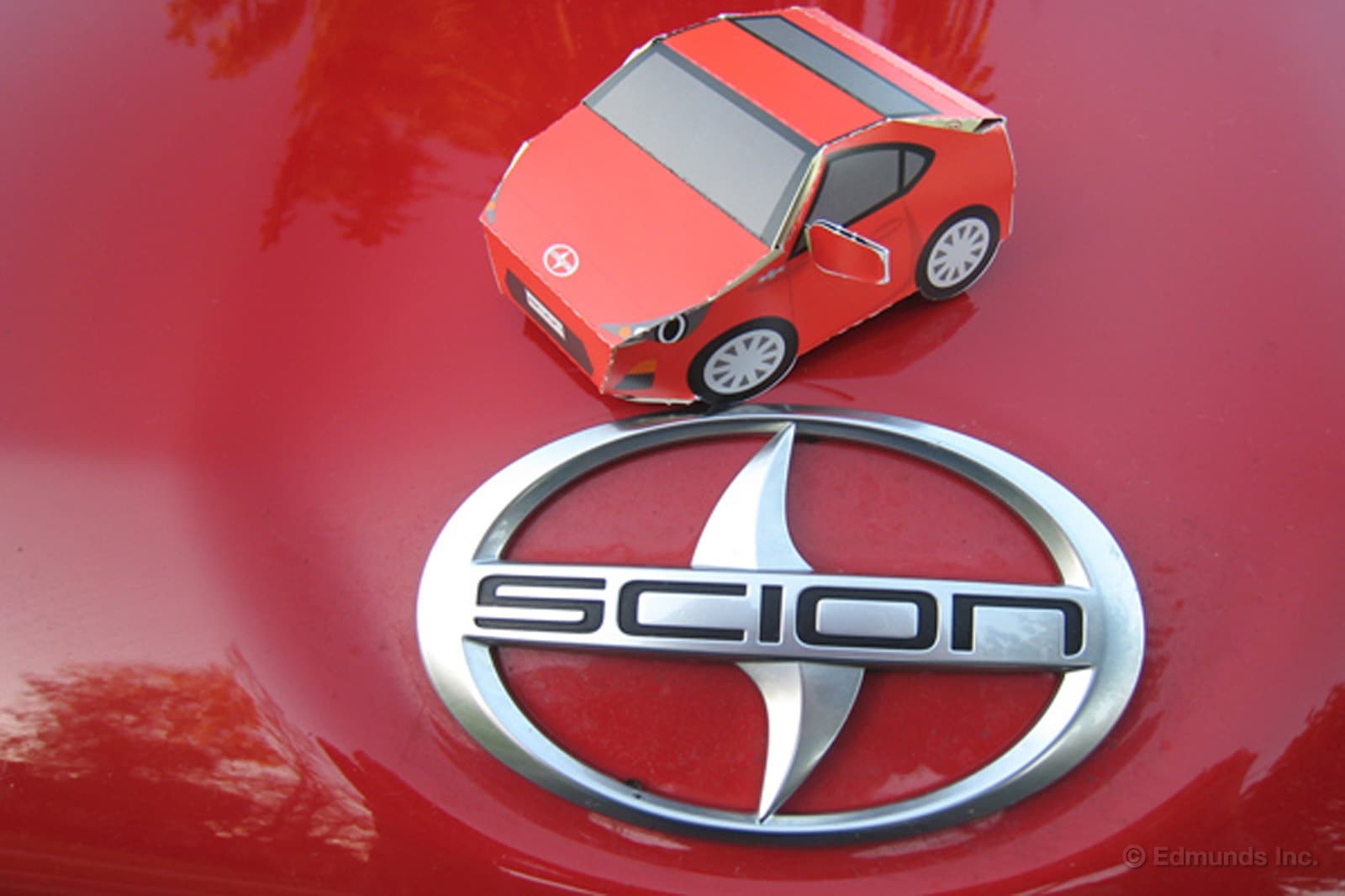
Here's some fun swag that I collected during the public days at the Los Angeles Auto Show: a Paper Shaper rendition of the Scion FR-S, designed by Shin Tanaka. In red, just like our long-term car.
The paper toys come flat on heavy paper stock which you punch out and fold into a three-dimensional model. Tanaka also designed paper versions of the Scion iQ, tC, xB and xD. Collect them all!
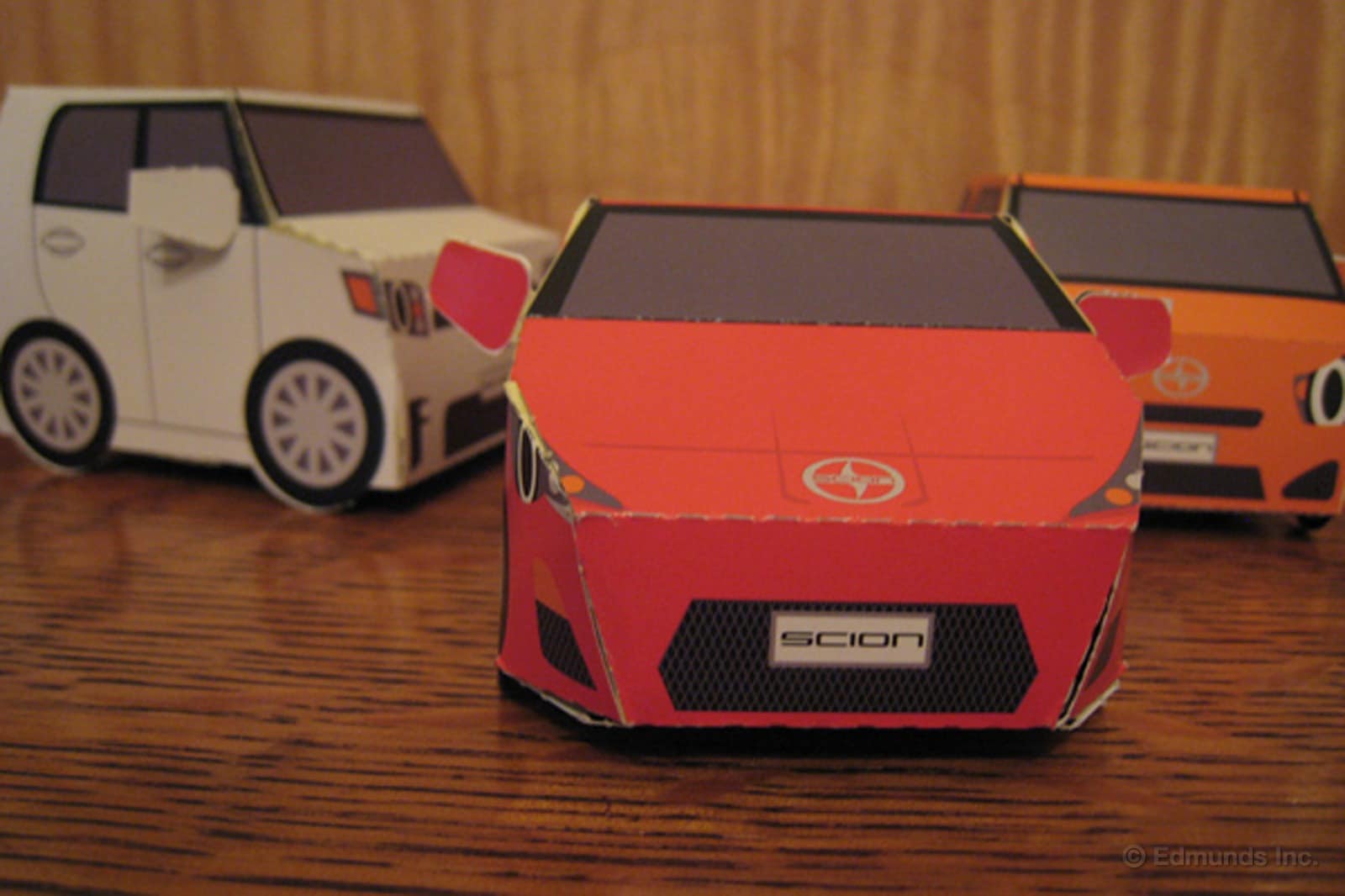
The real FR-S, of course, is a little less boxy than its paper version. Another virtue is that it cannot be batted about by a cat.
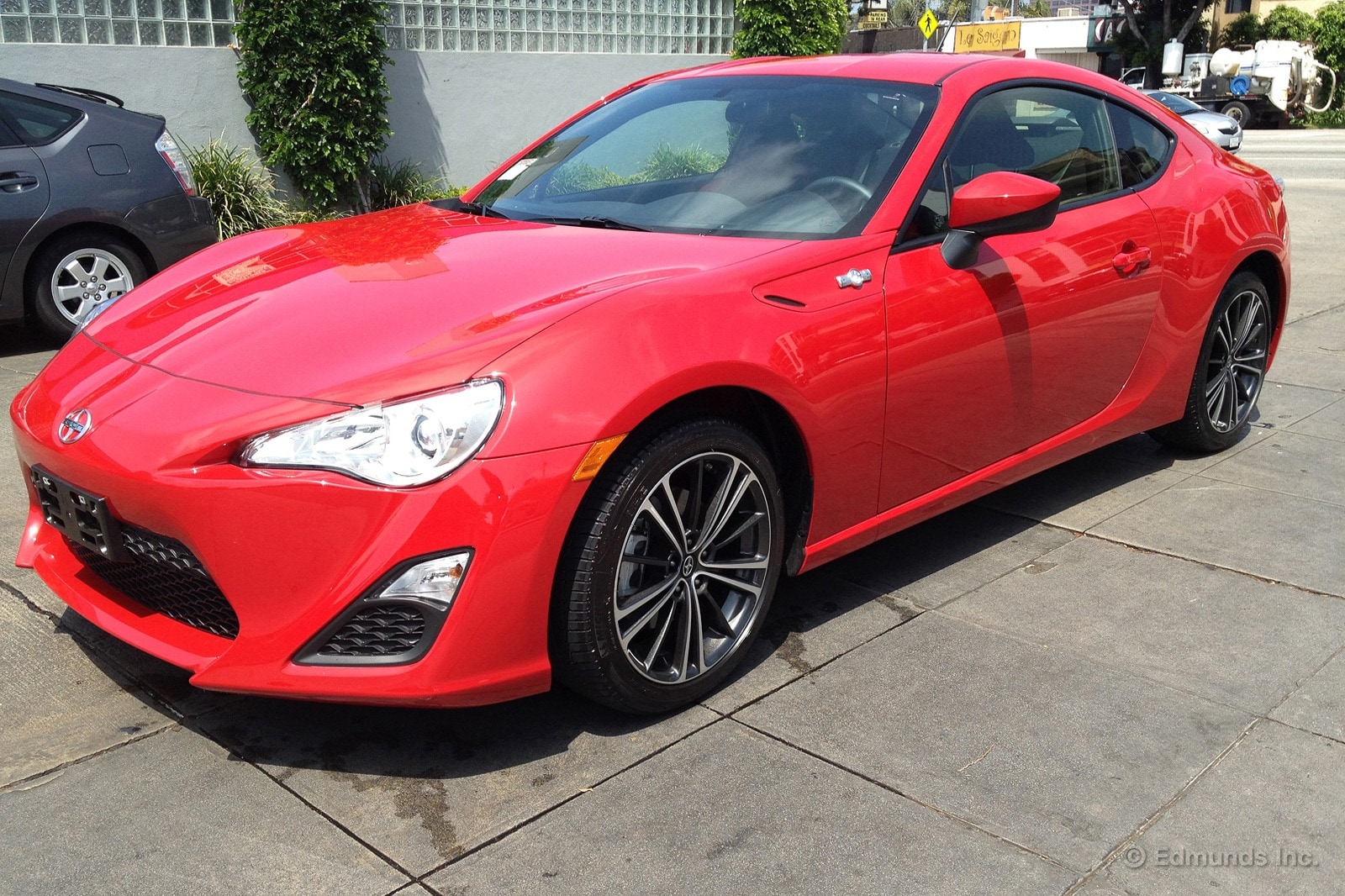
As I spot more and more Scion FR-Ss and Subaru BRZs out in the wild, I like to play a little game with myself: seeing if I can correctly guess whether it's a BRZ or a FR-S just by its color. Now, I know what you're thinking, BOTH models come with similar red, navy, black, dark gray, white and silver. The only different exterior colors are the FR-S's Hot Lava (orange) and the Subaru's WR Blue Pearl. But it seems that if that coupe I spot on the street isn't painted Subaru blue then it's most likely a Scion. (With the exception of our Dark Gray Metallic, of course.) Turns out that back in March of last year Subaru announced that, according to the first two months of sales, the WR Blue Pearl was the best-selling color at 33.9 percent, followed by the Satin White Pearl at 24.4 percent.
By the way, does anyone know why the Scion's Whiteout color is an extra $220? The BR-Z has a similar Satin White Pearl for no extra charge.
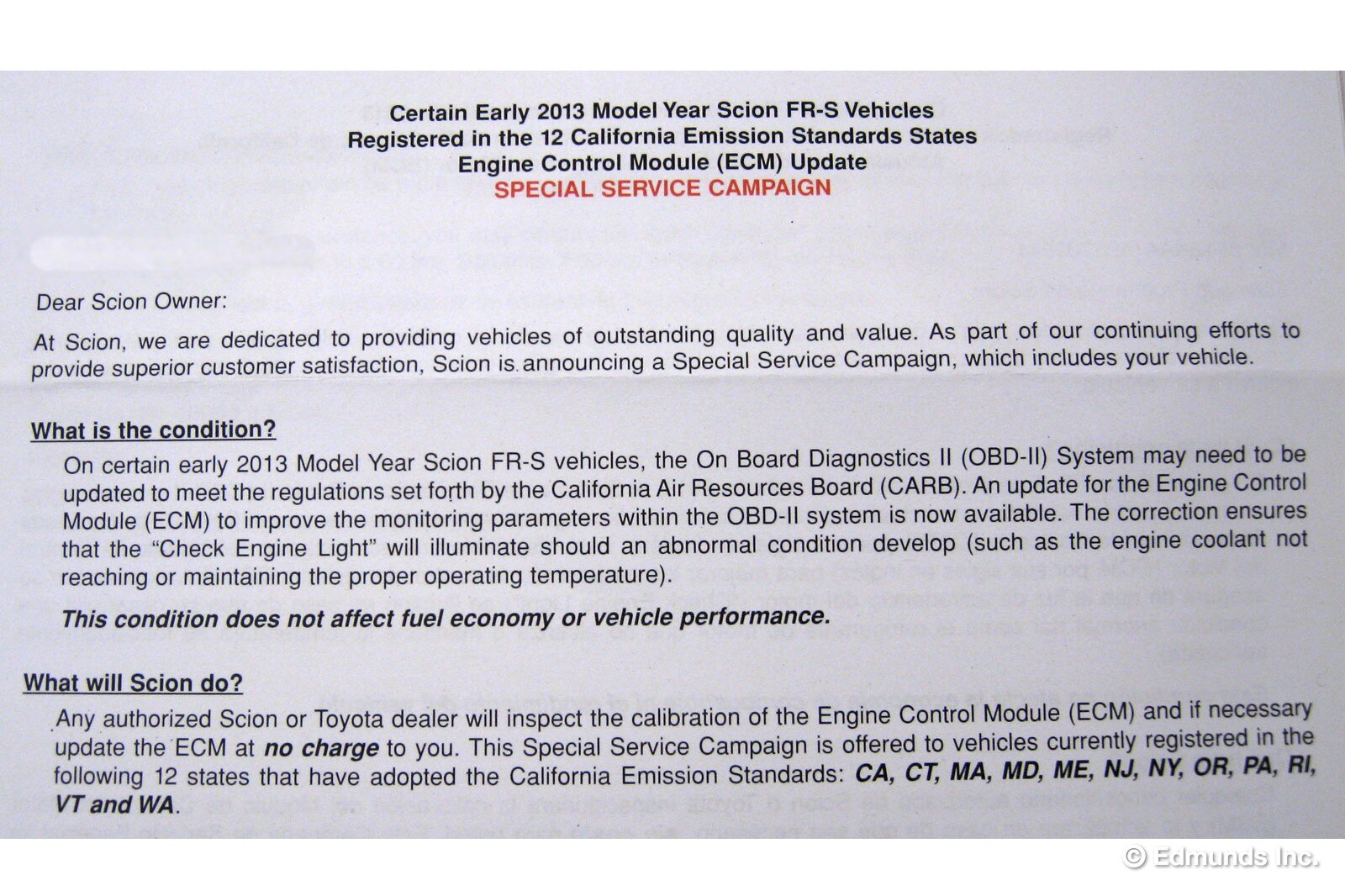
We received a mailer from Scion citing a service campaign open for some 2013 Scion FR-S vehicles. The quick summary is that, "On certain early 2013 Scion FR-S vehicles, the OBD II System may need to be updated..." The ECM update prevents a check engine light that may otherwise illuminate under certain abnormal conditions.
Owners are instructed to visit their dealer for the ECM recalibration. Since the urgency is low, we'll likely wait until our next routine maintenance to have the issue addressed.
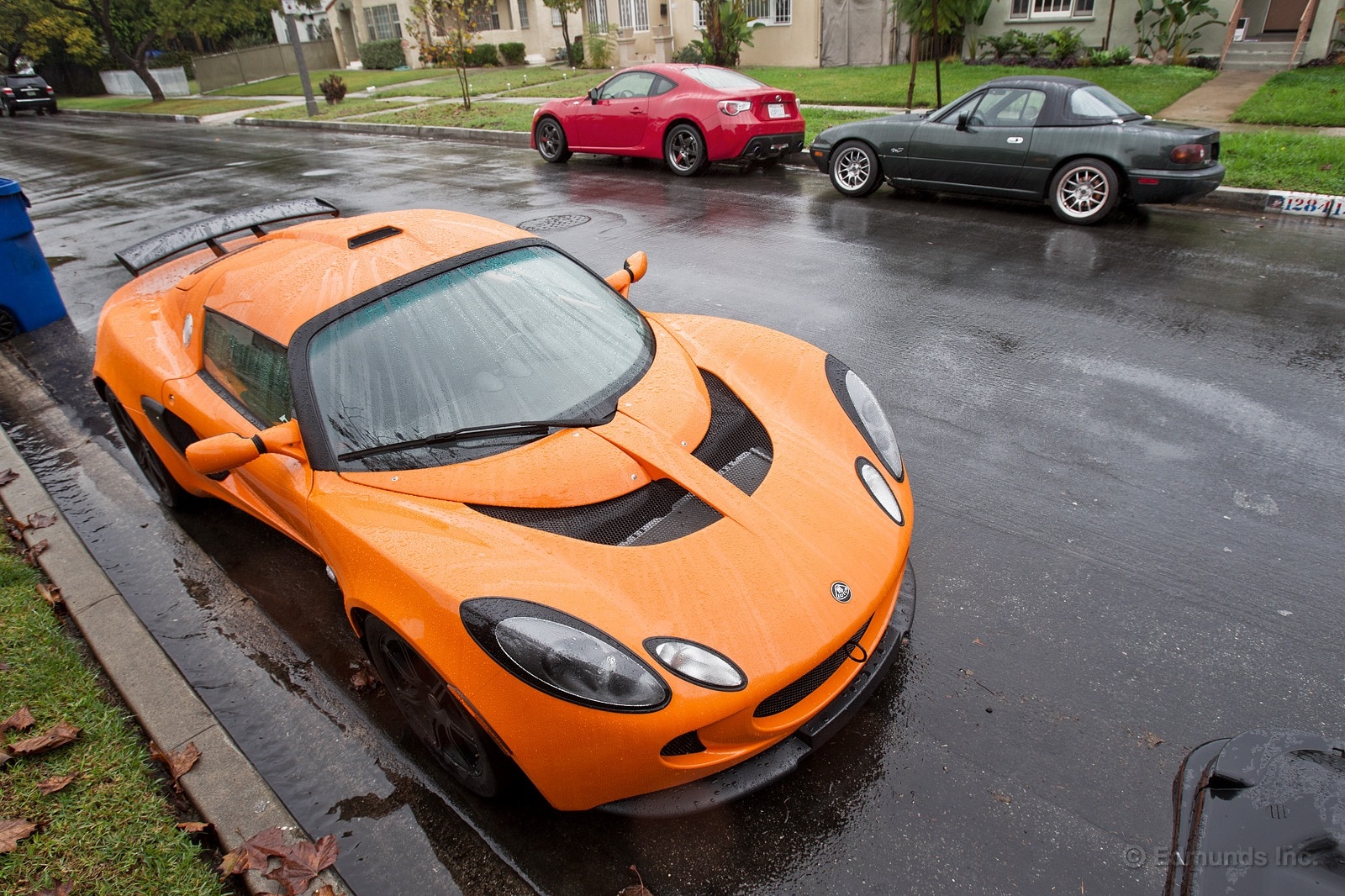
Several weeks ago, I took our long-term 2013 Scion FR-S to Laguna Seca raceway for a weekend of berms, apices and brake markers. It's an annual thing, this Laguna track weekend, and last time I chronicled the trip in several installments all bearing the title "The Beauty of Dual-Purpose Cars," in the Miata section of the Long-Term Updates. My esteemed colleague Kurt Niebuhr saddled up in Project Miata this time.
There's a lot of green (to adopt the parlance of billiards) between Edmunds HQ and Laguna Seca. Decided to make the most of it and take the bitchinest roads possible that roughly connect between the two points. So that's what we did. The collective "we" being the two of us and my friends (and Eyesore Racing co-conspirators) Bitter Dan in his Lotus Exige and Sarah in her ridonkulously clean Nissan 240SX.
One wrinkle on the voyage northwards: rain. Lots and lots (and lots!) of rain. No big deal. It had no bearing on our selected route but slowed us down a bit. The first portion of our path took us north on 101 until we peeled off on 33 in Ojai. This is one hell of a road, and the FR-S is just such a perfect car for it. It's so communicative that you can drive hard (with conditions in mind) in complete confidence.
Deep into the drive on 33 I found an oddity. I'd hear a chime-chime-chime from time to time, which makes a rhyme, I have a dime...anyway, the chime wasn't related to any particular driving style, nor were any new lights illuminated in the cluster, nor did the car drive any differently. Nonetheless, I slowed down and put the senses one click higher. Miles and miles later I realized what was causing the intermittent chime. It was the passenger seatbelt chime. Turns out that the light jacket and a half-eaten bag of dried fruit sitting on the passenger seat was enough weight to drip the seatbelt alert. Why this took some 100 miles to finally occur I have no idea.
More to come.
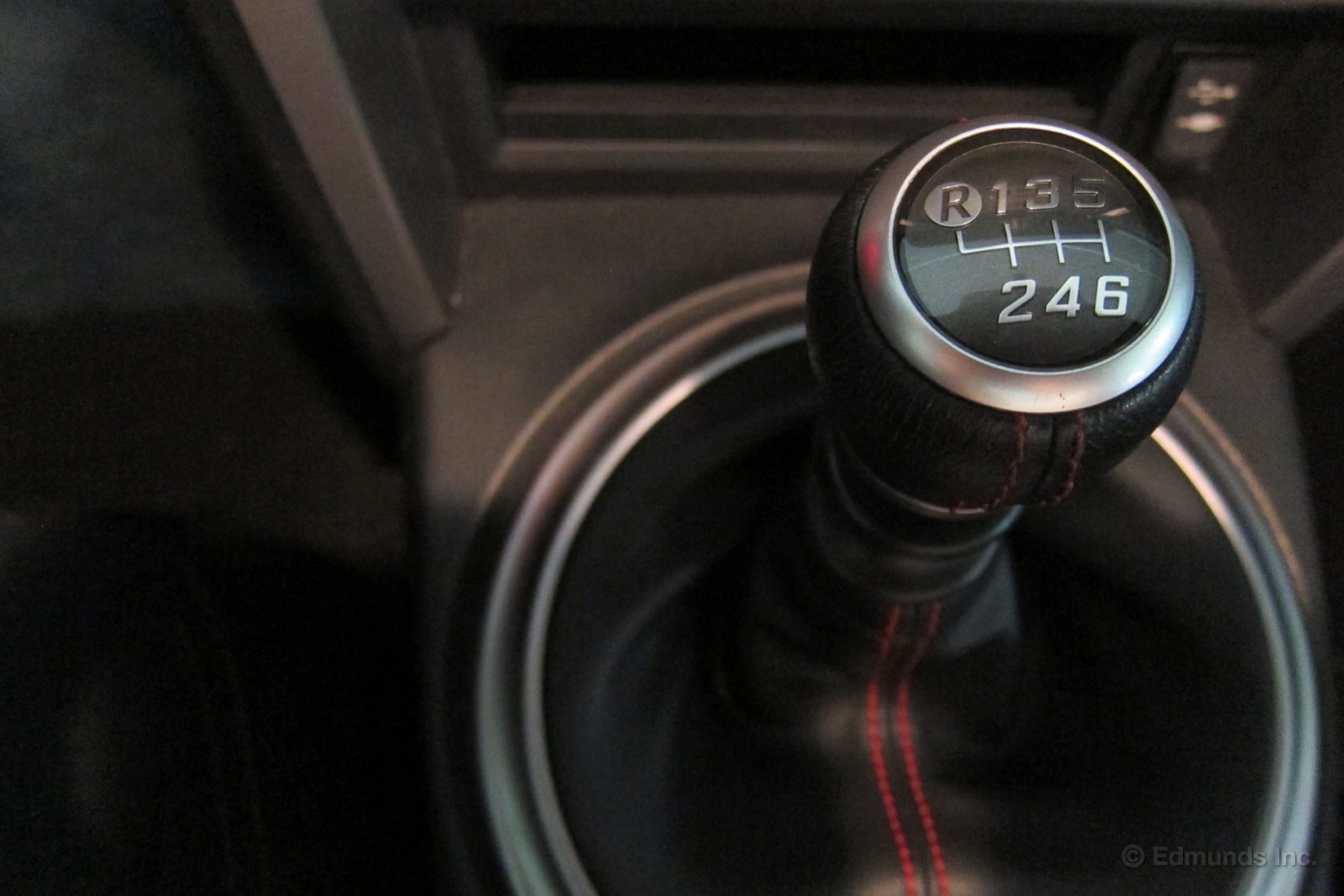
There's a difference between the shift feels in our BRZ and FR-S. It's subtle, but it exists. The FR-S six-speed simply engages its six forward gears more smoothly than the BRZ, with less clunk and resistance from the gearbox. In theory, we shouldn't be experiencing this since both cars share the same transmission.
This article from our long-time pal SubyTrojan doesn't shed much light on why we (or maybe just I) feel a difference. Maybe it's as simple as a difference in trans fluid. But it's an interesting analysis, nerdish on the powertrain details and on the development of the new transmission that sprung from the ashes of the old Lexus IS200 gearbox.
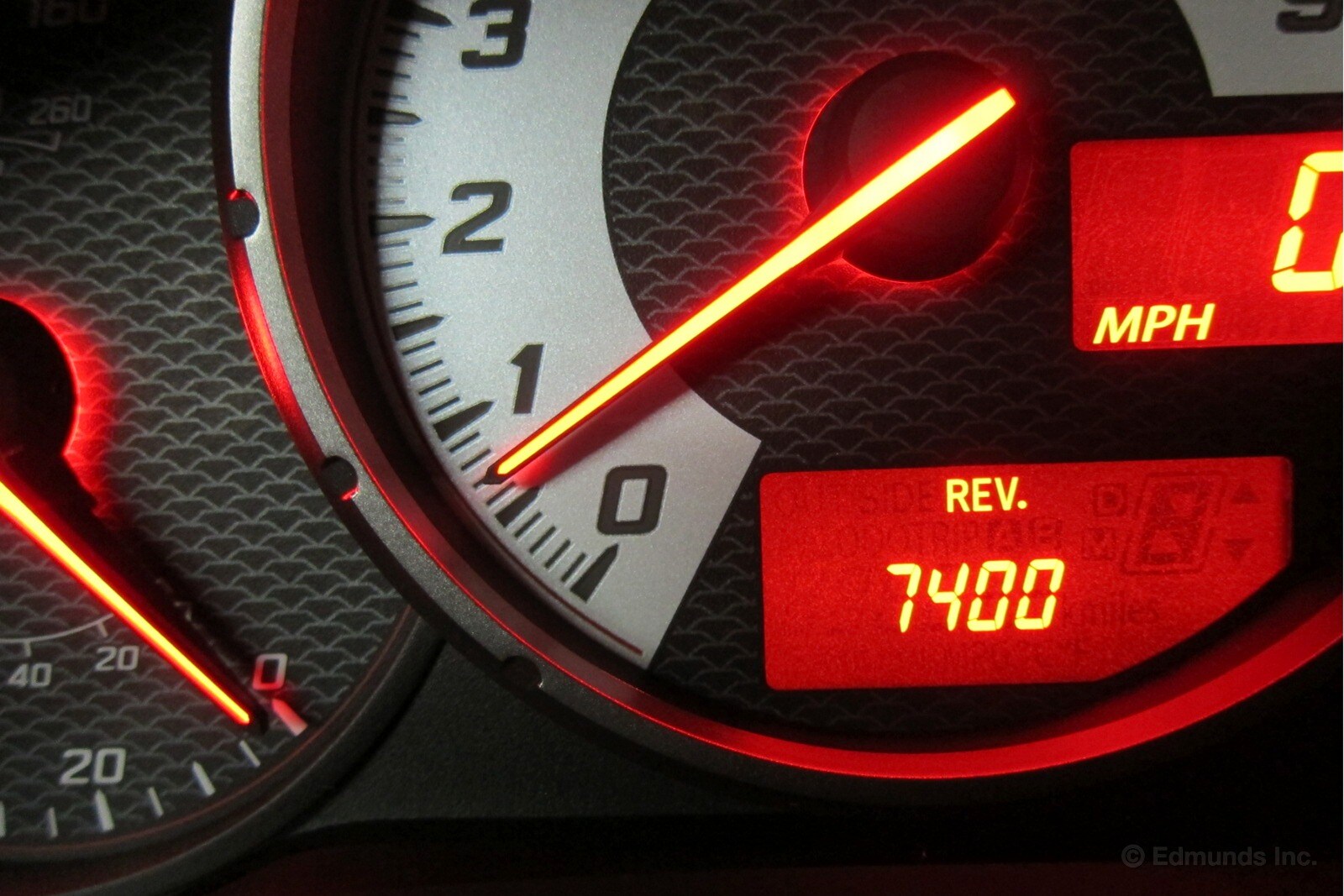
The Scion's Multi-Information Display shows only a handful of parameters, including outside temperature, current fuel consumption, average fuel consumption and the engine speed at which the rev indicator turns on, complete with buzzing alert (this is in addition to the regular odometer and trip meter that also share the screen space). You can customize the alert to display/sound between 2,000 and 7,400 rpm.
Whether by default or someone on staff changed it, it shouldn't surprise you where ours is set.
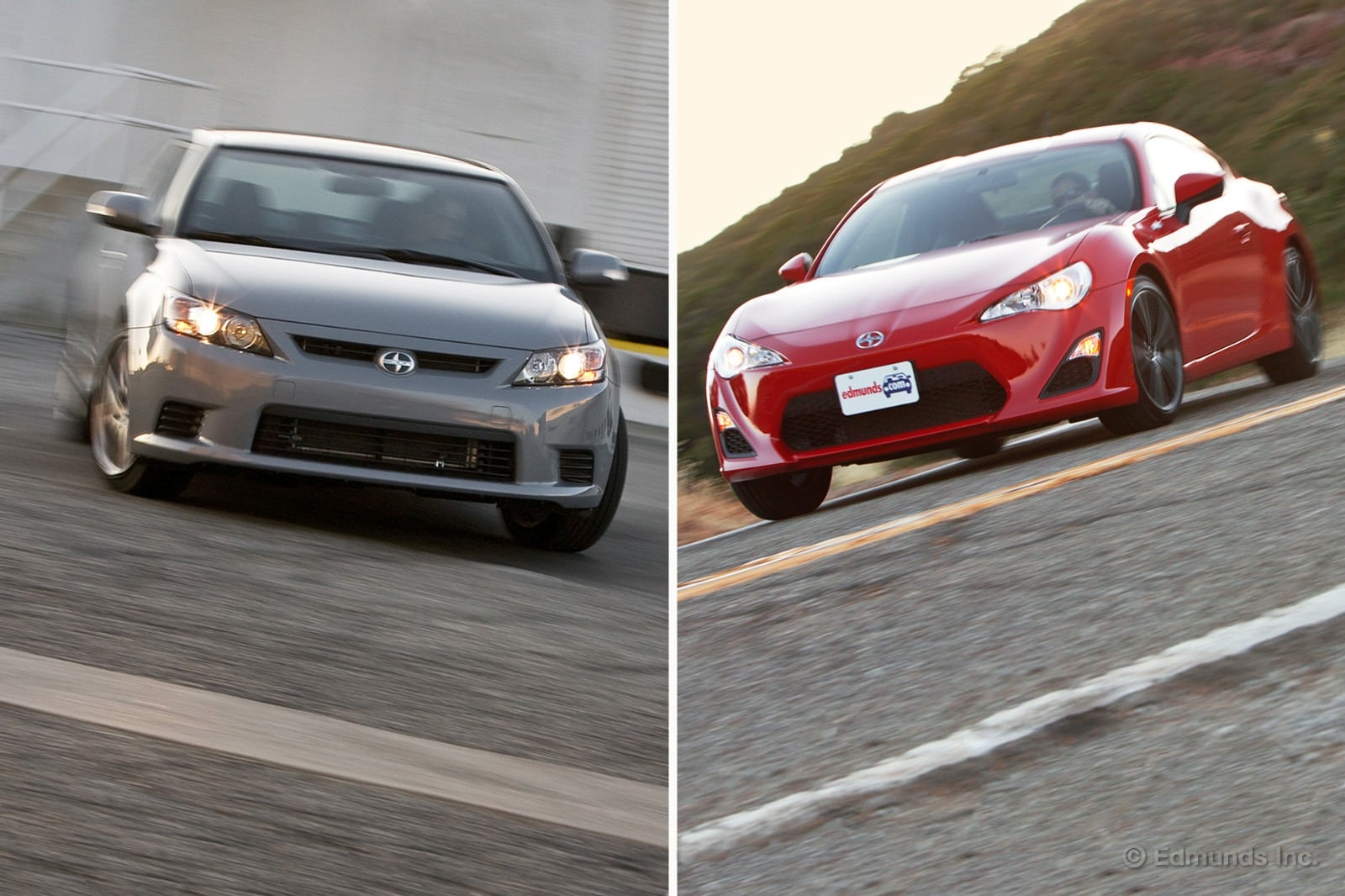
But does one coupe have to leave?
Scion has these two coupes. One, the tC, is essentially a two door Corolla with a flash interior. It's front-wheel drive and seems more likely to be turned into a mobile disco than a canyon carver. The FR-S however, is a coupe that seems to be at the forefront of saving not only Toyota's image but the idea of an affordable rear-drive car altogether.
Can Scion afford to have these two diametrically opposed coupes sitting side by side in a showroom? Does the existence of one take away from the purpose of the other?
If you were Scion, what would you do?
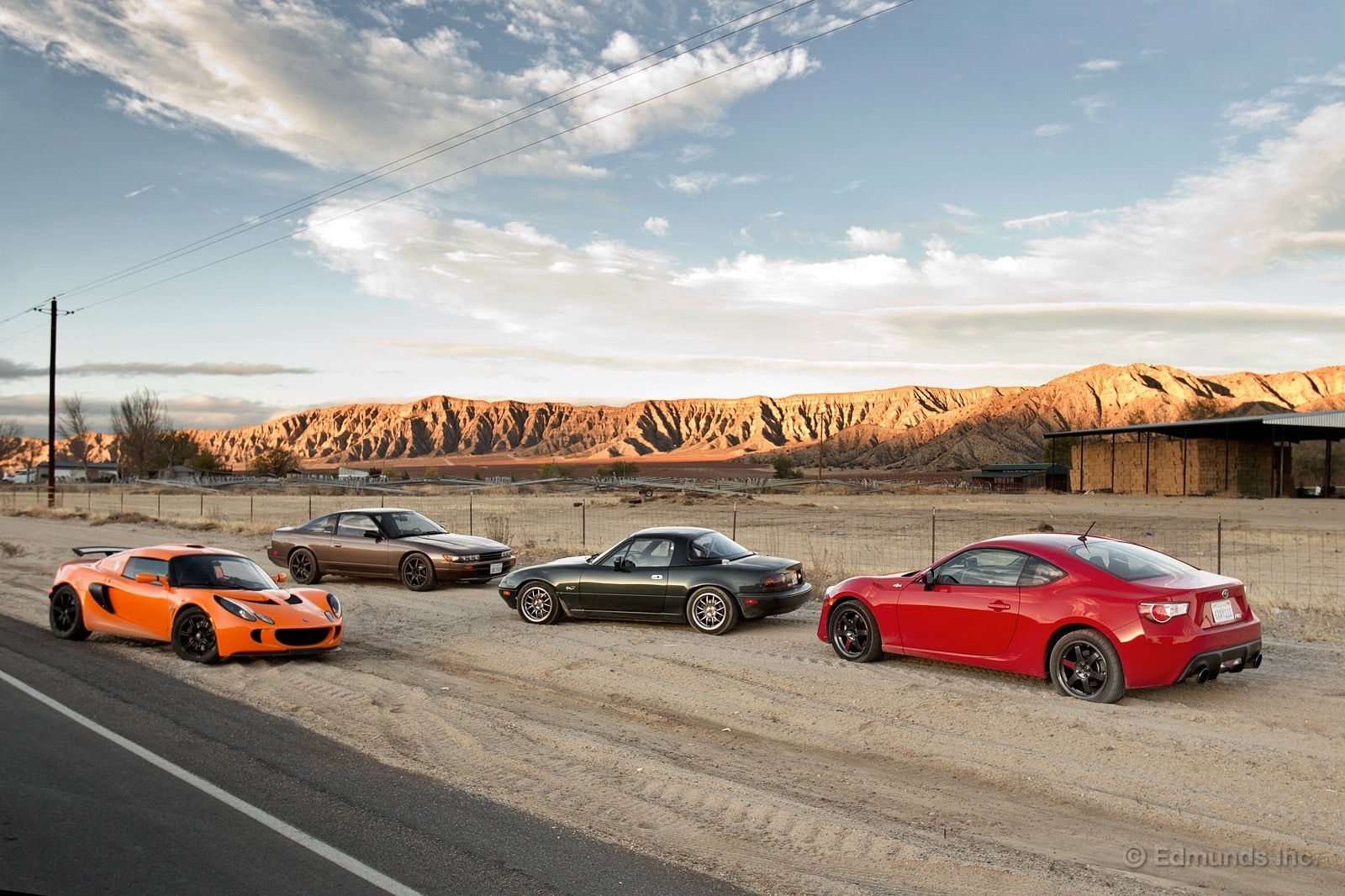
Up until this point in its existence, our long-term 2013 Scion FR-S had only seen dry days. Life in SoCal has its benefits. This trip (part one here) would be the first time we'd find out how its more aggressive tires on wider wheels would fare in wet conditions.
But we'd gotten such a late start heading out of Los Angeles (plus the stops for photos, food and a visit to Sampson Communications to troubleshoot some equipment) that night had fallen by the time we'd peeled off Route 33 onto Highway 58. Fie, daylight savings. Now it's wet, cold and dark. It was quite likely that the soft compound of these Yokohama AD08s wouldn't have much bite on this, one of southern California's best driving roads.
This road, it turned out, was deceptive. Grip was admirable given the slip-prone conditions, and the FR-S continued to impress as a pointy, feedback-rich tool for driving. I love this car. Equally surprising was the pace Bitter Dan was able to maintain in his Exige, shod as it was on rather worn R-compounds. I would later find out just how I'd been tricked by Highway 58.
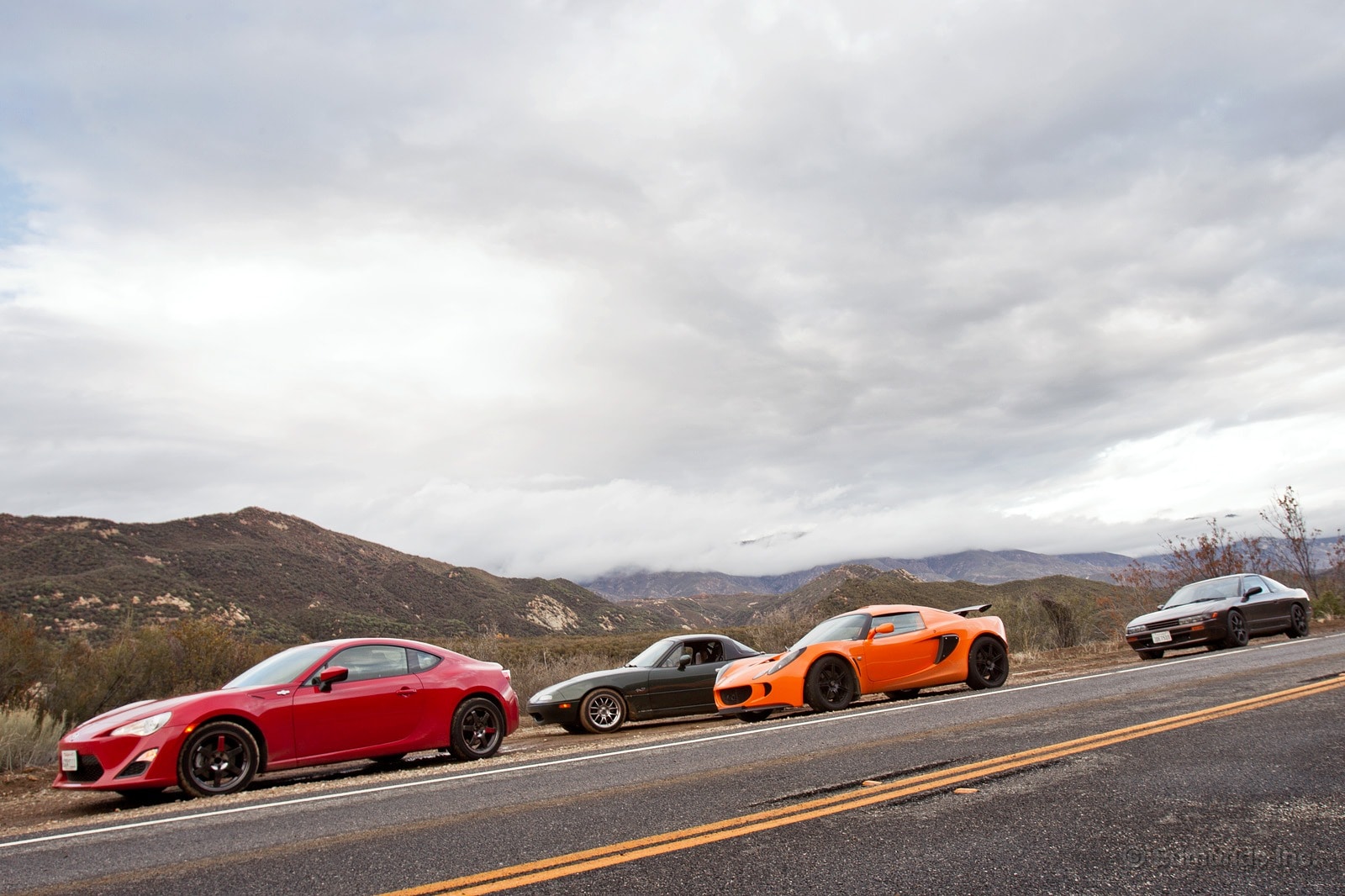
But more on that later. Right now I'm driving through the inky blackness of this unlit desert canyon road, and fairly pleased with the headlights performance. There's enough spill to the sides to light up where you're headed. I've yet to do a back-to-back test with these halogens on the FR-S versus the BRZ's HIDs. Mental note.
Then, boom, a wall of fog, right at the absolute best parts of this road. I'm having flashbacks to the last year. I'd run through here in Project Miata and it insisted on overheating and ruining this part of the drive. What are the chances?
From Highway 58 Bitter Dan and I tore north on Highway 229, a treat of a stretch that has recently been repaved. This road is one of our faves, and it never disappoints, all aggressive cambers and rises and fluid motion. There's no way it was laid out by some protractor-wielding dork.
Once that was out of our system we then found our way to 101 North to meet Sarah and Kurt in Paso Robles for grub.
Good cars, good driving, good friends and good food. That's a fine day.

Drivers' meetings are important and necessary. And they should take no more than fifteen minutes. Longer than this means the organizer just likes the sound of his own voice.
I bring this up because the 45-minute drivers' meeting at our Laguna Seca track day left exactly four minutes to get ready to be on track. This brings up another point: If you're going to have eternity-long drivers' meetings, you should schedule the beginner group to be on track first. Newbies don't have nearly the prep time requirements of non-beginner groups.
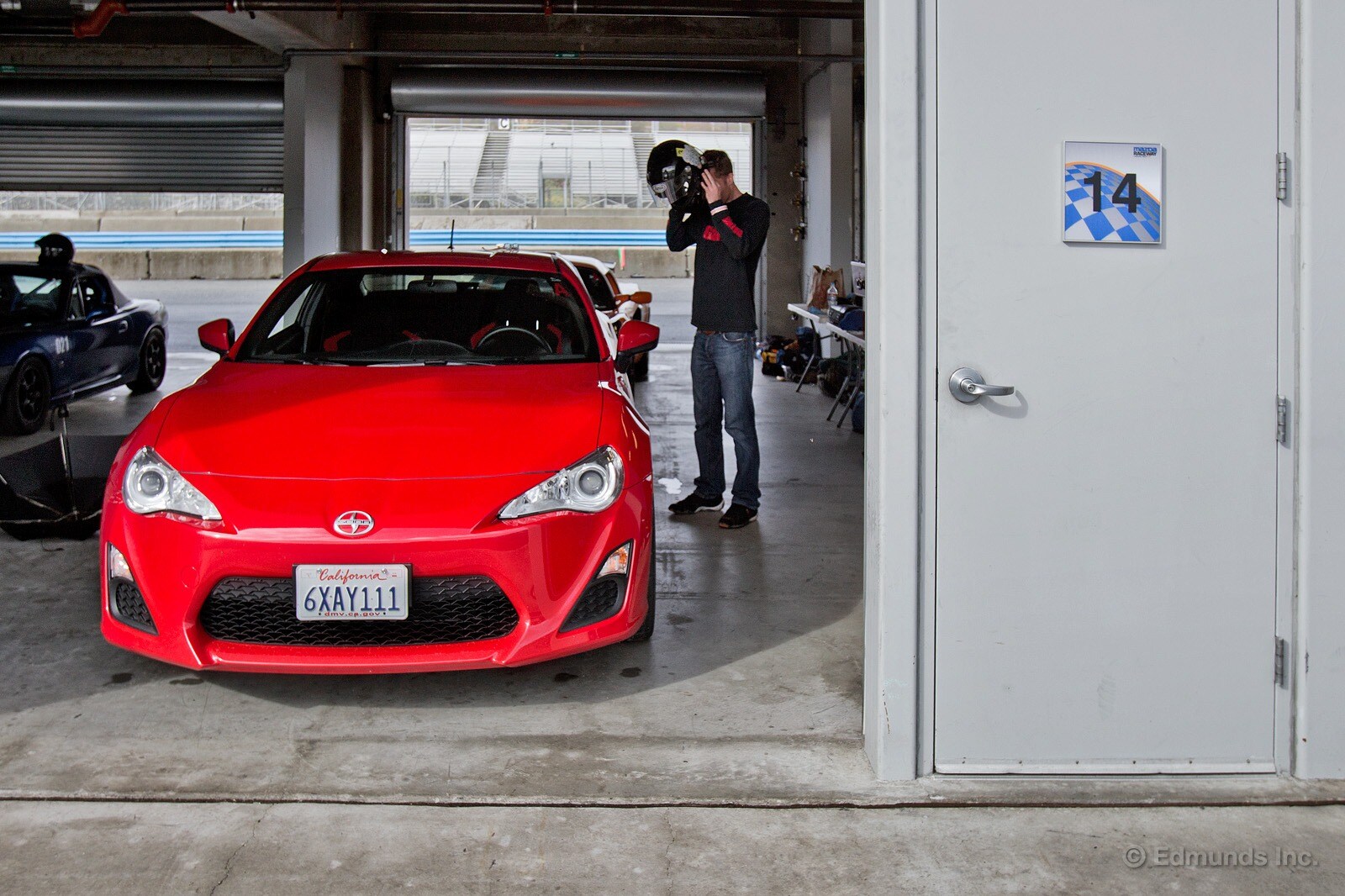
My first session out on the rain-drenched Laguna Seca circuit entailed the usual warming up ritual. To warm up the engine, sure, but more importantly to warm up the brain. The FR-S was surprisingly edgy. So I started out cautiously and gradually stepped up the pace and on my fourth lap found myself looking out the passenger window at the exit of turn six as the FR-S's trunk made a daring pass of its hood.
Naturally this was driver error. The FR-S's good wet weather performance on the road the prior evening was still imprinted in my mind, so I didn't think to question anything but the nut behind the wheel. But then a few minutes prior to my second session, I had a bright idea (this has happened once before. Once). Remember that four minute get-your-ass-on-the-track-now window? I'd not had a chance to check tire pressures.
It turns out every one of the FR-S's tires pegged the pressure gauge's max of 40 psi. In the rain, pressures this high are exactly what you don't want, so I aired them down to about 26 psi and headed out. Big difference. The FR-S still hunted and juked and was generally always on the edge of a knife, but it offered more grip and a touch more predictability.

Everything is relative because these tires were still diabolical on the wet track. The track surface at Laguna Seca is like polished marble compared to the gritty, pebbly, grippy tarmac on
Highway 58. That, plus standing water — unlike the road, there were rivers running across the track along the main straight, at the exit of turn 2 and between turns 4 and 5. When the FR-S hit the rivers, it would instantly snap sideways. Other cars would motor right past the FR-S on the straights, and it wasn't because of power. It was because they had traction.
Good thing a track day isn't a race, and there's always next time. This time, "next time" was tomorrow.
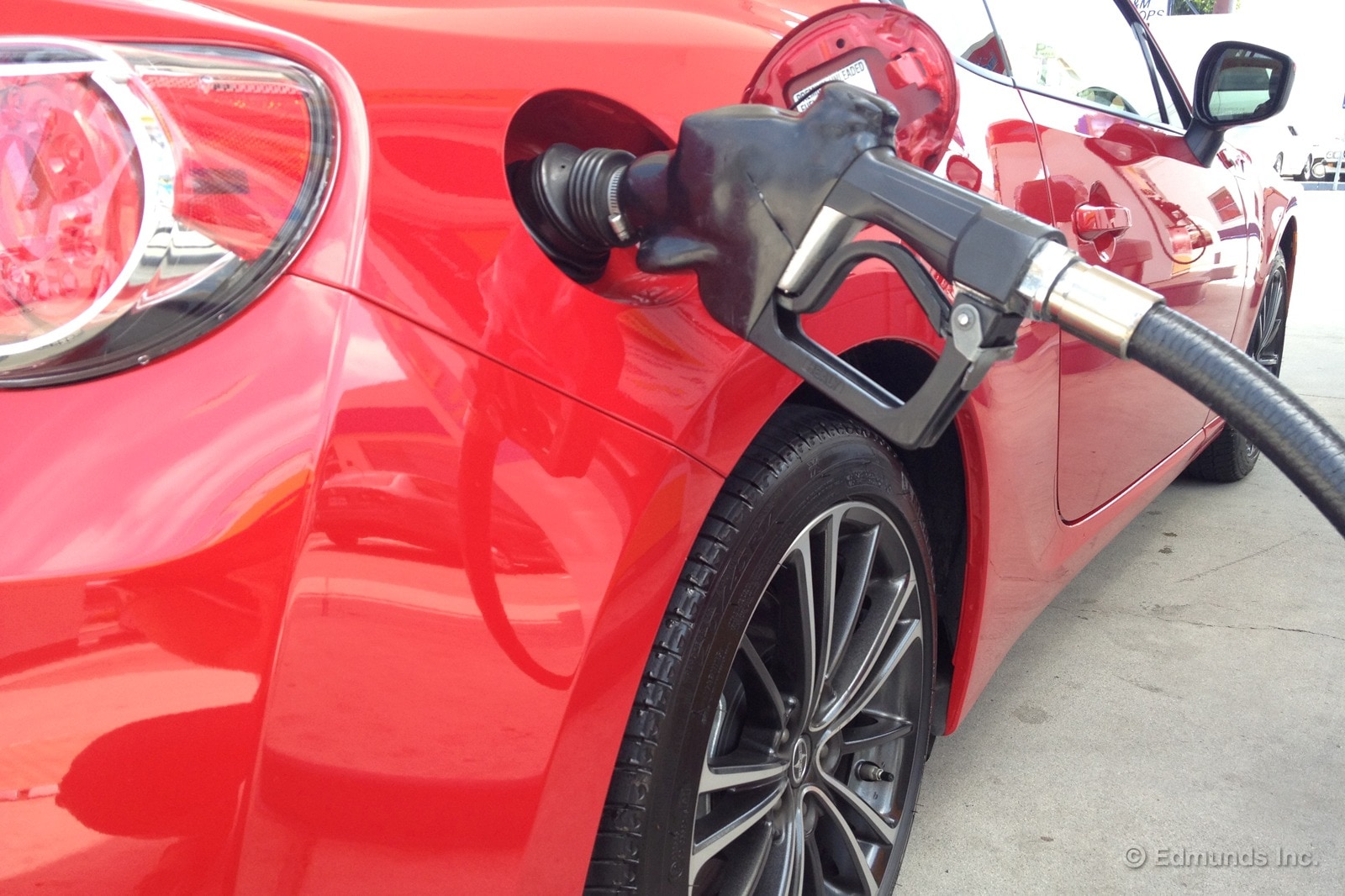
For the month of January, we only filled our 2013 Scion FR-S twice but in December because editor JayKav took the car up on a road trip to Laguna Seca and then to Oregon it logged a lot of highway miles. In case you were curious, it got 11.2 and 12.2 mpg during the track days.
On the Oregon roadtrip, the best mpg he got was 30 mpg and the trip to and from Oregon averaged 28.2 mpg.
For January, the FR-S was driven for 560.9 miles and drank 23.2 gallons of 91 octane fuel, averaging 24.2 mpg, a bit shy of the EPA's combined 25 mpg.
Worst Fill MPG: 16.9
Best Fill MPG: 30.0
Average Lifetime MPG: 24.2
EPA MPG Rating (City/Highway Combined): 25
Best Range: 335.1 miles
Current Odometer: 13,108 miles
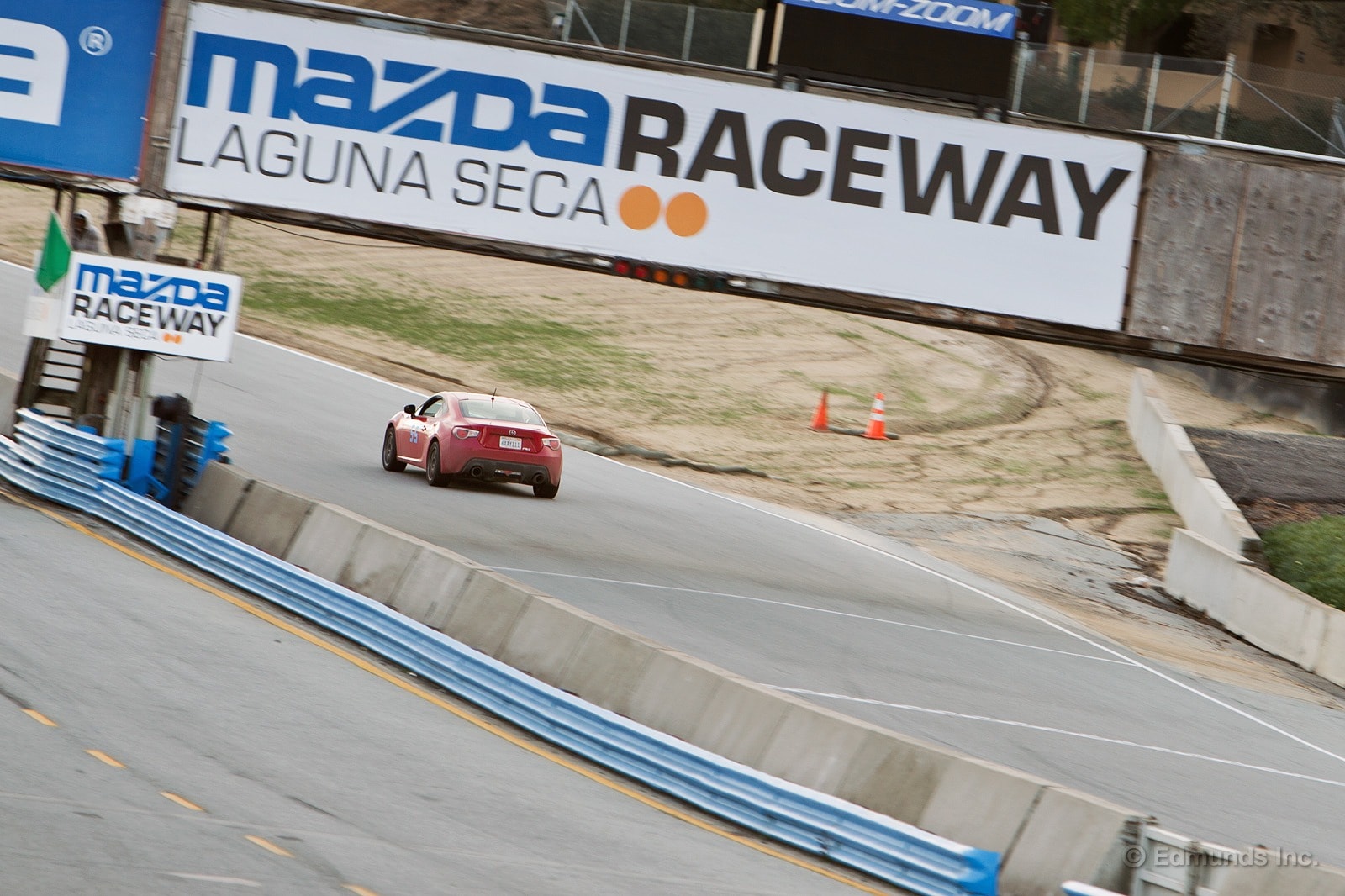
It was a gamble. I had checked the forecast regularly in the days leading up to our Laguna Seca track weekend, and the outlook was consistently dismal. So much so that there was no sense bothering with high-performance brake pads. Normally, this is the second thing you change for a track outing in an otherwise stock car, the first being tires. So, I left the stock brake pads on our long-term 2013 Scion FR-S.
And as you've seen, the track was sopping wet. I felt vindicated in my decision to be apathetic.
Then the sun came out. And a dry line began to form on the track surface. And for a time, pretty much the whole track dried out. The twitchy, traction-devoid, edgy FR-S I knew in the rain made way for a far different animal. These Yokohama Advan AD08 tires rule in the dry. Communicative, beautifully progressive breakaway, heaps of grip. Exit speeds climbed. Braking points were adjusted.
It took roughly two hot laps in the dry for the brakes to go limp. The braking power underfoot just went into the ether as the overheated stock pads' coefficient of friction dropped like a rock. If you had told me that you'd secretly swapped my brake pads with sintered Folger's coffee grounds, I'd have believed you.
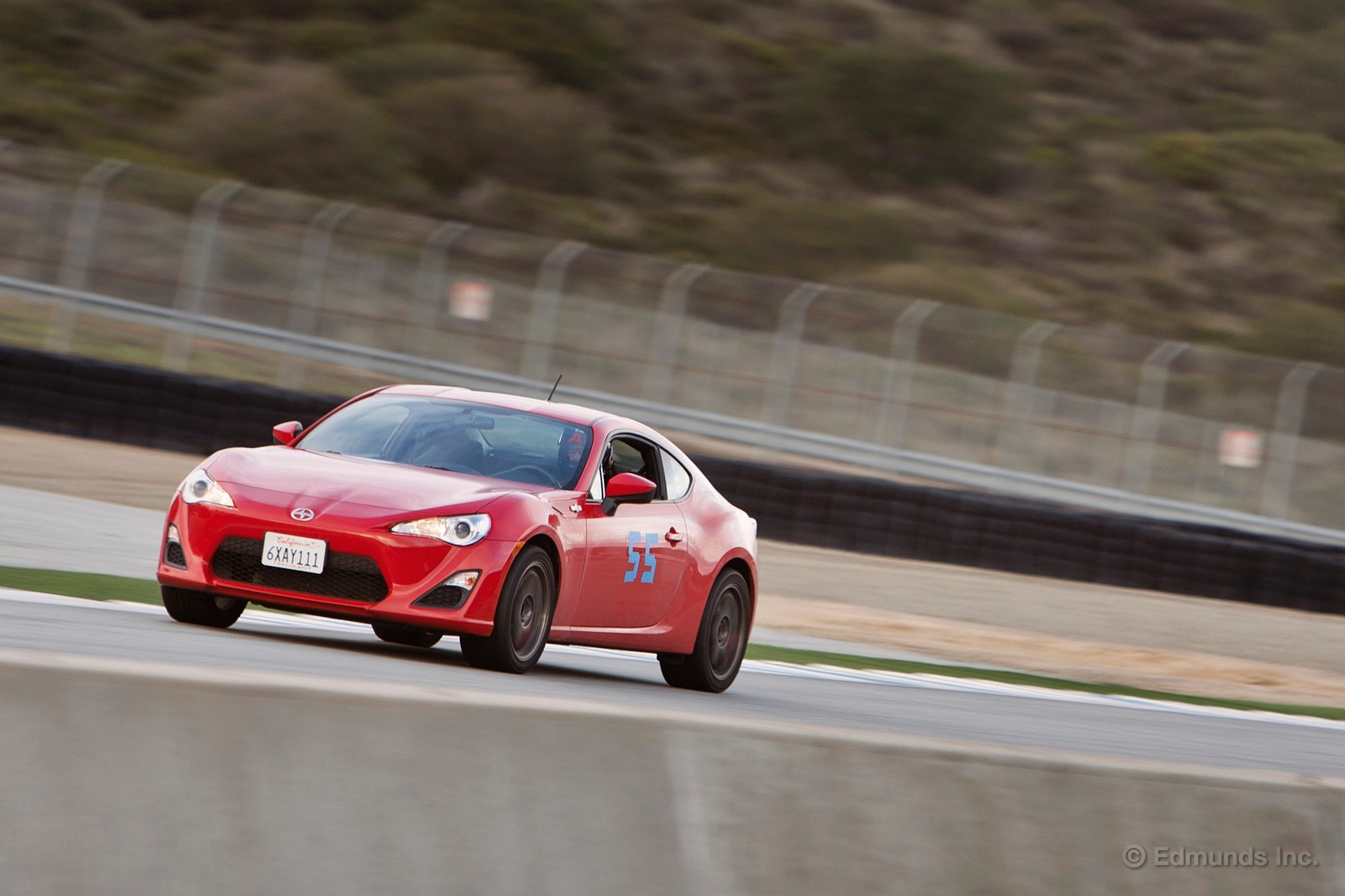
My first indication that the brakes had thrown in the towel was in the braking zone for turn 2, the hardest braking zone on the track. I went for the pedal and it returned with an indifferent, tepid buffing — not a scrub — of speed. Yipes. So I gently pointed the car's nose inward to stretch the braking zone deeper into the corner. This of course meant the turn had been blown, but it's a better alternative than tossing the car into the dirt.
Driving in these dry conditions became an exercise in brake management. Drive fast enough to work the tires and have fun but not so aggressively that you miss half your session trying to cool off the brakes.

Within these bounds, the FR-S was a blast. Its precision is a joy, and with just these tires on appropriately-sized Volk Racing TE37SL wheels it boasts the capability to run comfortably with ostensibly "faster" cars. This chassis is really a peach. I'm smitten. Now to find some real brake pads...
Previous updates in this road trip:
Part III
Part II
Part I
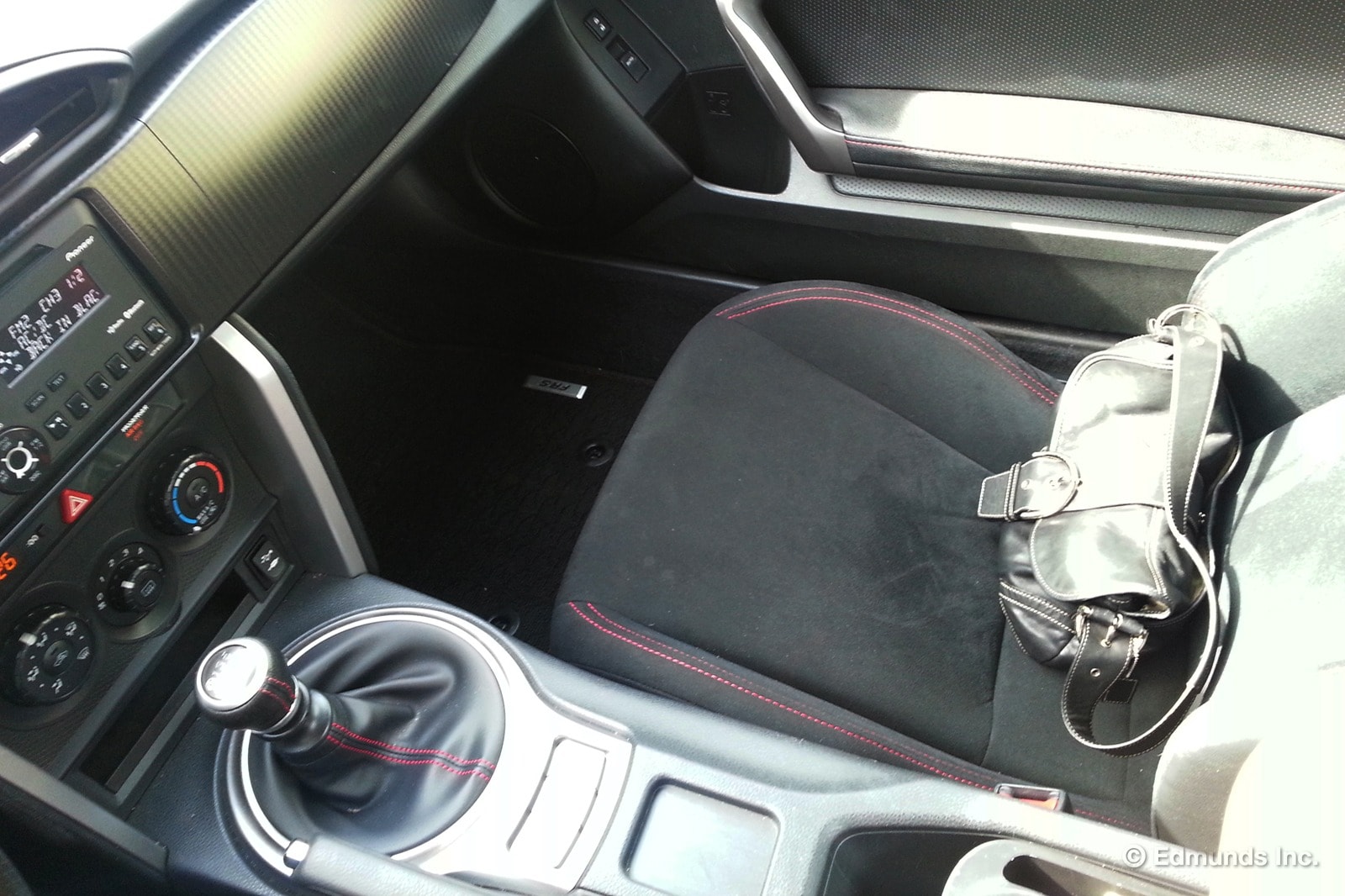
You see that purse? Sometimes it sets off the airbag sensor in our 2013 Scion FR-S. That's not usually a big deal to me since sometimes I load it up with heavy stuff. But when this particular not-so-heavy one, combined with my smartphone, set off the sensor telling me to buckle them in, I threw the purse in the footwell and left the smartphone on the seat. Oddly enough, the car continued to tell me to buckle my phone in, and urgently, so I put it in the center storage cubby to shut it up.
Another time it was just my phone that set off the seatbelt chime. Weird! But I can't replicate this issue now if I tried. So I just gave Mike Schmidt, our keeper of keys, the heads-up, but it's not a dire problem. Anyone else have this issue?
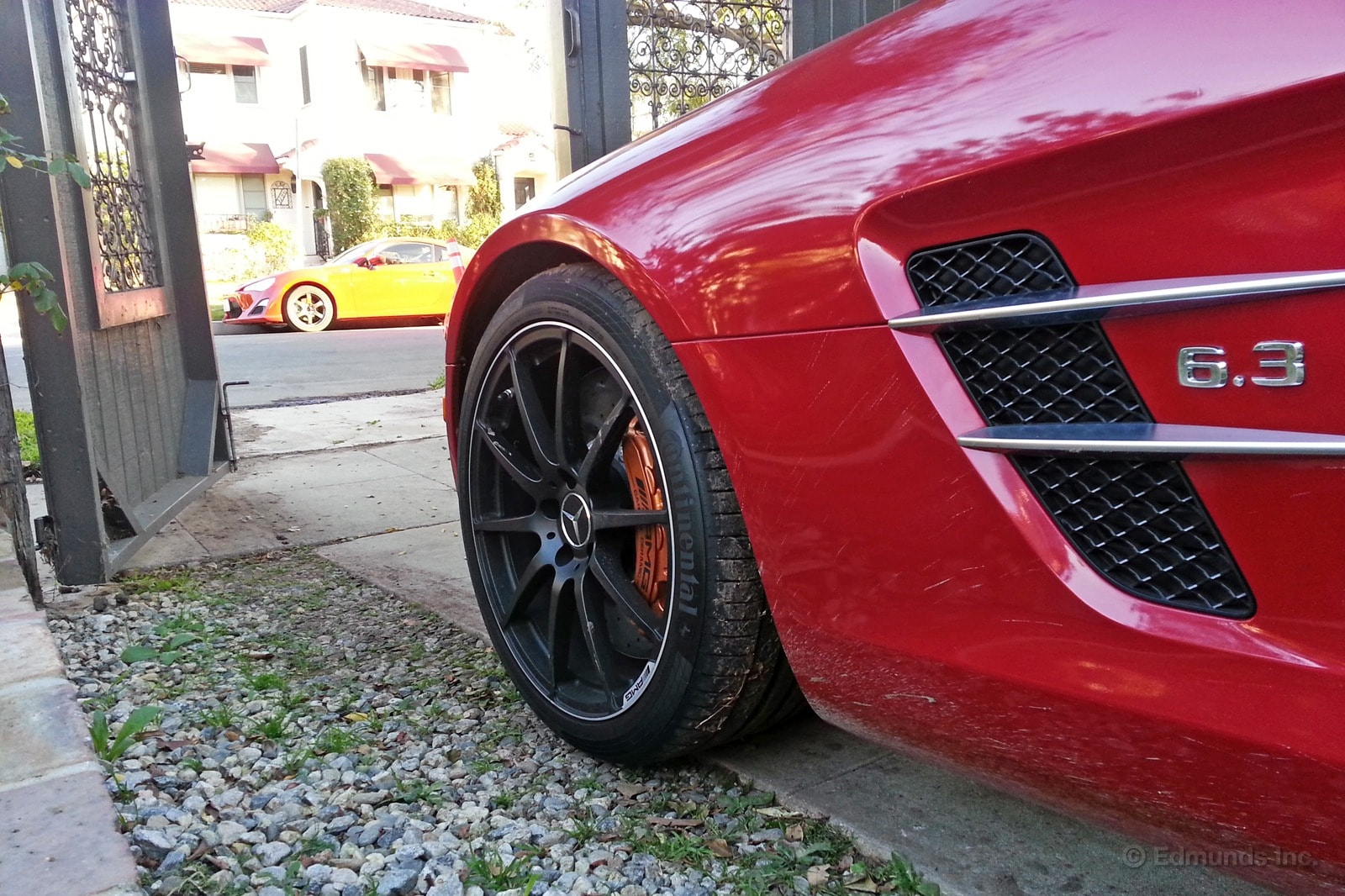
After scoring a couple of driving stints in our long-term SLS AMG, I was grateful to get behind the wheel of our 2013 Scion FR-S. Driving a quarter-million-dollar sports car around L.A. is too stressful for me. I'm too afraid to switch lanes, I dare not park it on the street (valet all the time), plus the SLS spotlight is too bright for me.
But our FR-S is more my speed: fun and affordable. Now, I realize there's no way these cars would ever be shopped together but it made me realize that I'm just not an SLS kind of girl. THAT kind of girl wouldn't worry about her beautiful car getting dinged because if it ever did she could afford to get it fixed or replaced.
Me? I don't like to valet, I drink smoothies in the car and I liked to be looked at but not ogled.

Last night when I pulled up to the valet in our 2013 Scion FR-S at the fancy Fairmont Santa Monica hotel, the valet guy excitedly told me how I had "his car." The exact red and everything, well, minus the exhaust. He continued to go on and on about how he likes to race it up at Buttonwillow. Sometimes he even drifts it. Needless to say, I was impressed. Not very often in L.A. that you meet a guy with a fun car who actually knows how to drive it.
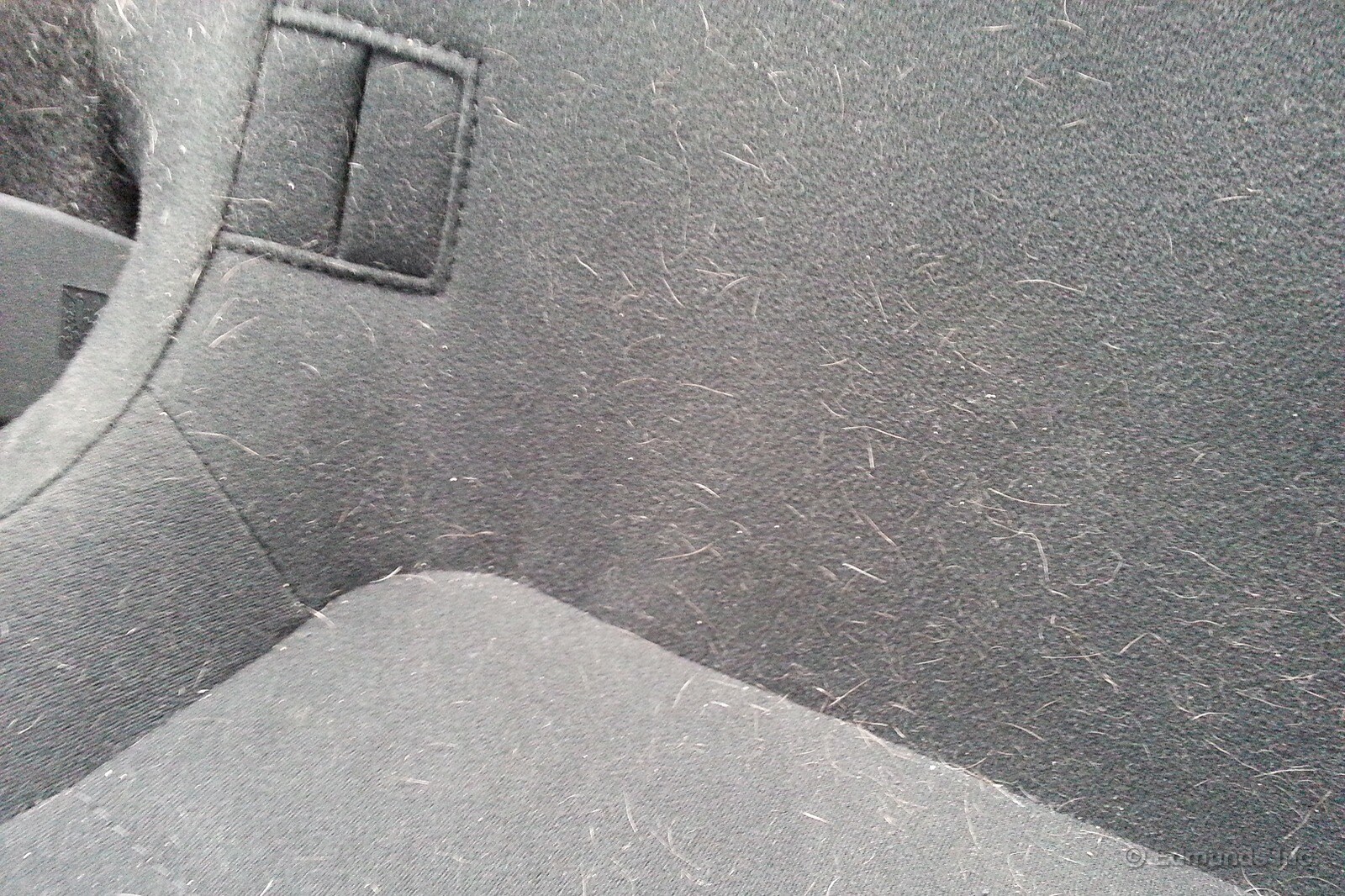
This weekend I had to take my dog Mya back to the vet in our 2013 Scion FR-S. I put her doggy blanket down in the backseat like I usually do to protect the seat but her hair still managed to get on the cloth. When I took the car to the car wash for its weekly wash and afterward pointed out to the attendant handing me the key of the "clean" car that they didn't clean the backseat, he said that they couldn't and that it had to be shampooed.
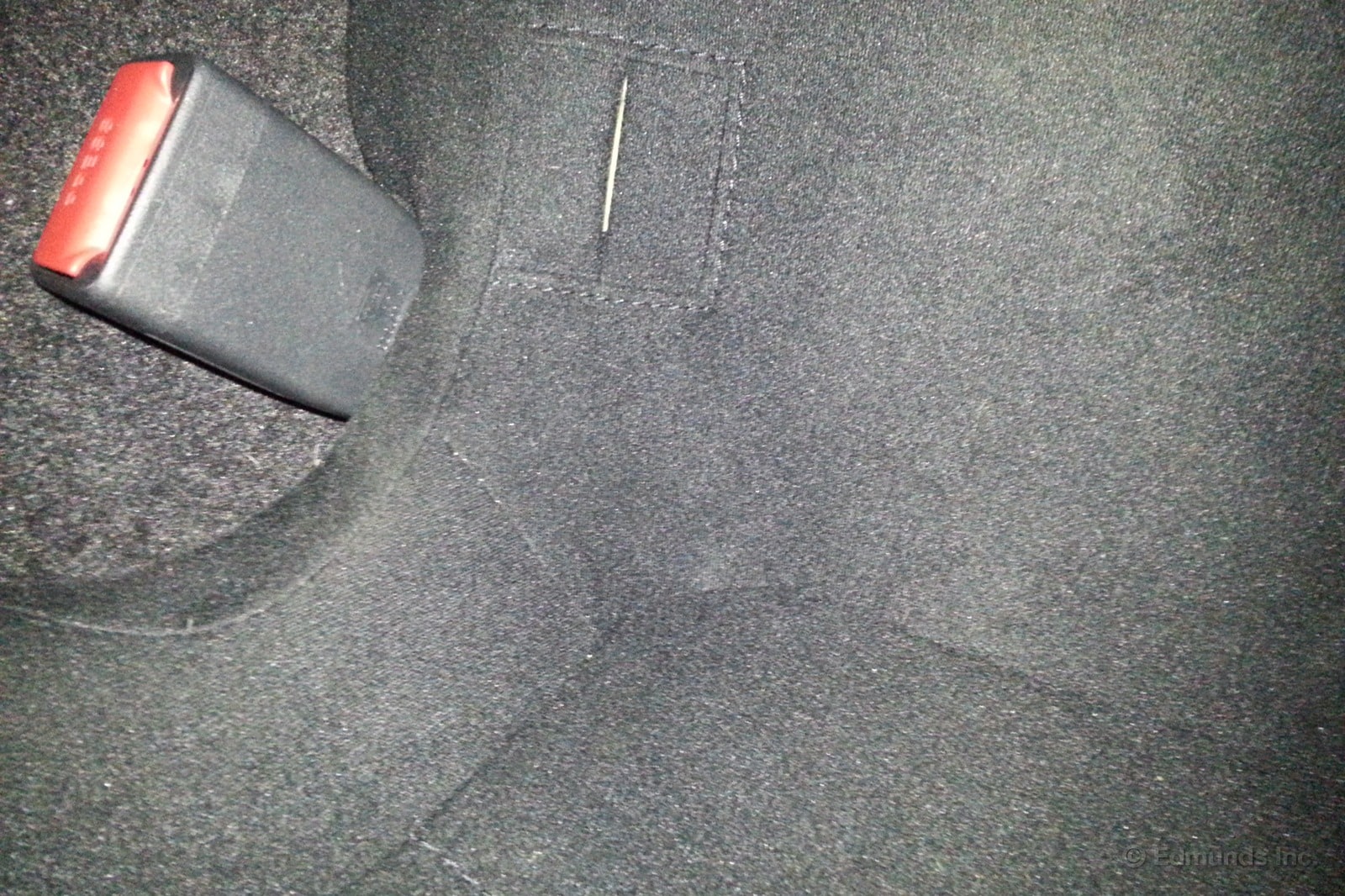
That was strange considering they've been able to clean the fur off before. So I asked Vehicle Testing Manager Mike Schmidt if we had anything in stock to remove dog fur. After all, we have stuff to clear foggy headlights. Unfortunately we didn't have a magic hair-removing wand on hand so he suggested tape and patience. I borrowed a roll of packing tape from the mail room and went to work.
After 20 strips of extra-sticky tape and sweat, the backseat was fur-free. In any case, I think next time I'll put down a larger blanket to cover the entire backseat.
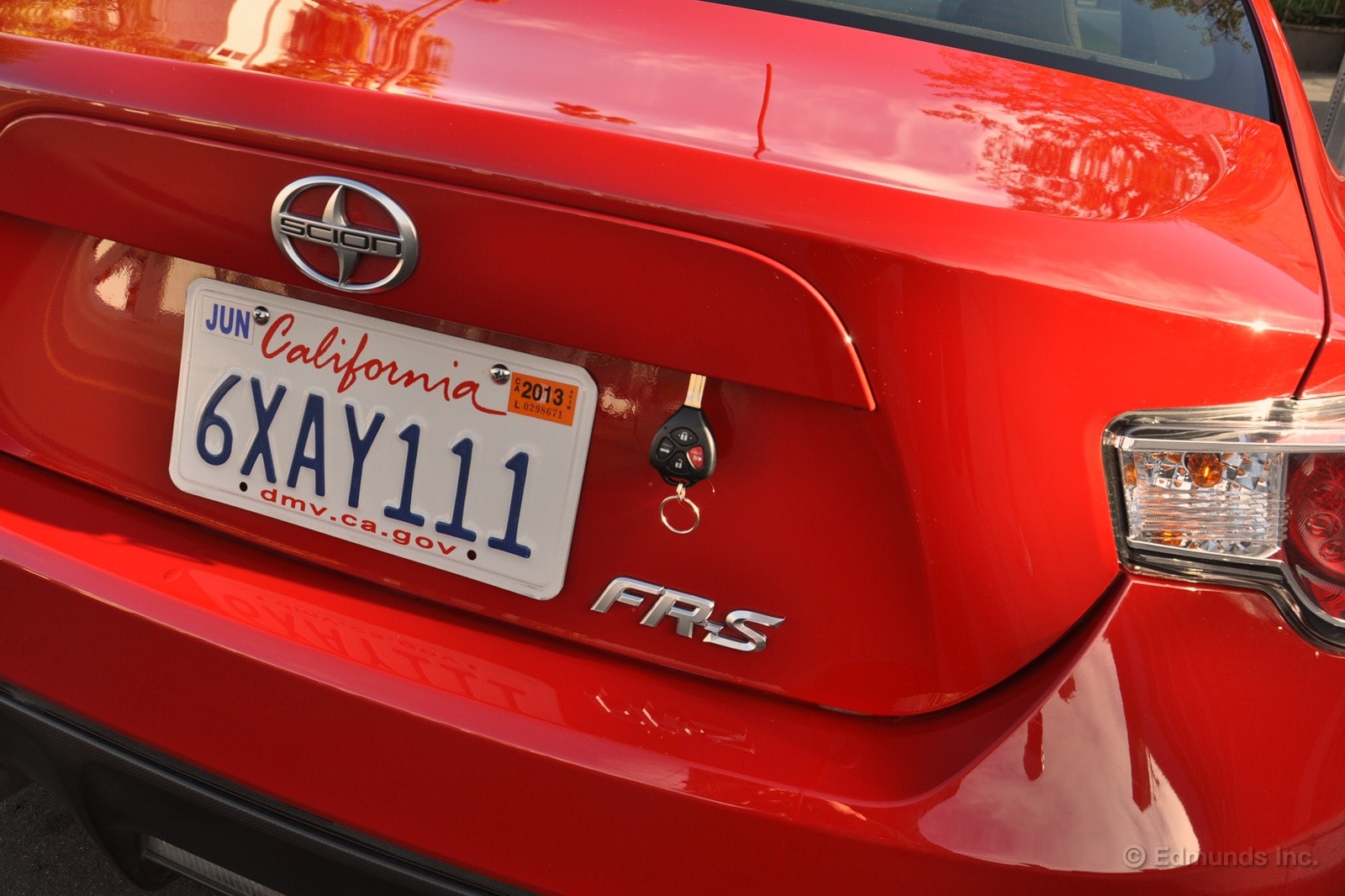
I can't remember the last time I locked the trunk of any car, and in the case of our long-term 2013 Scion FR-S, I'd be way more concerned about someone making off with the entire car rather than any one of my worldly possessions in the trunk.
If you want to lock the trunk of an FR-S (or a BRZ), you'll have to fumble around a bit to find the out-of-sight keyhole in the lid. I guess the location is kind of a hassle if you actually do need to use it regularly, but I like its hidden location because it makes for a cleaner design in back. This near total rejection of extraneous clutter is one of the things that make the Scion-Subaru twins so appealing to me.
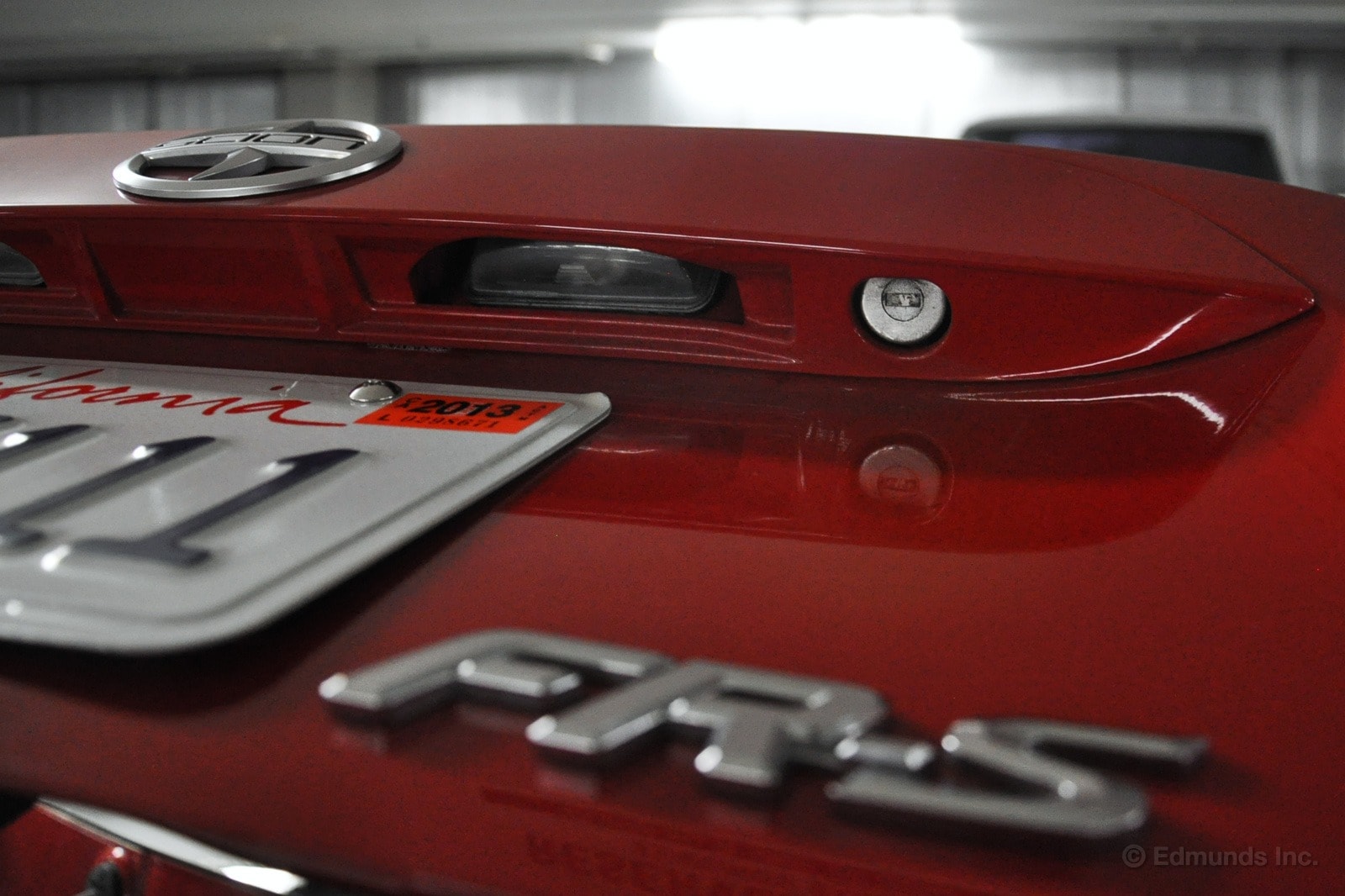
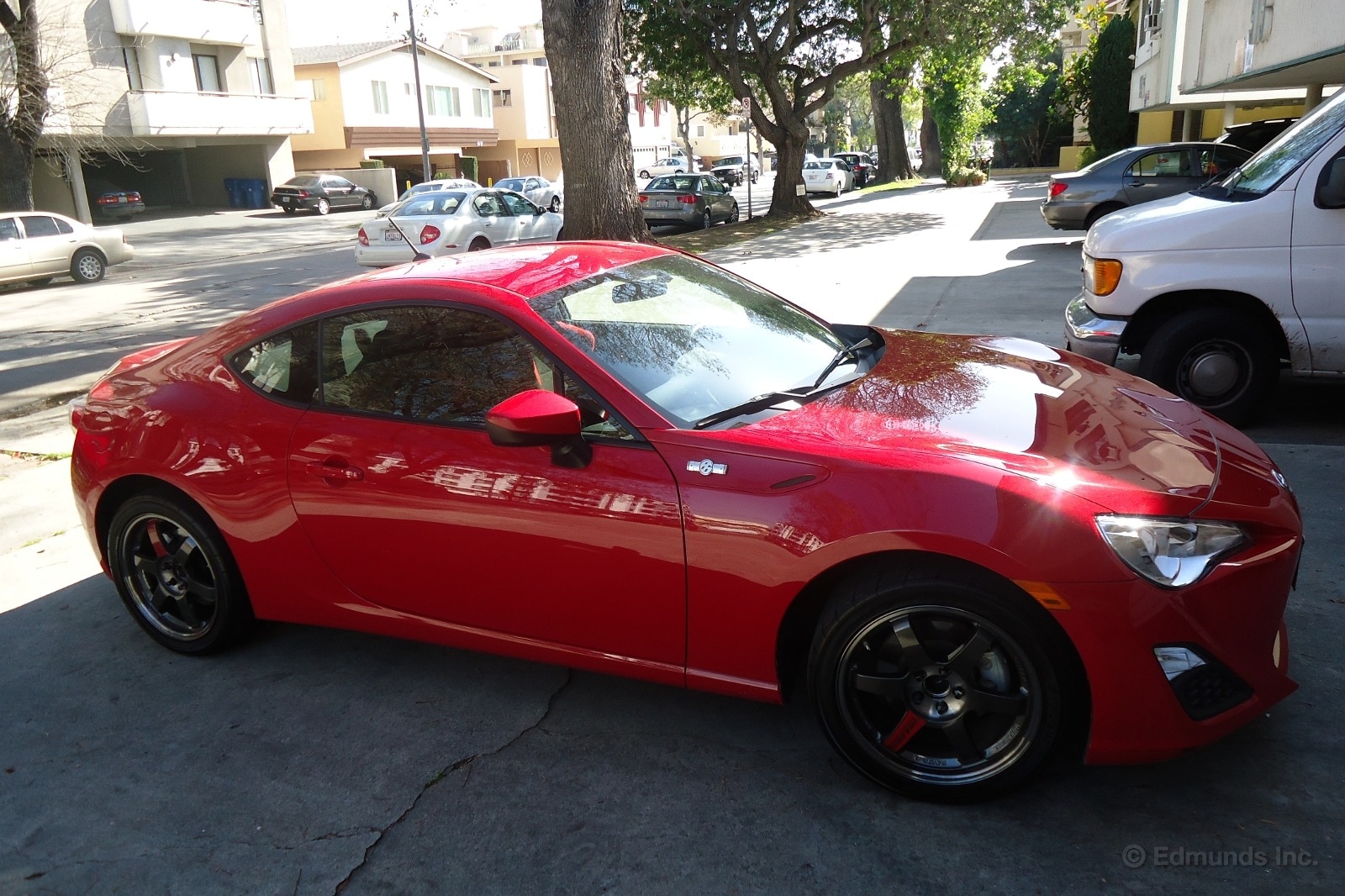
Sometimes you have to make a few compromises to save a few bucks. But there are cases in which you don't, and the Scion FR-S represents one such example. The coupe nabbed a place on our recent top 10 list of the year's least expensive coupes.
While the FR-S isn't heavy on luxury or space, it offers abundant style and is loads of fun to drive. And with a starting price of just $24,500, you don't have to break the bank to get your jollies. Sounds like a good proposition to us.
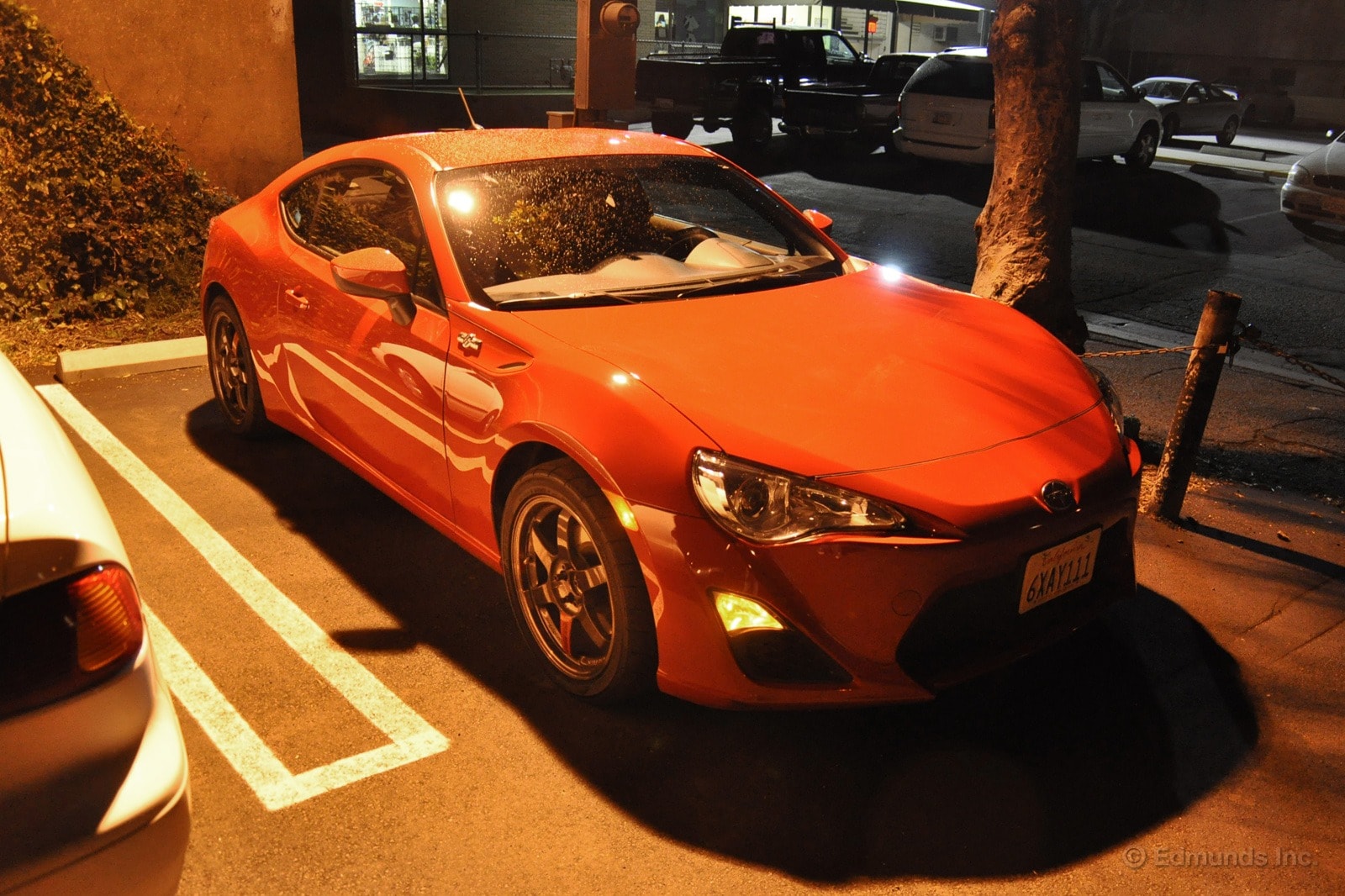
There's no denying that our long-term 2013 Scion FR-S has a great stance with its Volk Racing wheels and stickier Yokohama Advan Neova AD08 tires we put on it. I love that it still has meaty sidewalls, too. And if you read our latest Track Tested and watched the track video, you know it has a ton more grip.
This is absolutely the wheel/tire package I'd want if I was going to use FR-S for track days, as Jay Kavanagh has, because this is exactly what you're supposed to do with this car after all.
But if I bought an FR-S and my priorities changed and I couldn't afford to do track days very often and I ended up just commuting back and forth to work in it, as I did for several days last week, well, I'd probably revert to the stock wheels and tires.
It's not the firm ride I take issue with, though it is very firm. It's the increased road noise you get with these tires. It makes for a consistently high decibel level in the cockpit, and if you want to listen to any kind of radio that involves people talking, you have to either crank the volume or forget about it.
I'd totally be OK with this compromise if I knew I was headed out to do some fun driving, but when you're just going to work, I think the stock all-season-like Michelin Primacy HP tires have their place. If this were my car, I'd keep the other set of wheels in the garage next to a floor jack, a tire iron and a torque wrench and swap them out depending on my mood.

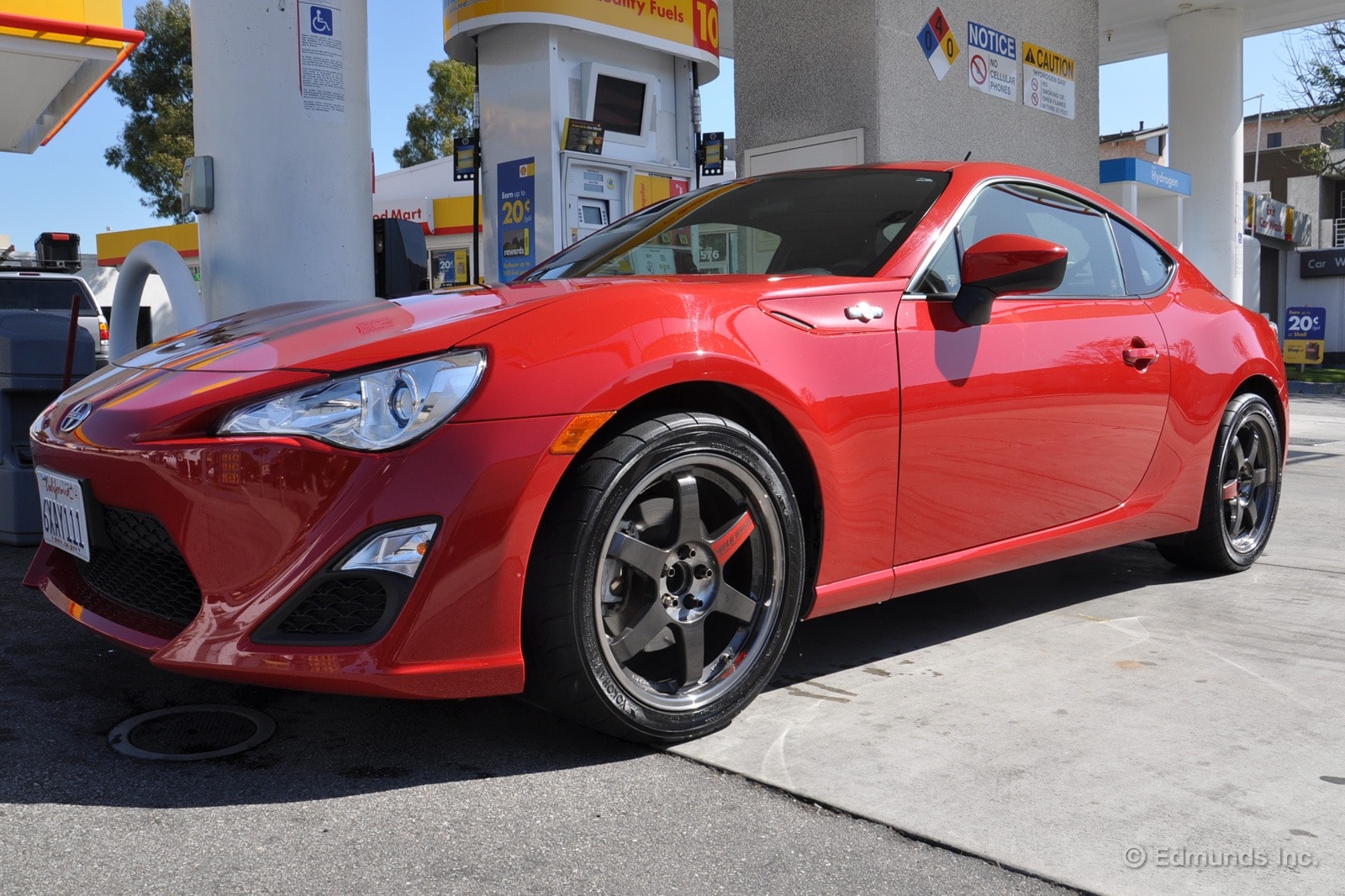
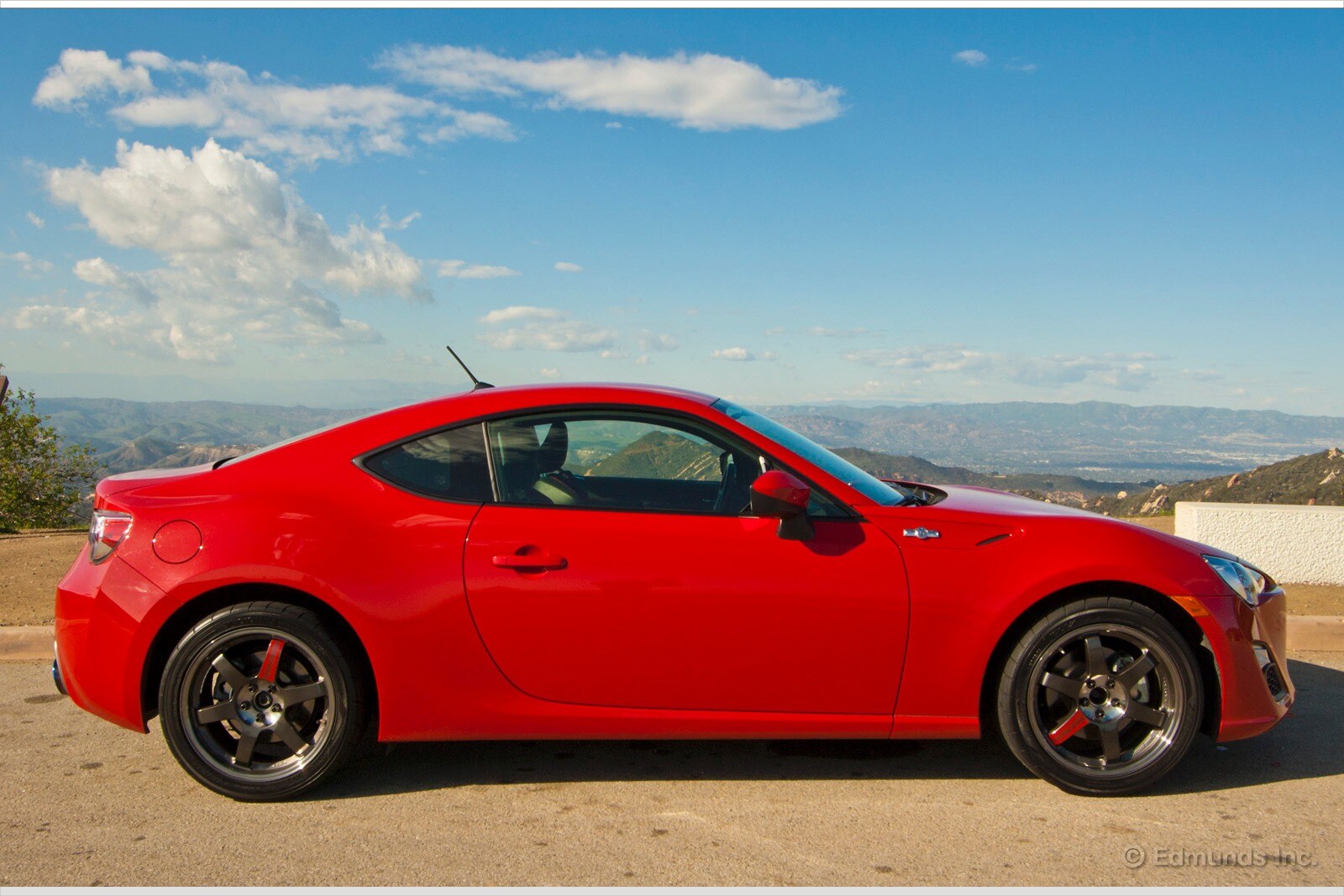
I love the wheels on our 2013 Scion FR-S. The Volk Racing TE37SLs and the Yokohama Advan ADO8 tires that they're wrapped in are two of my favorite aftermarket products. The ADO8s are a little loud and will wear down quicker than the stock tires on daily commutes, but they're sticky and I'm on board with that. There is something, however, that I can't stand about these wheels.
I hate the massive stickers on the wheels.
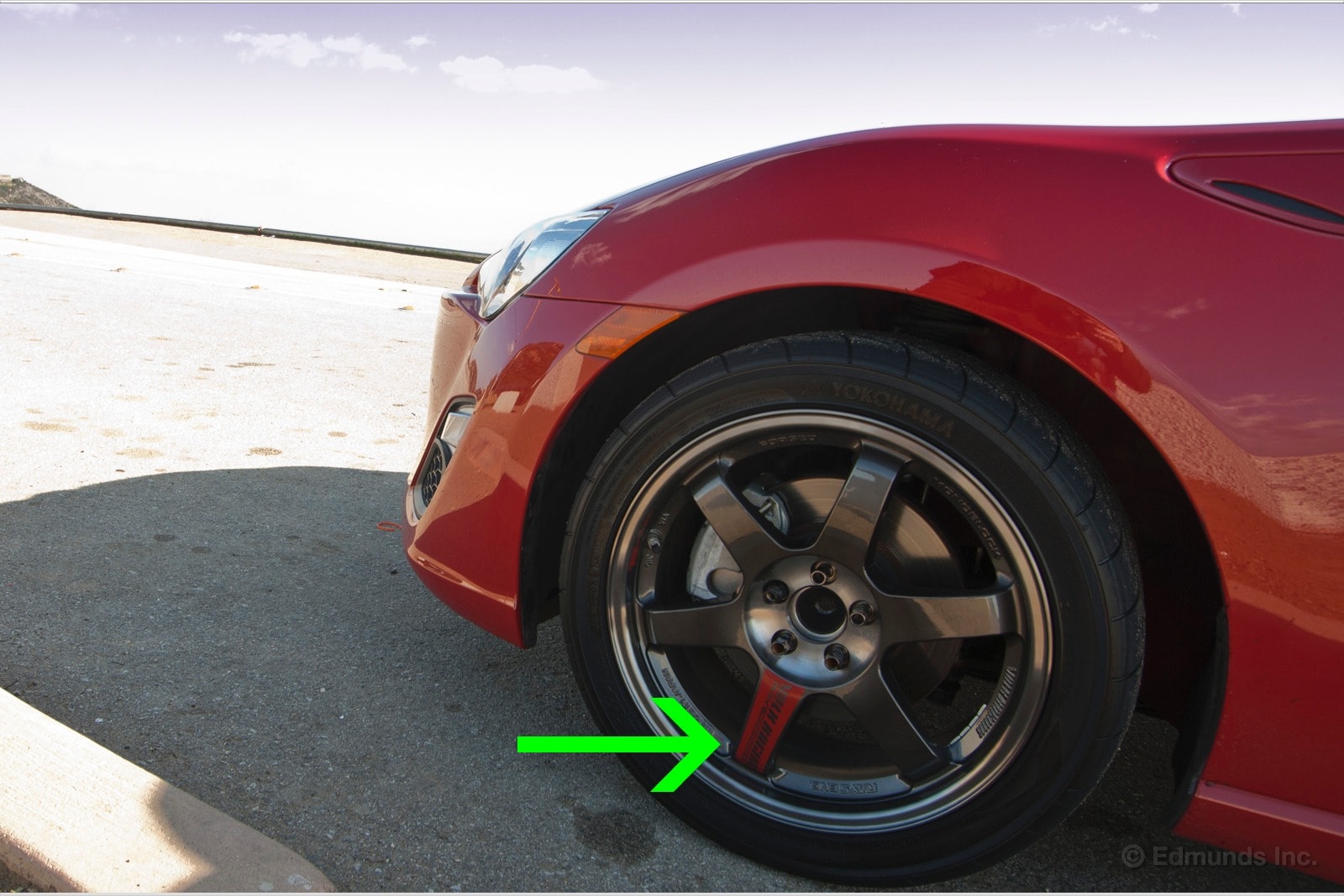
There are probably a hundred knock-off copies of the TE37s on the market. Most of the copies are made with inferior processes and materials which make them heavier and more prone to failure. We wanted strong, lightweight wheels, so we got the real deal.
The authentic wheels however, come with giant stickers that I think are hideous (even though they color-match the car). You could likely fake the stickers as well, but there's no denying they help these authentic wheels stand out in a crowd. No doubt your buddies will be more impressed at a parking lot car meet, but I think the stickers nearly ruin the look of a great wheel.
Also, I imagine it looks pretty funny while the FR-S is rolling along at low speeds, like something got stuck to one of the spokes. What do you think?
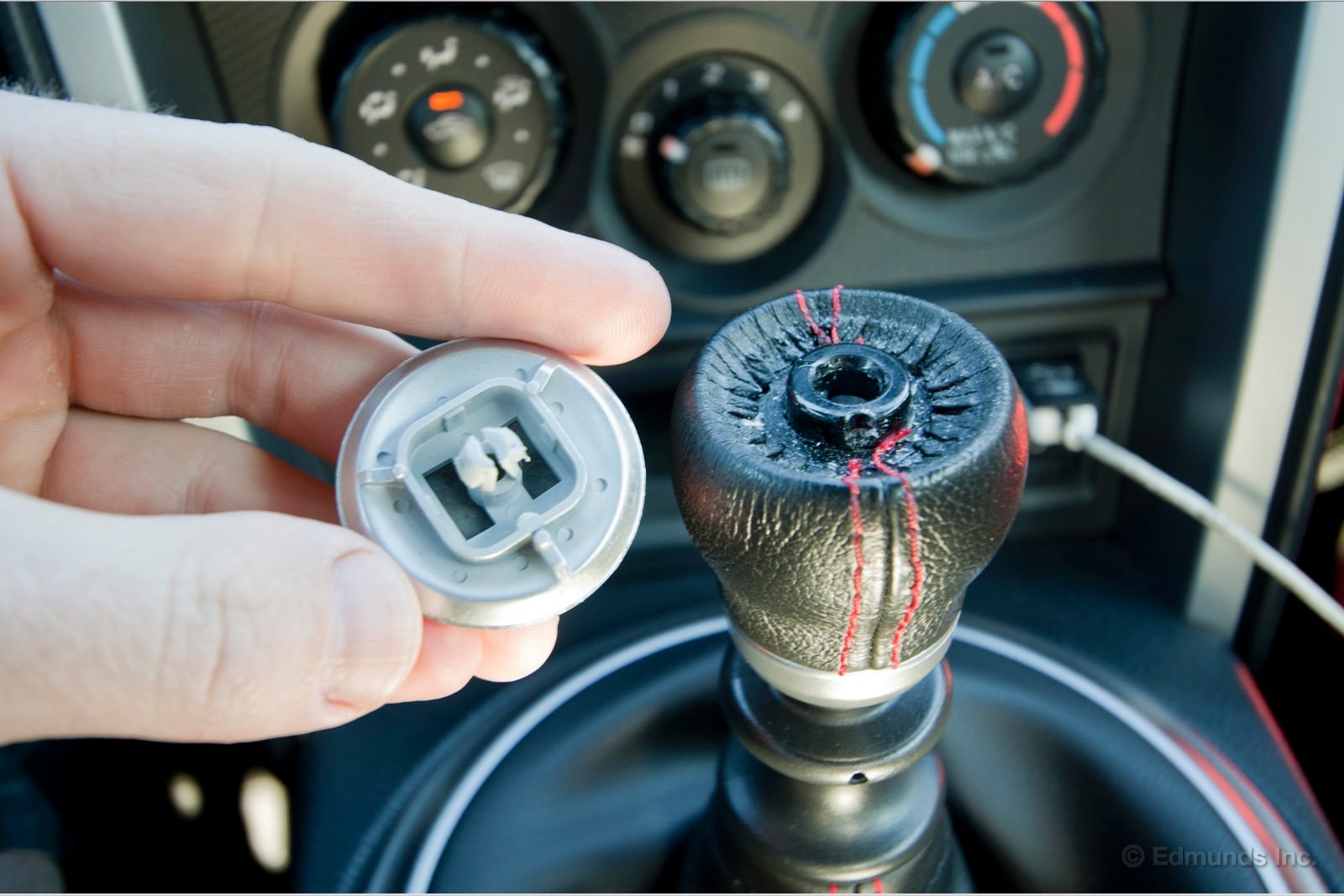
The shift knob for the six-speed manual transmission in our long-term 2013 Scion FR-S is one of my least favorite parts of the interior. I just don't like the feel of leather and plastic while shifting.
Luckily, the cap broke off in my hand today. It was easy to pop back in to place, but it still feels loose and flimsy. Maybe it'll be a good excuse to start shopping for weighted, metal replacements. What would you replace it with?

My longtime friend and fellow car enthusiast Albert pulls up next to me in his Honda S2000 and examines our long-term 2013 Scion FR-S.
"Red is my least favorite color but I would still trade my car for that any day of the week," he says. "Damn, that thing is clean."
Our friend Ian arrives in his Hyundai Genesis 2.0T R-Spec coupe and we take off for a Sunday morning drive. I was on a spirited jaunt with friends, but I couldn't help to think, "Which one of these would I want to own?"
The canyon roads in the Santa Monica Mountains are a perfect location for a weekend excursion. I took our Subaru BRZ here a few days ago and loved it. Just a short drive from Los Angeles (if you're awake early enough), these back roads are a great way to test braking, acceleration, handling and comfort. Our lightly modified FR-S was an ideal weekend warrior candidate.
All three cars are rear-wheel drive, and the power is pretty similar. The S2000 has the highest horsepower of the three but it only comes in convertible (the hardtop you see is aftermarket), it has just two seats and the trunk is tiny. For 2013, of course, the power came up significantly on the Genesis Coupe thanks to the arrival of direct injection (pictured is the 2011 2.0T model) and the updated styling is great, but I think the Hyundai's too big for these roads.
At the front of the pack, I'm driving the FR-S at a comfortably brisk pace, keeping my throttle and braking inputs smooth. Despite the car's modest torque, I never feel like I'm holding up the group on the s-curves or ruining the view on the straights.
"Man, that thing even looks good from behind," Albert says as we exit onto Pacific Coast Highway.
A hundred miles of hard driving in just a few hours and I was no worse for the wear. Planted, confident and comfortable, the FR-S is capable on back roads, but it's not so hardcore that you can't stand to drive it on normal roads at a normal pace.
That all-around drivability, combined with the Scion's respectable mid-range power, seats that fit me like a glove, and attractive styling really appeals to me. Out of this group, I'd take the Scion FR-S over the S2000 and Genesis Coupe 2.0T R-Spec, and it's an easy choice.
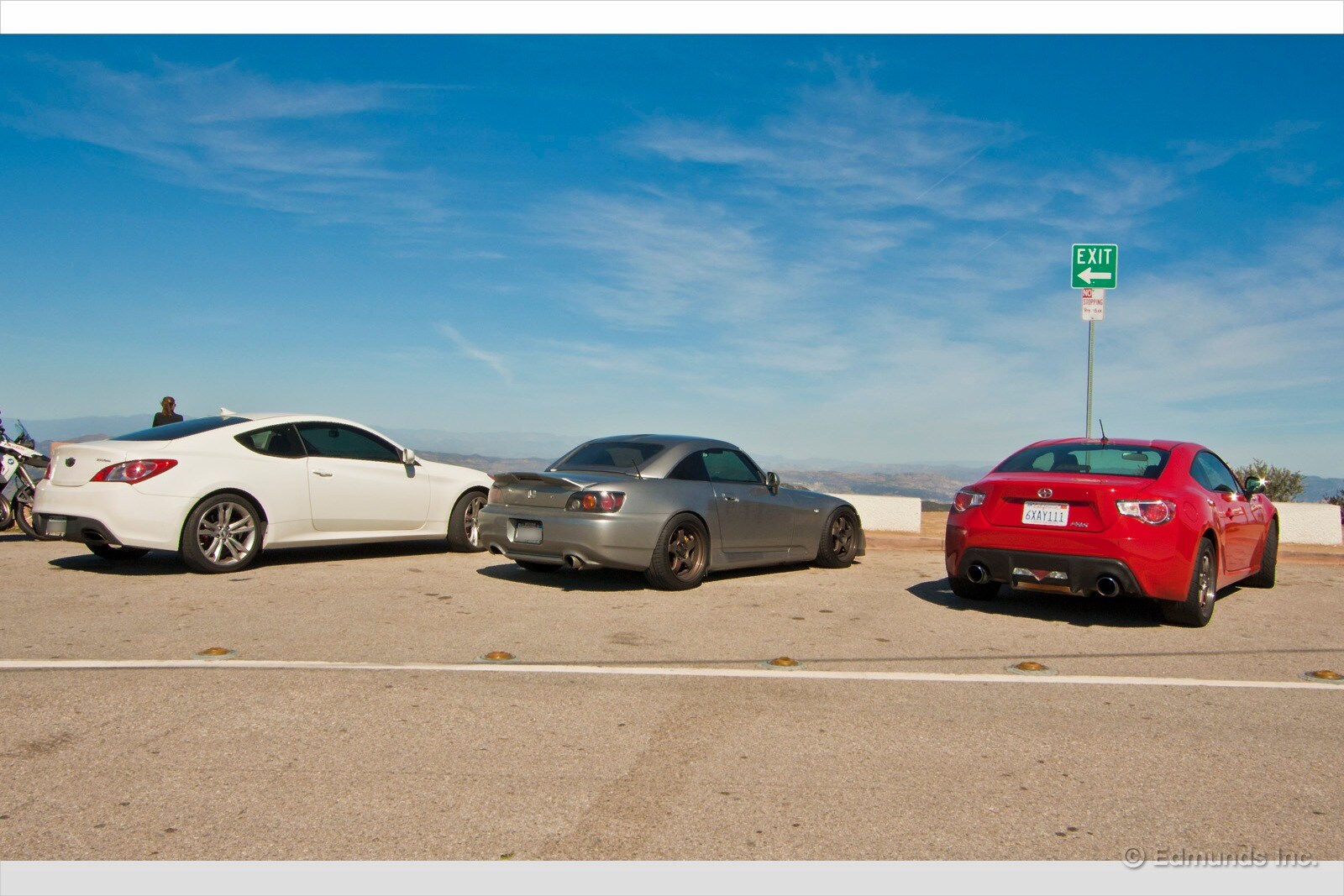
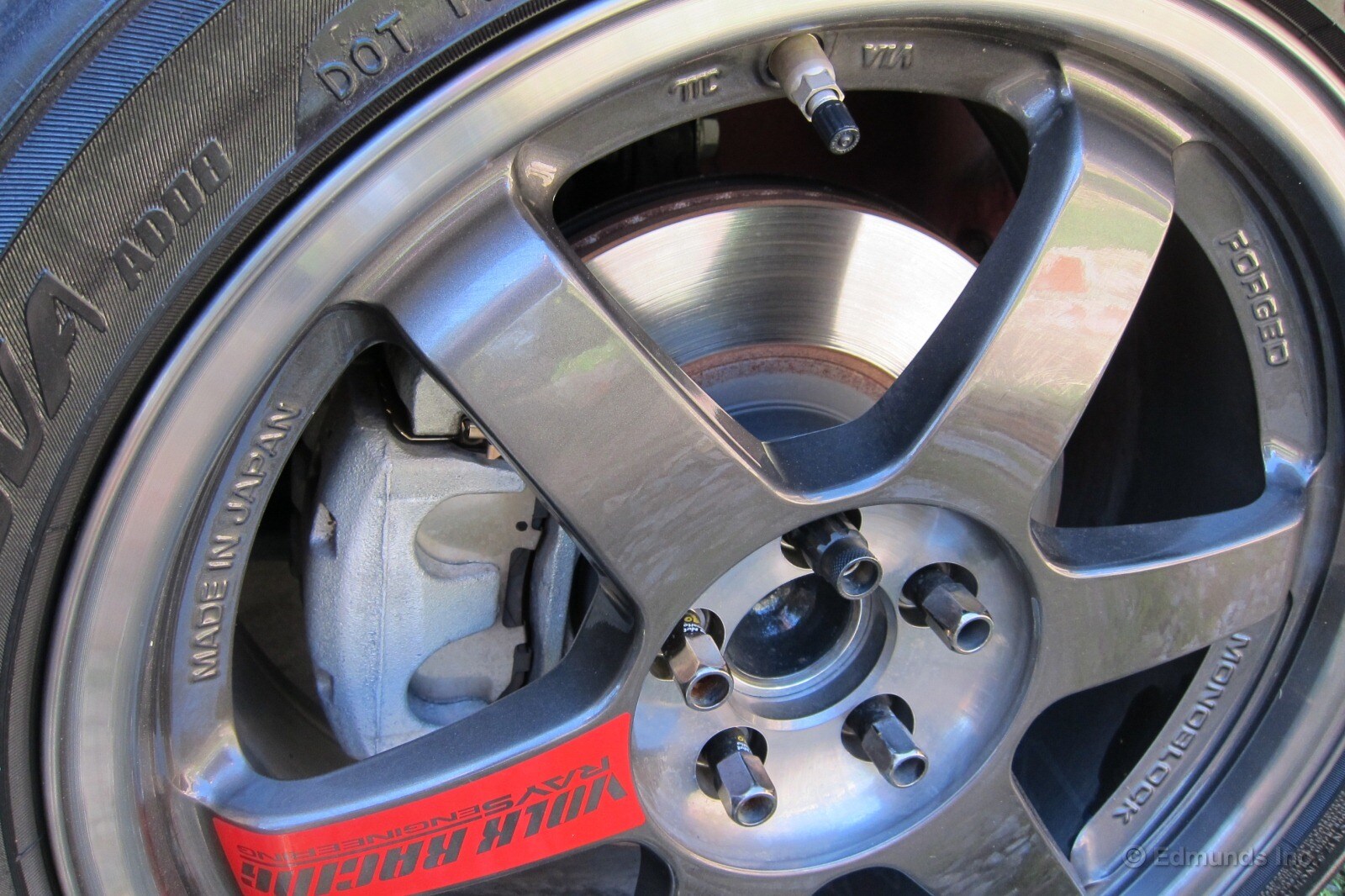
This is not entirely unexpected. The brake pads in our long-term 2013 Scion FR-S are done. There's still meat left on them, but like any meat that's been overcooked, they feel like plywood now.
Around town, there's less bite to the brakes than there used to be prior to running the FR-S at Laguna Seca a while back. Like I said, this result is not unexpected. Nuke the brakes of any car at a track day and they'll suffer the consequences.
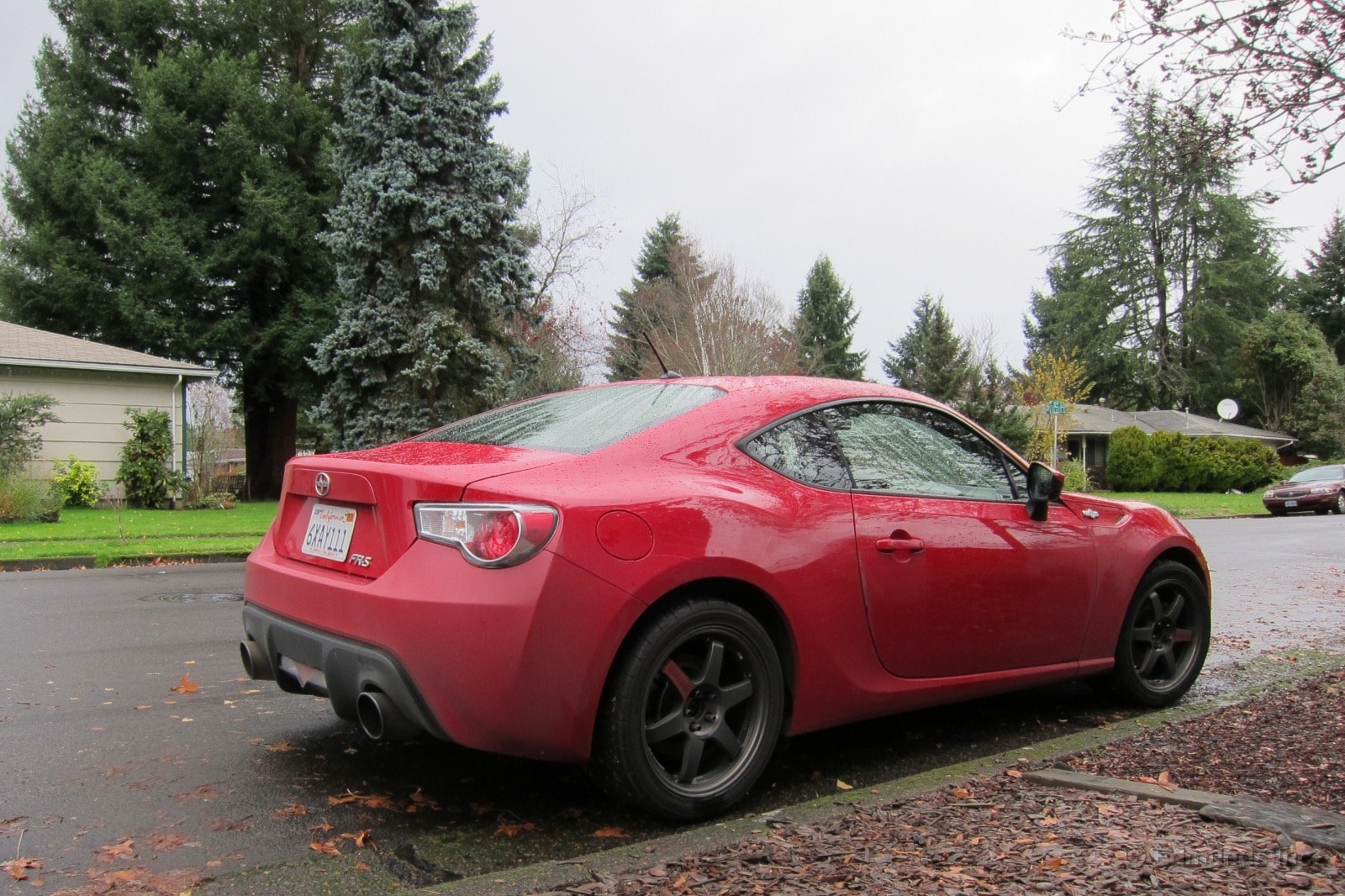
Two easy steps made our 2013 Scion FR-S faster than ever. Here's what you need to do:
Step One: Drive to Oregon. When I drove our long-term FR-S up to Corvallis, OR, I had the distinct pleasure of filling up with 93 octane. Well, someone else actually did the filling (crazy state law), but I enjoyed the fruits of that labor. In California the best fuel we can get is 91 octane. And 91 octane buh-lows.
Step Two: Do It At Night. The night was cold and the car was warm when I filled the FR-S with this high-octane swill (seriously, 93 octane is like race gas compared to 91). It was in the high 30-degree F. range. Cold ambient conditions are high in density, packing more oxygen into each cylinder, and they also allow more ignition advance in knock-limited engines. More advance liberates more grunt.
I gave it the wood on the freeway on-ramp. The car was noticeably faster. This was no placebo effect, the thing was significantly more eager to chew through the revs. So I obliged by doing it again and again.
Okay, I actually can't say for certain which of the previous steps was more responsible for the increased pep, but I can say that the car was way more urgent afterward when both conditions were met.
California, kindly insert your 91 octane "premium" fuel into a dark place.
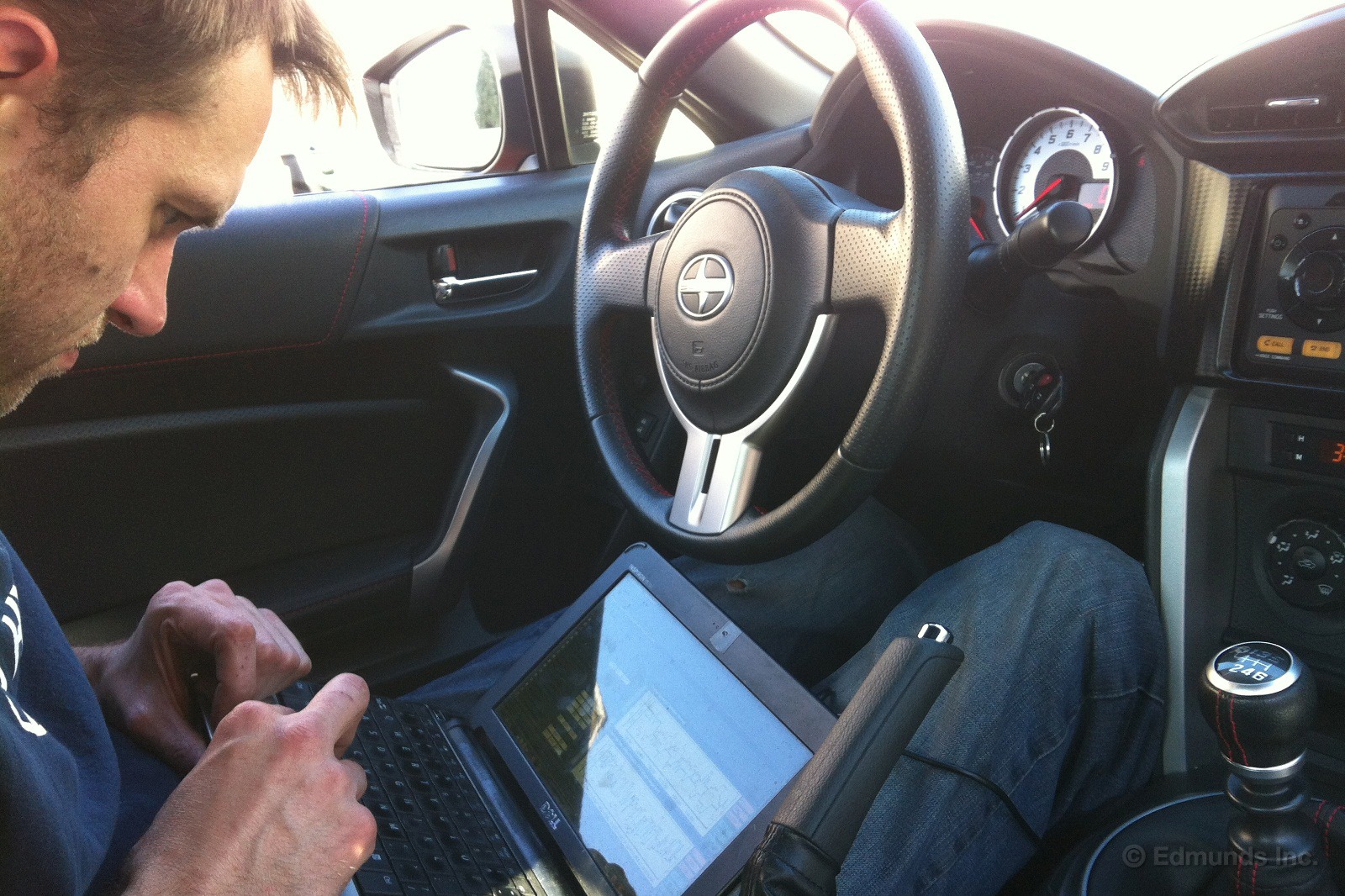
That's Mitch Pederson of MP Tuning getting busy with the BRZEdit ECU reflashing software on our long-term 2013 Scion FR-S. This is significant, as BRZEdit clears a huge hurdle in successfully implementing forced induction.
But we're taking one step at a time. Currently we're (by that I mean Mitch) just exploring the software, getting a feel for its capabilities, and confirming that it works as advertised. Don't want to rush into this, that's for sure.
So far, so good. BRZEdit impresses. Its interface is intuitive and appears to have been developed by people who understand engine tuning. Many, many maps are at the tuner's disposal, and it's fun to watch Mitch fully immerse himself into them. As you can see, he gets into a trancelike state.
There's not much to report yet, but we'll have more to share once we nail down some dyno time.
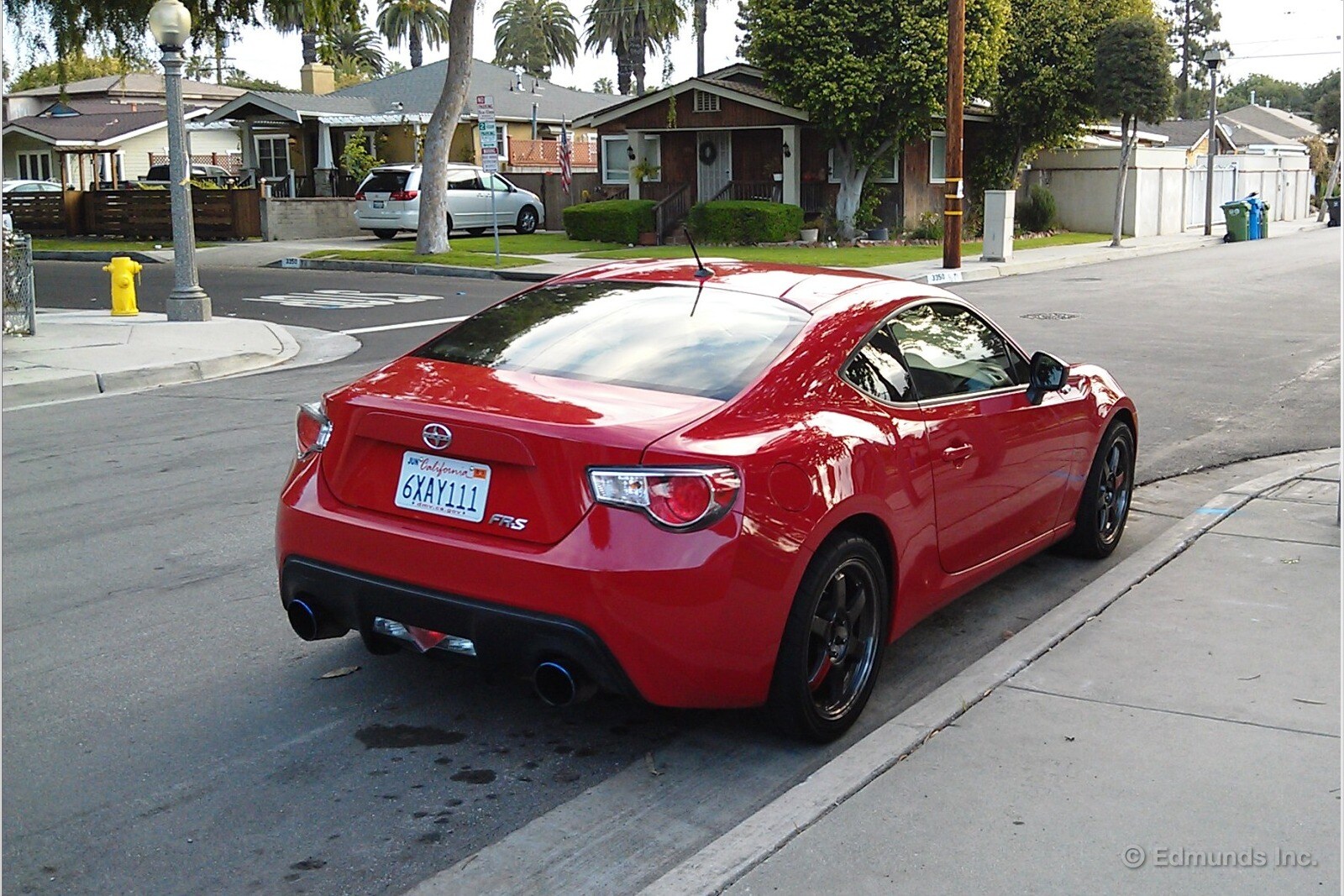
Our Scion FR-S had light duty for the month of March, adding just over 700 miles to its odometer. No records, good or bad, were set for its fuel economy history as the Scion stayed the course, that being providing a lot of driving fun in a car that in our environment is still averaging 24.3 mpg.
That nearly matches the EPA combined figure of 25 mpg. And by "our environment" I mean one in which the car is subject to a lot of L.A. traffic and a lot of pressure from our staff's rather enthusiastic feet.
Worst Fill MPG: 16.9
Best Fill MPG: 30.0
Average Lifetime MPG: 24.3
EPA MPG Rating (City/Highway/Combined): 22/30/25
Best Range: 335.1
Current Odometer: 14,716
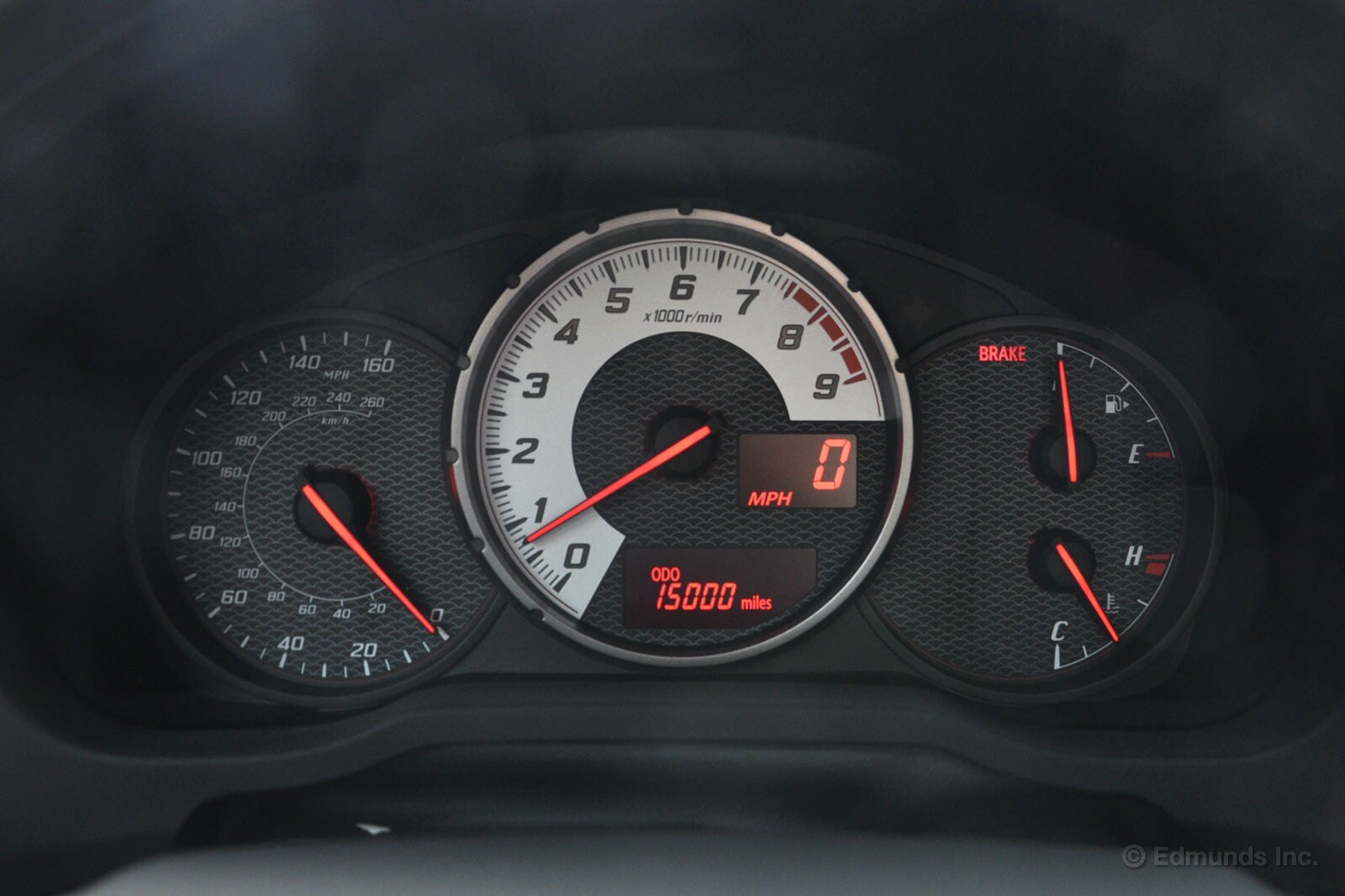
Our long-term 2013 Scion FR-S hit 15,000 miles just as I arrived at work on Monday. It's aging well considering its aggressive price point, as there are no annoying rattles yet and the simulated suede upholstery still looks new. The stock audio system still sounds no better than my clock radio, but that isn't why you buy this car.
So why would you buy this car? Well, I imagine because you'd like to take it to track days like Jay Kavanagh. There's also a strong case to be made for getting an FR-S just to enjoy in your everyday life on public roads. I didn't make it to the mountain roads over the weekend, but I still had fun commuting in our Scion.
I love the quick steering and the car's overall haste in changing direction. The pedals are set up nicely for heel-and-toe downshifting. The engine needs more personality (or failing that, a turbocharger), but one thing it does have is ample torque for dealing with traffic.
I'm not saying our Scion FR-S is quick, much less fast. I'm saying that if you compare it sport compacts of 10-15 years ago, it's a commuter's dream. It can pull low revs in 2nd and 3rd gears when traffic slows down, so you're not constantly having to go to 1st or Neutral, and there's still room to accelerate in 6th. For me, this makes the FR-S instantly more appealing than an Integra or Prelude of yesterday.
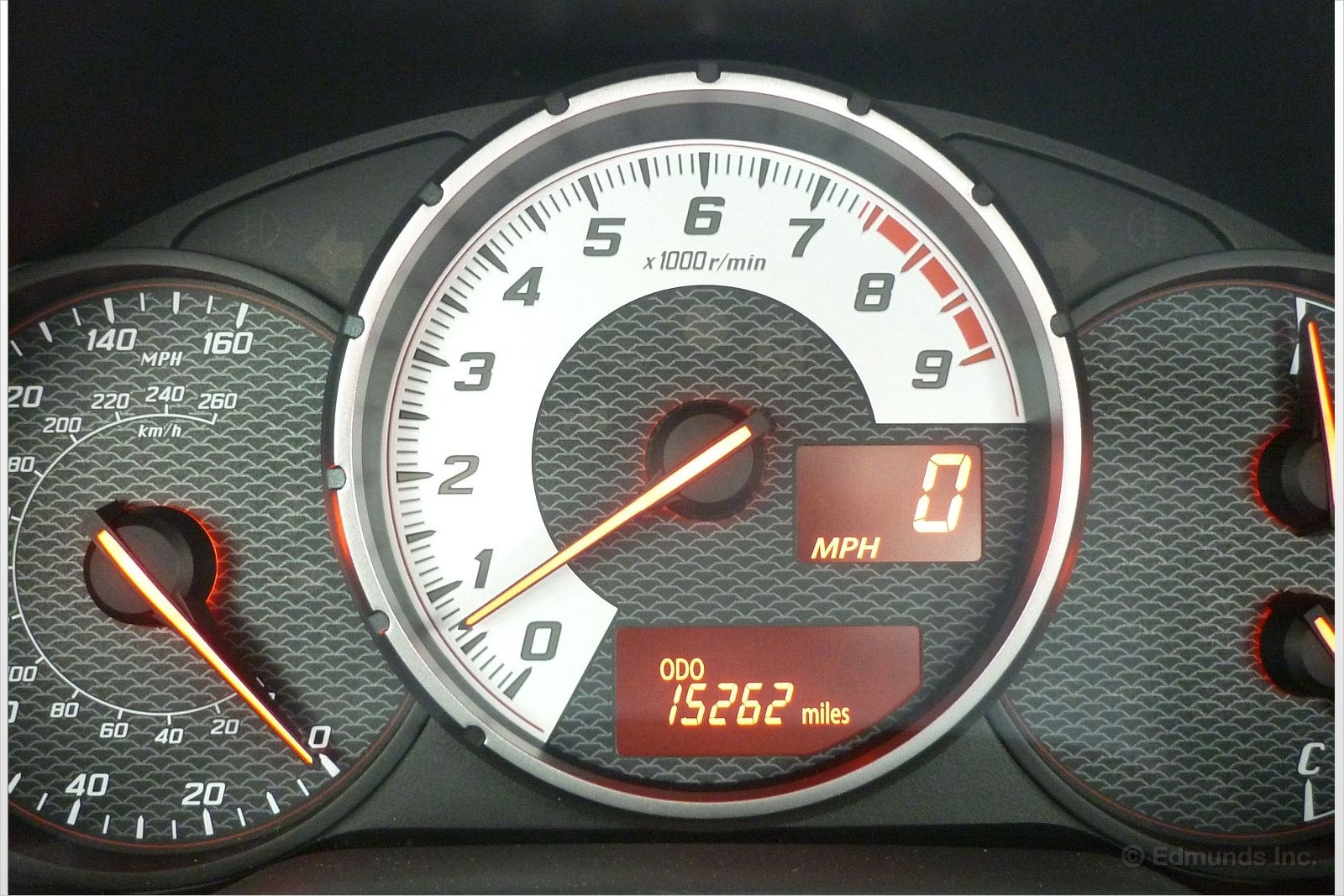
Maybe it was because I had spent most of the week driving mid-size sedans. But when I sat down in our 2013 Scion FR-S and fired it up for the drive home, I realized, yeah, this is how it's supposed to be.
What was I talking about?
The Scion's large tachometer, situated dead smack in the middle of the instrument panel. Where it belongs. Oh, and the easy-to-read digital speedometer. I like that, too.
This is exactly the setup you want in a proper sports car.
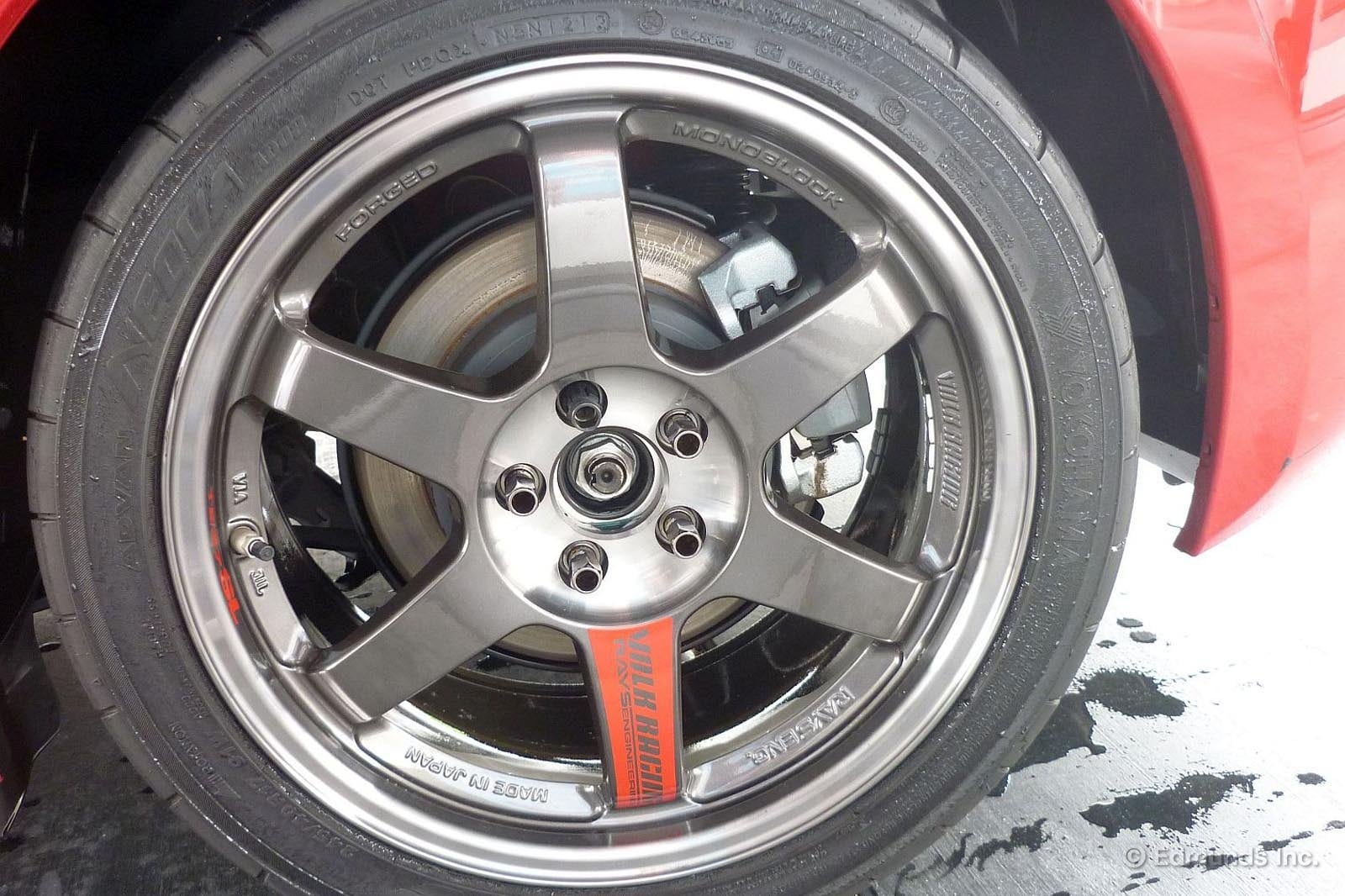
This morning after the 2013 Scion FR-S and I emerged from the car wash, I realized there's another benefit to these aftermarket Volk Racing wheels besides improved performance and styling.
They're a breeze to clean, or in this case because I used a car wash, dry off. As you can see, they have pretty much zero nooks and crannies, so a brush or a rag easily rids the wheel of all dirt.
Of course, because life always goes perfect for me, it rained on my drive to work after this.
Awesome.
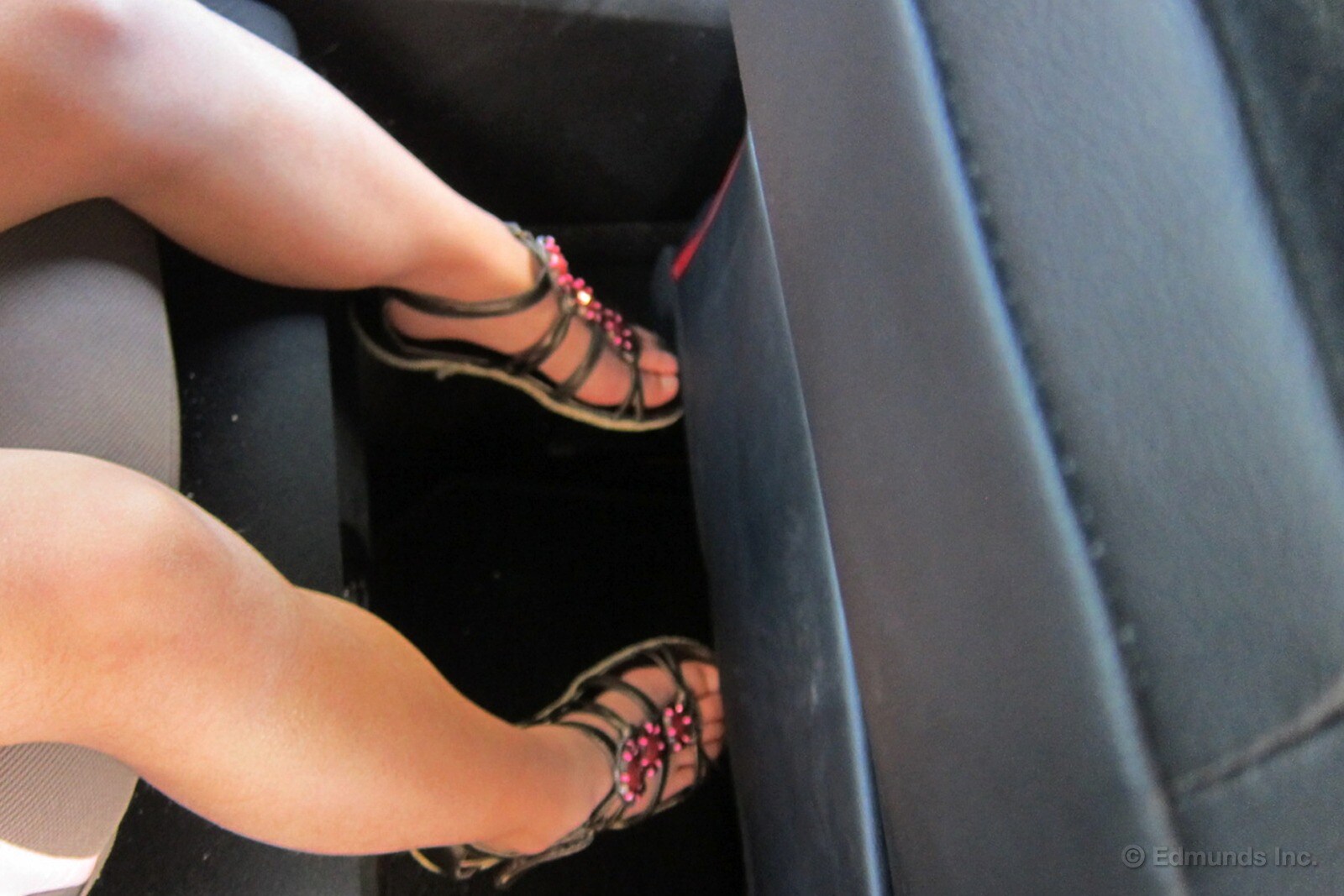
You already knew that the 2013 Scion FR-S doesn't offer much rear-seat legroom. Just 29.9 inches, in fact. But as this photo illustrates (possibly poorly), the FR-S is still up for a small family challenge. She didn't have a ton of room to stretch her legs, but our 7-year-old did fine back there during a day of driving around town, taking in the sights. No complaints about space or headroom with the booster seat.
Front-passenger Mom is 5'2" and petite, and could afford some forward seat travel. A taller front passenger would've run the kid out of luck. As the saying goes, your mileage may vary.
The FR-S isn't your first-choice family car. It's stiff and noisy. Cabin conversation requires a forceful voice. But it does the job in a pinch without punishment. I could see the Scion FR-S (and Subaru BRZ) being an ideal car for a newly-minted parent coming from a Miata or S2000, or perhaps needing to retire an aging Integra or RSX, but still looking for that thrill.
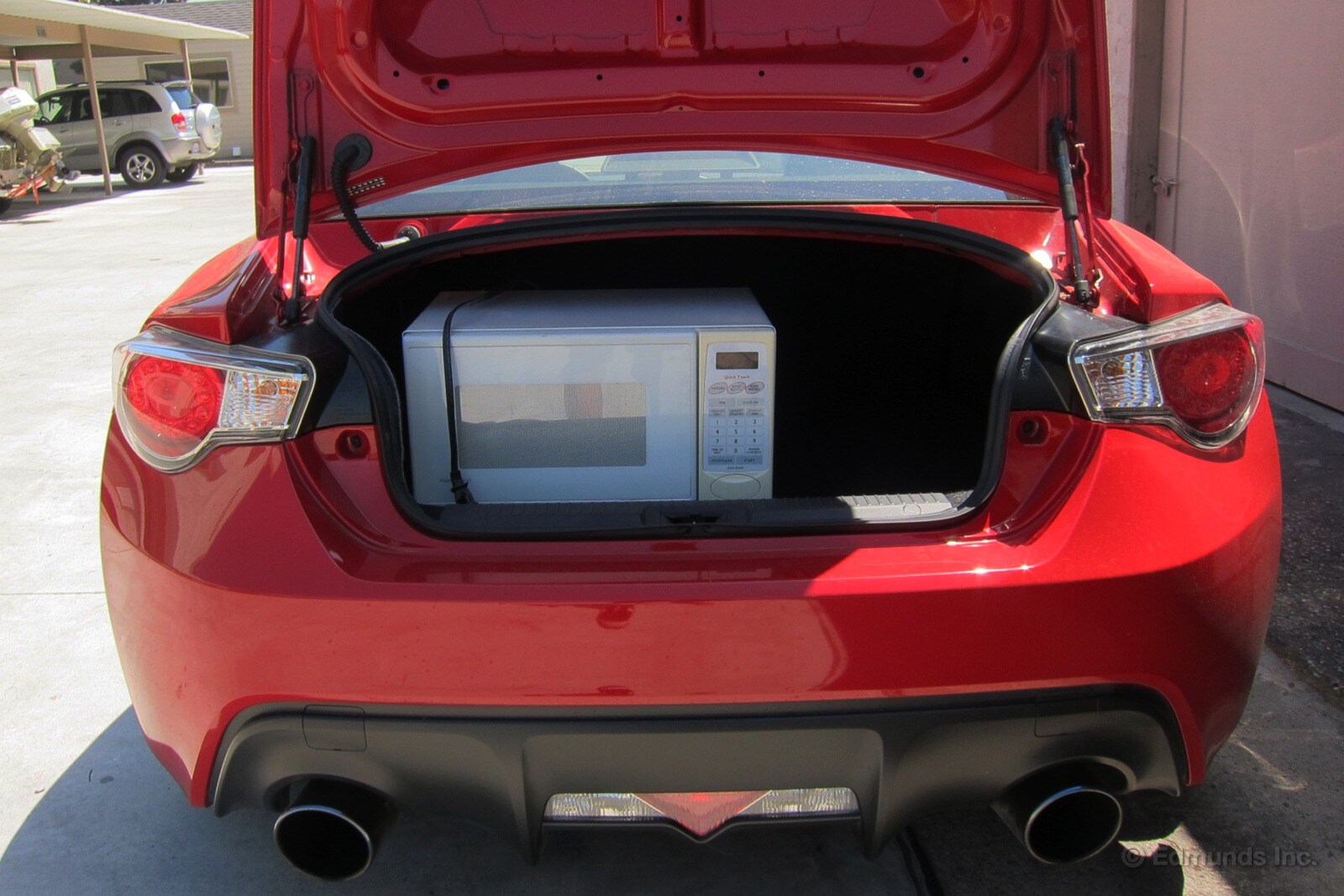
It was an inglorious job, but I needed the Scion FR-S to help me retire an old microwave to a nearby household hazardous waste recycler. Monday being Earth Day and all, it seemed like an appropriate mission in a sports car in which we're averaging 24.3 mpg in combined driving. That's just 0.7 mpg shy of what the government's green people say we should be getting. And further proof that the FR-S isn't useful only for inducing permagrin in decreasing radius turns.
The irony? The recycler is closed on Mondays. Even on Earth Day.

This update concerns a really small thing about the 2013 Scion FR-S, but it makes a difference to me.
Recently, I made a weekly grocery run for my household of two. I had my standard-size cloth and vinyl grocery bags with me, because they're required in the part of town where I live. And with the bags fully loaded and upright, there was just enough vertical clearance to shut the trunk lid without crushing the spinach.
If the Scion FR-S had cheapy metal hinges (like the S14 240SX I used to have), instead of these external struts, this wouldn't have possible. The spinach would have been bruised.
This is yet another reminder that compared to sport compacts of yesterday, the Toyobarus are amazingly practical.
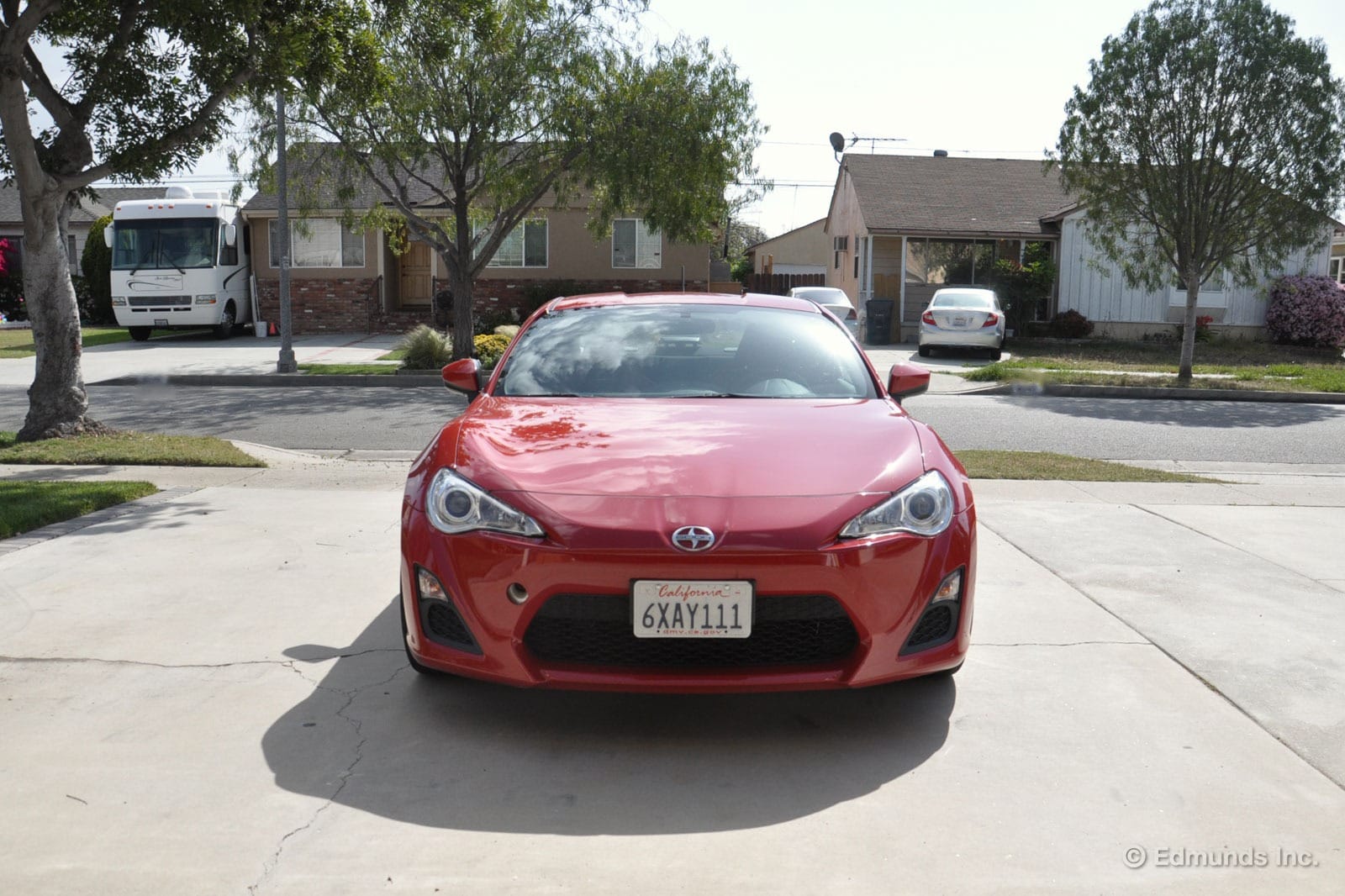
We put 1,212 miles on our long-term 2013 Scion FR-S during the month of April. That's a low total for us, and someone will simply have to take this car on another road trip before this long-term test is over.
The FR-S averaged 25.3 mpg over this stretch (taking 47.9 gallons of 91 octane fuel), which is higher than our lifetime average of 24.3 mpg. Twenty-five just happens to be the EPA's combined fuel economy rating on the manual-shift FR-S.
Our best tank (28.7 mpg) of the month was logged by yours truly, but that pales in comparison to the car's lifetime best of 30.0 mpg. Our worst tank of the month came in at 18.7 mpg, but we've done worse (16.7) in previous months, and of course, we're excluding any fill-ups that occurred immediately after instrumented testing or track days.
Worst Fill MPG: 16.9
Best Fill MPG: 30.0
Average Lifetime MPG: 24.3
EPA MPG Rating (City/Highway/Combined): 22/20/25
Best Range: 335.1 miles
Current Odometer: 15,849 miles
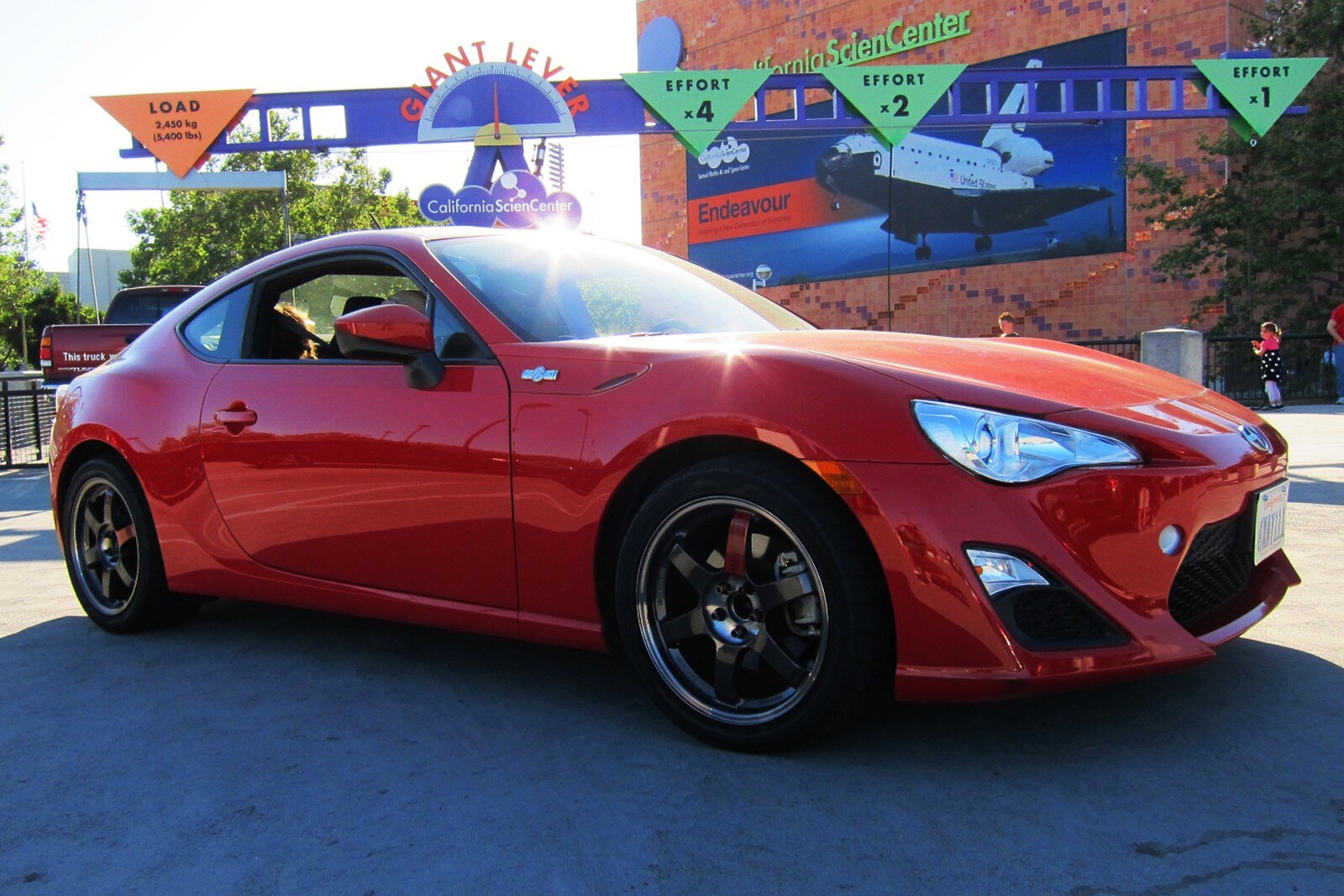
Unless you're road tripping in one of our long-term cars, it's rare to get more than two or three days in the same car. But I managed to stay in the Scion FR-S for a week recently, which generates a good cross-section of comment from friends and strangers. Like friend Mandi, a mother in her late 30's. "That's a fancy car. What is it? A Scion? Is that really a Toyota? Wow."
Or my buddy James, a father in his mid-40s: "This is a Toyota? (It's a Scion.) This is really sweet." (Later) "Oh man, this car's hard for a fat guy to get out of."
Guy at the car wash (peers inside the driver window, scans from the headliner to the rear seat and finally to the dash). "Nice!" with a thumbs-up.
Some of the wife's Japanese girlfriends: "Ehhh? Hachi-Roku? They still make this?" (Sort of, but not what you remember. Explanations ensue.) "How much? Stekki, nah." (basically, approval).
Ben, a neighbor in his mid-60s: "Looks really cool. The same company that makes that little breadbox car? I wouldn't have thought. Reminds me of the old Datsuns (280Z)."
Funny thing about this car, you start looking forward to driving it. Even around town chores get a little cheerier. After a few days, the only thing I wanted was a transplanted Focus ST six-speed manual.

Sometime in the next decade, Ferrari will build something about this size, in similar shape, profile and color. Maybe it will be mid-engine, like the short-run Alfa Competizione 8C. It will cost $150,000-$200,000, will pick up where the BMW Z8 left off and will make the California a distant memory.
Purists will hate it, but it will be a high-margin volume seller for a brand that is increasingly under pressure to contribute more than just halo to the Fiat Group.
Tell me why I'm wrong.
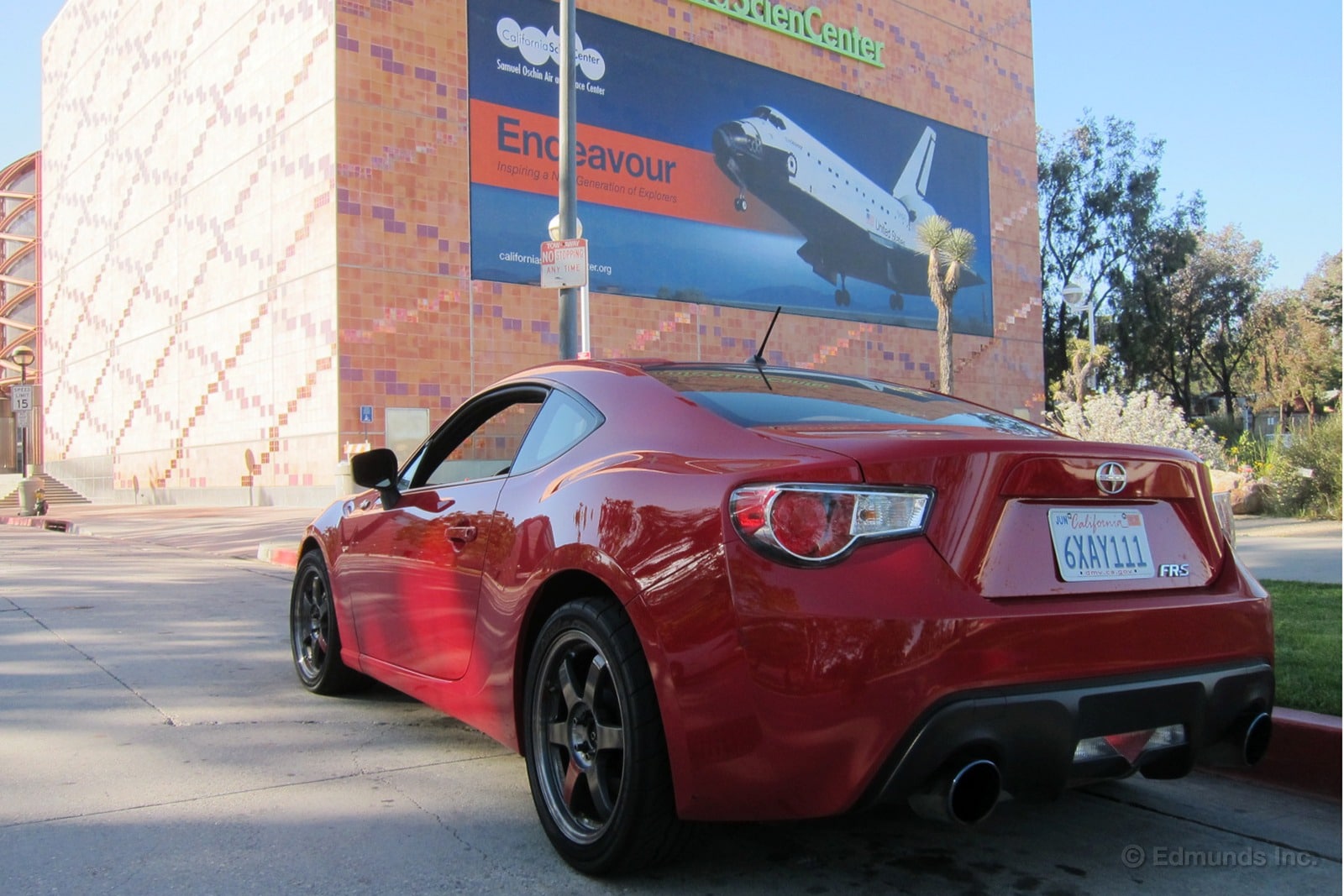
While the kid was on spring break, we took a trip to the California Science Center, located next to the fantastically decrepit Los Angeles Memorial Coliseum. The Spirit of Troy was with us that day as the weather was perfect, Rush and Public Enemy were later inducted into the Rock and Roll Hall of Fame in a ceremony just up the road, and I even exchanged brief Lakers and Dodgers misery with local sports radio icon Vic The Brick Jacobs while walking around Little Tokyo. Feelin' Blue, indeed.
Sorry, that's likely a string of non-sequiturs for most readers. More to the point, we went to the Science Center to see the Space Shuttle Endeavour installation. Fantastic display. If you're in L.A., go see it. It's one thing to see it on TV, or even watch a lift-off or landing in person. Quite another to stand under it, stare at thousands of those thermal tiles and consider the miles THAT thing has seen.

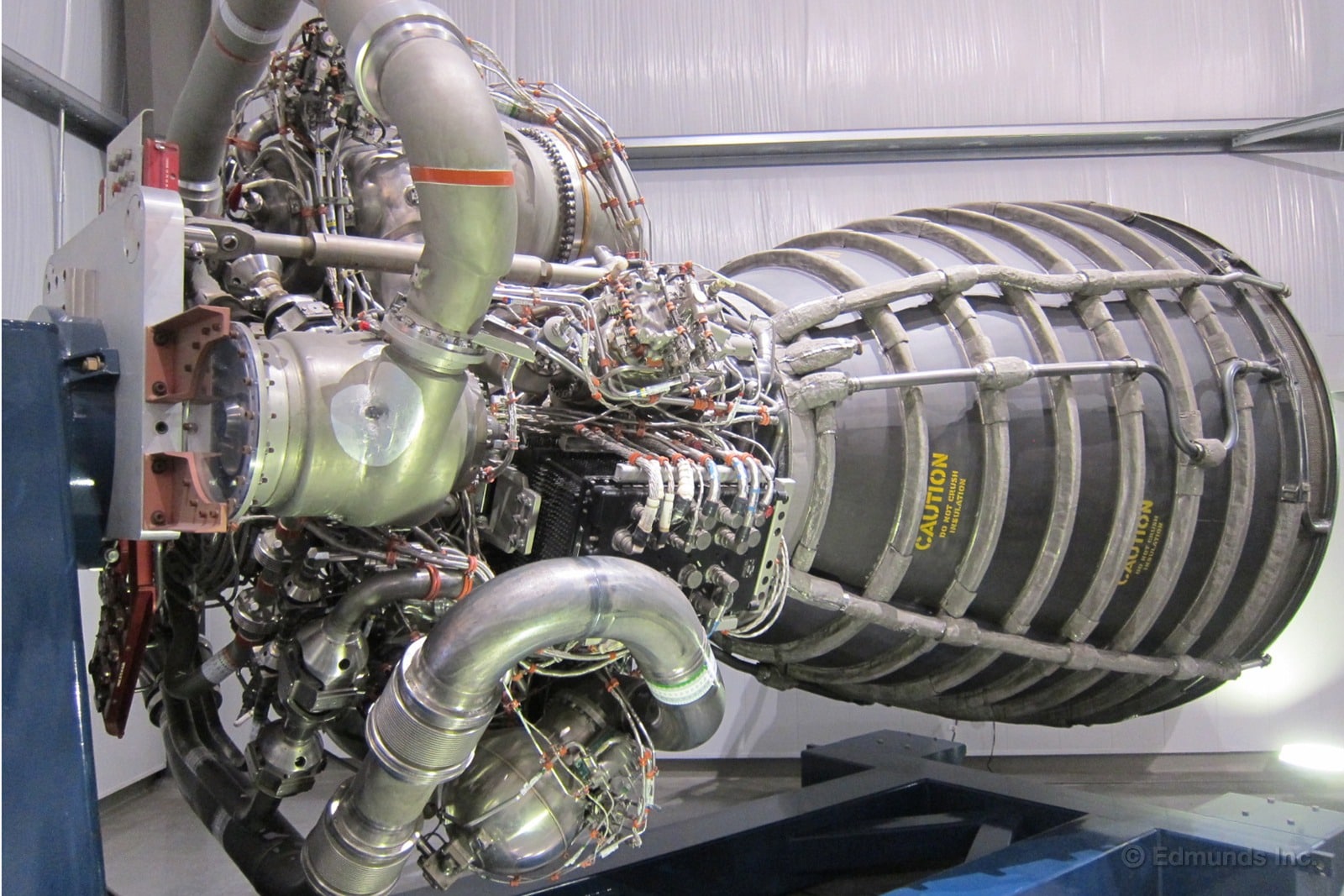
Interestingly, the shuttle looks even less aerodynamic in person that you thought it did in photos. Apparently, engineers even dubbed it the "Aero Brick," but you learn that the aero was never a priority on the shuttle. That thing punched its way out of the atmosphere and bullied itself back in, only needing curves sufficient to minimize heat on re-entry and glide itself to a runway. Regardless, it still seems like a marvel of engineering and American innovation, and it's hard not to be awed in its presence.
The Scion FR-S isn't a marvel on the same level, but it is something of a marvel in the marketplace: a rear-drive, tail-happy coupe affordable to young guys seeking that rear-drive tail-happy thrill. Which is to say that Subaru and Scion own this segment now. The Miata has its niche, but makes less power, sits on a 9.5-inch shorter wheelbase, and shows tremendous neutrality under pressure.
Which makes it intriguing to think of what Mazda, or Alfa Romeo for that matter, have planned for the 2015 Miata and the Alfa roadster to be built off the Miata platform. Would Mazda lengthen the Miata wheelbase, alter the suspension geometry and give it 30 more horsepower? Seems unlikely. Why mess with a good thing? But I have to imagine it's hard for Mazda executives to watch Toyota and Subaru own this performance fun car cul-de-sac.
Alternatively, would anyone be surprised to see Hyundai or Kia shave 8 or 10 inches off the Genesis Coupe platform and implant the 2.0-liter turbo? Much musing beneath the Endeavor's wings...
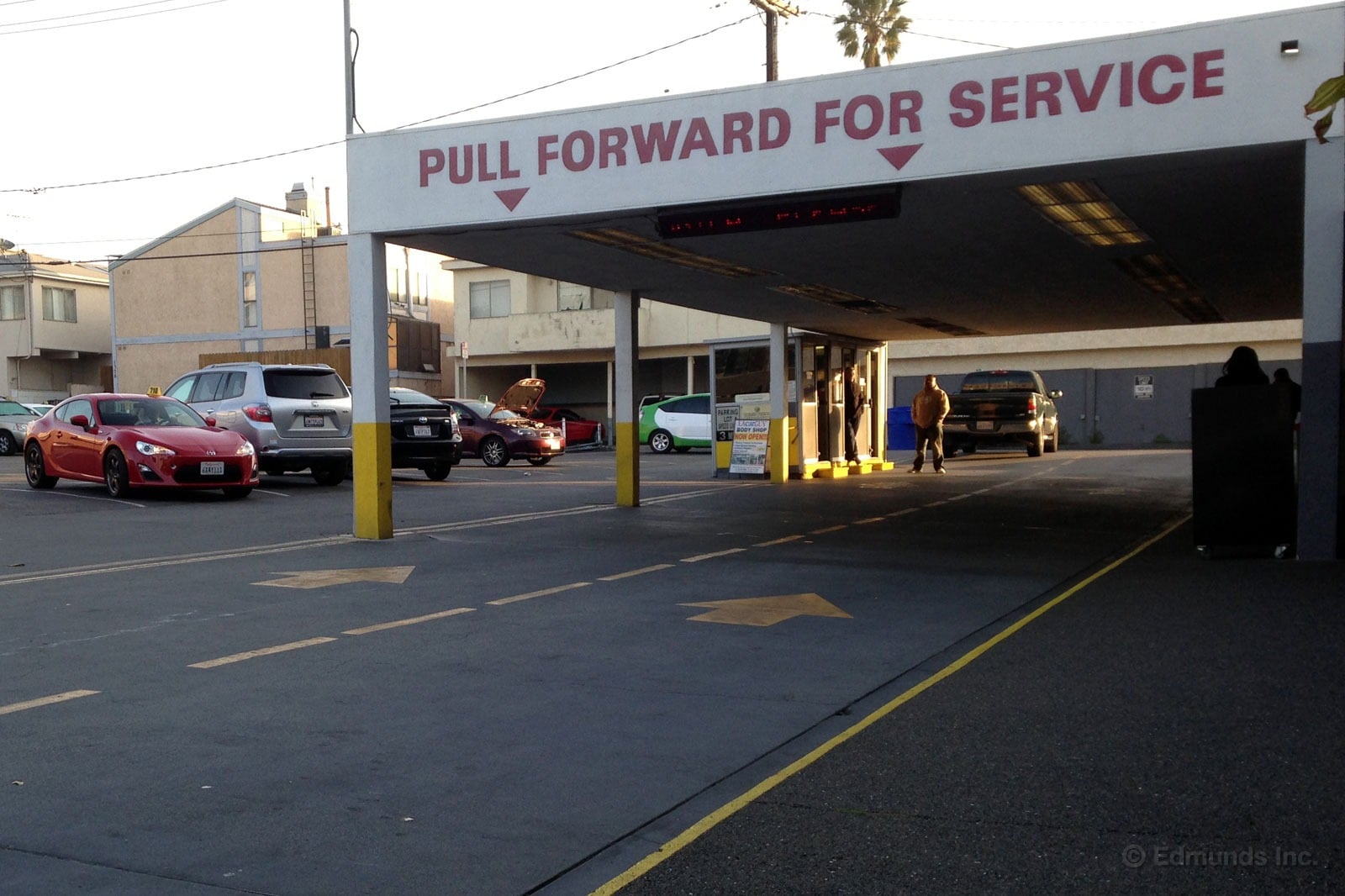
Our 2013 Scion FR-S was due for its 15,000-mile service, so we stopped off at the dealer for maintenance. The oil and filter change was a quick job. Toyota of Santa Monica took care of it while we waited. According to the invoice, it should have cost us $130. But since the FR-S still falls under the free maintenance program offered on new Toyotas, this didn't cost us a dime.
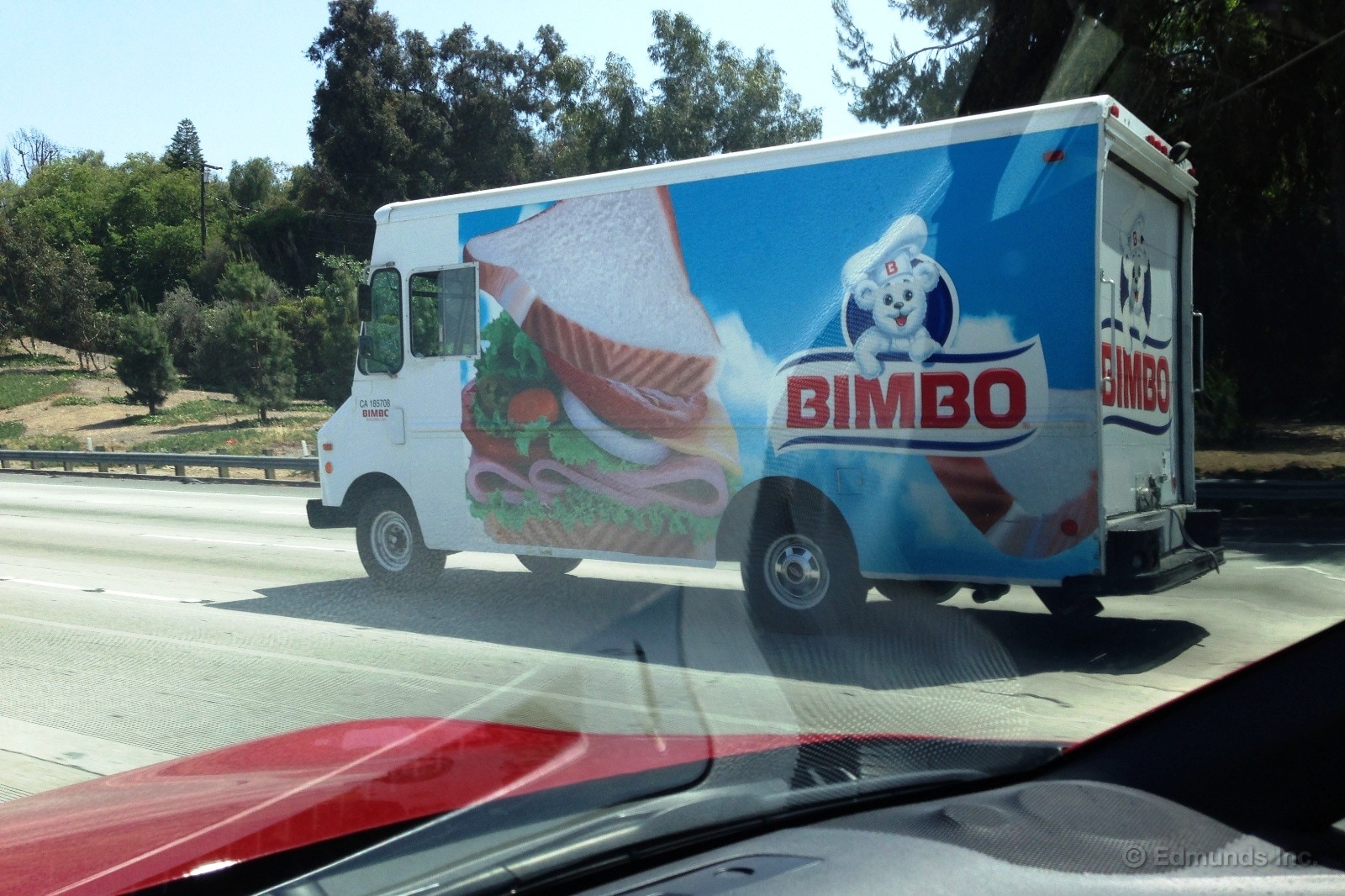
We've all heard the urban myth of the Chevrolet Nova selling poorly in Spanish-speaking countries because "No va" would roughly translate to "No go." I wonder how much market research was done before bringing the Bimbo brand to the States.
Note: After a little research, we discovered Bimbo Bakeries USA is the largest bakery conglomerate in the country. Who knew?
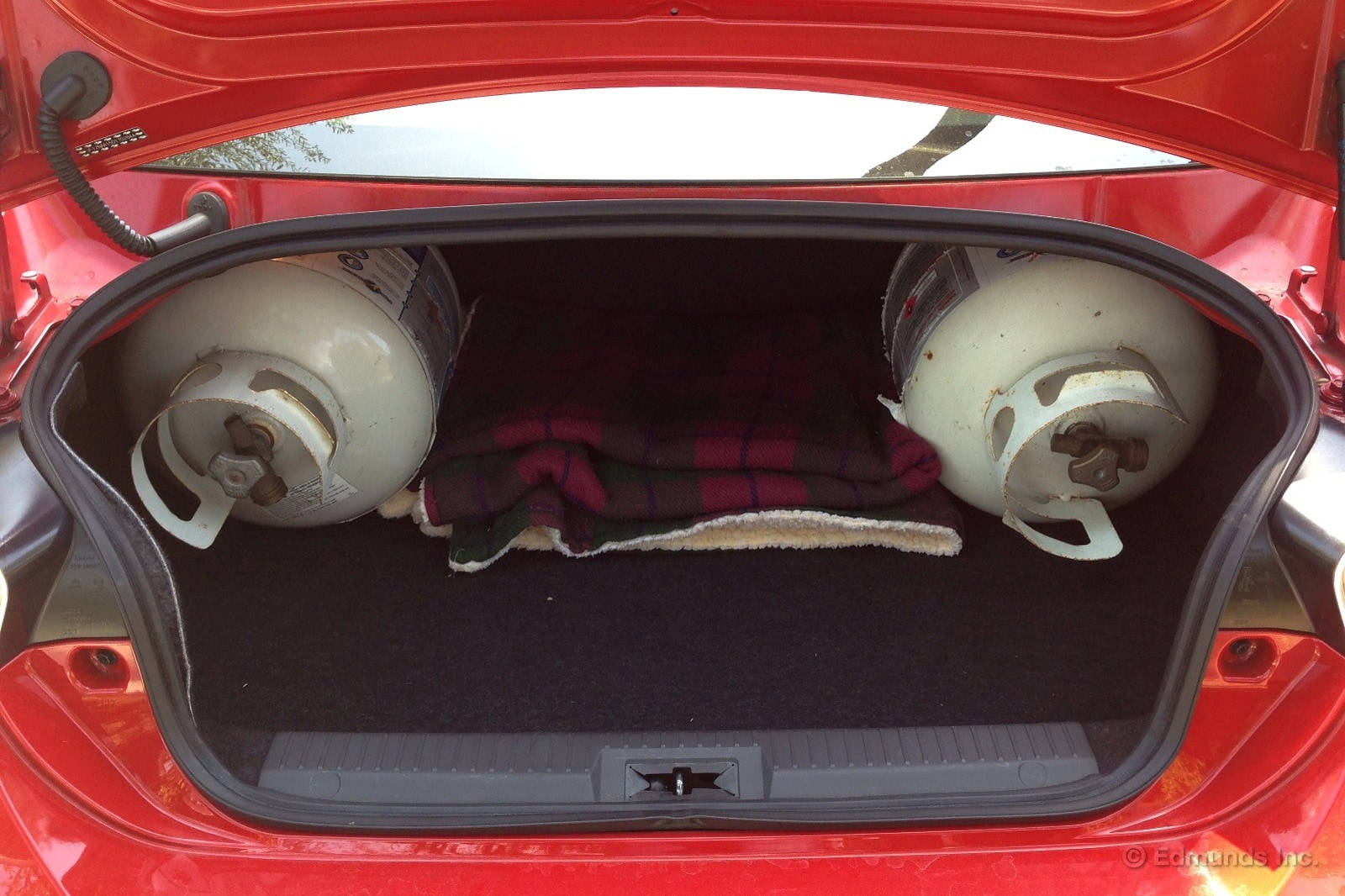
Undoubtedly, this is not the safest way to transport canisters full of propane, but at least when this photo was shot, they were empty. With Memorial Day approaching, I was determined to beat the rush to get these crucial outdoor grilling necessities refilled ahead of the crowd or before supplies ran out.
Such is the life of a coupe owner lacking proper tie-down anchors in the trunk of his Scion FR-S.
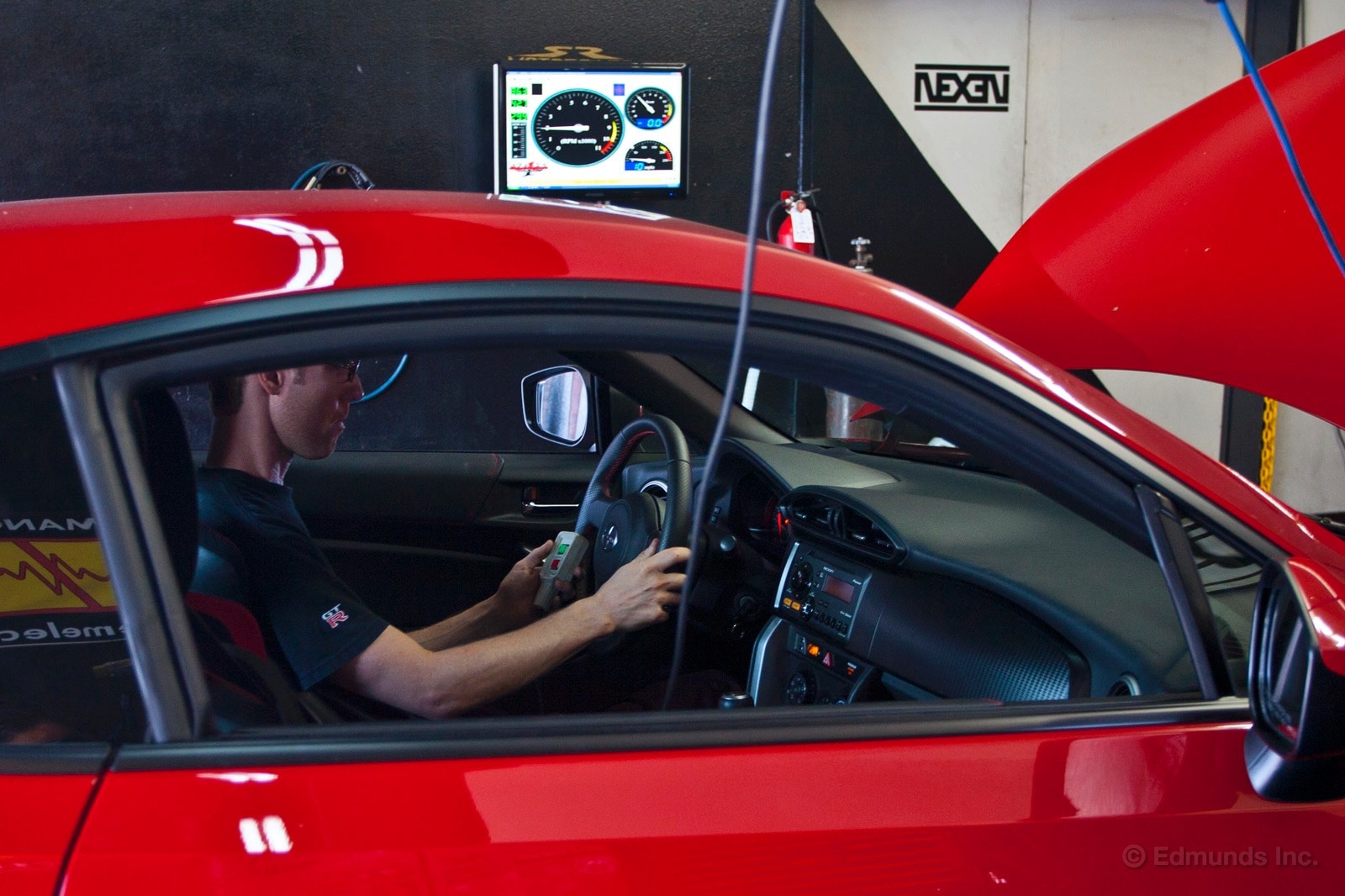
In the month of May, our long-term 2013 Scion FR-S spun an additional 905 miles onto its odometer and consumed 36.3 gallons of 91-octane fuel. That equates to 24.9 miles per gallon for the month, which is slightly higher than its lifetime average.
We're a tick below the FR-S's EPA combined 25 mpg rating. That we're anywhere near its combined rating is astonishing, given how hard this car begs to be driven. And we're only too happy to comply.
Worst Fill MPG: 16.9
Best Fill MPG: 30.0
Average Lifetime MPG: 24.4
EPA MPG Rating (City/Highway/Combined): 25
Best Range: 335 miles
Current Odometer: 16,718 miles
Note: Cars are sometimes refueled before their fuel tanks are nearly empty. As such, "best" and "worst" fuel economy entries above are not necessarily the result of an entire tank's worth of driving.
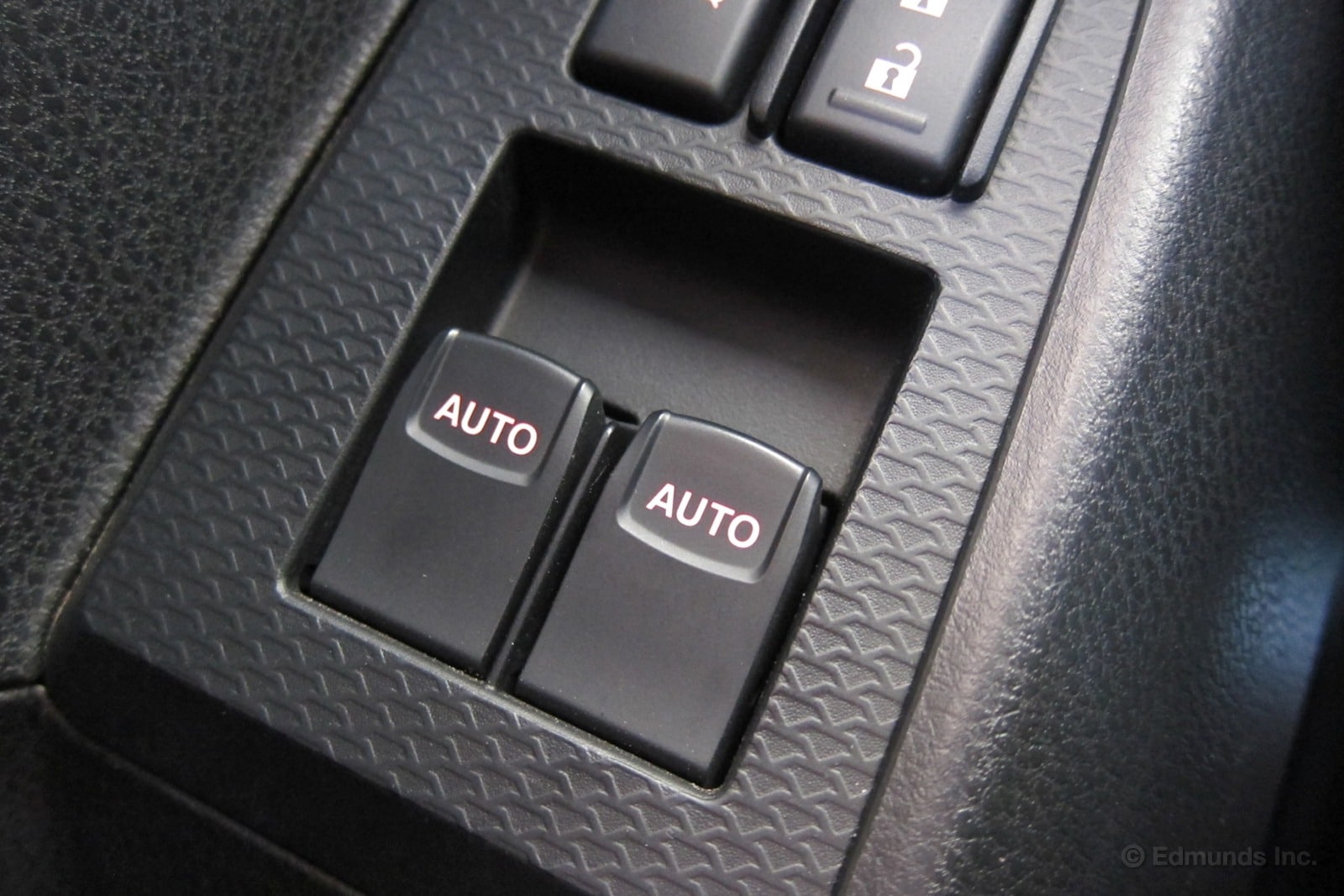
The Scion FR-S's dual auto windows are a nice touch. Scion could've cheaped out and offered neither or just one window with auto up/down. You start to notice these seemingly minor features (or their absence) where you least expect them when you're in and out of different cars all the time.
The FR-S offers dual auto windows, but "smart key" entry where touching the handle unlocks the doors is only available on the limited edition 10 Series or through aftermarket kits. Perhaps this is an intentional distinction, an agreement between Scion and Subaru, as the BR-Z does offer smart key entry. Our Prius C "Three" model, meanwhile, offers touch entry, but only driver window auto up/down.
It's easy to go cross-eyed staring at feature sheets, so it helps to move in and out of cars regularly and get a sense of how feature sets are evolving at specific price points. This is something you can even do yourself. If you're particularly curious and mildly sadistic, visit your local dealer lots and test-drive a few models. You might end up buying a car from one of them someday, so make them humor you.
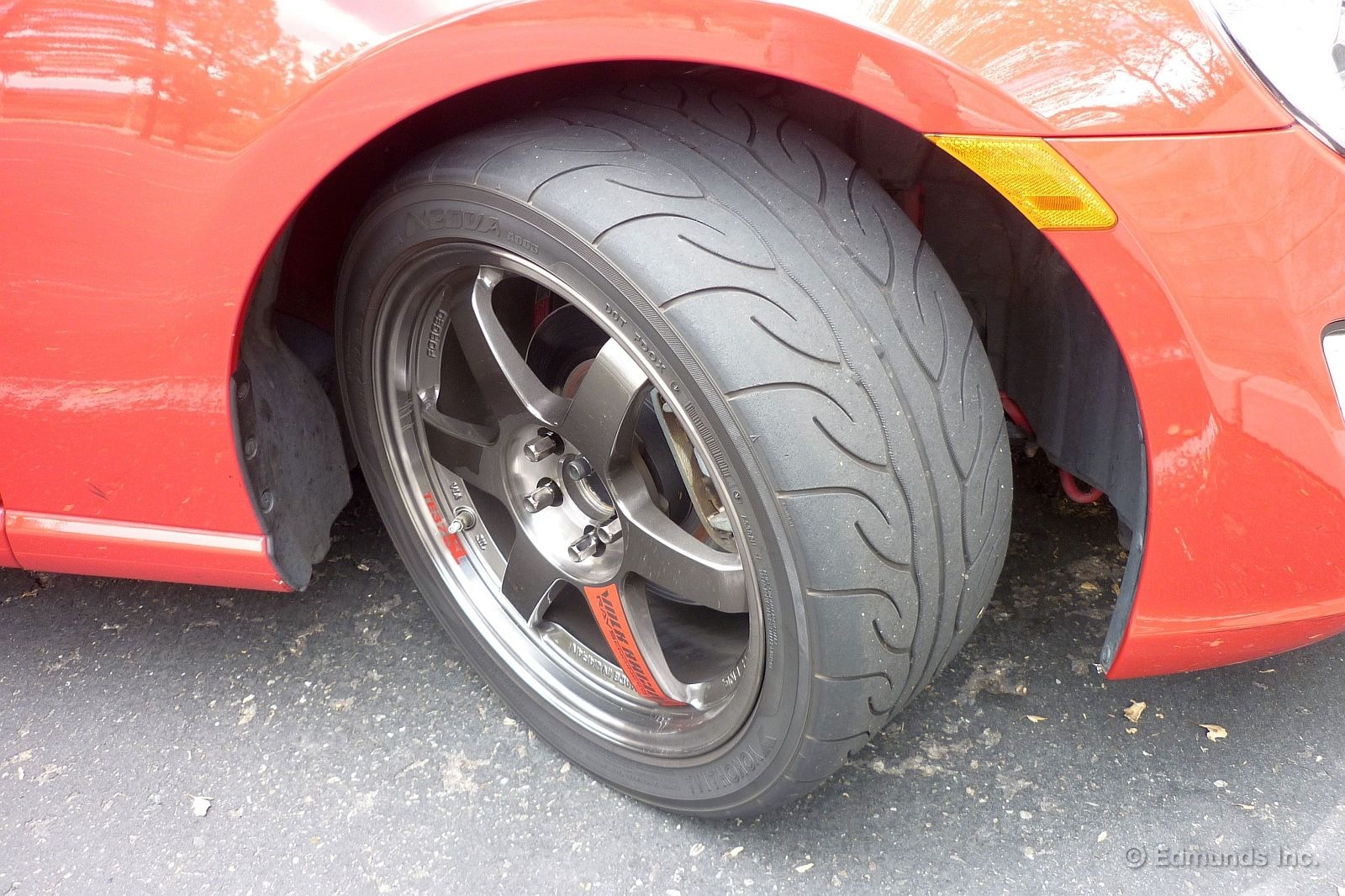
The Yokohama Advan Neova AD08 tires on our 2013 Scion FR-S are getting noisier. They're exhibiting a more constant hum, particularly at elevated speeds on the highway. And the "thunk" over Botts' dots and expansion joints is up a notch or two, as well.
No huge surprise, really. High-performance tires get considerably boomier as they wear. And the FR-S, mostly at the hands of JayKav, has been to several track days, including a couple at Mazda Raceway Laguna Seca. In other words, these tires have been used, and used hard.
Plus, the Scion's interior isn't big on sound deadening anyway.
But although these Yokohamas have gotten a bit louder, in the grand scheme of wear and track use, they aren't all that bad. For instance, the Dunlop Direzza Star Specs on my own track-day car are louder.
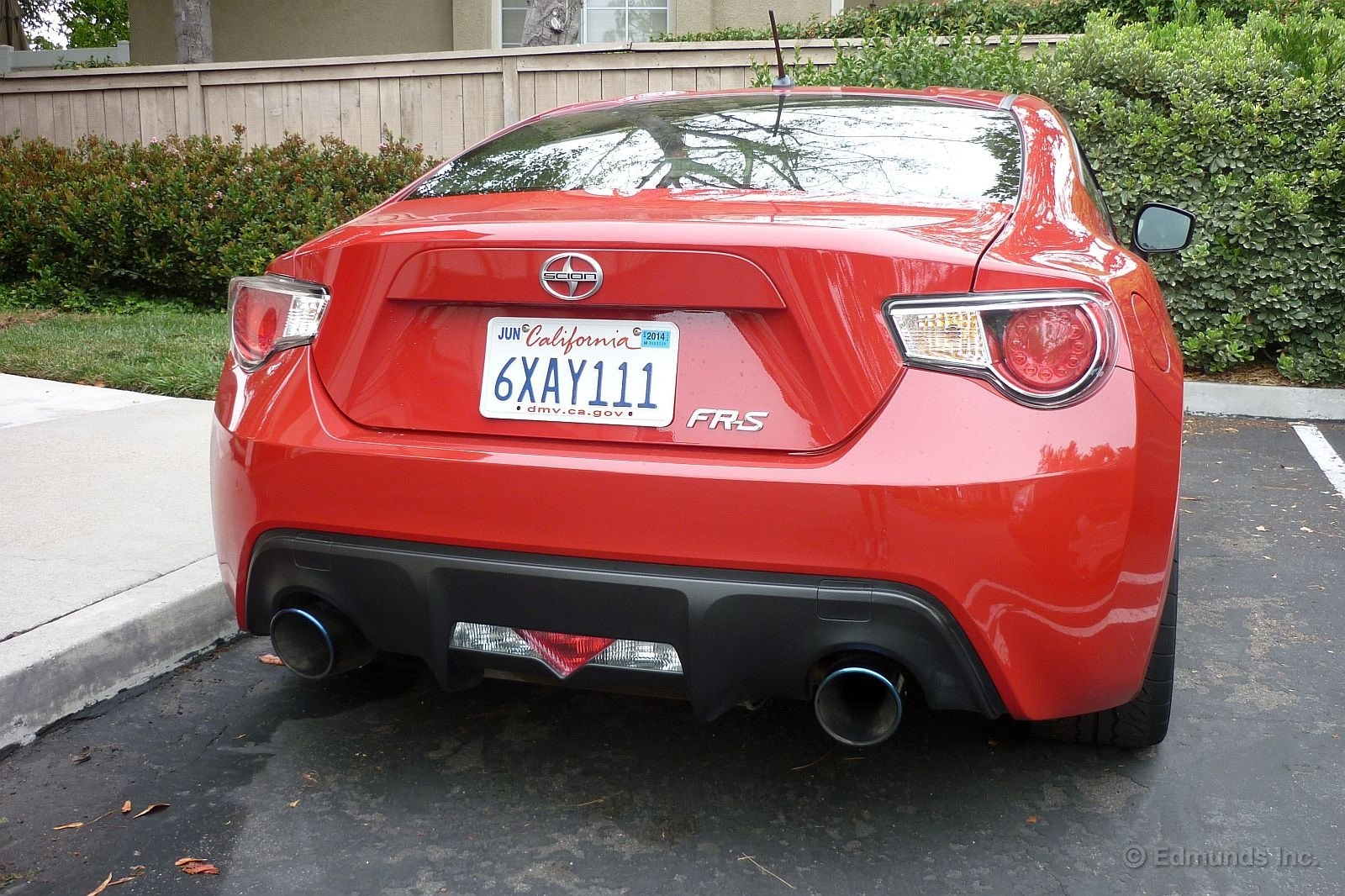
For awhile, I was of a mind that the aftermarket muffler on our 2013 Scion FR-S made no difference in noise over the stock setup. Mostly what you hear in this car is engine.
Then I drove our 2013 Subaru BRZ and the FR-S on back-to-back nights and realized, yes, the big-honkus outlets do make a difference, small as it may be.
It's actually most apparent on start-up, when there's a nice, immediate rasp before it settles down to idle.
But while the system is a bit louder when driving, too, I wish it had more bark. Because you can barely notice the extra noise from inside the car.
Then I happened to be following Dan Frio out of our palatial office parking garage one night, he in the FR-S, and I heard some actual snarl from the exhaust.
Apparently, that's the key with this system. If you want to hear it, you gotta be outside the car.

The Scion FR-S audio system features three sound-processing modes: Hear, Feel and Natural. Unfortunately, it doesn't feature OFF. This drives me a little nuts. Inevitably, Hear becomes the default and sounds most transparent when dialing in bass and treble settings. Feel amplifies bass and low-mids, while Natural applies some sort of compression and basically sucks the life out of your music.
I understand this car is for The Kids, who like to turn their FR-S cabins into a tented light show soundtracked by Skrillex pecking away at a laptop. But come on. If you're gonna include artificial processing, at least give me a defeat/off setting. Gettin' cranky in my advancing years.
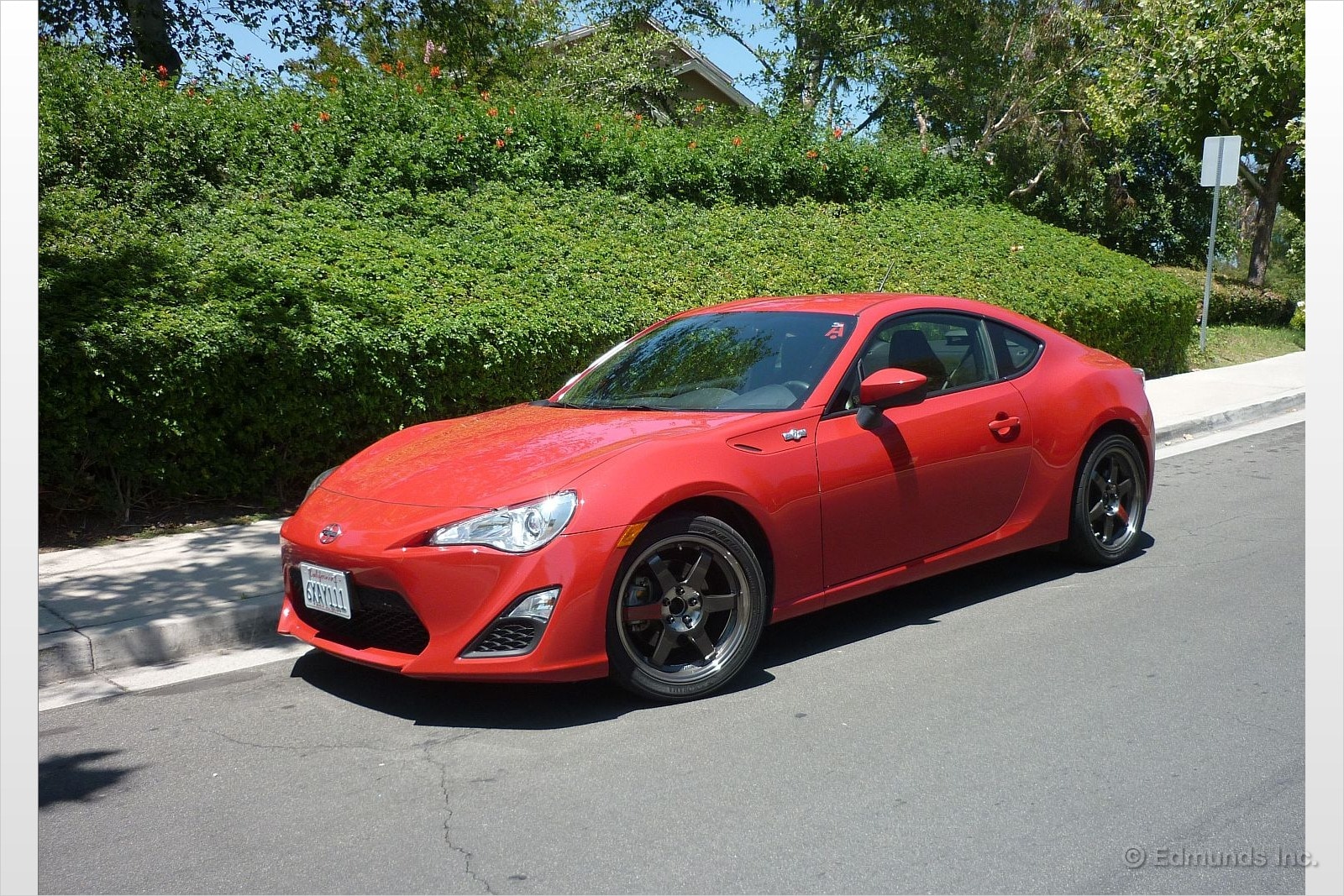
I continue to be impressed with the handling of our 2013 Scion FR-S.
There's the sharp and perfectly intuitive steering fed to you via a wheel that feels so right in your hands. And the precision with which the suspension works as you attack corners.
In short, the FR-S is simply a blast to point through turns.
Another part of the FR-S's back-road goodness is its forgiving nature. It telegraphs exactly what it's doing, you feel it through the steering wheel and the seat, so it's easy to understand what the car is up to as you shoot for those apexes.
And yeah, the FR-S doesn't have a lot of power. No kidding. So I won't sit here and tell you that driving this thing is more fun than flogging around some 400-plus-horsepower V8 (well, it's more fun than some, on a curvy road anyway).
But that's okay. Because the FR-S's speed isn't just handed to you. You have to work for it, keep your momentum up through corners, and there's nothing wrong with having to work for something.
Regardless, the Scion's starting price of $25,255 (including destination) makes this a heckuva lot of fun for the money.

What would make the 2013 Scion FR-S better? Fifty more horsepower and 50 more pound-feet of torque, that's what. And if forced to choose, I'd take the torque. Just like Daft Punk's new record shows us that disco never went away (it just hid out in other subgenres for 30 years), torque never goes out of style.
Fifty more horsepower would be sweet, but the FR-S is still quick without it. In testing, we managed zero to 60 mph in 6.6 seconds (6.3 seconds with rollout) on the stock Michelin tires. That's right in line with the VW GTI, Mini Cooper S and Mazdaspeed3. But 50 more lb-ft would definitely encourage more audacious tail-wagging (which we can all get behind) and more frequent tire replacement (which seems a small price to pay for a steady diet of powerslide).
A good turbo or supercharger kit will set you back $5,000-$6,500, and we're starting to see numbers. One poster at the ft86club.com forum shows a dyno for the new Greddy kit. At 7psi and fitted with a Greddy exhaust (but retaining stick injectors and fuel pump), an FR-S gained about 90 hp and 70 pound-feet.
How much faster would that make our long-term Scion FR-S? I don't know. By comparison, a 305-hp Mustang V6 covers 0-60 in 5.6 seconds. I do know that no one here seems tired of the FR-S yet. We got possibilities. And disco still isn't dead.
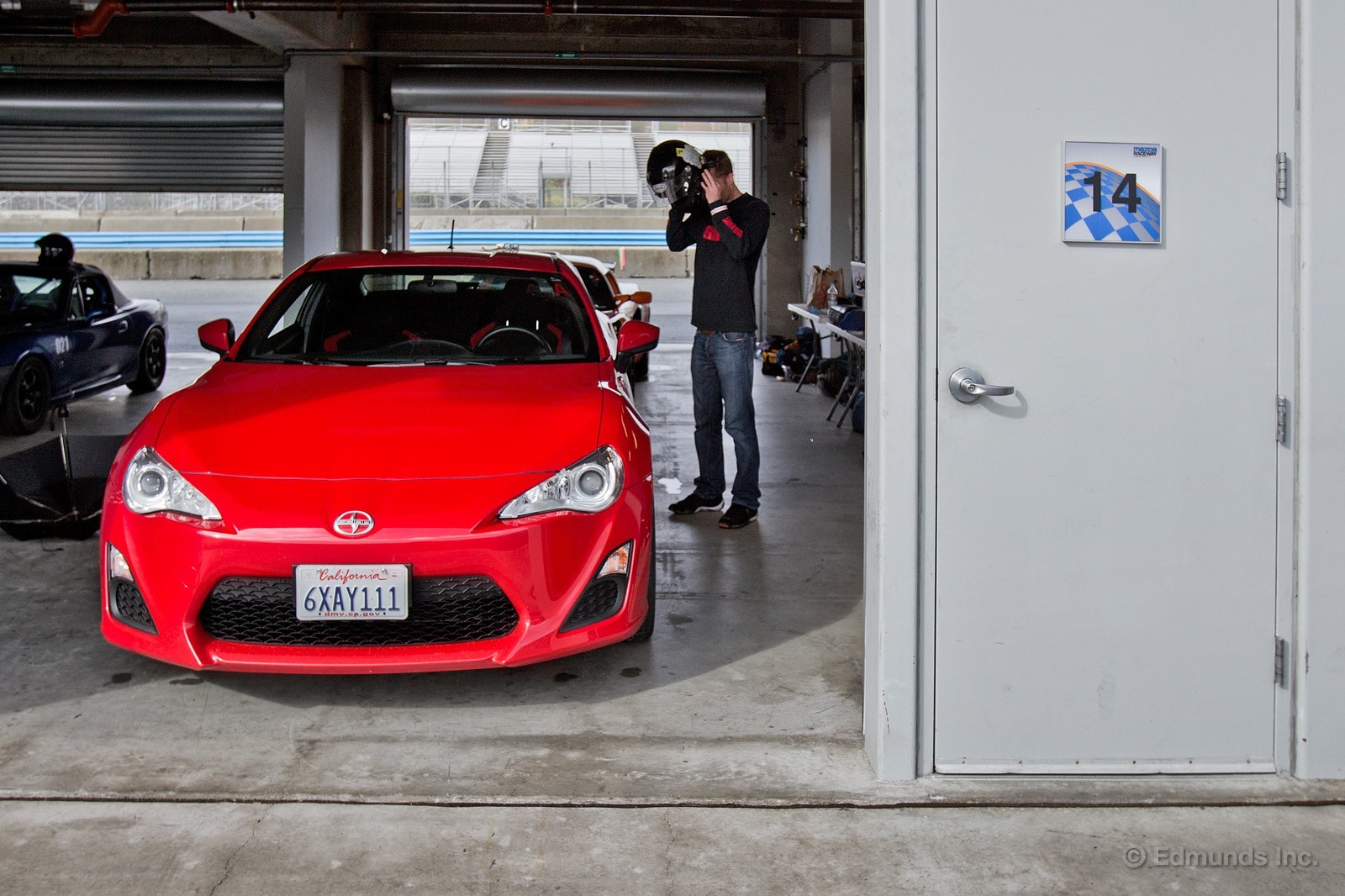
Our long-term 2013 Scion FR-S recently hit Mazda Raceway Laguna Seca again to exercise a few new bits that were installed recently (previous track trip:Pt 1, Pt 2, Pt 3 and Pt 4). Which bits, you ask? If you recall, the FR-S has no factory provision to adjust camber, which is sort of a mystery considering this car's mission.
In the briefest of nutshells, dialing in additional negative camber helps the outside tires' contact patches stay uniformly loaded against the pavement, which increases grip. And when you've already added mechanical grip like we have with our biggie Yokohama Advan Neova tires on Volk Racing TE37SL wheels, the need for increased negative camber is even greater (this is because body roll increases, overworking the outside edge of the tires even more). Factory front camber is zero degrees. Zero! This is clearly a spec meant to minimize tire wear in street driving, but isn't the optimal setup for maximizing grip.
We saw big jumps in capability just by upgrading the wheels and tires. In the meantime I've been jonesing to see what a bit of camber will do for it. Thing is, I also want to retain the stock springs and dampers to see how much latent capability they can support, while still keeping the stock ride height and street ride they provide (besides, the stock suspenders already provide a decent amount of roll stiffness anyway). Retaining the stock strut assemblies is generally at odds with adding camber due to the large diameter of stock springs. There's the crash-bolt-in-the-knuckle idea, which works fine up until the bolt slips. I've never had good luck with that approach.
So, the bits. Hanchey Vehicle Technologies manufactures camber plates that were designed to accommodate the stock struts. Boom. Done. They also provide other advantages that I'll get into.
Front camber alone is a half-baked idea, so I also added adjustable rear control arms made by Hancha, then gave the car an alignment.
The stock brakes left a lot to be desired the last time I took the FR-S to the track. In short, it took less than two laps before they wilted like week-old romaine. So for this go-round I tossed in some tracky pads, too.
I'll describe how it all shook out in follow-up entries, since it'll be too long to cover it all here. Stay tuned.
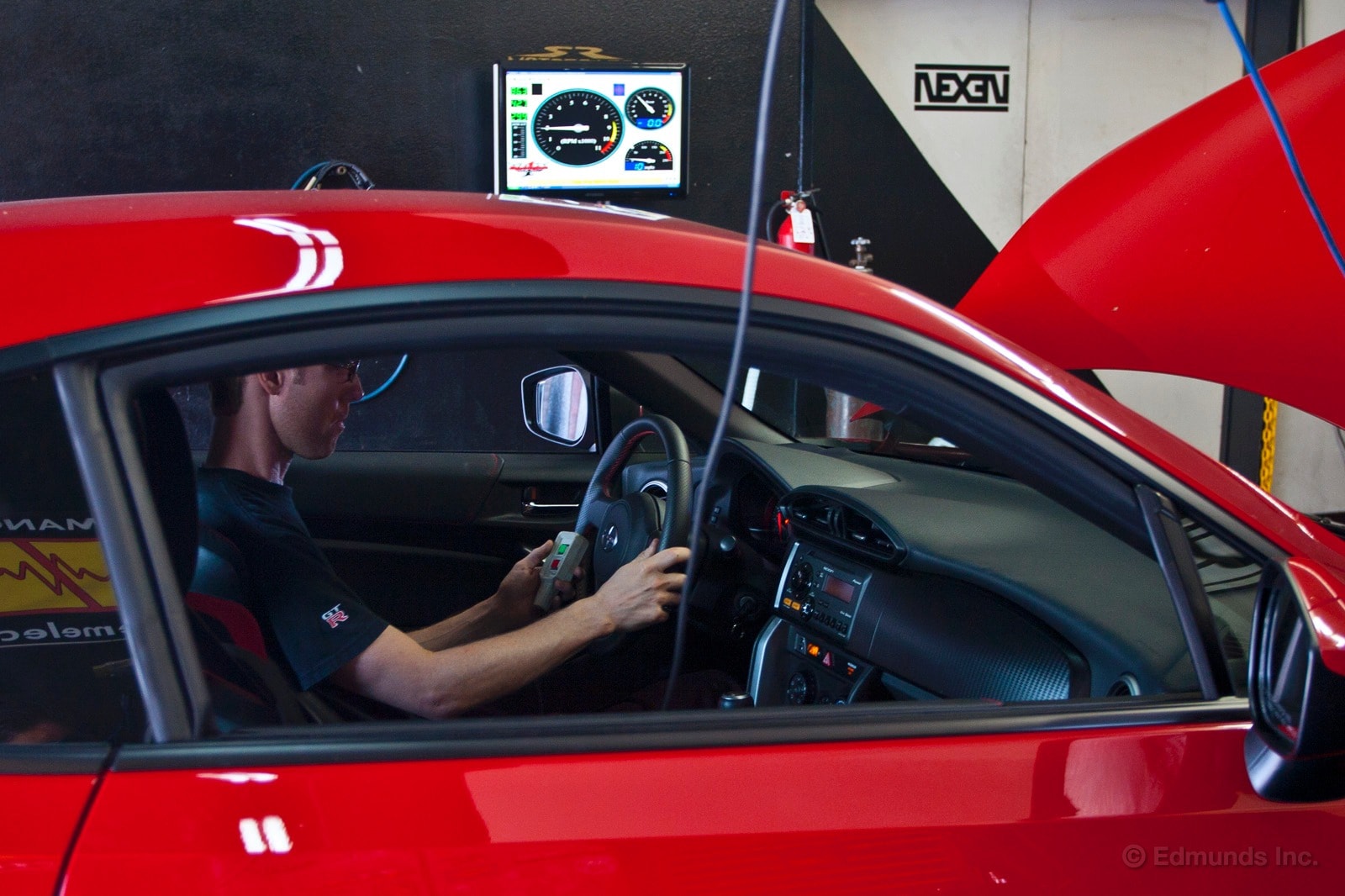
You think you're frustrated about the lack of forced induction on our Project FR-S? Believe me, you're not alone. I won't get into the excruciating nitty gritty specifics as to why it's taking so long, but I'd like to address some of the "but there are so many kits available!" refrains.
We live in the land of 91 octane. The FR-S has a 12.5:1 compression ratio engine. This combination means low boost. Also, what this car needs is punch down low and through the midrange. Sure, a bump in peak power would be nice but not if it comes at the expense of what the car actually needs, power delivery-wise.
Consequently, for a turbo kit, there's no sense using a turbo capable of supporting 400 horsepower, since you're simply giving up boost response to meet a power number you can't reach. It's wasted headroom. Yet the various turbo kits I found all use a 400-hp (or more!) turbo. And when the kit vendors have released a dyno chart (a best-case run, probably) for their kits, they generally reach their peak of 5-7 psi at about 4,000 rpm. It's just not the power delivery we're looking for in a dual-purpose car, a sentiment I suspect other owners would agree with.
Furthermore, I don't want mushroom air filters that draw underhood air, or methanol injection or cheap knockoff turbos or other such forced induction kludges, and neither should you.
That's not to say there hasn't been progress. If all goes according to plan in the coming weeks, we'll have some updates to share with you regarding a set of lungs for Project FR-S.
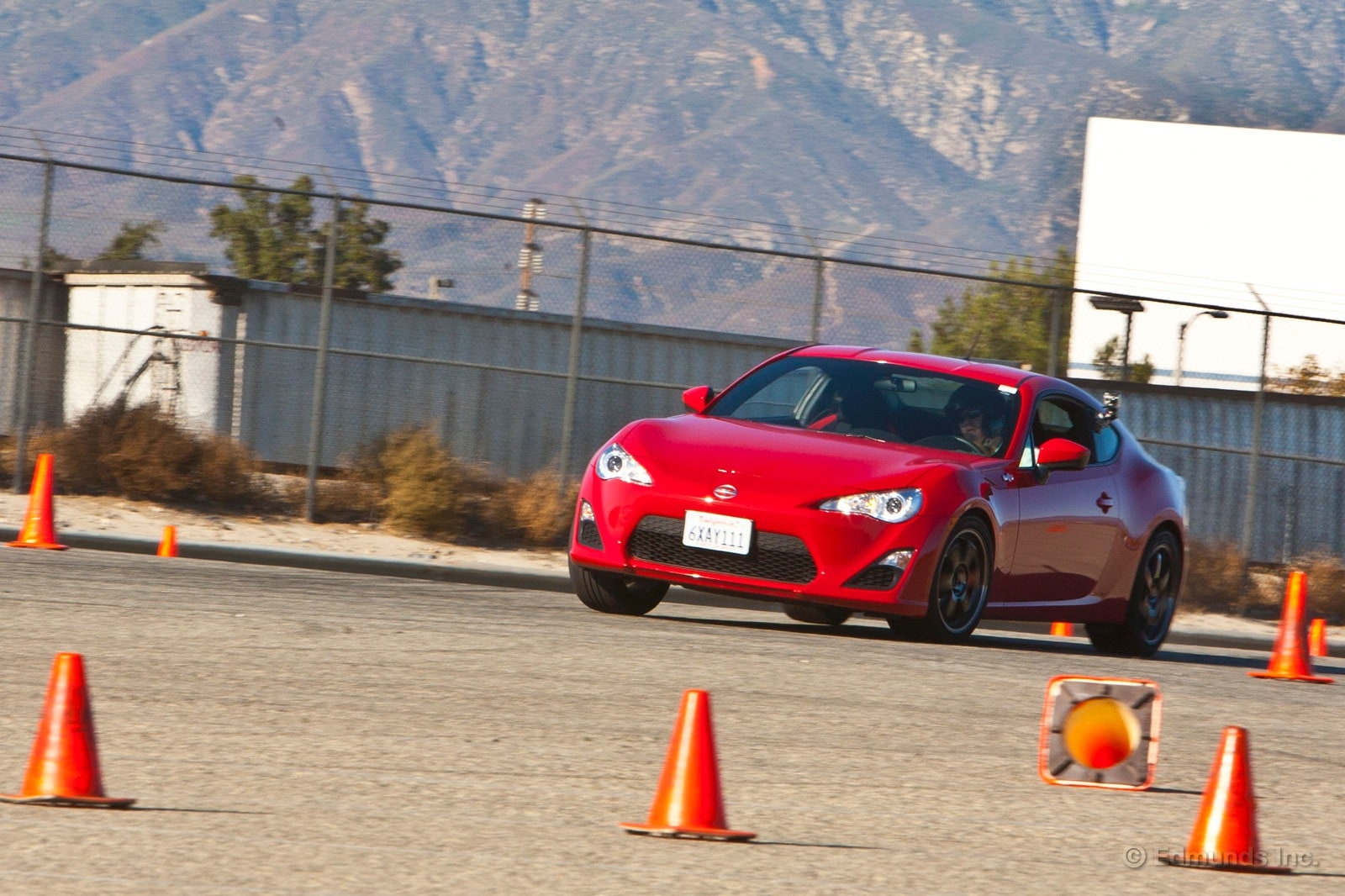
A year later, I'm still enamored by our long-term Scion FRS. As a track car and, to a lesser degree, a commuter, I'd definitely consider this as a purchase. But that's because I don't take a lot of road trips.
Last week, I drove the FRS down to San Diego to attend a press event. After the 2,400-mile Grand National trip, 140 miles each way would be a piece of cake. Shortly after hitting the highway, I quickly realized how wrong I was.
In a word, noise.
The Scion makes quite a racket. The engine is loud and not at all refined, road noise permeates every recess of your skull and the wind noise is like listening to radio static. While I wouldn't characterize the ride quality as harsh, the suspension does contribute to some fatigue. Of course, none of that matters if you have a helmet on and you're fighting for a good lap.
Now, I suppose if there was a track day at the end of this road trip, I'd easily tolerate this.
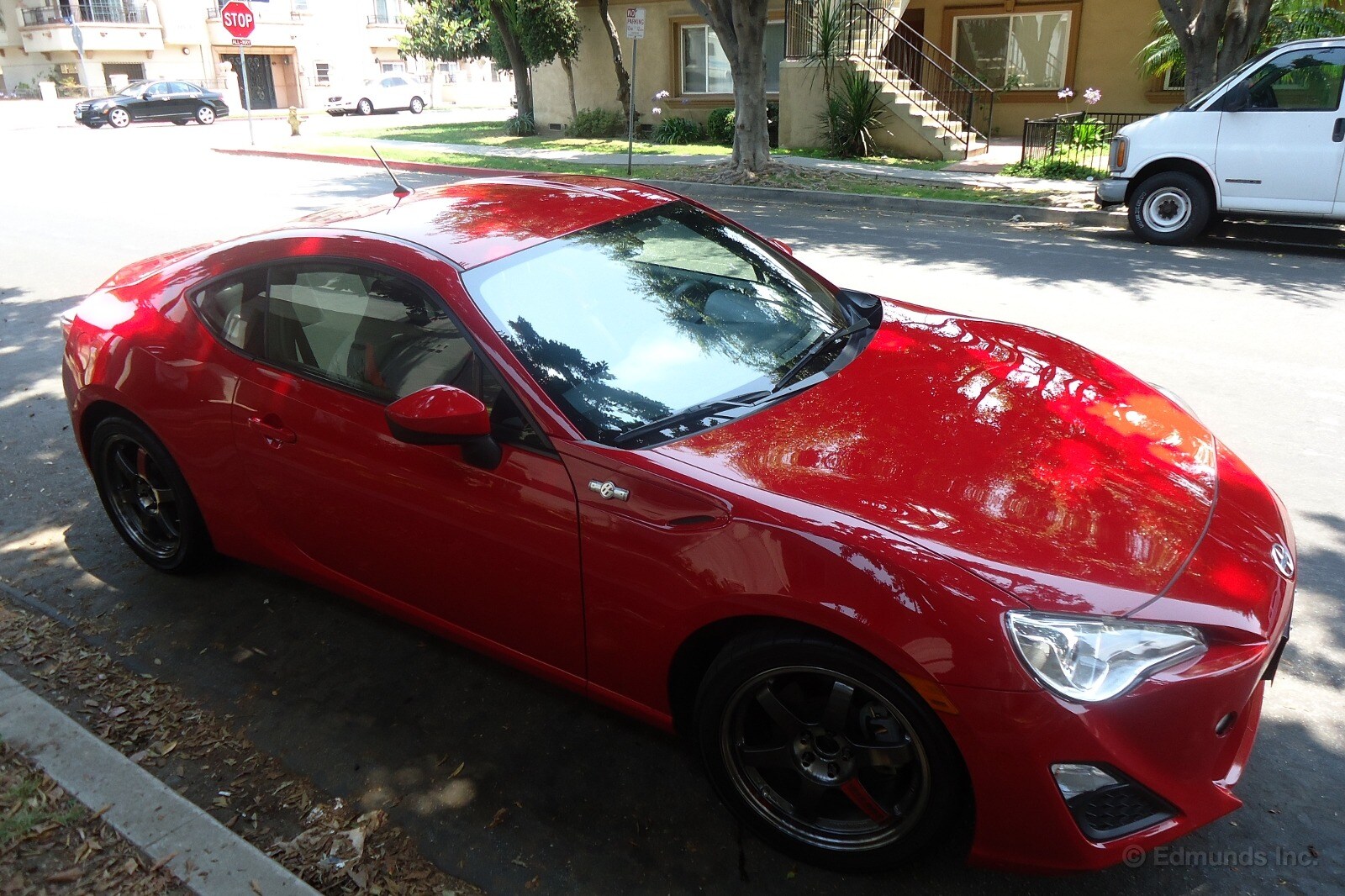
Our 2013 Scion FR-S's time with us is drawing to a close. That's sad news, given that this fun-loving little car has managed to put a smile on the face of pretty much everyone who's had the good fortune to take it out for a spin.
We put 2,019 miles on our FR-S during the month of June, and it consumed just over 87 gallons of 91-octane fuel. Our goal is to put at least 20,000 miles on our long-term test cars during their year with us. We're not quite there yet with our Scion, though it's been with us for a full year now.
Chalk it up to the fact that while this is an enjoyable car to drive, its compact size didn't exactly make it a practical choice when editors were planning the sort of lengthy road trips that can quickly log miles on the odometer.
Worst Fill MPG: 16.9
Best Fill MPG: 30.0
Average Lifetime MPG: 24.0
EPA MPG Rating: 22/30/25
Best Range: 335.1 miles
Current Odometer: 19,213

Zero degrees of camber. That's the factory spec on our long-term 2013 Scion FR-S. And being that its front end is underpinned by MacPherson struts, we see fruit, and it is hanging low. This is because in roll, struts inherently tend to gain positive camber more quickly than do, say, double wishbones. To offset this effect and to "stand the tire up" more in hard cornering, you want to increase the suspension's static negative camber.
No problem, I'll just crawl underneath and dial in some more negative camber by adjusting the FR-S's factory eccentric bol- [record screeeetches]- not so fast, there, zippy. Toyota/Subaru, for reasons that will baffle mankind for eternity, decided not to include provisions for adjusting camber on their rear-drive sports car that will likely become one of the most common sights at track days and autocrosses for years to come.
Generally speaking, coilovers are part and parcel with camber plates. As this is a dual-purpose car, and we're not running ultra-sticky tires like Hoosiers or even DOT R-compounds on the track, adding a bunch of roll stiffness with the higher spring rates of coilovers makes little sense. And while coilovers allow you to lower the ride height, the trade-off in terms of suspension travel, bump steer and nose scrapeage aren't worth the small reduction in center of gravity height.
On real-world roads, suspension travel is your friend, and so are stock ride height and reasonable spring and damper rates. Blast down one bumpy canyon road in Project FR-S and you, too, will appreciate how well it soaks up these road insults without upsetting the chassis or kicking the steering wheel out of your hands.
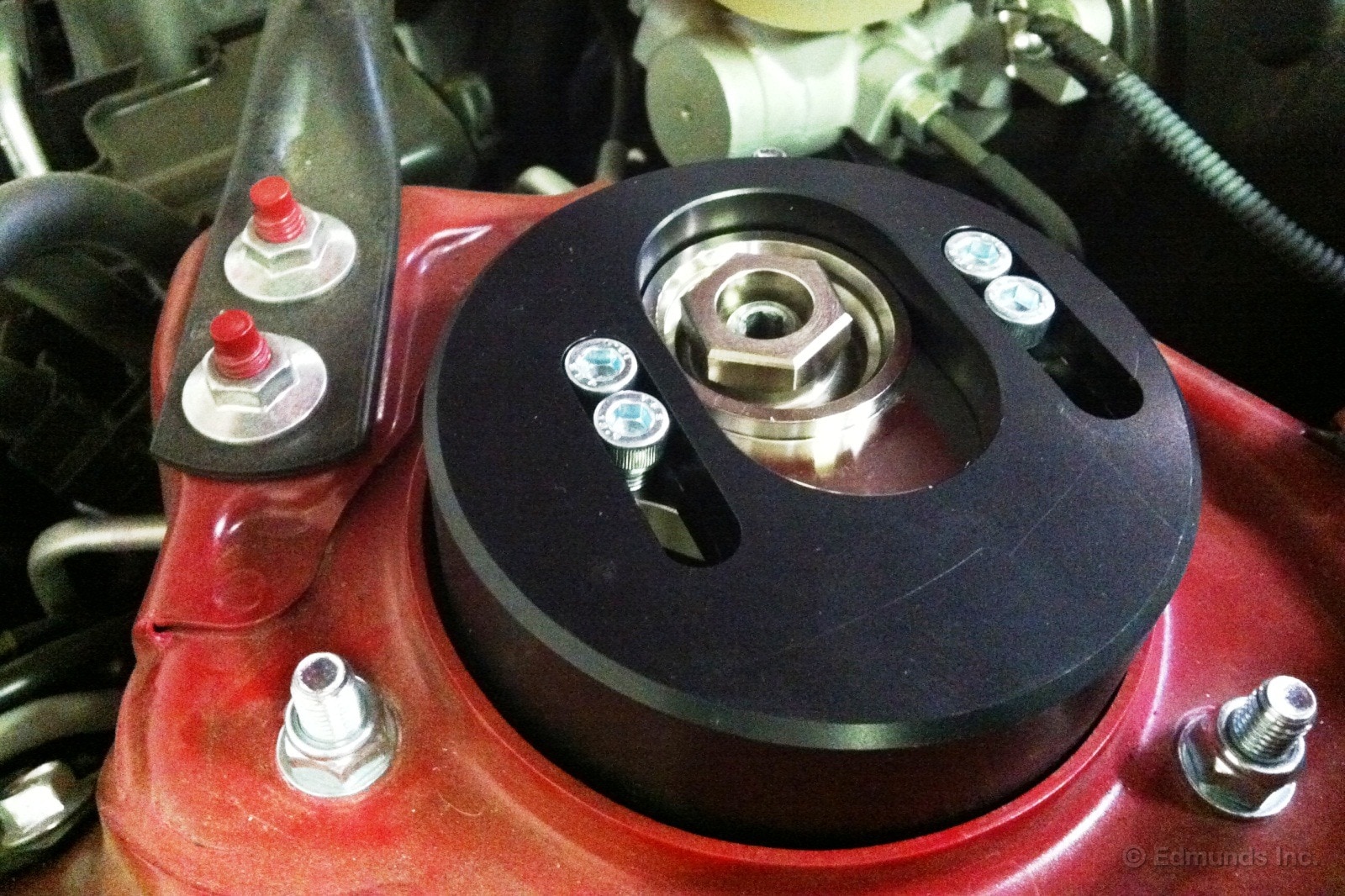
So what to do? Enter Hanchey Vehicle Technologies (HVT). Their camber plates for the Scion FR-S were designed to accommodate the stock struts (they can also be used with coilovers if you so choose). Traditional camber plates are flat. These are not, as the camber plates poke through the hole in the top of the strut tower. This design accommodates the tall stack height of the stock strut and new upper spring perch so that ride height is not affected. Were you to simply use flat plates instead, you'd end up with a jacked-up, 4x4-style ride height. The HVT camber plates do not affect ride height at all. Perfect!
There's only so much room to tilt the top of the stock struts inward due to the large diameter of the spring. Basically, at some point, it hits the chassis. This means you won't be dialing in, say, -3 degrees of camber if you're retaining the stock struts, which is fine because if your tires can actually make use of that much negative camber you probably need way more roll stiffness than the stock struts provide anyway. We were able to get a max of -2.0 degrees camber with the HVT camber plates.
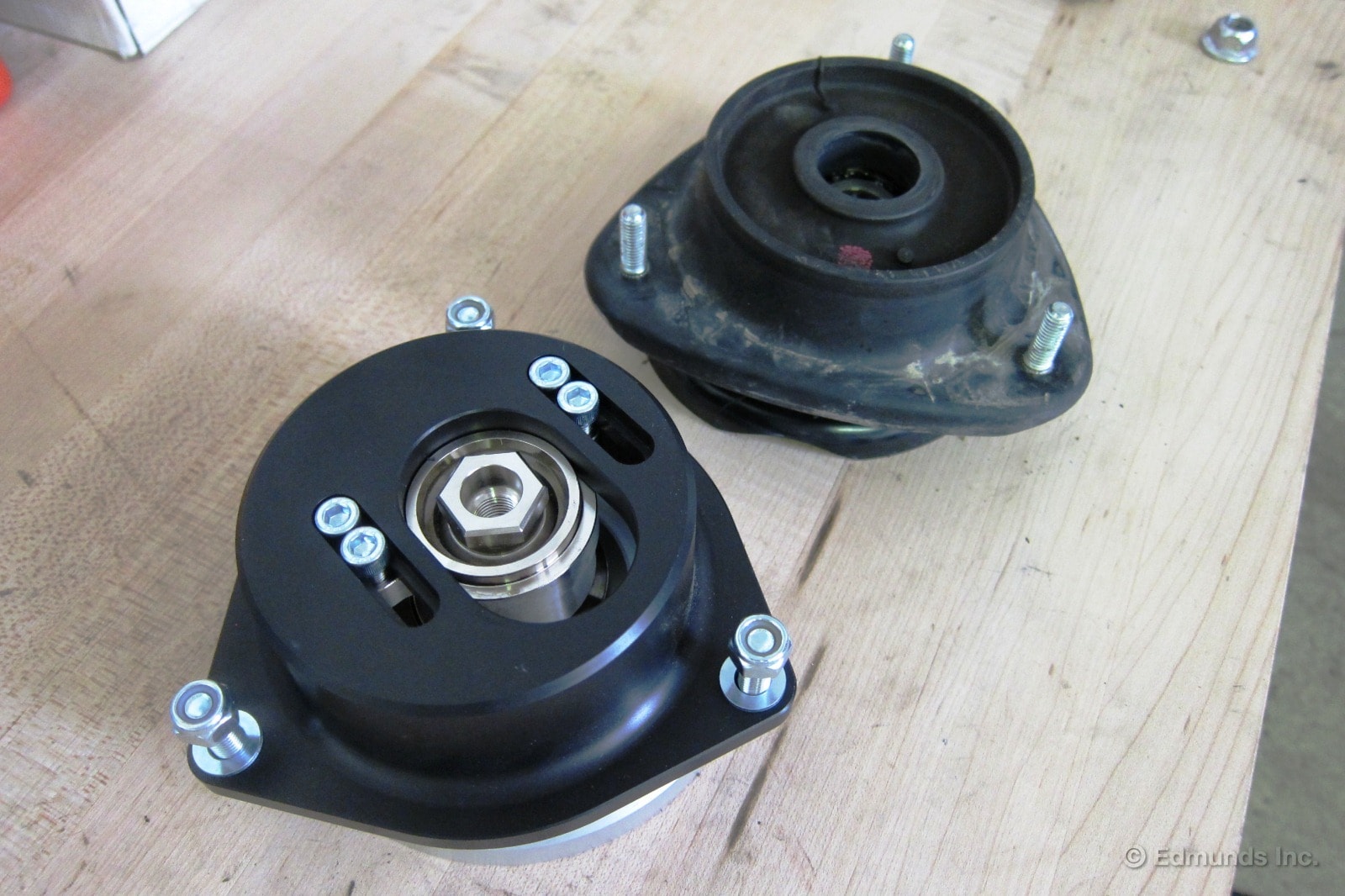
Notice that the slots in the HVT camber plates tilt not only inward, but slightly back as well. The slight rearward angle means that as you dial in more negative camber with the HVT camber plates, they also gain caster. This is a good thing. In low-speed corners when you have a lot of steering angle cranked in, the increased caster effectively increases negative camber further.
Installation is easy. The stock struts pop out of the car in minutes. Then it's a simple matter of borrowing a spring compressor from your local FLAPs, making sure they didn't screw you over by forgetting to include half of it inside its case (not that this happened to me during install. No way would that happen. I mean, how could it?), popping off the old upper strut mounts, swapping in the HVT assemblies and aligning the car.
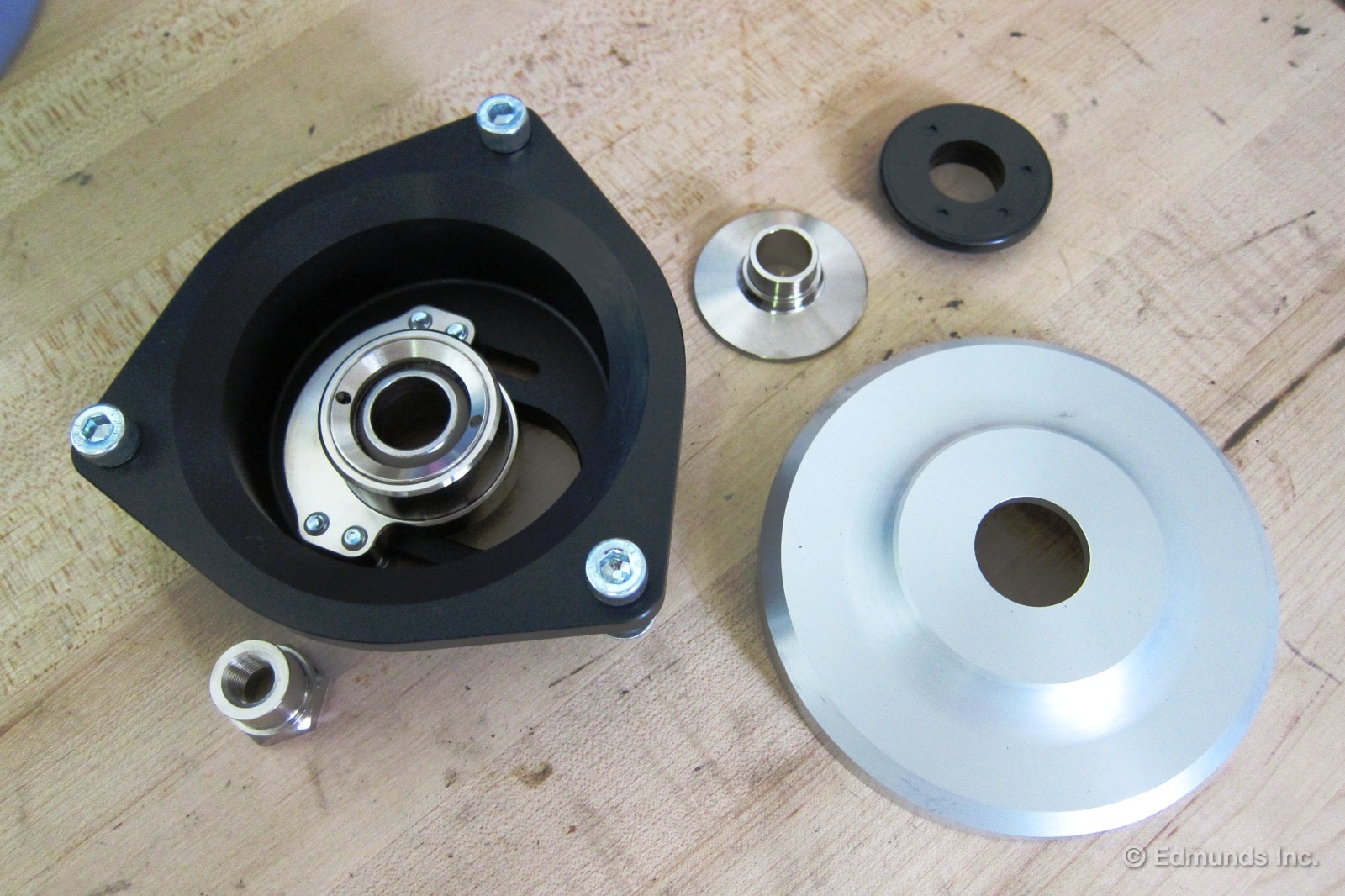
The HVT camber plates use a huge spherical bearing at the top to handle axial loads, whereas that little flat ring in the upper right corner in the photo above is a Torrington bearing to manage the radial steering loads. That shiny finish you see elsewhere is nickel plating. This is a very hard coating that is highly abrasion-resistant. It also looks pimpin'.
So to summarize, in addition to increased negative camber, we now also have increased caster and less squishy rubber, all with no impact on ride height/suspension travel. Maybe we should thank Toyota/Subaru for not putting factory camber adjustment on these cars after all...
Source: Hanchey Vehicle Technologies
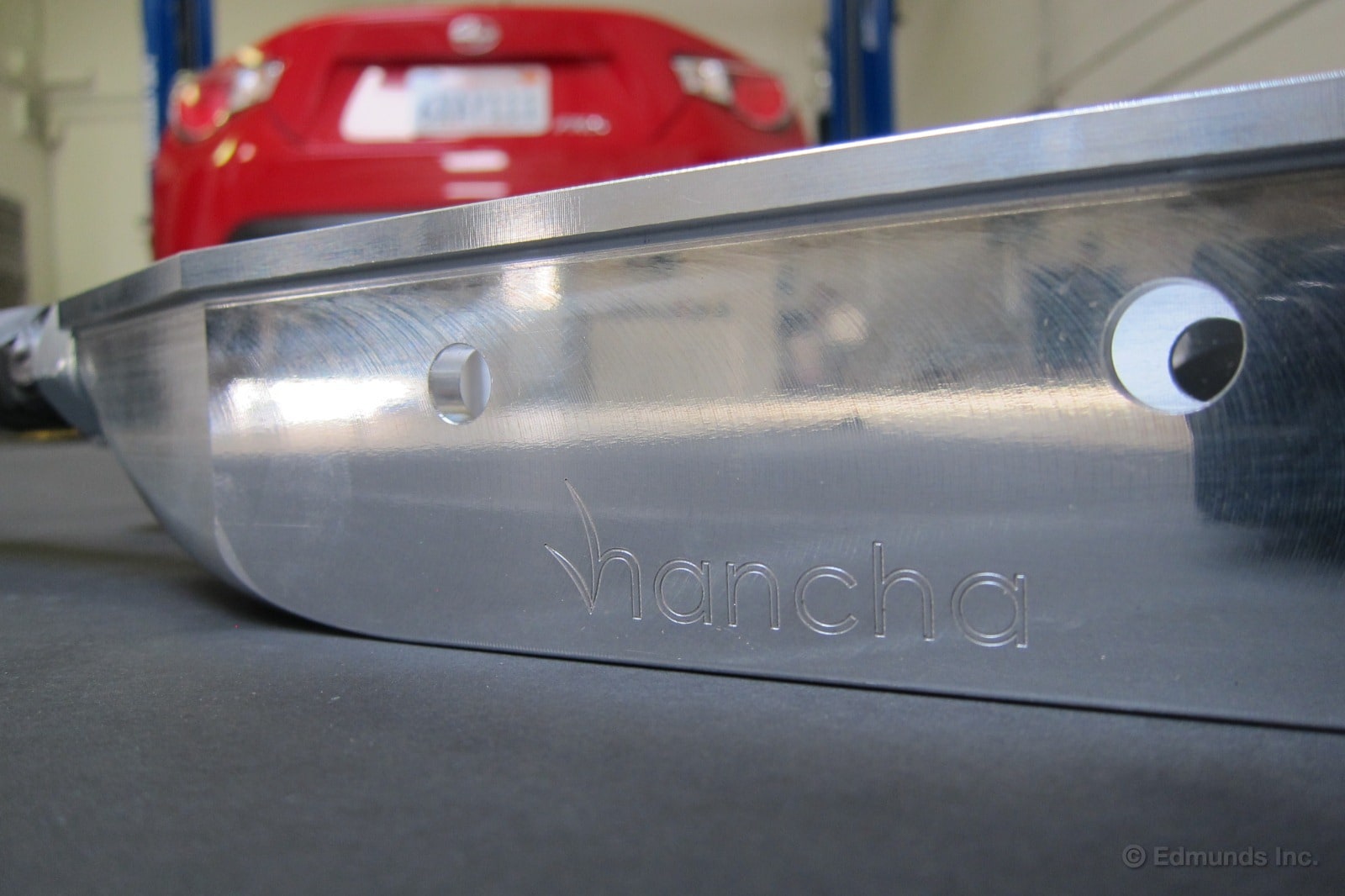
With the front end camber needs of Project FR-S, our long-term 2013 Scion FR-S, handled, we turned to the rear suspension. It's a multi-link layout back there, so its camber loss with roll is less precipitous than in the front. As such, the rear won't need as much additional negative camber as does the front. But like the front suspension, there's no factory provision to dial in camber in the rear.
To right this wrong, Hancha developed a proprietary adjustable rear lower control arm (LCA) that's made right here in the US.
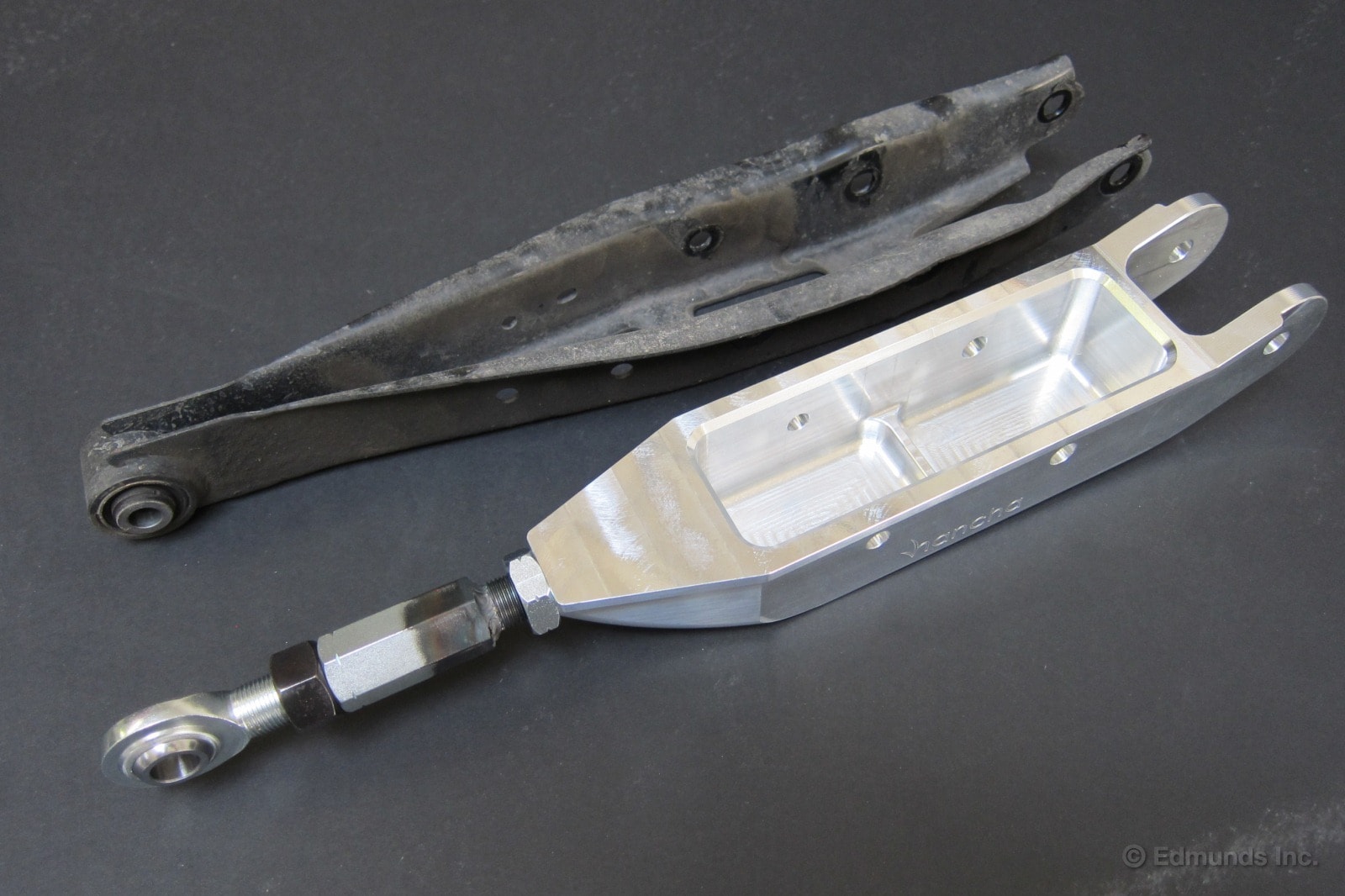
Hancha first modeled the stock LCA and found that, while lightweight, it was lacking in longitudinal stiffness. Thus, their goal was to create an adjustable LCA that was more robust than stock without being heavier.
The body of the LCA itself is CNC-machined from aluminum and receives an oversized rod end and linkage adjuster that lengthens or shortens the arm in order to provide the necessary camber. According to their analysis, the Hancha LCA reduced mechanical stress by 900% and was 1100% stiffer than the stock arm, all without a weight penalty compared to stock. Proof of their confidence is found in the company's three-year warranty that includes motorsports use. Race parts with warranties are rare beasts.
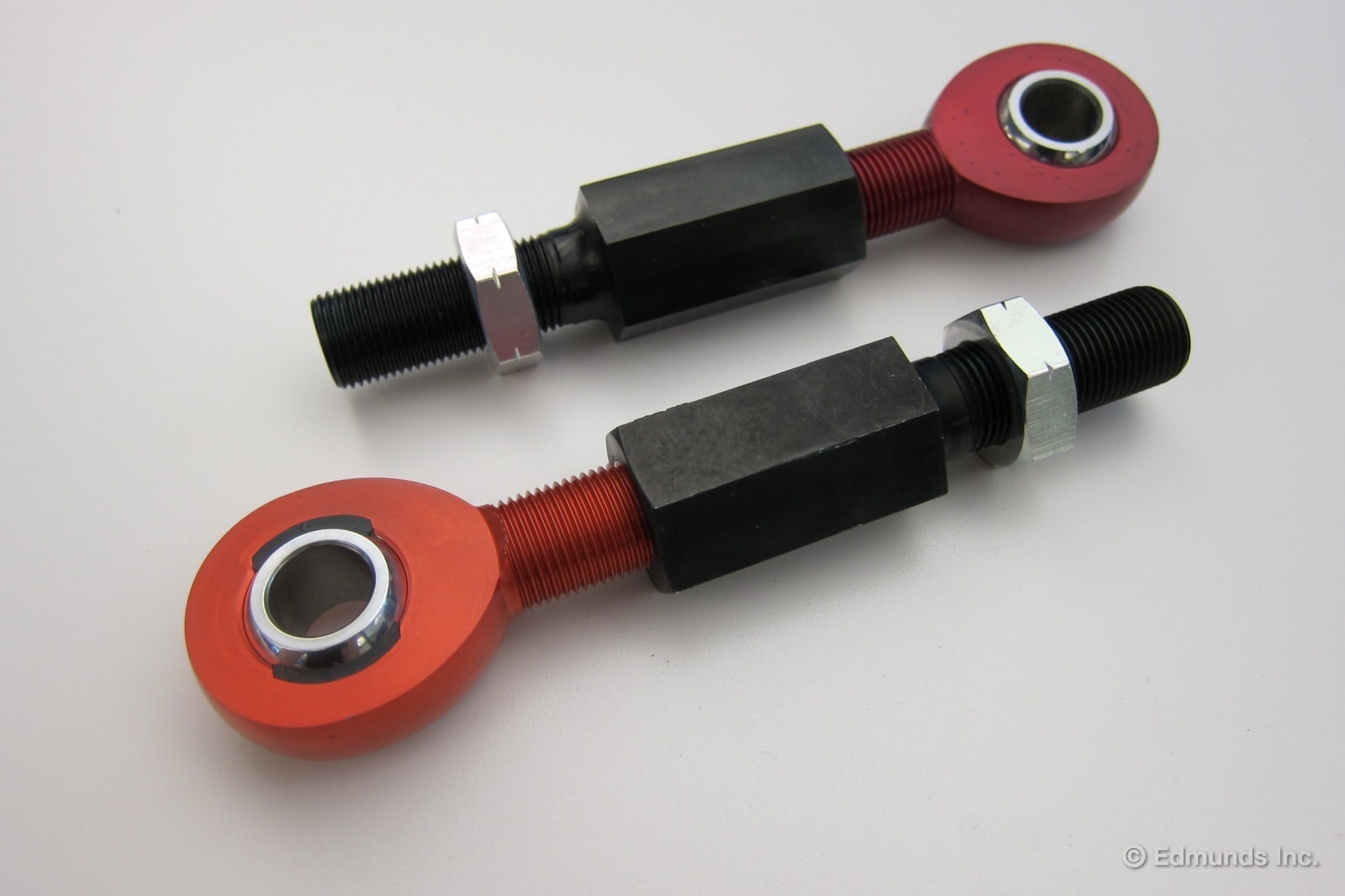
Pictured above are the QA1 rod ends and linkage adjusters that normally ship with the Hancha LCAs. They're beefy 3/4-inch aluminum, and the rod ends have a Nylon/PTFE race that is self-sealing and self-lubricating. They are, by design, not proprietary items so in the event replacements are needed they can be found with relative ease.
In our case, due to a shipping snafu at the last minute, the linkage adjusters and rod ends would need to be sourced locally. We were operating with only hours before departure to Laguna Seca, so Hancha scrambled some steel rod ends for us.
Linkage adjusters, however, were proving elusive.

And then, John at Specialty Cars totally saved the day. "Jay, I'll just make them!" he said cheerily after chasing several leads that led to dead ends. In the space of a few hours, he located the necessary raw materials and fabricated the linkage adjusters from scratch. Then he dropped them off at my house. Talk about service!
Take a look at John's handiwork above. They fit perfectly. I think I'll be enlisting his services for other projects too...
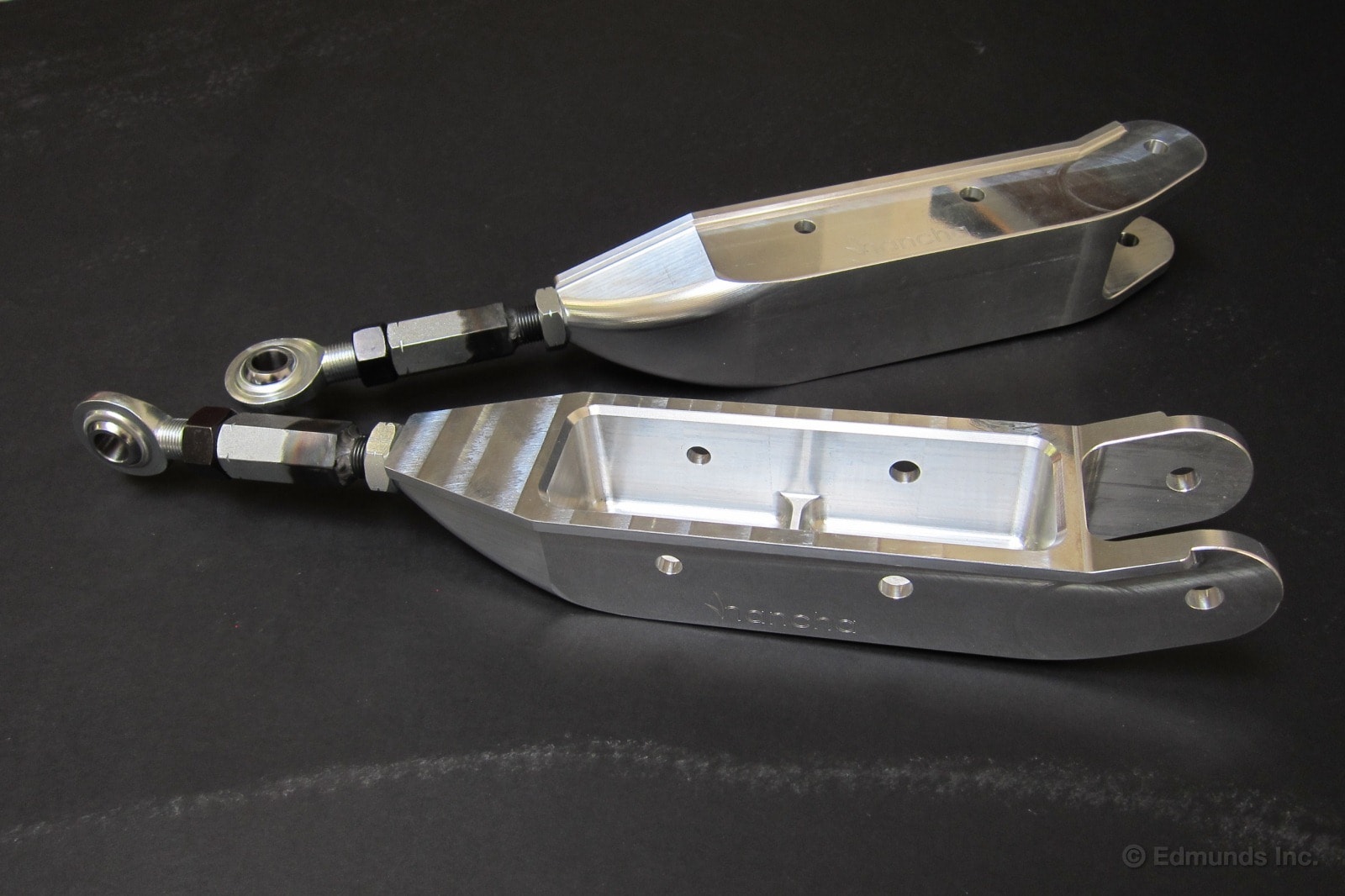
The rod ends in the Hancha LCAs also eliminate a source of squishy rubber found in the OEM arms. This will enhance precision at the price of some additional NVH, a tradeoff we're willing to live with. Likewise, when loaded up in a corner, the rod end will not deflect as much as the rubber bushing. The LCA is oriented aft of the rear axle line in the FR-S, meaning that during hard cornering there will be a touch less loss of toe-in with the Hancha arms compared to stock.
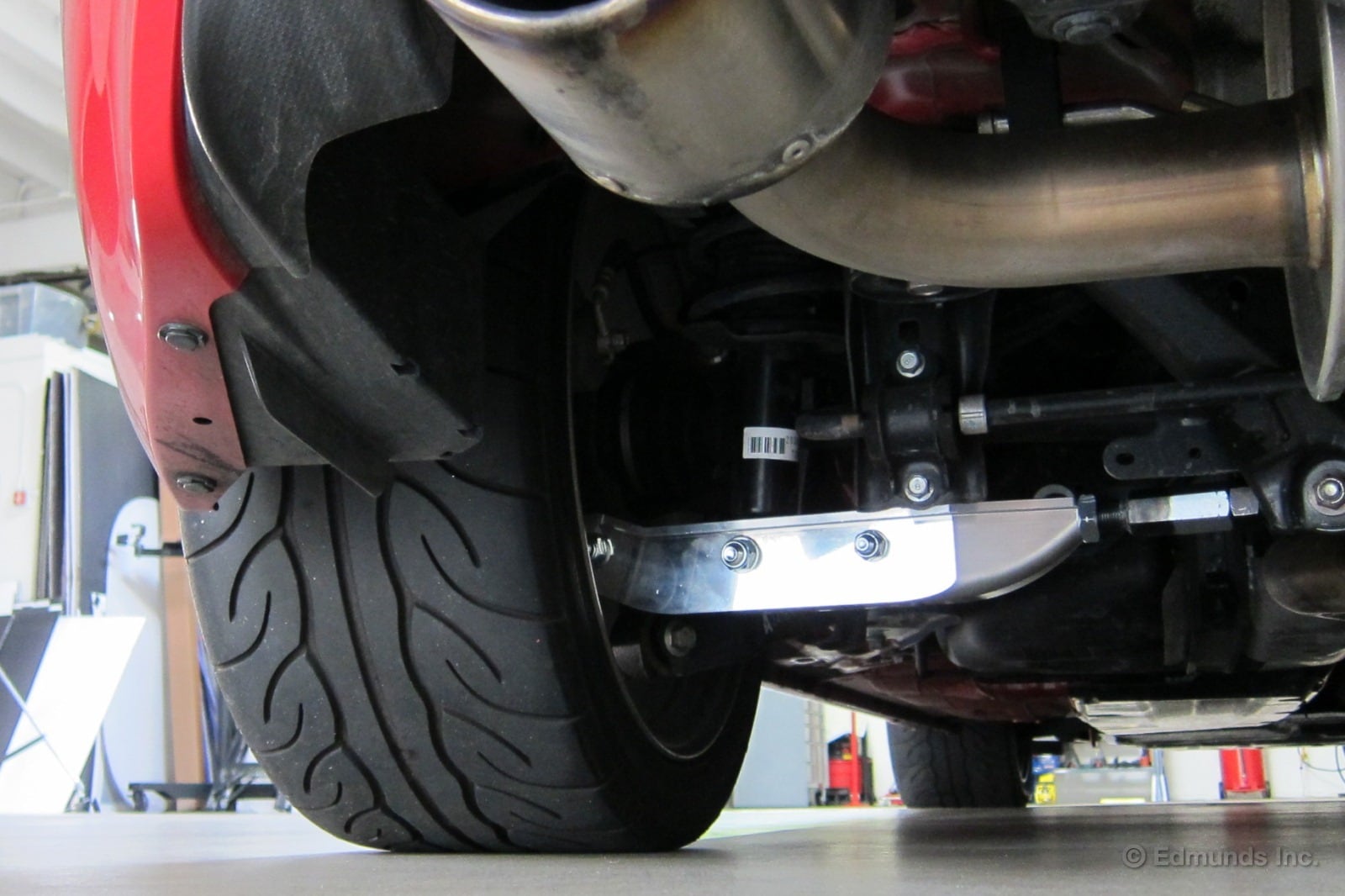
Once I finished installation of the arms, I gave the FR-S an eyeball alignment and then set off to Stokes Tire Pros for a real alignment. There, they dialed it in to my specs. In the front we achieved -1.9 degrees camber and zero toe; the rear was -1.7 degrees camber and zero to 1/16" total toe-in.
It all came together with minutes to spare prior to our scheduled departure time for Mazda Raceway Laguna Seca.
Sources:
Hancha
Specialty Cars
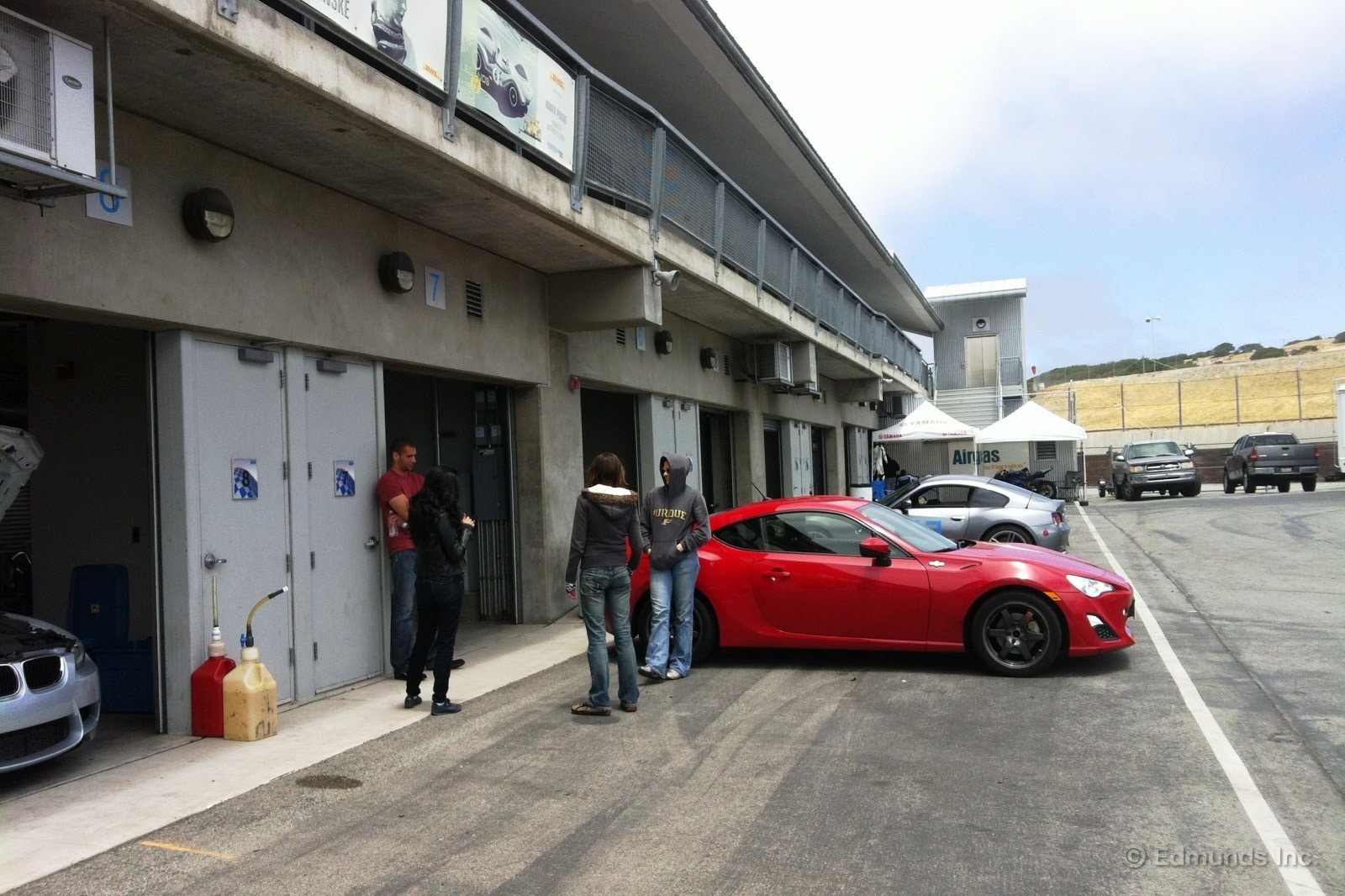
With new suspension bits installed (here and here), a fresh alignment and a Friday morning yawning before us, I pointed our long-term 2013 Scion FR-S northwards. Bitter Dan (you might recall his orange Lotus Exige) and I would once again take fun roads on our way to Mazda Raceway Laguna Seca for another track weekend. Unlike last time, today the skies were clear and the day young.
Before we worked up to a proper pace, I'd needed to perform a bedding procedure on the track-slanted pads I'd installed the day earlier. This always poses a challenge. One of the downsides of living in urban sprawl is that the city never sleeps, so it's virtually impossible to find a long-enough stretch of road that's also empty enough of traffic to complete without interruption of the stop-go-stop-go ritual needed to bed new brake pads. But with Bitter Dan on hand to drop back and run interference with approaching traffic (that is, to ensure they go the speed limit!), we were able to carve out enough of Frazier Mountain Park Road to just pull it off.
Then, it was on to the good roads. Immediately I'm reminded of the effect of swapping in wider, stickier rubber so many months ago. Real rubber bestowed on the FR-S more grip, of course, but also a significantly more planted demeanor at turn-in and midcorner. There was a greater keenness and gravity to the responses of its chassis. It felt no less agile than with the stock tires; in fact it was sharper than ever.
Here, now, on Cerro Noroeste, it's clear that adding the ability to adjust camber, and then doing so, has raised our FR-S's sense of capability and purpose yet another click. There's now an even greater linearity to its front end, both as the cornering loads build and, as we'll find later at the track, at the limit of adhesion. More substance in the steering now, too. The whole thing just feels brilliantly poised, as if Toyota and Subaru always intended the chassis to feel this way and we've simply rolled the tumblers in the correct sequence to unlock its true character.
For sure, there is more road noise transmitted through the monoball camber plates than with the stock upper strut mounts. These aggressive Yokohama Advan AD08 tires have always sounded like tractor tires, and they now speak more clearly than ever.
Highway 58 is one of the great southern California drives. Sightlines are clearer than on Cerro Noroeste, and there's a greater variety of corners including some second gear stuff. Bitter Dan has little trouble becoming scarce here, sprinting off between bends and, to the surprise of neither of us, he's out of sight within a dozen corners. Yeah, fifty'd be nice.
I'm really impressed by the stock suspension on this car. You can add sticky tires to any car and gain grip, but oftentimes the stock roll stiffness and travel simply can't cope with it, leaving you with a frustrating mess of a car. Not so the FR-S. I've doubt R-comps would be suitable, but these underpinnings certainly don't feel overwhelmed yet. Paradoxically enough, the Scion FR-S feels as though the body rolls somewhat less than it did before it had camber plates and adjustable LCAs. This is not a result I'd anticipated. Pondering it now, the only reasoning I can provide to explain this is down to bushing deflection, or more appropriately, a lack thereof.
Tomorrow, the track.
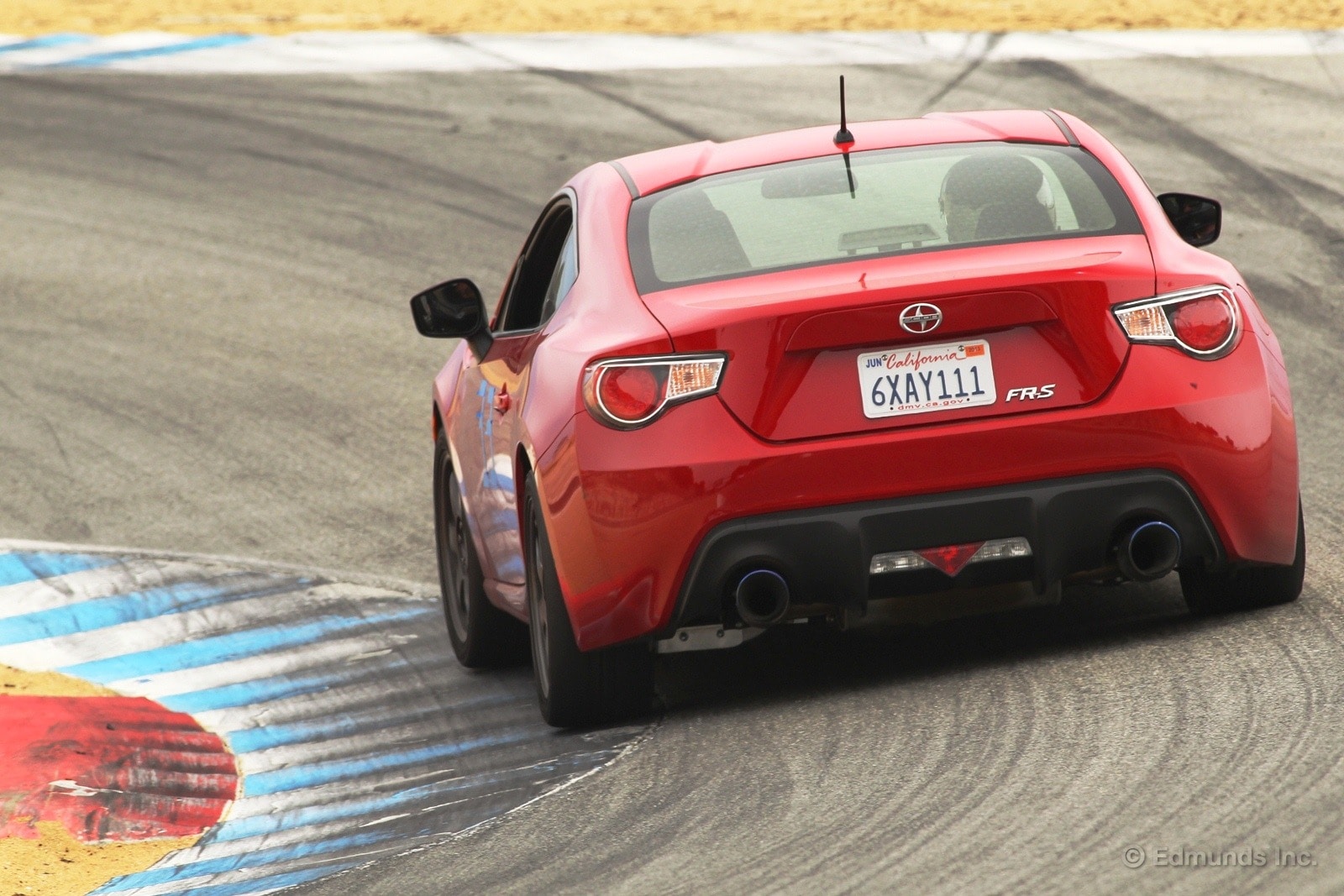
The right way to set up a car is with a tire pyrometer, an open track and lots and lots of time. We would do precisely none of those things for this trip. This can only mean total failure! Right?
Nah. Turns out the Scion FR-S's handling is better than ever, both on the road and track. The alignment in its current state (front: -1.9 degrees camber, zero toe; rear: -1.7 degrees camber, 1/16" total toe in), even if not dialed to said max optimum-ness, has yielded more communication, grip (as measured by my buttometer) and progression than it had last time it was here at Mazda Raceway Laguna Seca.
At track-out, the back end rotates more gradually so you can pick up the throttle sooner and carry more speed out of the turn. Of course, this car lacks the power to do this in every corner. Or even most corners. Turn Five, for example, is an exercise in getting the car pointed at the apex as early as possible so that you can stand on the gas and...gently creep up the hill towards Turn Six.
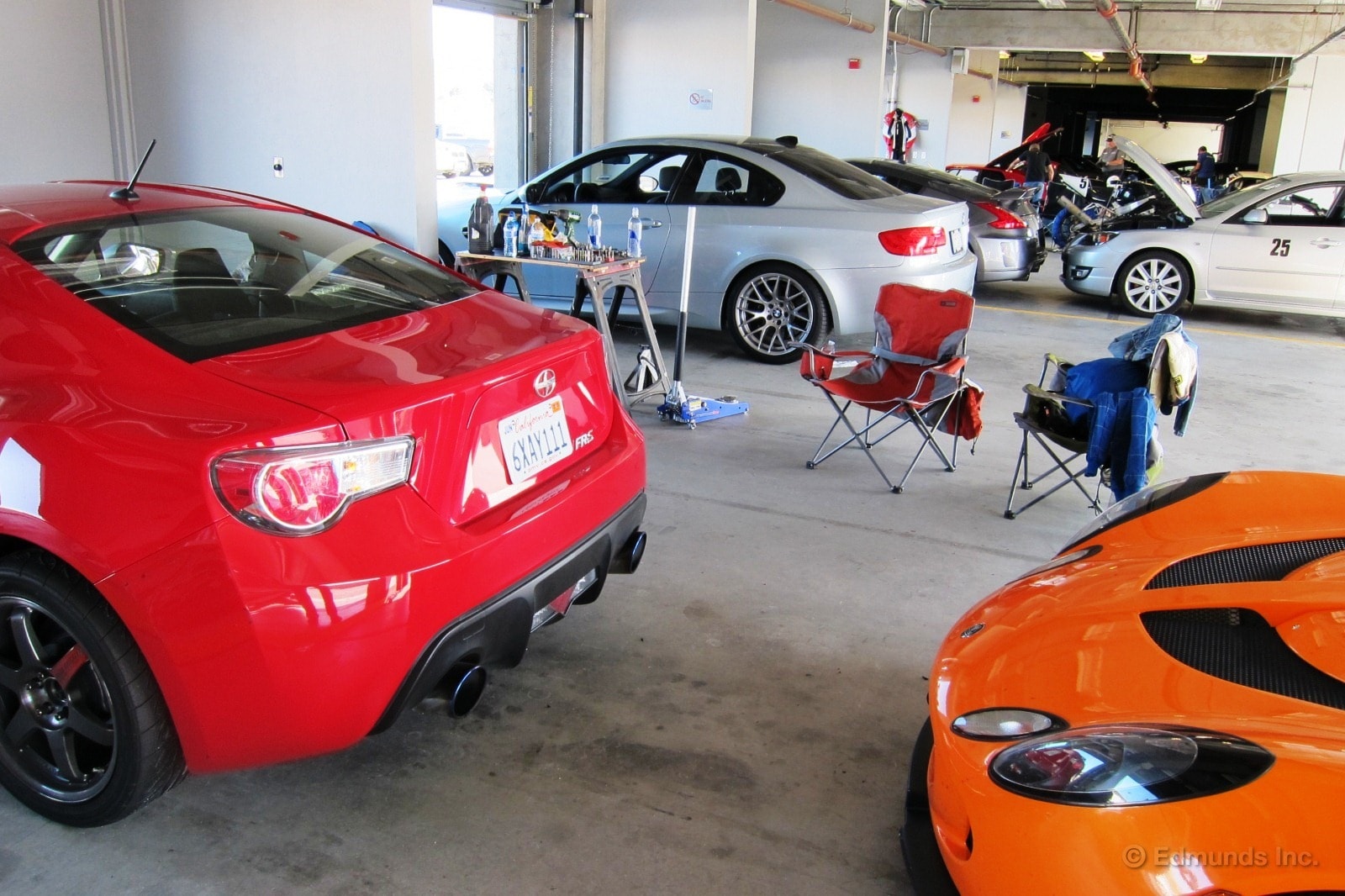
Mazda Raceway Laguna Seca is a track that rewards horsepower, and its turns have more of a rhythm to them when you have it. In a full-weight, stock-power car on street tires such as this one, the bit of waiting between corners makes each one a more discrete, segmented experience. Still, I'm really enjoying the Scion FR-S here, particularly as I don't need to back way off every lap and a half to keep the brakes from going limp. It's more like three and half laps now.
Yeah. That, and these track pads (XP8/XP10) don't have a lot of bite at jump-in, so you need to use more of the pedal's travel to extract braking force. Basically, with these pads you need to jam the pedal to the floor in short order. This in turn makes reaching the throttle in heel-toe maneuvers quite awkward.
As a result, in braking zones I'd have to release the brake pedal slightly to blip the gas, downshift, then resume hard braking. This is not ideal by any stretch. It lengthens the braking zone and saps confidence (and makes the guy in the 911 who's been chasing you for the past two laps wonder just what the hell is wrong with you when you brake for Turn 11). Plus the brakes eventually wilted anyway. Not blown away by these pads, though I suspect some cooling would help with the latter bit.
The tires held up better. They'd get ever so slightly greasy near the end of each session but breathing off the speed for a few corners would bring them back. They never 'fell off the cliff,' completely though, and remained nicely progressive even in this overheated state. In summary, the Yokohama AD08 tires have given us terrific dry grip, nice breakaway, surprisingly good recovery, are noisy and have dismal wet handling characteristics.
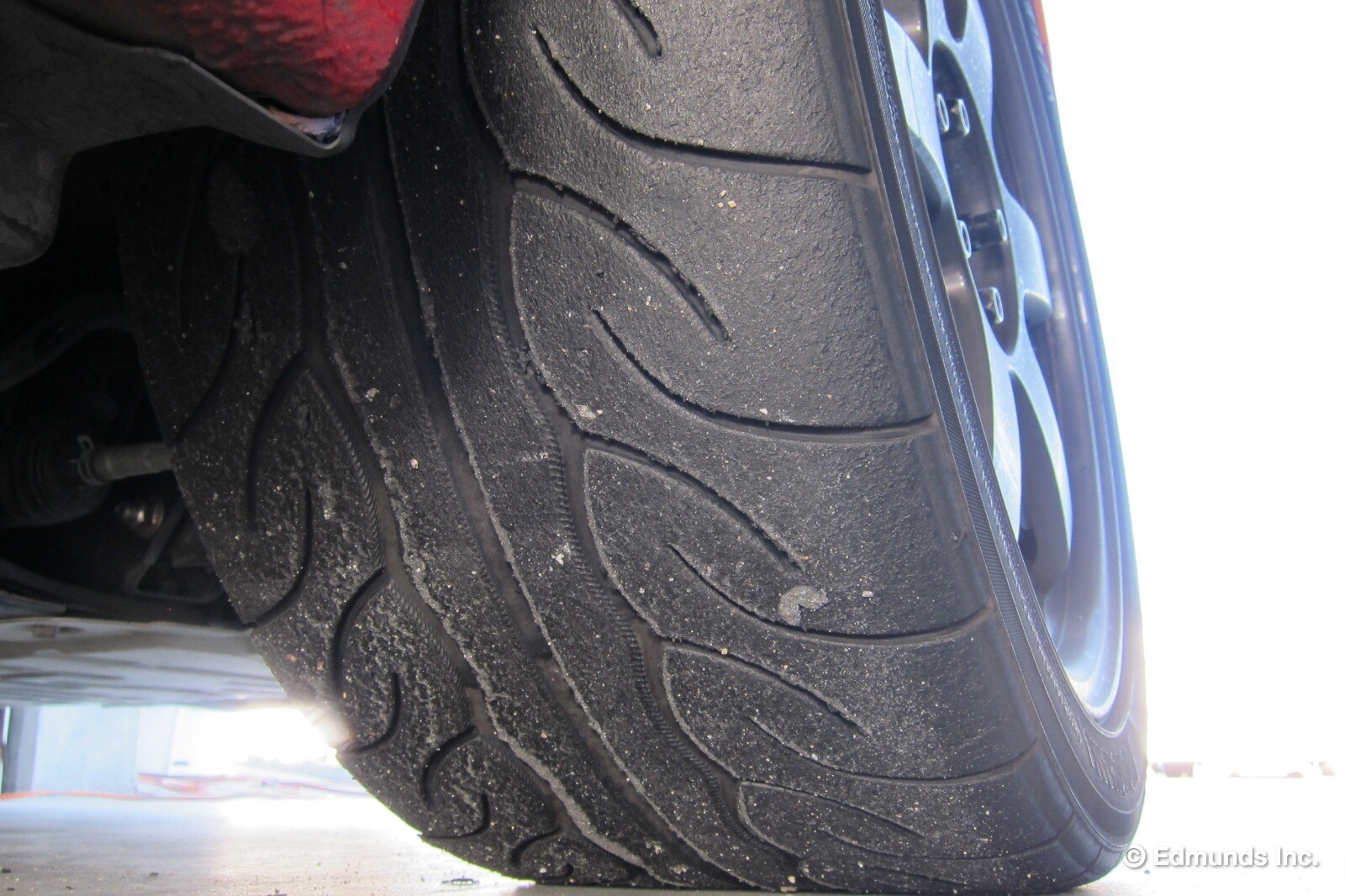
Another benefit to increased negative camber is that the outer tread blocks are taking less of a pounding. On a car that sees a lot of track time you can actually extend the tires' life this way. More grip plus longer life equals win. If you simply plod along on the freeway with the -2.0 degrees front camber we have, expect the inner tread to go away first.
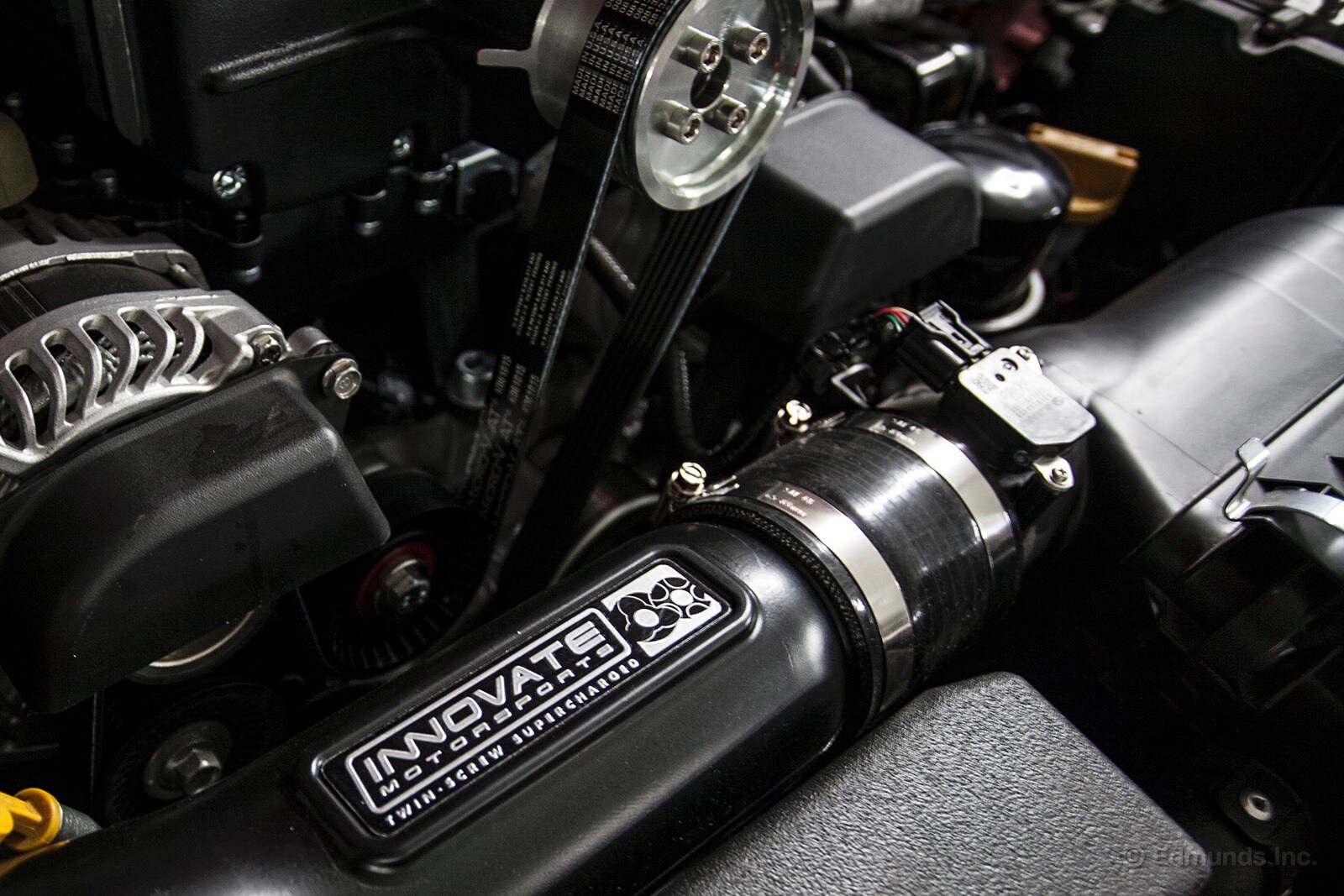
Back in May 2012, when I first drove a pre-production example of the 2013 Scion FR-S, Chief Engineer Tetsuya Tada described to me in some detail the protracted genesis of its flat-four FA20 power plant. That they wanted 100 hp/liter. That Subaru's FB-series wasn't going to cut it in its then-current form. That Toyota handed the next generation of their D-4S direct injection technology to Subaru, their competitor, in order to make it happen. That it had a big ol' torque hole right smack in the middle of the rev range.
Actually, Tada-san never mentioned that last bit. I discovered it for myself the first time I touched the FR-S's throttle to the carpet. Such a terrific chassis and little punch to really exploit it.
We've been angling to remedy that for some time in Project FR-S, our long-term 2013 Scion FR-S. The other day the stars aligned, and Innovate Motorsports got busy installing their twin screw supercharger kit onto it. This is a bolt-on, belt-driven positive displacement supercharger kit that promises a bump in peak power, sure, but more importantly a slug of Tabasco in the midrange. You know, where the FR-S actually needs it.
The company originally told us installation would take four hours. It took less than three hours. Bolting this much power onto a highly-tuned normally aspirated engine has never been this easy.
[Update: installation time-lapse video added at the end of this entry.]
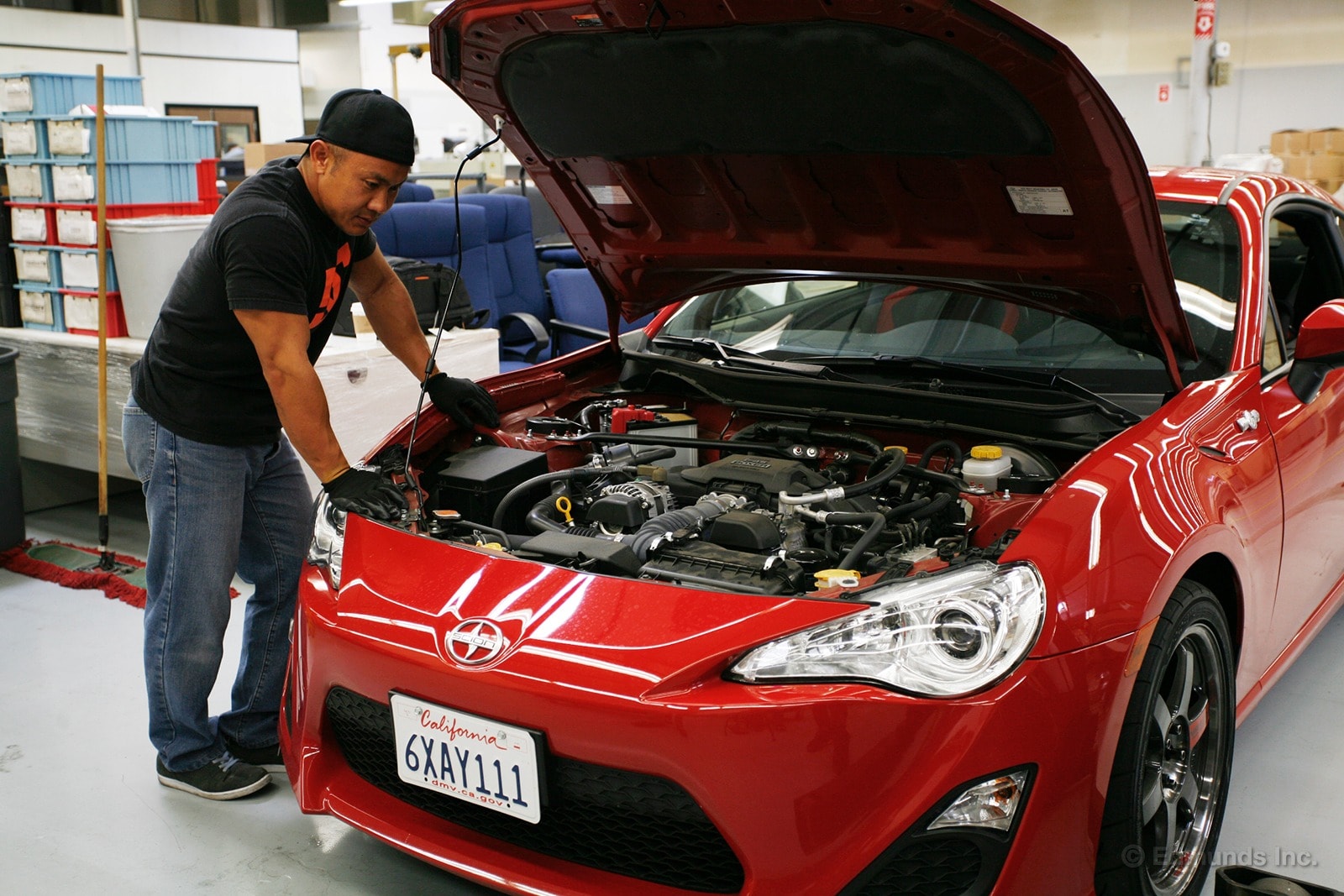
Then again, we had an ace in our corner. Innovate Motorsports' Gary Kubo (of NHRA drag racing fame) did the entire installation solo while Mark Takahashi (who shot the photos you see here) and I made fart jokes.
Gary's done a half-dozen installations of the kit already, so he's pretty adept at it by now. However, the company recently had a first-timer install the kit, and it took that guy less than five hours.
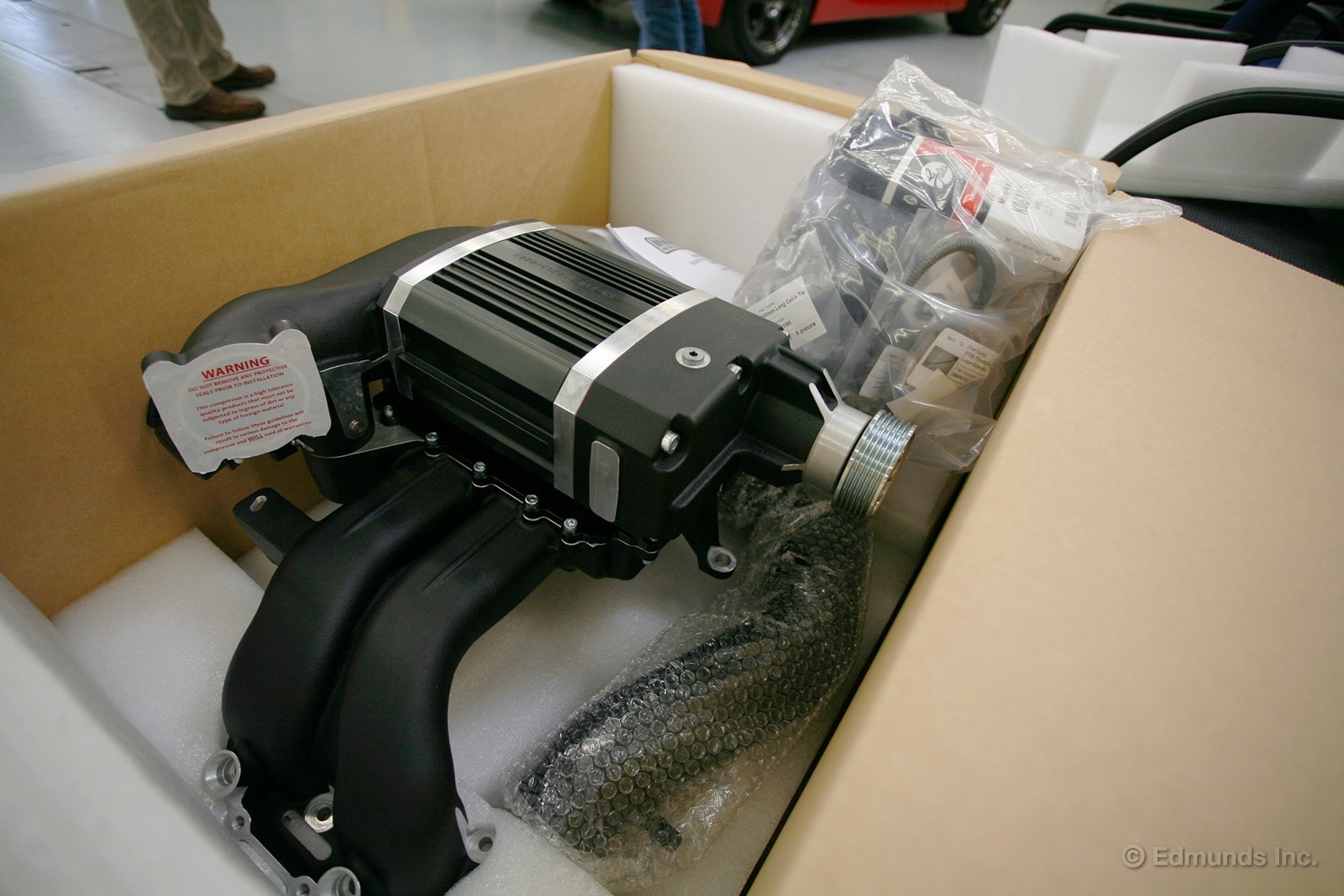
The contents of the box. Most of the hard work is already done, as the supercharger comes pre-installed on the new intake manifold.
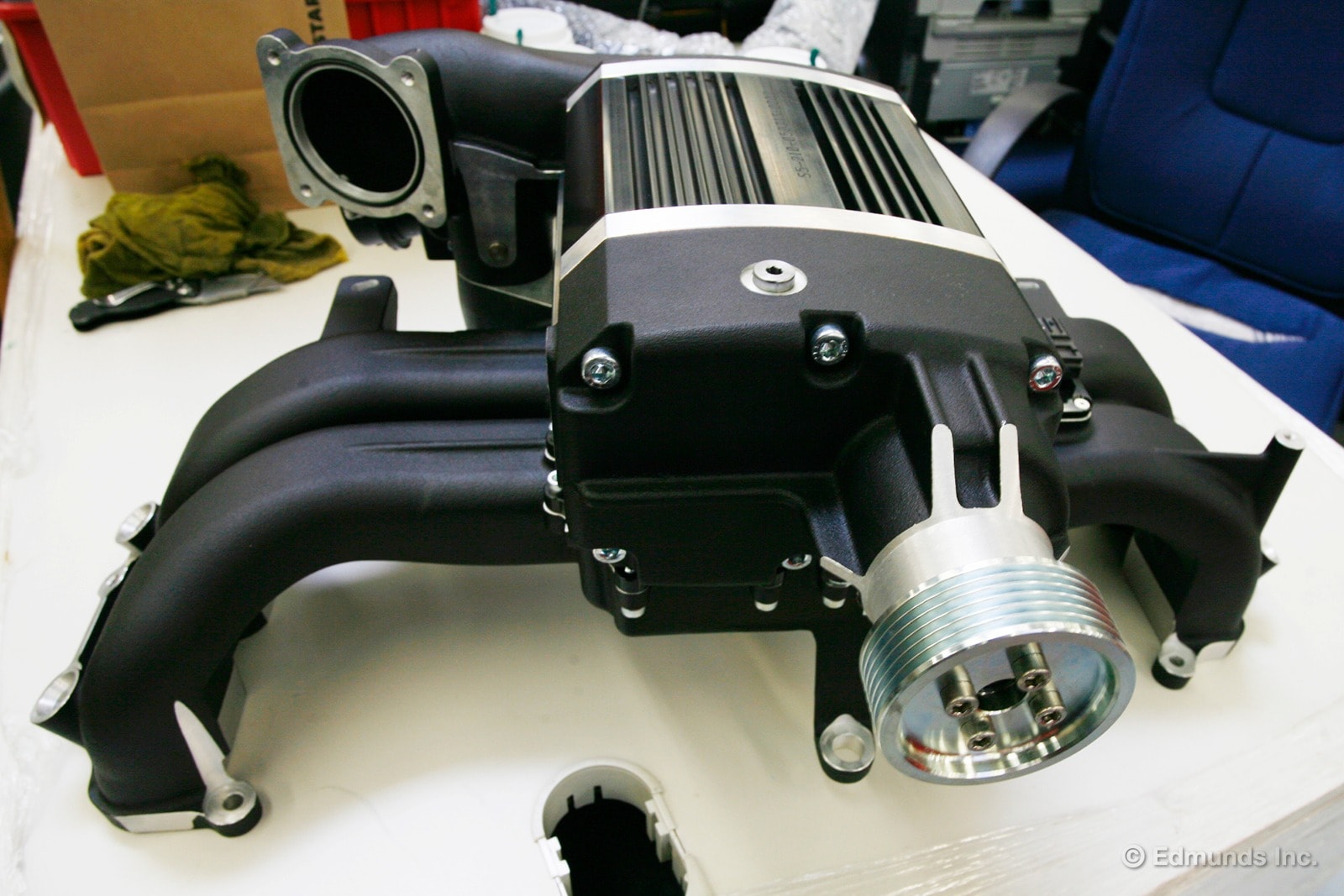
Here's a better look at the Innovate Motorsports supercharger kit's main event: its twin screw blower and a proprietary intake manifold. Our car is receiving the base kit, which is not intercooled. The base kit is low boost and the calibration was developed on California 91 octane.
Sean Crawford of Innovate Motorsports tells us they've been thrashing their supercharger-equipped shop car for 7,000 miles while developing the calibration and it hasn't missed a beat, and that includes track-testing in the California desert during summer.
No permanent alterations to the donor car are needed to install the Innovate Motorsports kit. Also, an intercooled version is in the works and the intercooler hardware is modular, meaning it can be easily retrofitted to the base kit down the road, for those inclined.
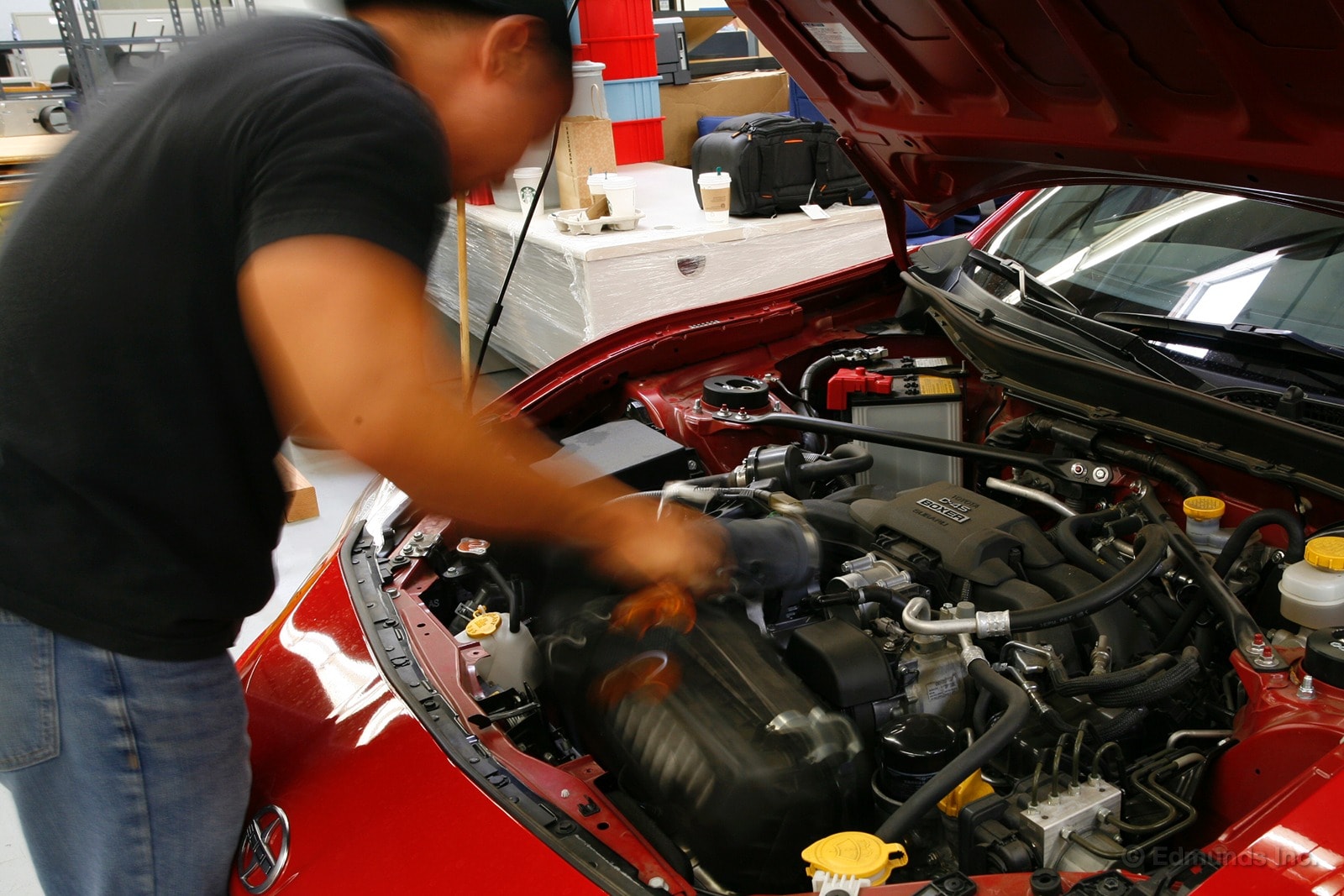
The stock airbox is retained once the supercharger is installed. This is significant because the stock airbox is a rather nice piece. It draws cool, high-pressure air from the nose instead of sucking in hot air from the engine bay like the intakes found in other kits. And, because the stock MAF is not moved or relocated, its voltage characteristic remains as-stock. There's also enough voltage headroom built into the stock MAF to accommodate the higher airflow rate of the Innovate Motorsports kit.
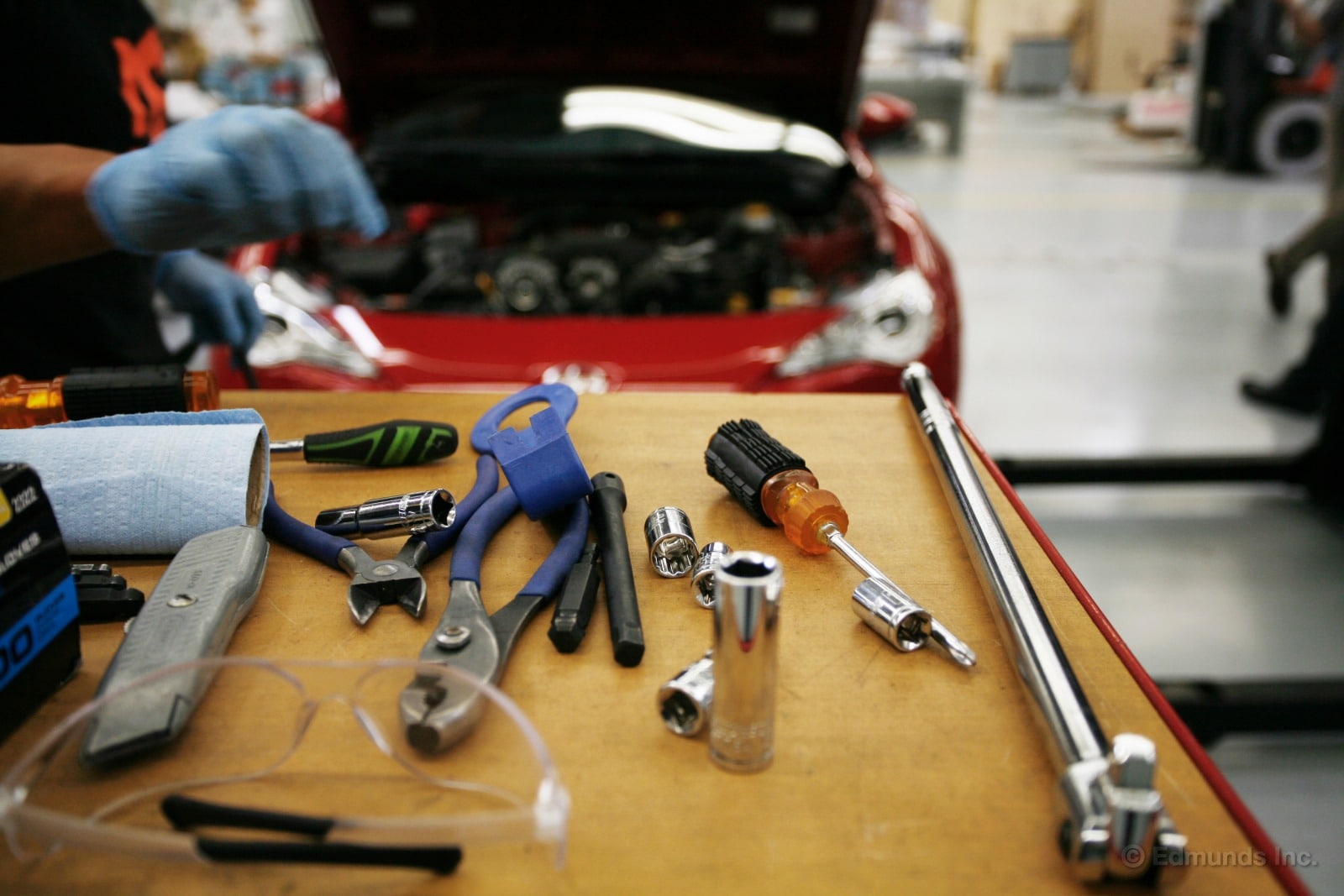
Simple hand tools are all that's needed. There's one bolt in the kit that requires an oversized hex key, but not to worry, the hex key is included with the kit.
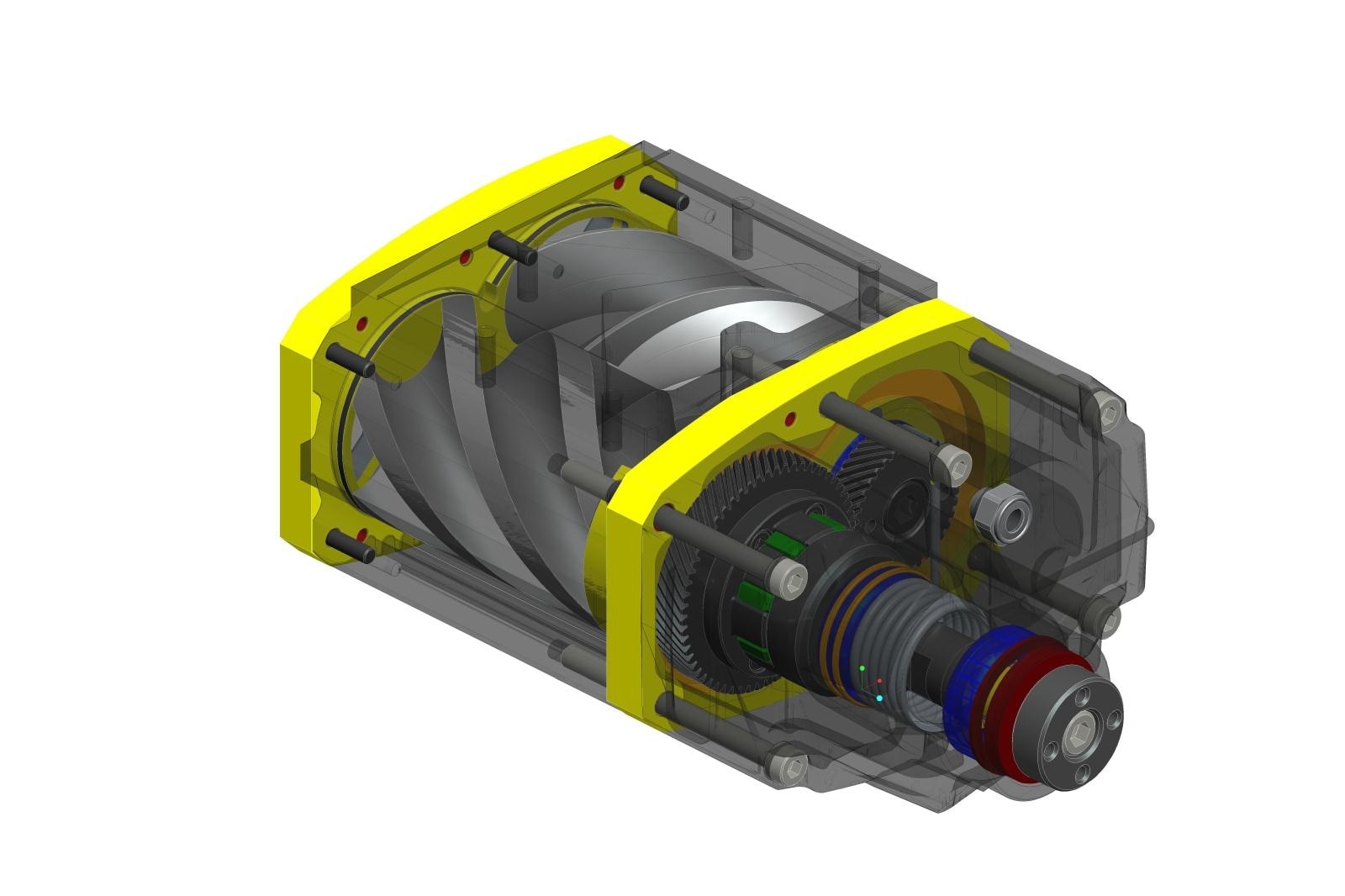
Twin screw superchargers are generally more efficient than Roots blowers, since a twin screw has internal compression and a Roots does not. In a nutshell, what this means is that a twin screw supercharger typically generates cooler discharge temperatures than a typical Roots.
While modern 'TVS' Roots blowers generate similar peak efficiency as a twin screw, the disparity in efficiency between the two blower types grows increasingly wide when you look at off-peak values. Suffice it to say that a supercharger can't always operate at peak efficiency, especially when it is being driven by an engine like the FA20 that has a large rev turndown (7,400 rpm fuel cut).
Discharge temperatures are said to be around 140 degrees F. when driven hard on the street, a bit higher after a good heat soaking on the track. Sean recommends that guys who track their supercharger-equipped cars also install an oil cooler.
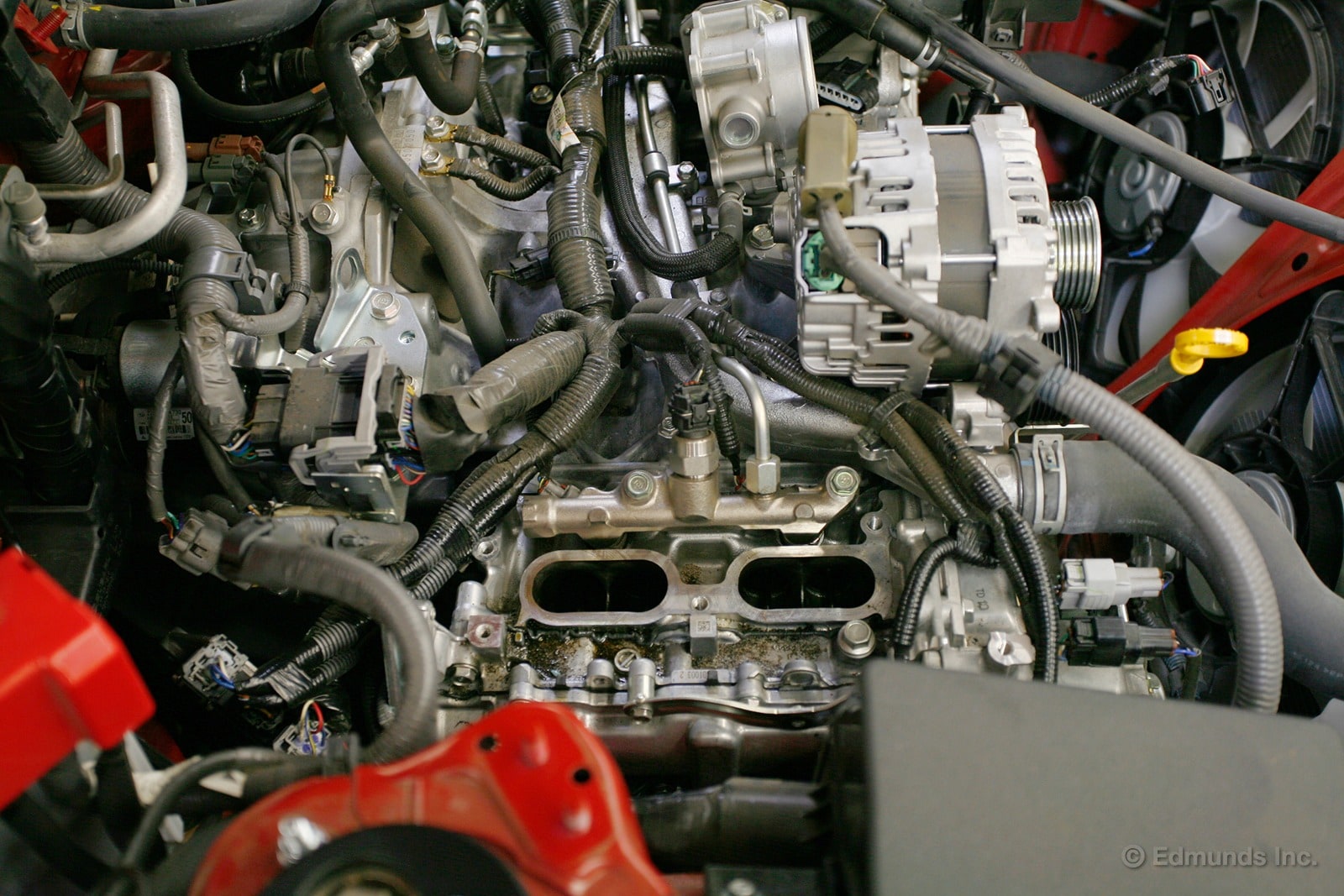
Most of the installation time is taken by the removal of the stock intake manifold. Once you've reached this point, you're already over the hump.
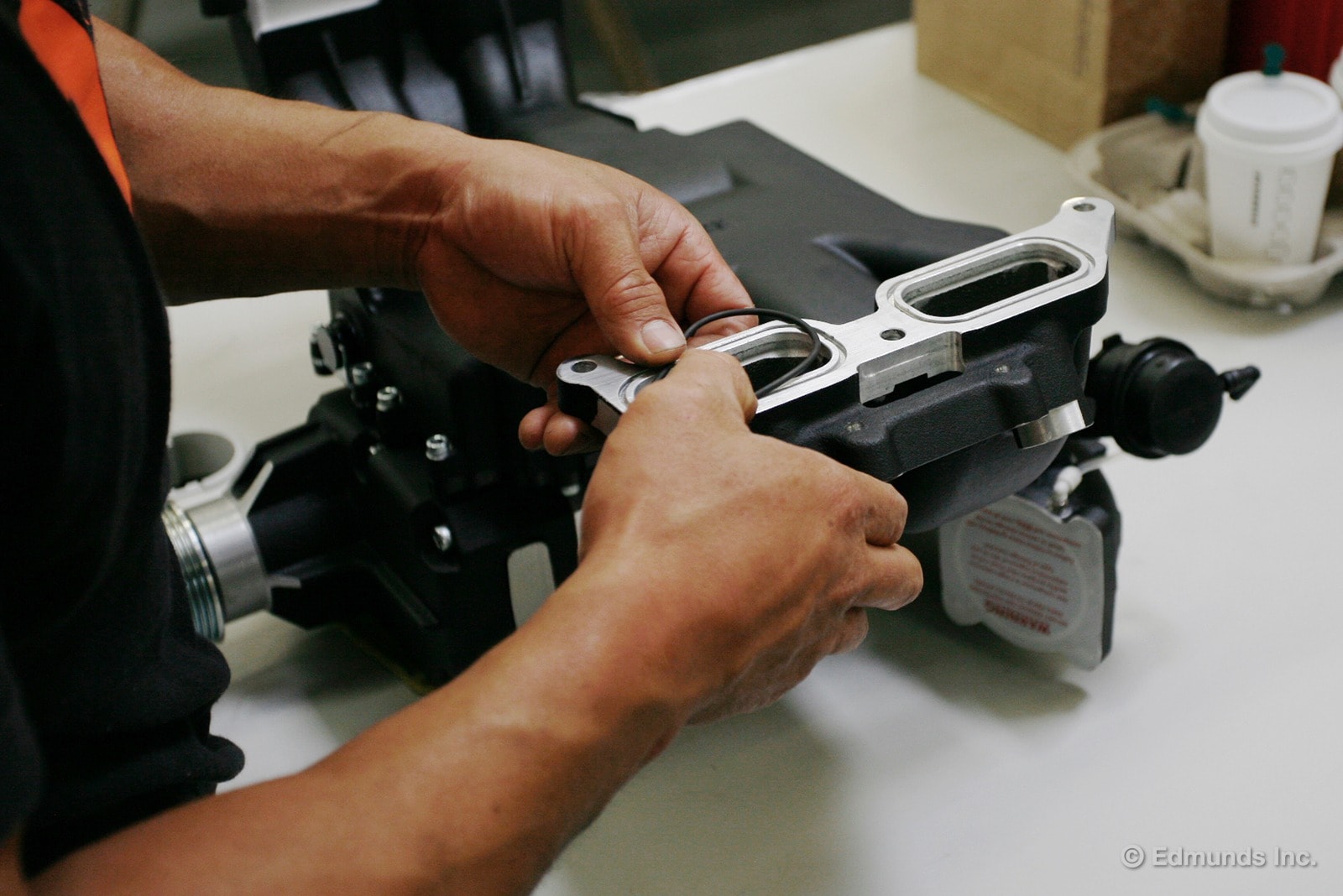
Gary pops o-rings into the Innovate Motorsports manifold prior to installation.
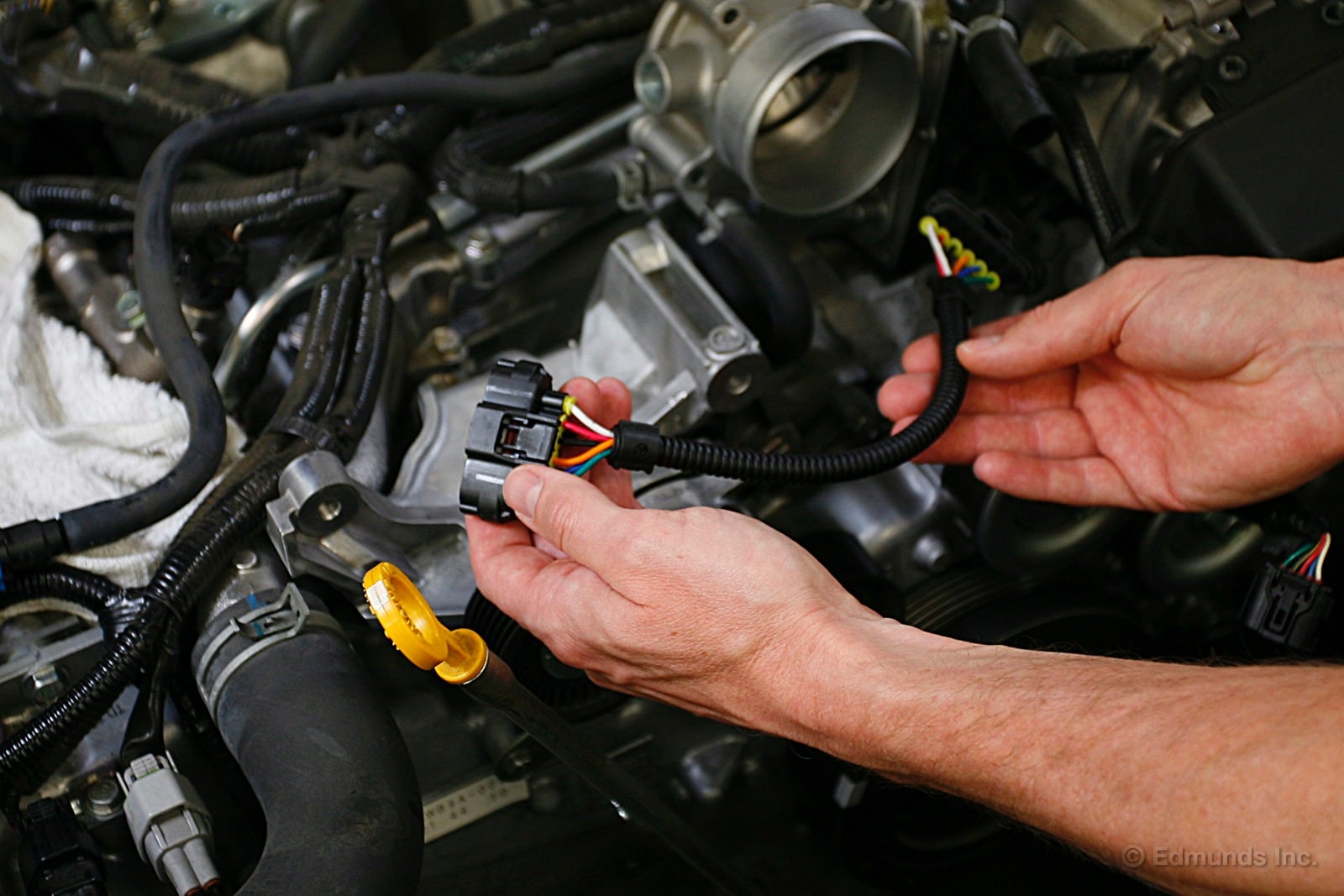
Because the throttle body is relocated, its original electrical connector won't reach. Innovate Motorsports includes this neat plug-and-play throttle extension harness to resolve this space-time conundrum.
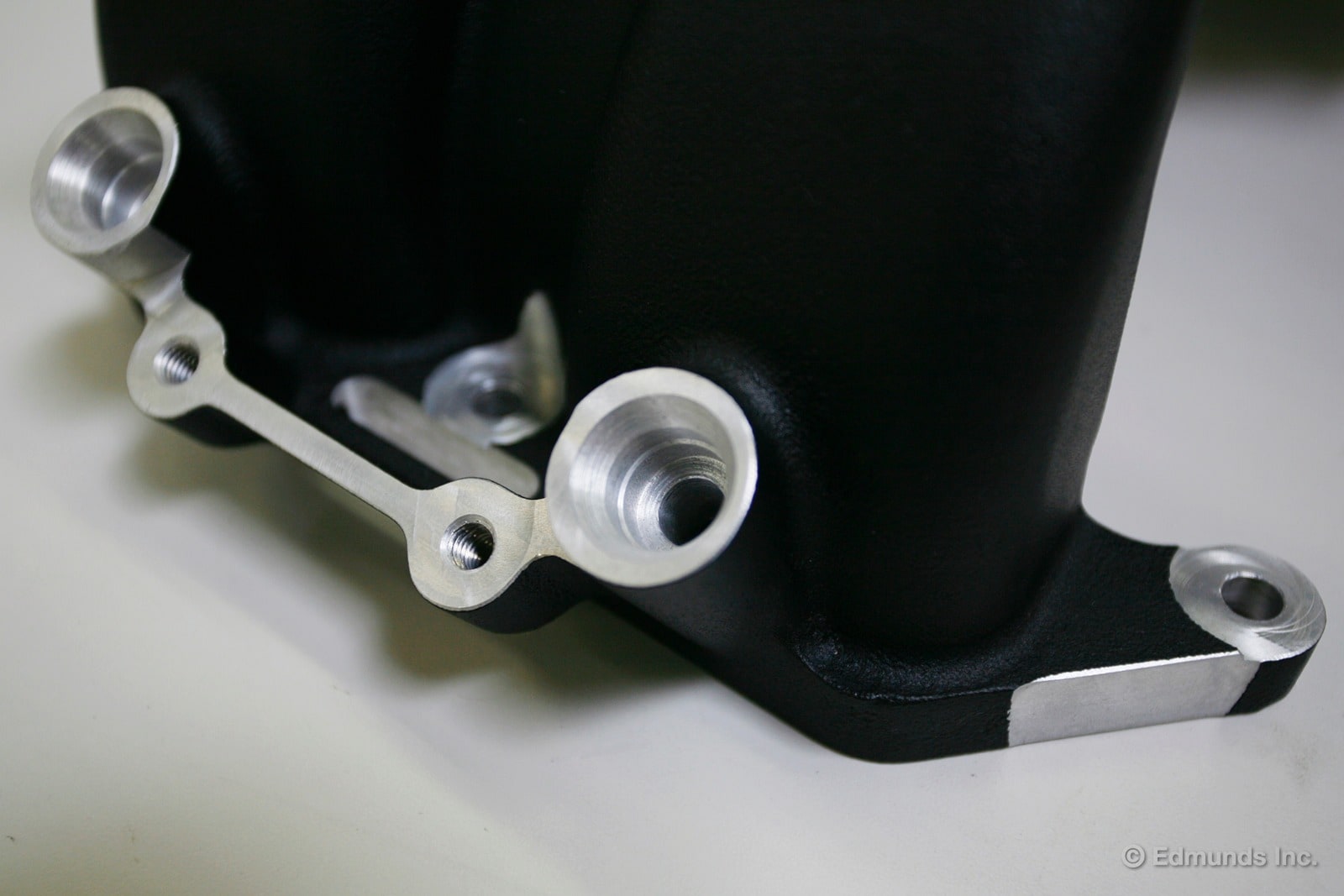
Injector bungs on the new manifold. All of the kit's castings look very nice, and the black power coating lends the kit a near-OEM look. Same goes for the assorted bracketry and hardware that comes with the kit. It all looks very well thought through and sano, with no corners cut.
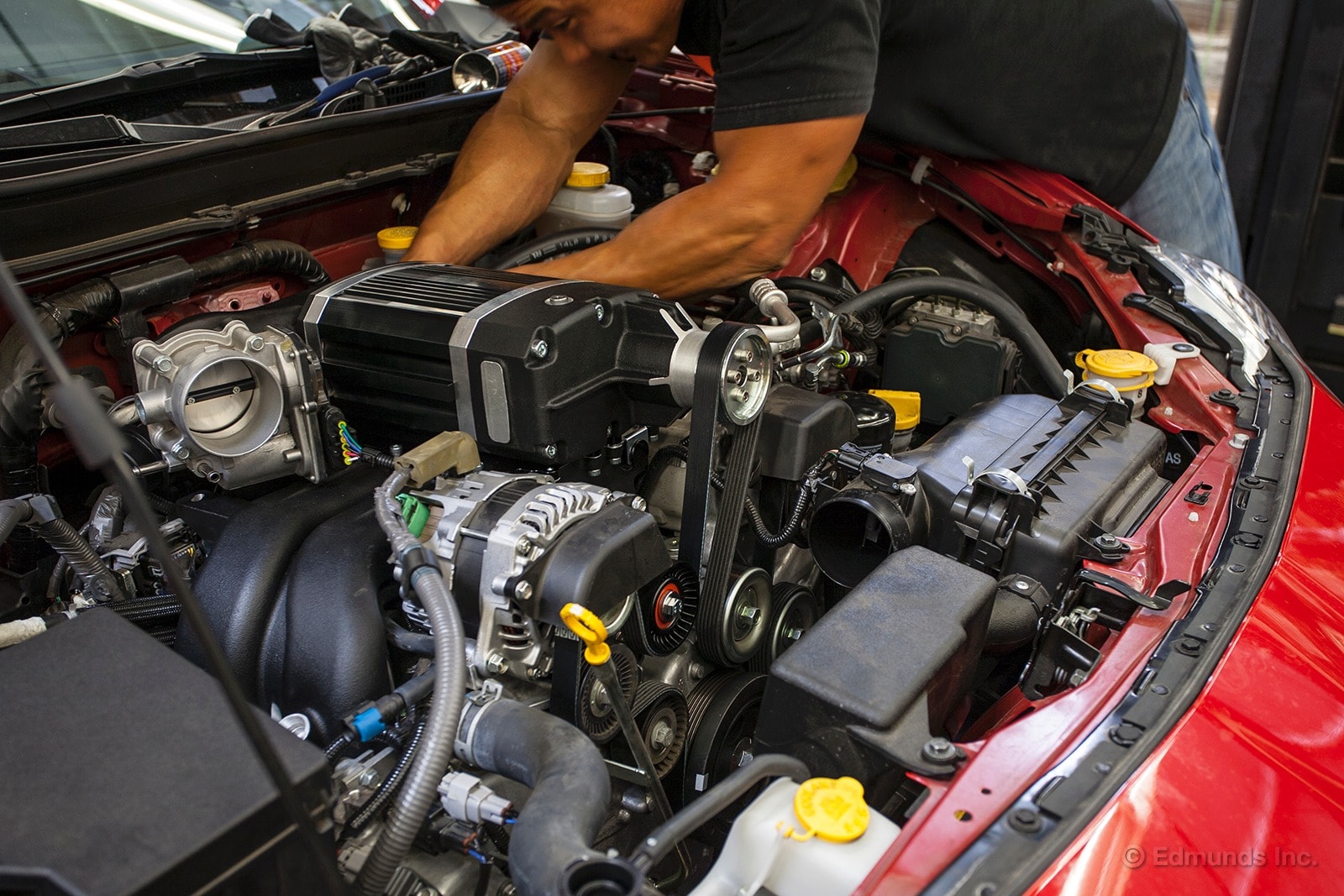
Almost there. The blower's home, the drive belt and tensioner are installed. All that are left are a few ancillary attachments, the trick roto-molded intake tube and a reflash.
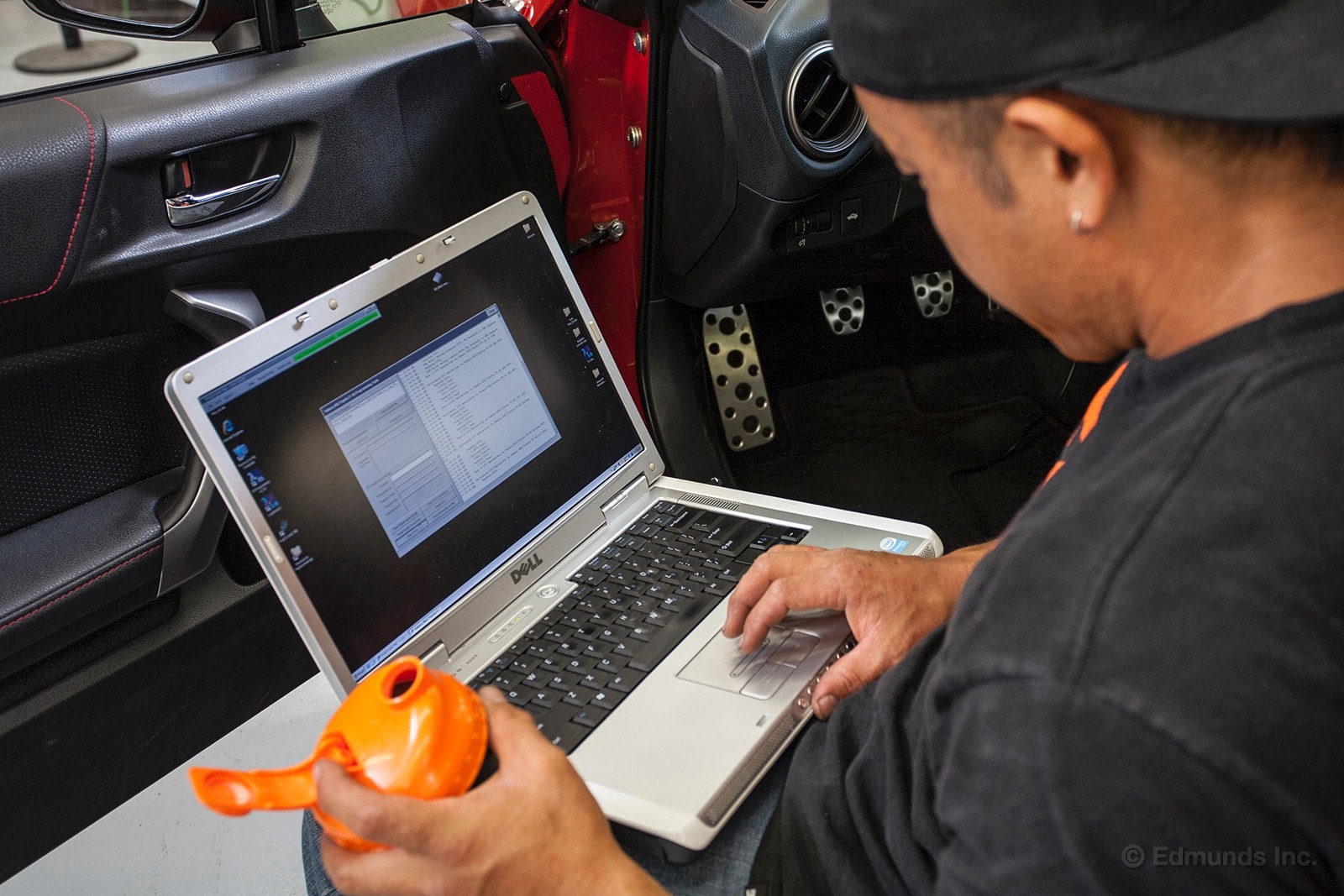
Gary uploads the proprietary EcuTek reflash. By the way, this kit is CARB EO pending.

It lives! Stay tuned for updates, as there's much more to come: dyno-testing, acceleration results, driving impressions and more.
Source:
Innovate Motorsports
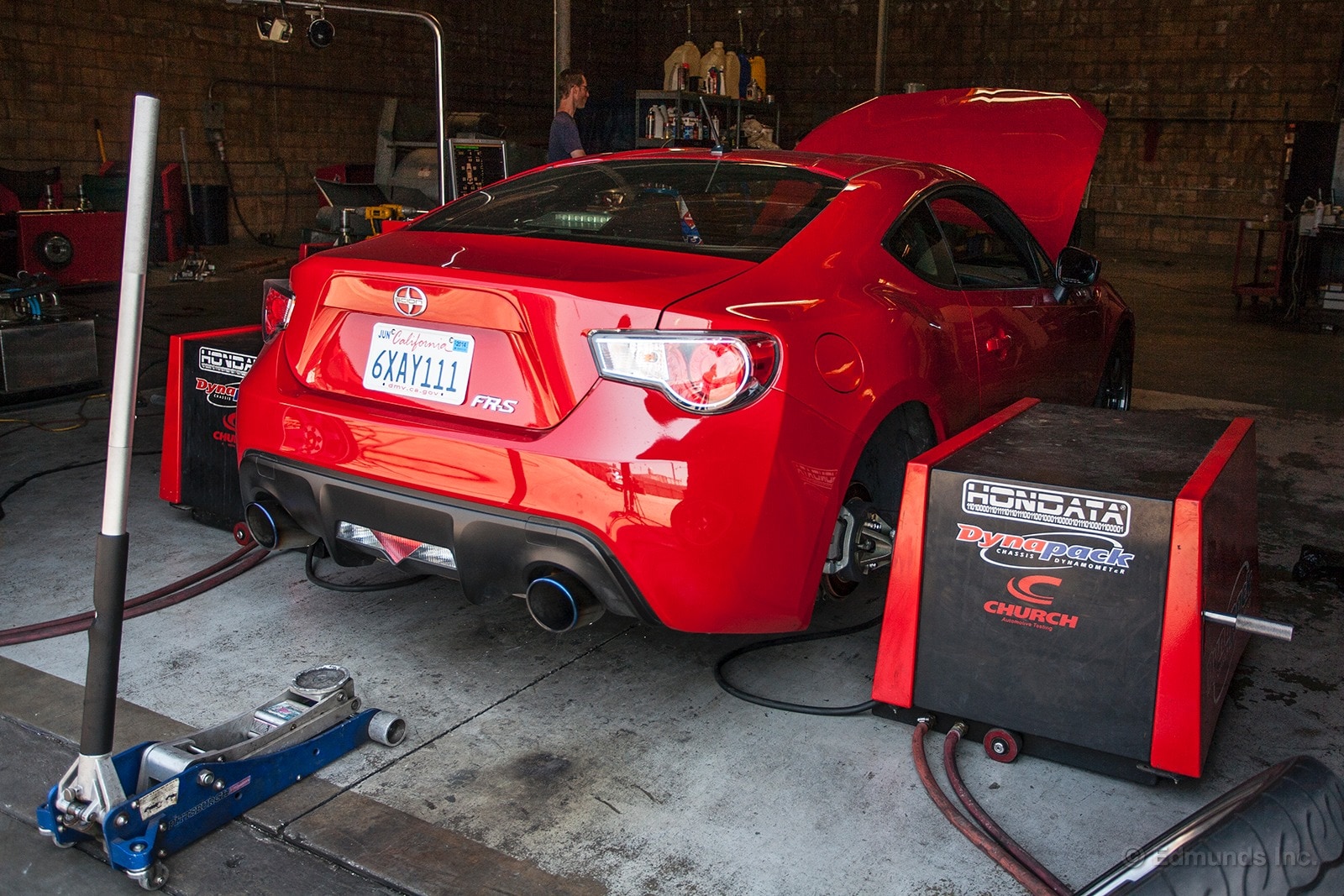
Everyone wants "apples to apples" or at least they should. It's the only way to go.
The day before the Innovate Motorsports supercharger kit was installed on Project FR-S, our long-term 2013 Scion FR-S, I visited Church Automotive Testing in Wilmington, California. The boss man there, Shawn Church, performed several pulls and established a baseline on our car, stock save for its Apexi catback exhaust.
Immediately after the supercharger kit was installed the next day, I again rolled straight to Church Automotive Testing. Several pulls were performed and the car's stabilized, supercharged output obtained.
Same car, same dyno, same dyno operator, same methodology, same weather, even the same 91 octane fuel in the tank. Identical apples all around.
Here's what we found.
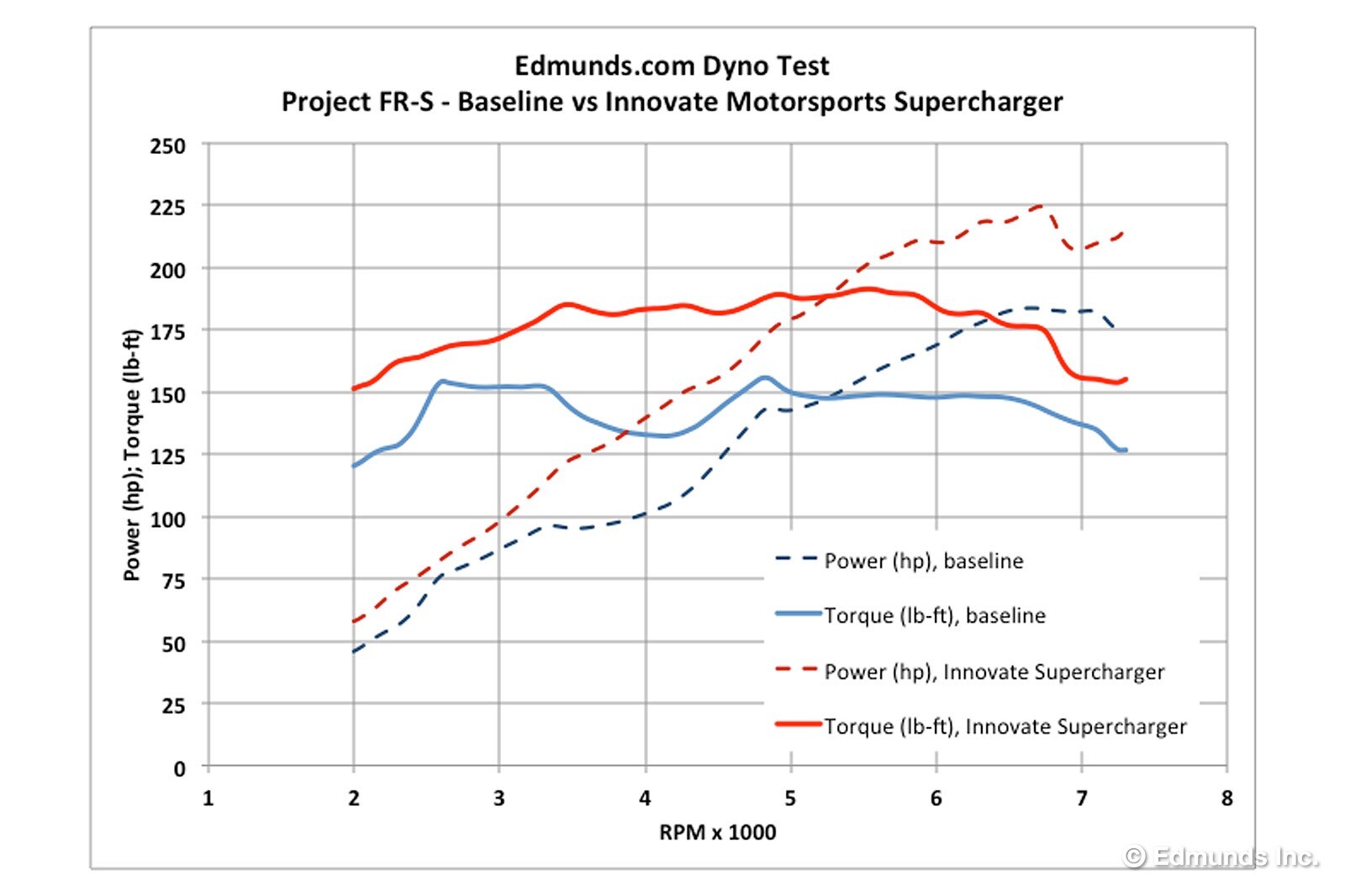
Above, the blue traces show Project FR-S in baseline, pre-supercharger form made (as measured at the hubs) a max of 155 lb-ft at 4,800 rpm, while power peaked at 184 horsepower at 6,650 rpm. Even if no units or legend were present in the graph, you'd be able to tell this was a basically stock Scion FR-S due to its torque crater between 3,300 and 4,700 rpm.
As soon as you put your foot down the Innovate Motorsports supercharger is generating boost. Below 2,700 rpm it's around 3.5 psi, rising to 5 psi at 4,000 rpm. After that it rises to a max of about 8.5 psi at 6,300 rpm.
As such, the supercharged torque curve is higher than our baseline at every point in the rev range. In red above, the Innovate Motorsports supercharger kit kicks things up to peaks of 191 lb-ft at 5,550 rpm and 224 horsepower at 6,700 rpm. Now that's more like it.
Peak numbers only tell part of the story, as the supercharger has significantly increased the area under the curve. Take a look at the torque crater. Gone. The blower fills it right up and then some.
In fact, that's where the Innovate Motorsports supercharger kit sees its largest gains. At 4,200 rpm, the supercharger kicks out 52 lb-ft more torque than our baseline. Doing the same exercise for power shows that at 5,850 rpm the blower generates its max delta of 45 horsepower over the baseline.
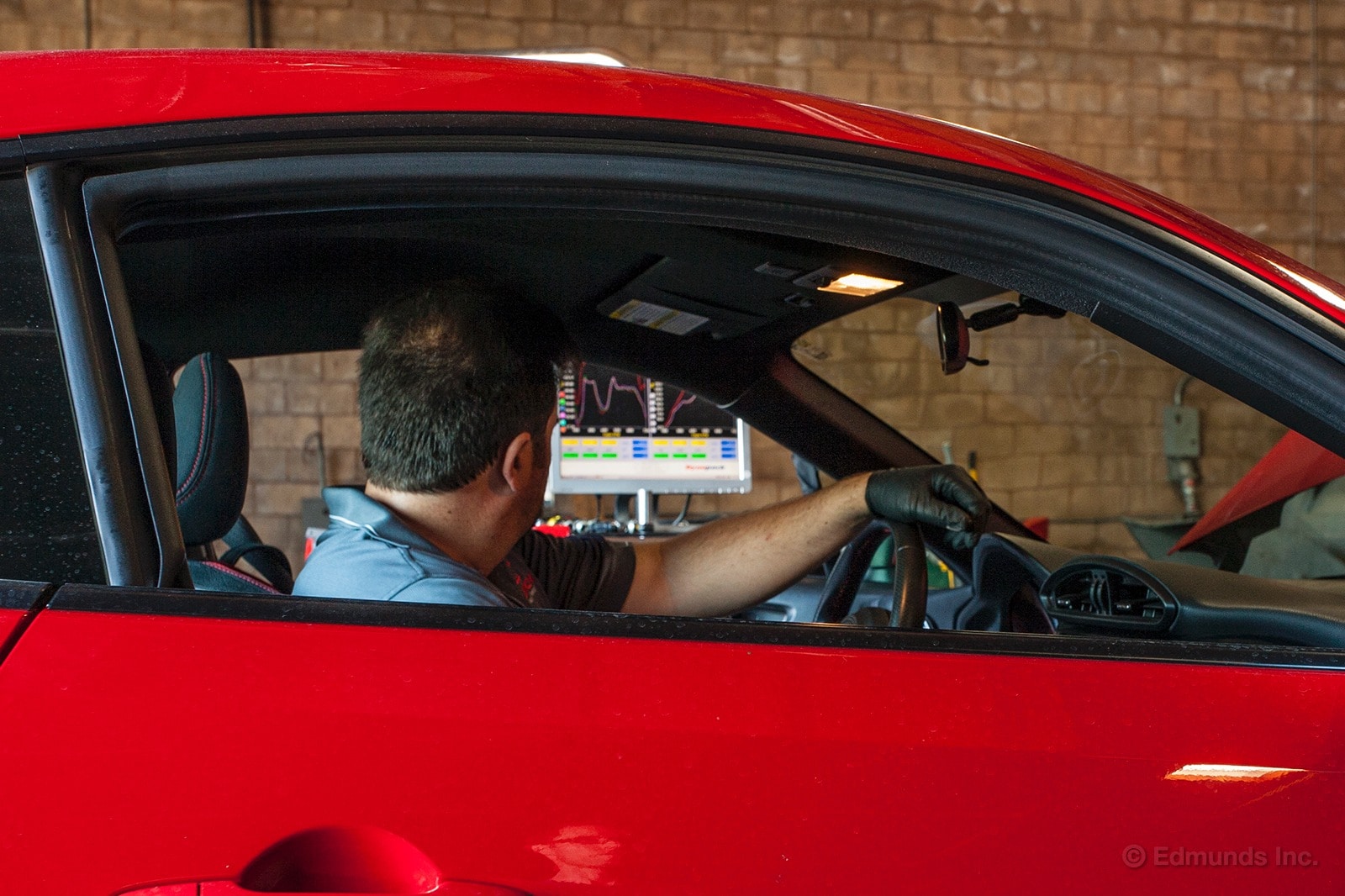
Over the course of a number of dyno pulls at Church Automotive Testing, the kit produced very consistent results. Innovate Motorsports developed their calibration on 91 octane California fuel, which is a worst case scenario as premium fuel goes. This is good news for anyone considering this kit because this means that the deltas we measured are probably the minimum you can expect.
For example, if you were to fill with the 93 octane premium available in other regions, the dip in power at 6,900 we observed (due to learned ignition retard) would likely fill in, bumping up the peak power number. Innovate reports that that retard is something that's observed only on long dyno pulls from low revs (such as our 2,000 rpm starting point) and that the map timing is unaltered in street driving. Ah, octane. Such an elusive creature in California.
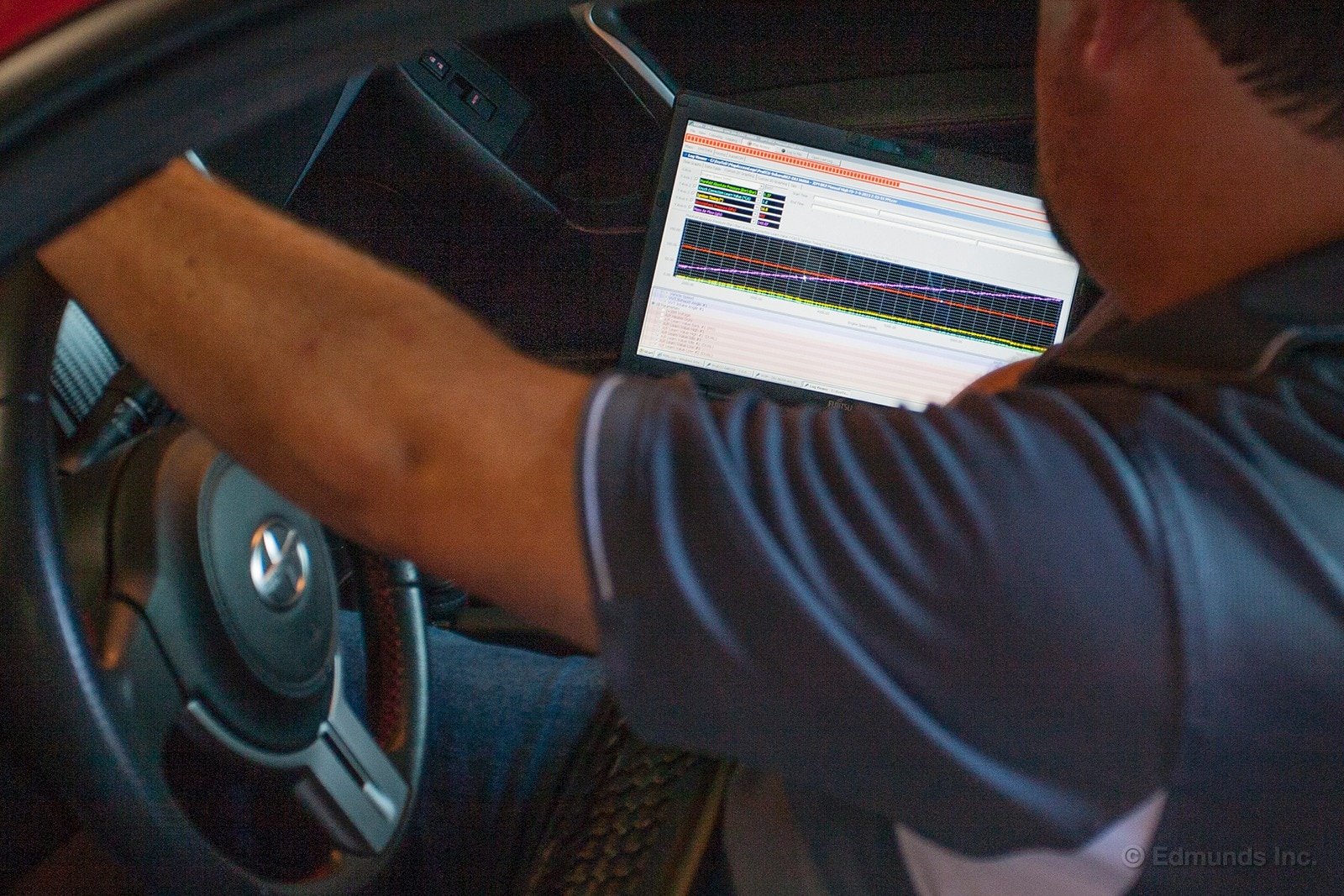
It's worth mentioning that our results were obtained on a Dynapack dyno, so our results are not directly comparable to your buddy's numbers from a Dynojet, or any other kind of dynamometer. The absolute numbers will vary from dyno to dyno for a number of reasons. The real meats of the situation are the differences between before and after.
Sources:
Innovate Motorsports
Church Automotive Testing
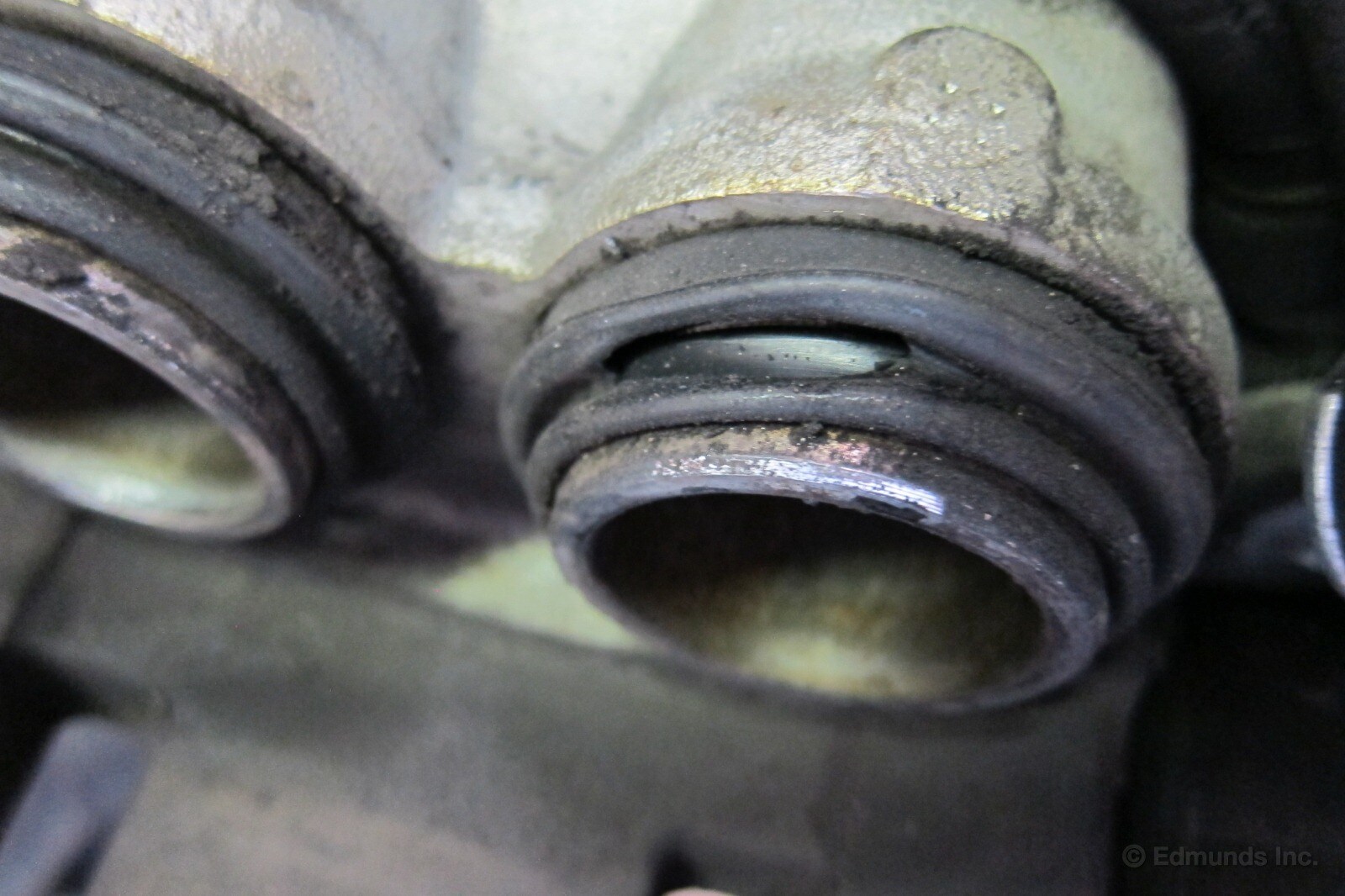
After I returned home from my weekend at Mazda Raceway Laguna Seca with our long-term 2013 Scion FR-S, I swapped its tracky brake pads back for the stock ones. If you use track pads on the street, they'll eat your rotors alive. This is because aggressive pads never warm up to operating temperature on the street, and when cold they are very abrasive.
In the process of swapping in the stock pads, I noticed signs of what I experienced while on track, that the brakes got rather hot. Above is the melted driver side front caliper dust boot. See others below. Keep in mind that this happened with stock power and street tires, though it is true that Mazda Raceway Laguna Seca is a track that's hard on brakes. More power and/or stickier tires like R-compounds (never mind dedicated track tires) would exacerbate the brake heat situation considerably.
There's not a lick of air that makes it way to the FR-S's brakes. There are no vents in the wheelwell liner, and the little spat that deflects air away from the front tires also deflect air from the brakes.
It's also got pillar-vane style rotors which have generally poor airflow pumping characteristics (manufacturers use them because they are not directional so the same part can be used on both sides, and they have good NVH characteristics).
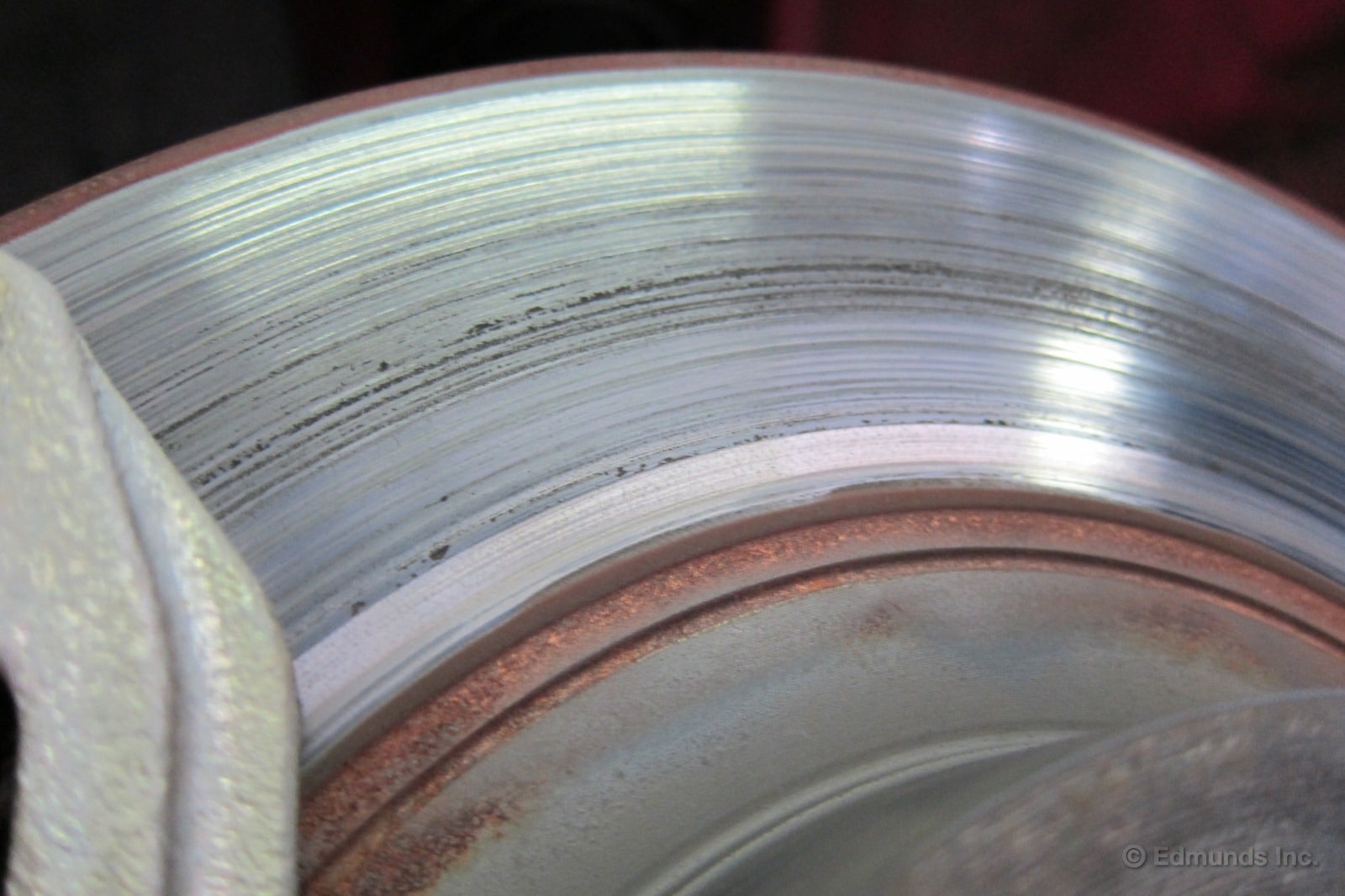
Blued and scored front rotor
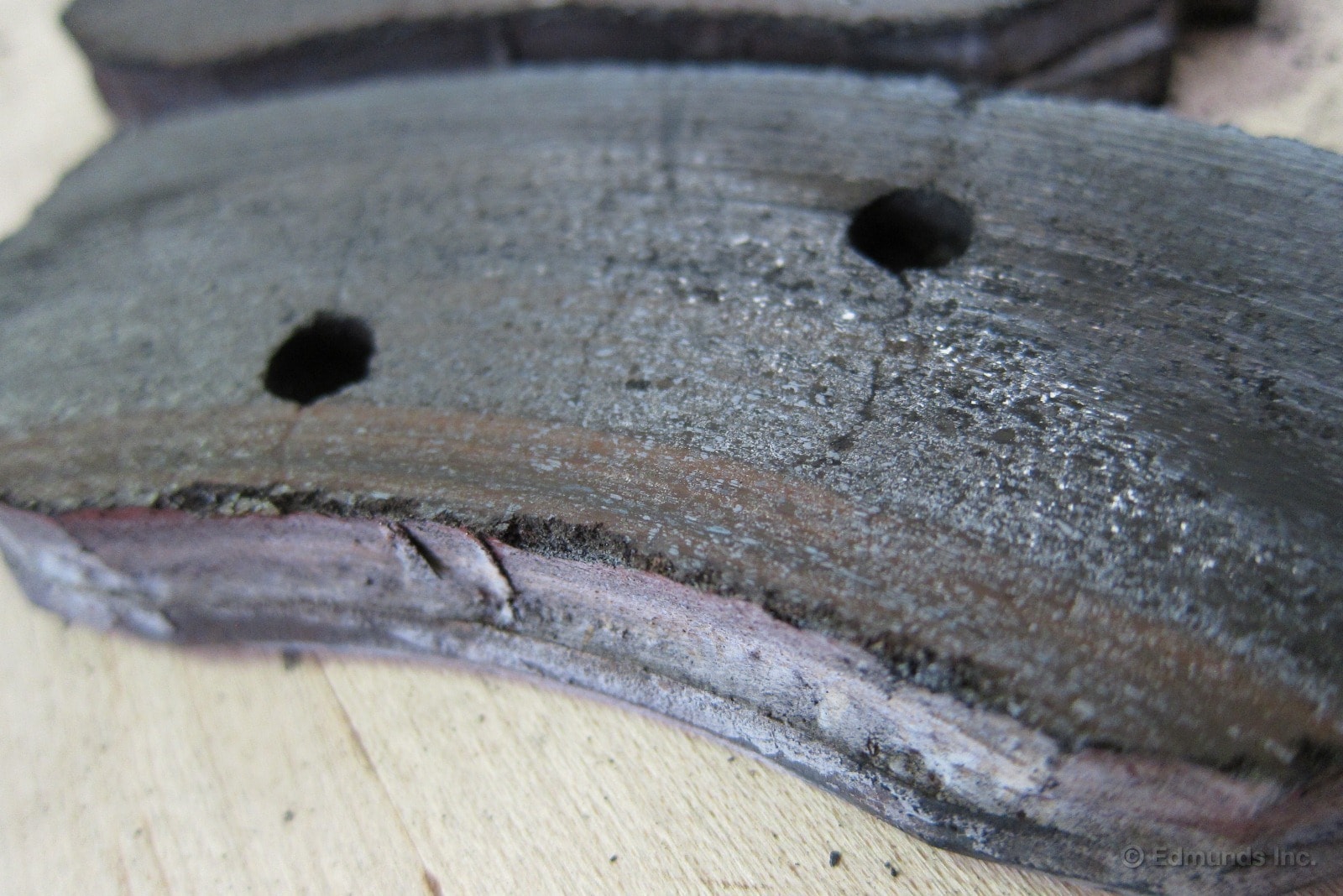
Track pads, front, cracked and crumbling
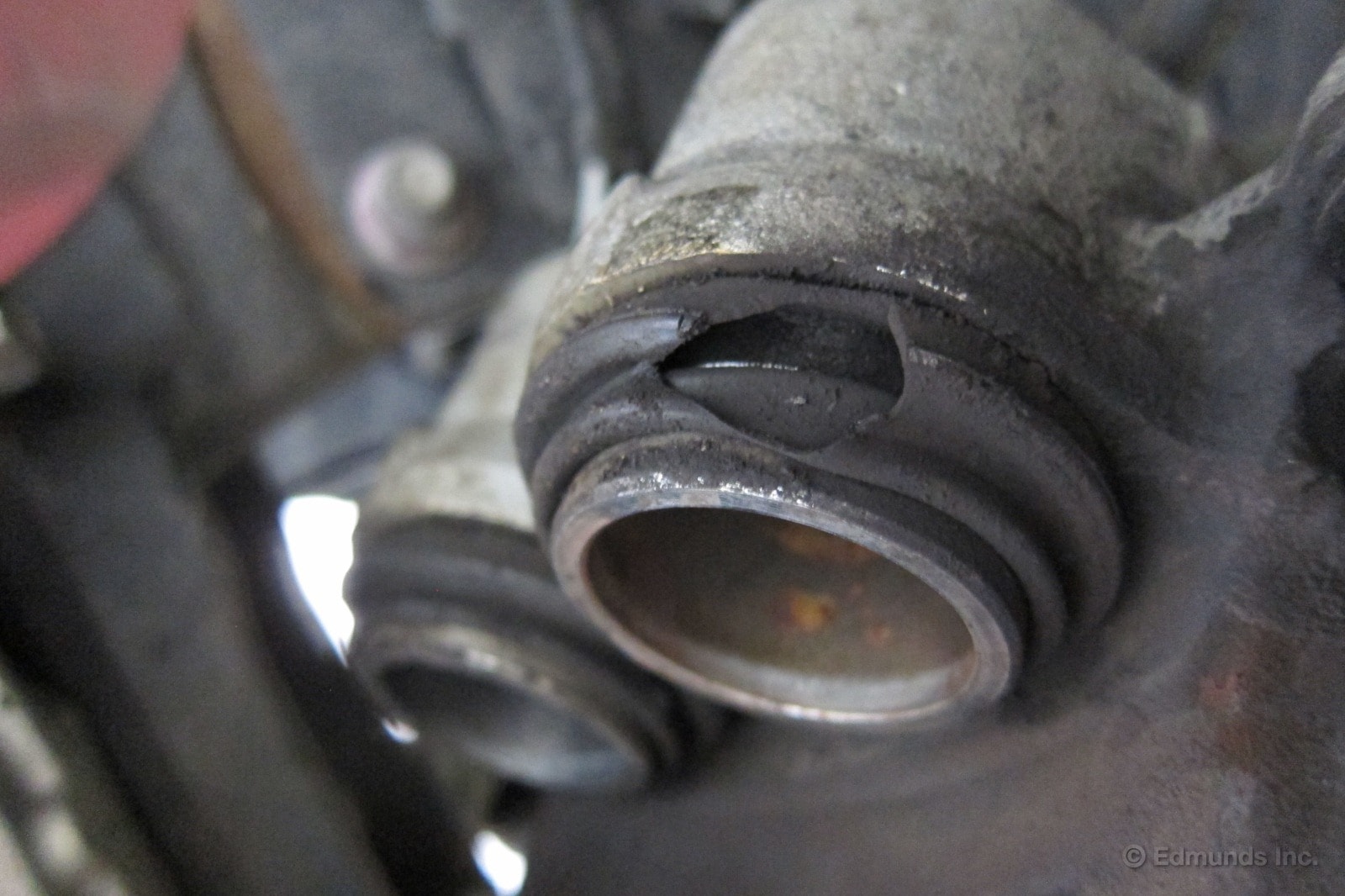
Passenger side front caliper dust boot melted
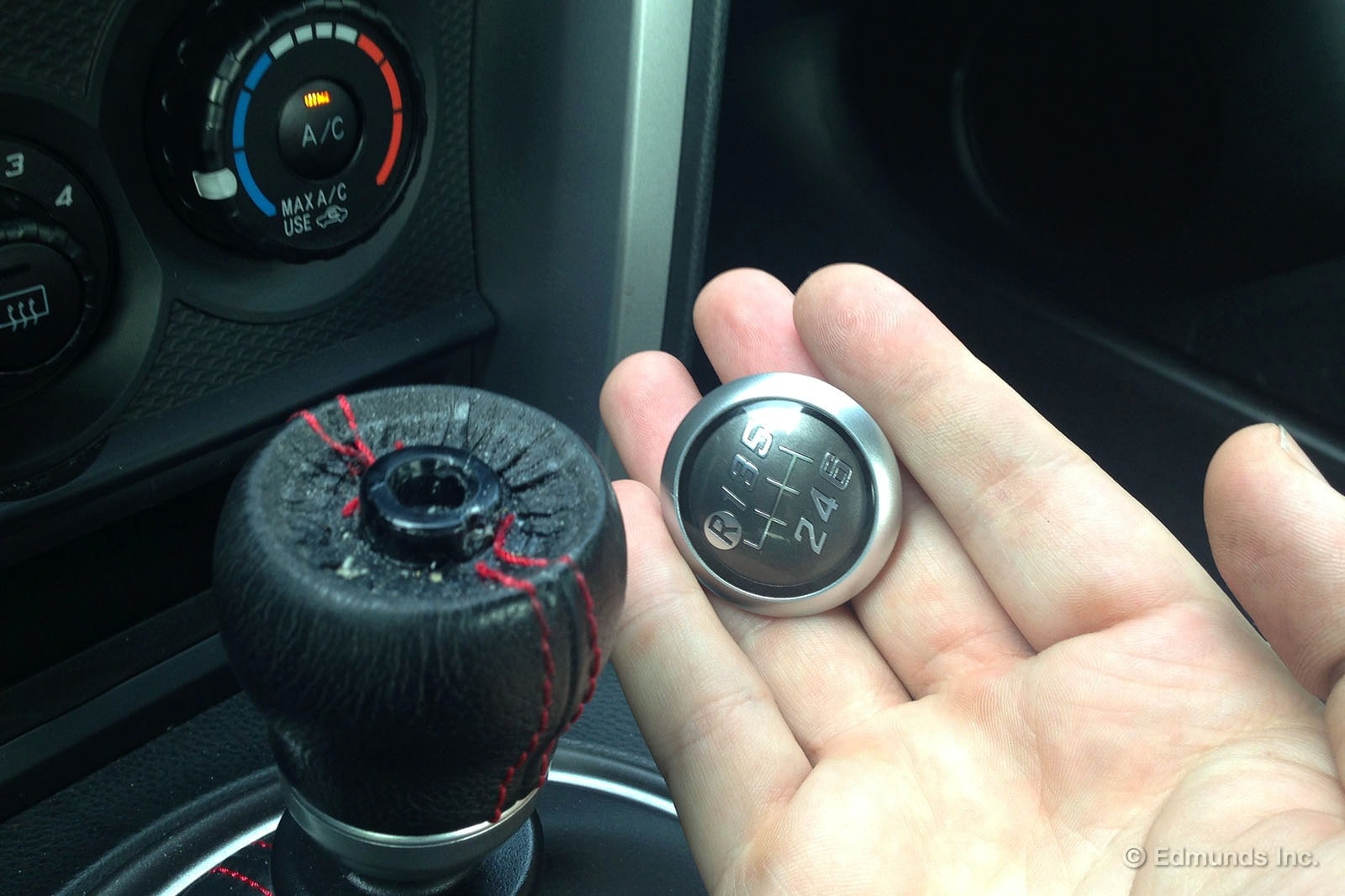
I guess this is what I get for short-shifting the Scion from 1st to 2nd with only my index finger. The corner of my finger interacted with a raised section of this stupid little button that used to be on top of our shift knob and sent it flying.
It doesn't go back on anymore. Time for an aftermarket solution.
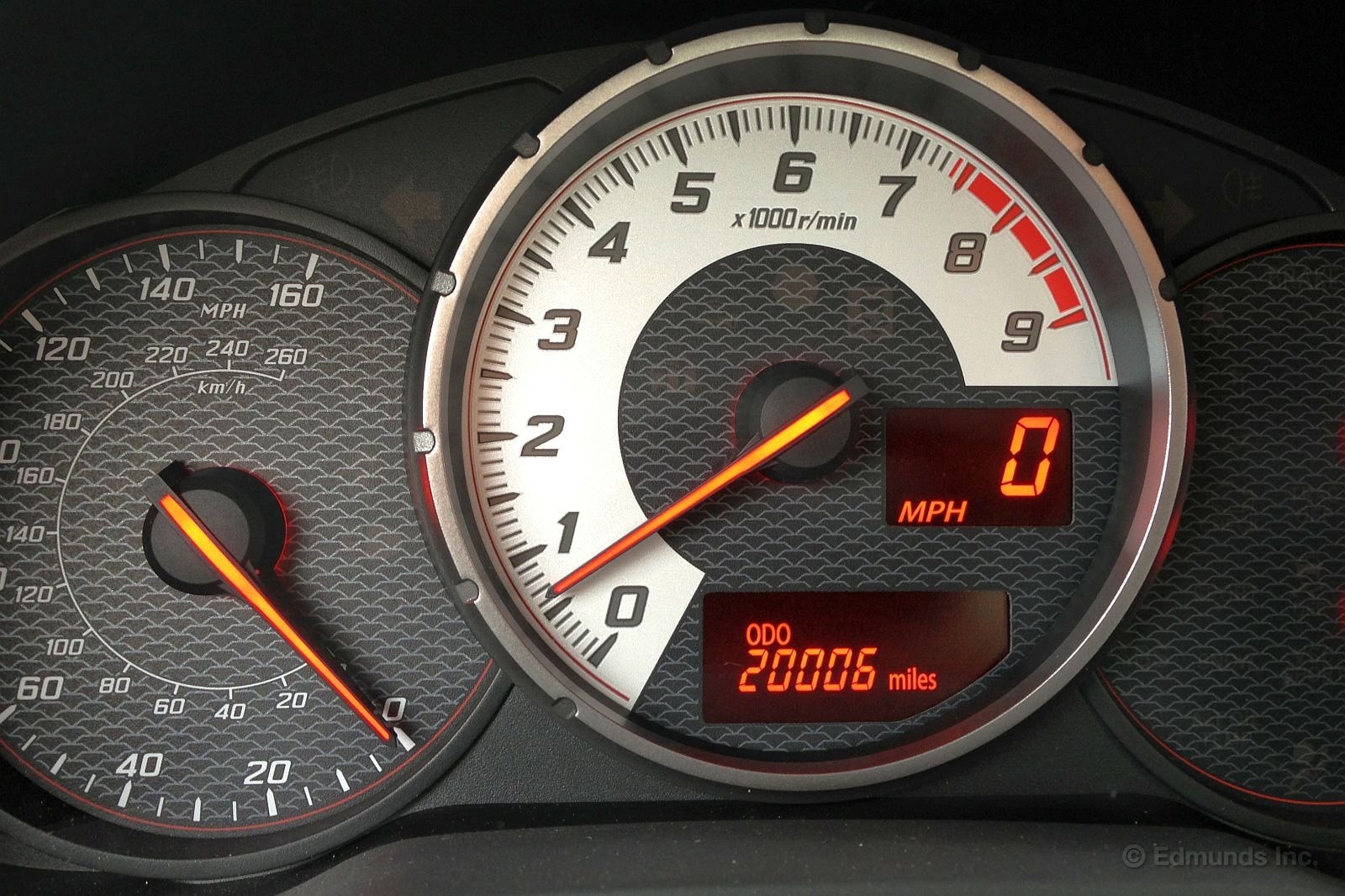
Even though we've reached the 20,000-mile mark with our 2013 Scion FR-S, it's almost like a new beginning. Why? Because, as JayKav recently wrote about, the little rear-drive canyon carver now has a supercharger, thanks to Innovate Motorsports.
As far as how the car itself is holding up, it's doing well.
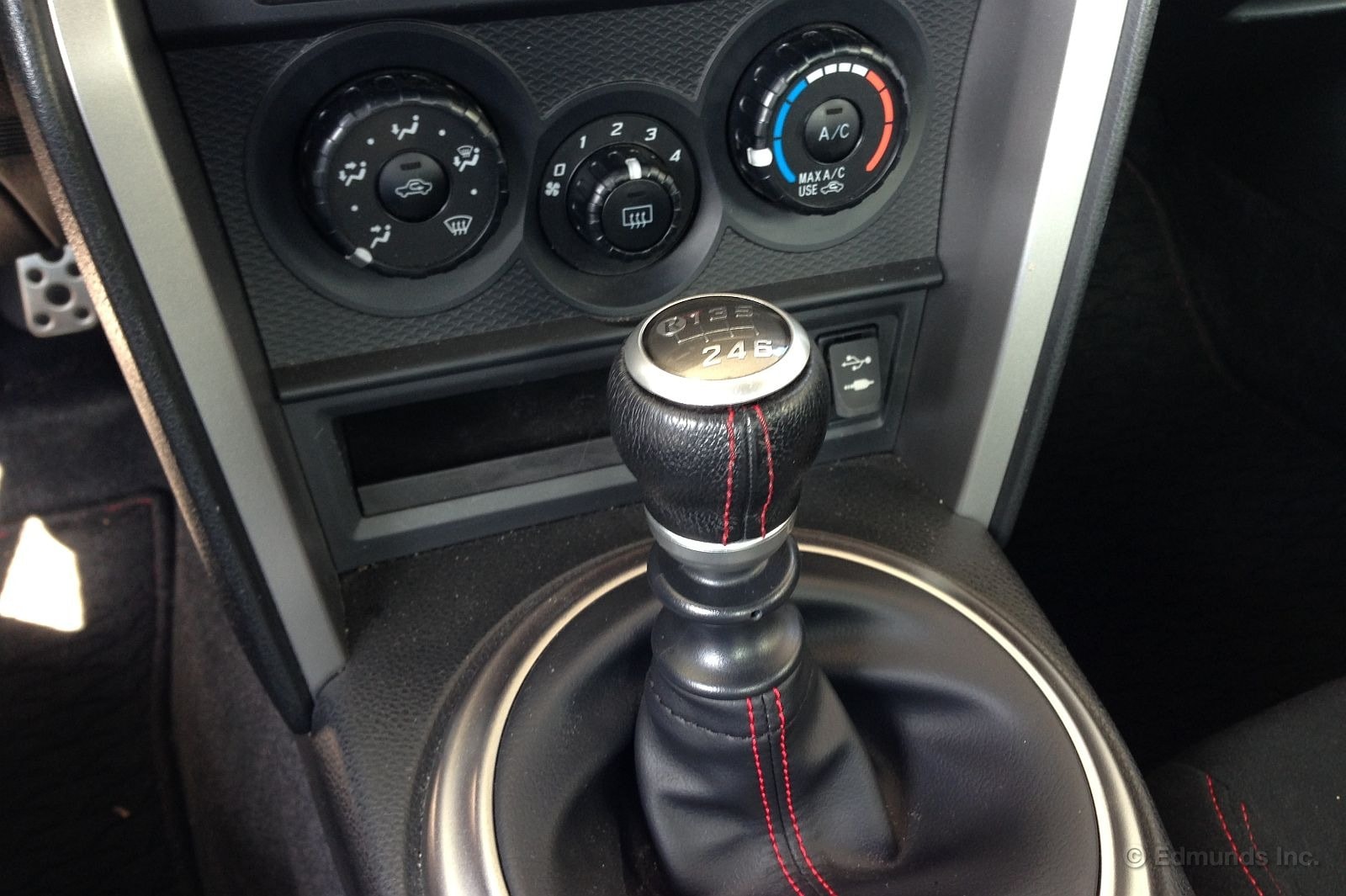
The interior has a few scuffs here and there on some of the hard plastic bits, but that's more our fault than the car's.
The only real problem with our FR-S is that the shifter cap continually feels like it wants to pop off.
But right now, we're more concerned about enjoying the car's newfound power.
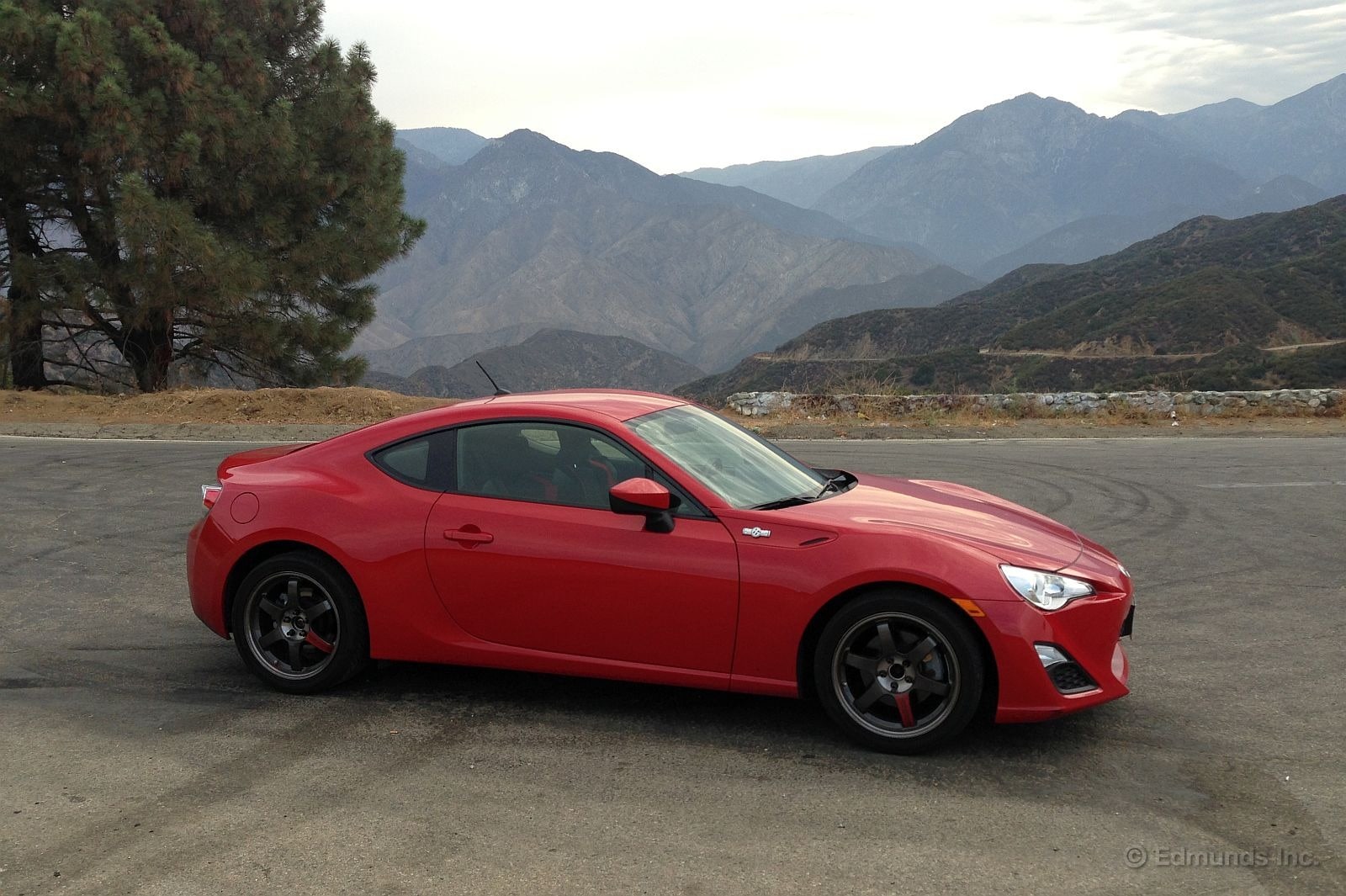
Our 2013 Scion FR-S has a supercharger.
I already liked this corner-carving machine before. It's superbly-balanced with spot-on steering and plenty of grip thanks to our long-termer's wider, stickier tires.
Now that it has honest power, everywhere on the tach, I like it even more.
I took the FR-S forced-induction edition on one of my favorite twisty bits of pavement (Glendora Mountain Road) over the weekend. It was a blast.
The Innovate Motorsports supercharger doesn't pack on so much zip that it completely changes the FR-S. Rather, it better taps into the fantastic abilities of its chassis.
And it means when you exit a low-speed corner, powerslides are easier to come by. I'm gonna go out on a limb here and wager that we're going to start burning through rear tires a lot more quickly.
Somebody, give Engineering Editor Jay Kavanagh a double high-five for (finally) making this happen.
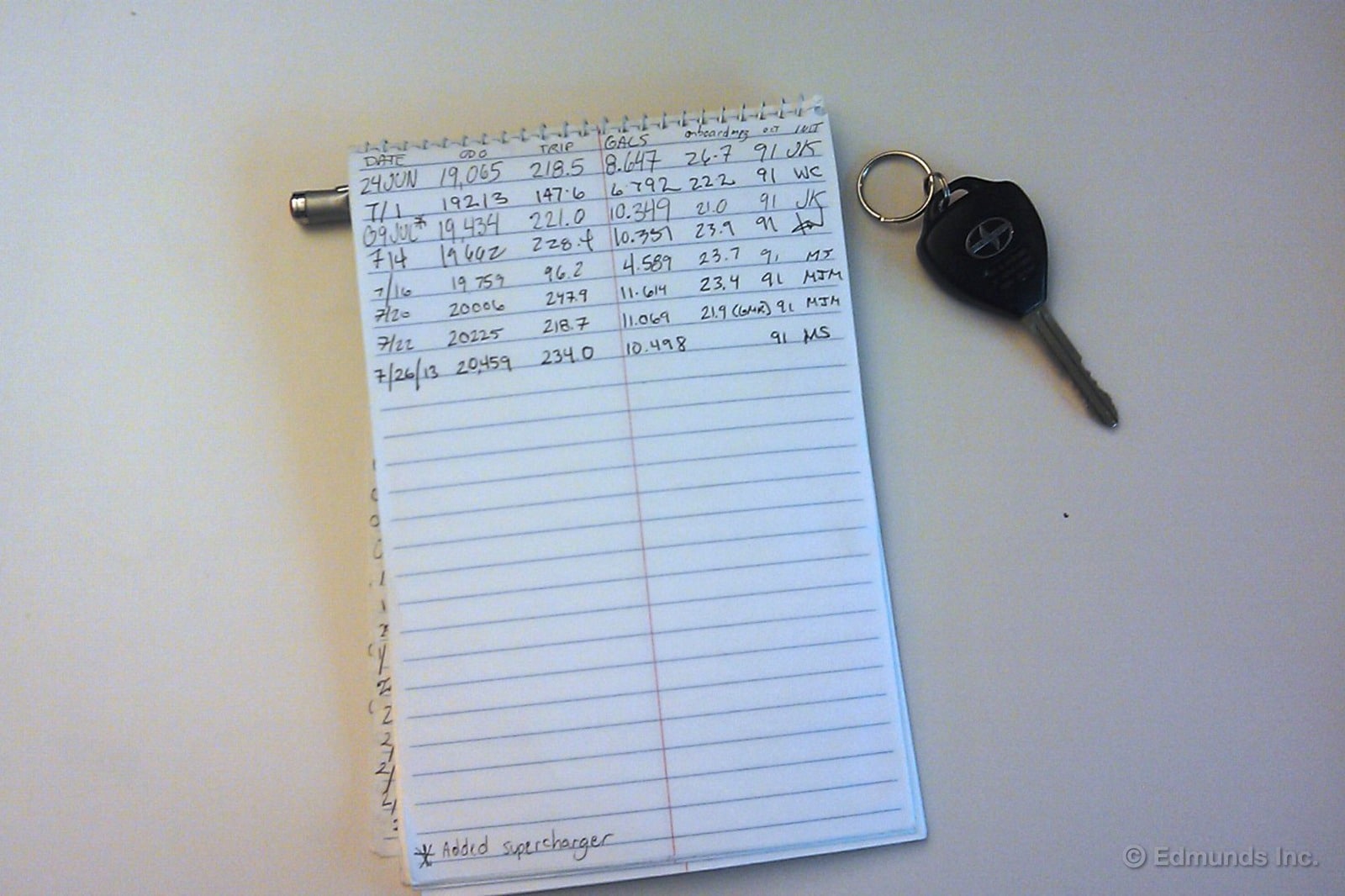
In July we installed a supercharger kit on our long-term 2013 Scion FR-S project car.
Since then, we've added 1,246 miles to its odometer using 66 gallons of 91-octane fuel. We retested it, re-dyno'd it and passed the 20,000-mile point.
We averaged 21.36 mpg during July and dropped our overall lifetime average by two-tenths of a point.
Worst Fill MPG: 16.9
Best Fill MPG: 30.0
Average Lifetime MPG: 23.8
EPA MPG Rating: 25 Combined (22 City / 30 Highway)
Best Range: 335.1 miles
Current Odometer: 20,459

After we dyno-tested the Innovate Motorsports supercharger kit now installed on Project FR-S, we made another visit to the test track to run acceleration numbers.
Here's the rundown for those that click straight through to the long-term updates and missed it on our landing page.
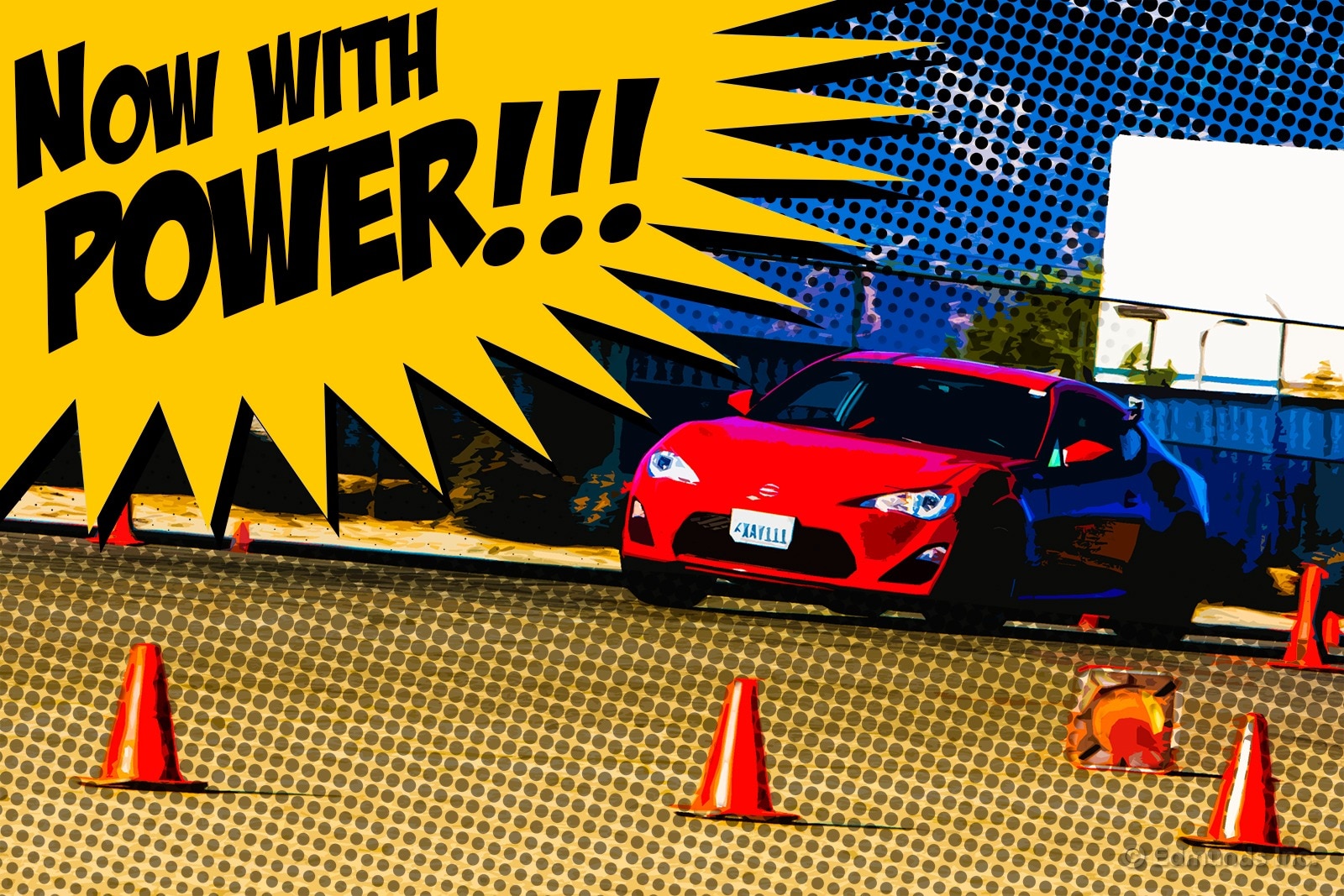
Anyone following our long-term 2013 Scion FR-S will know that I was a fan of its overall performance from day one. Yes, I realize the engine was unimpressive from a numbers standpoint, but it was balanced with the rest of the car.
Then we added the stickier tires and the balance changed. It became quite a bit harder to get the tail to whip around in turns, and for me, that's where the fun was. Regardless of tires, the engine just didn't have the grunt to launch the car out of turns with the sort of aggression I crave.
But now...
Now with the supercharger.
Yes.
There's enough grunt to pray at the altar of oversteer. A short lift and tap of the throttle and the rear end points out of turns beautifully. The engine now has the ability to slide with the ease that it did in stock form, albeit at higher speeds.
Balanced has been restored to The Force.
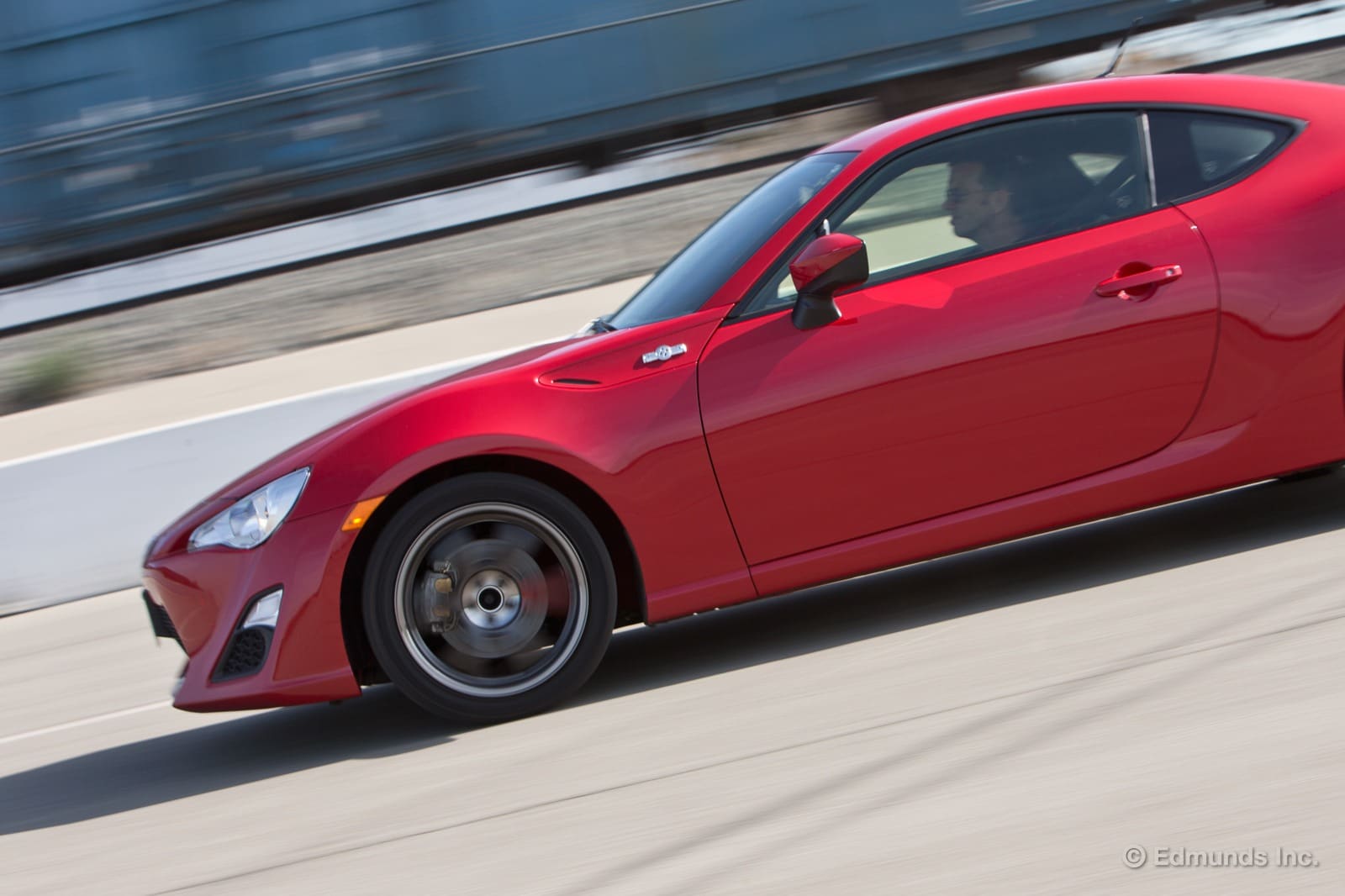
Recently, we tested the acceleration of our Innovate Motorsports supercharger-equipped long-term 2013 Scion FR-S. A handful of commenters seemed perplexed by the fact the 0-60 time didn't see an even-larger improvement compared to the baseline non-supercharged run.
As explained in the original Track Tested piece, traction was an issue. And when it comes to 0-60 times, traction is king.
When we tested the FR-S against the Veloster Turbo a while back, I reckoned that each car had an asterisk next to their 0-60 times, for opposite reasons. The upshot is it's easy to get a dismal 0-60 time in a stock (or stockish) FR-S. The technique that delivers the best result involves revving the beejezus out of the engine, finessing the clutch just so, and spinning the tires almost all the way through first gear, making sure not to spin them too hard because that hurts the number. Oh, and don't forget: You have two gear changes to nail in the process, so don't muff them.
Get any of the aforementioned facets wrong and the FR-S's 0-60 time worsens dramatically. Never mind that it's an exercise that few will ever attempt in the real world, and those that do will it find difficult to execute properly in order to match our published numbers.
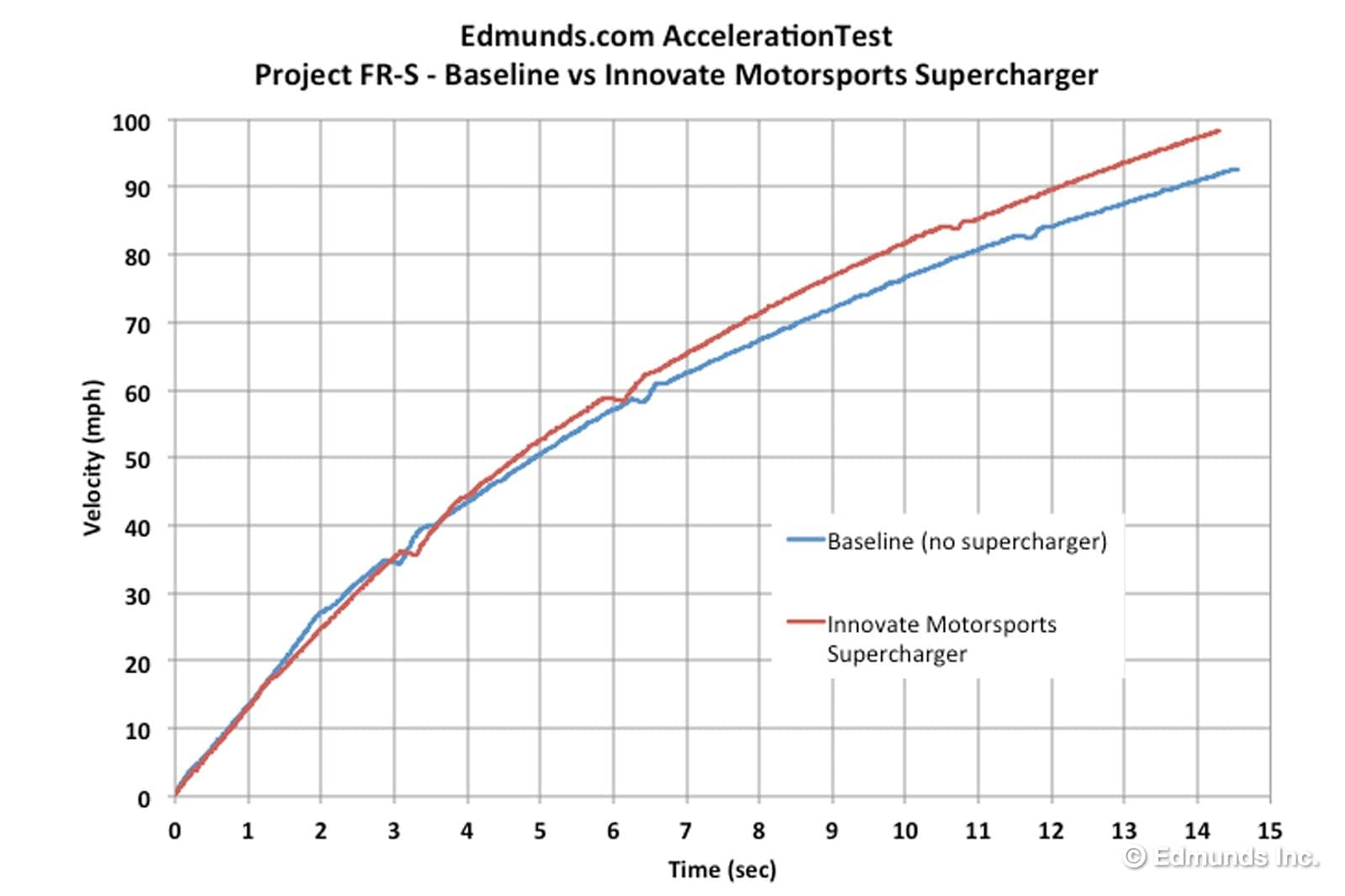
Real-world, around-town acceleration is arguably better represented by a yardstick that's not so sensitive to traction. With that in mind, I parsed through the acceleration data, before and after the supercharger, to glean 30-50, 50-70 and 70-90 mph times:
FR-S before supercharger:
30-50 mph: 2.6 sec
50-70 mph: 3.6
70-90 mph: 5.2
FR-S with Innovate Motorsports supercharger:
30-50 mph: 2.2 sec
50-70 mph: 3.1
70-90 mph: 4.3
See the difference now? Whereas the 0-60 time only improved by 0.2 seconds with the supercharger, much, much larger improvements are observed among acceleration metrics that don't hinge on launch traction and technique. These are the kinds of improvements that are readily apparent every time you lay into the throttle of our supercharged Project FR-S.
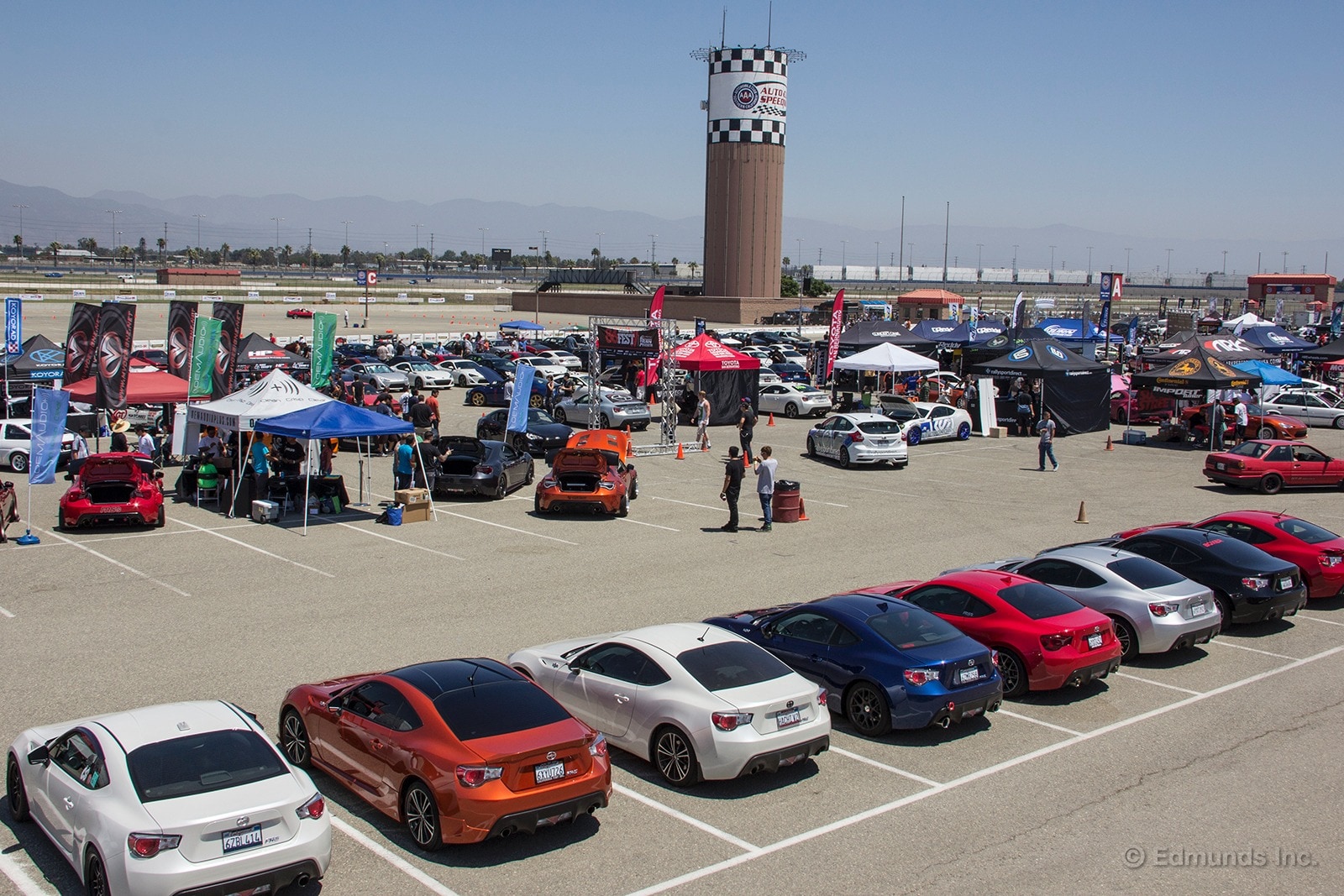
Half the fun of owning a car like our long-term 2013 Scion FR-S is taking it to car shows. This past weekend was the second annual 86fest in Fontana, California. Our FR-S was displayed with several other supercharged cars, all boosted by Innovate Motorsports and it was a great opportunity to meet some fellow gearheads and talk shop.
I arrived bright and early, and wiped down the FR-S as the Innovate guys set up their booth.
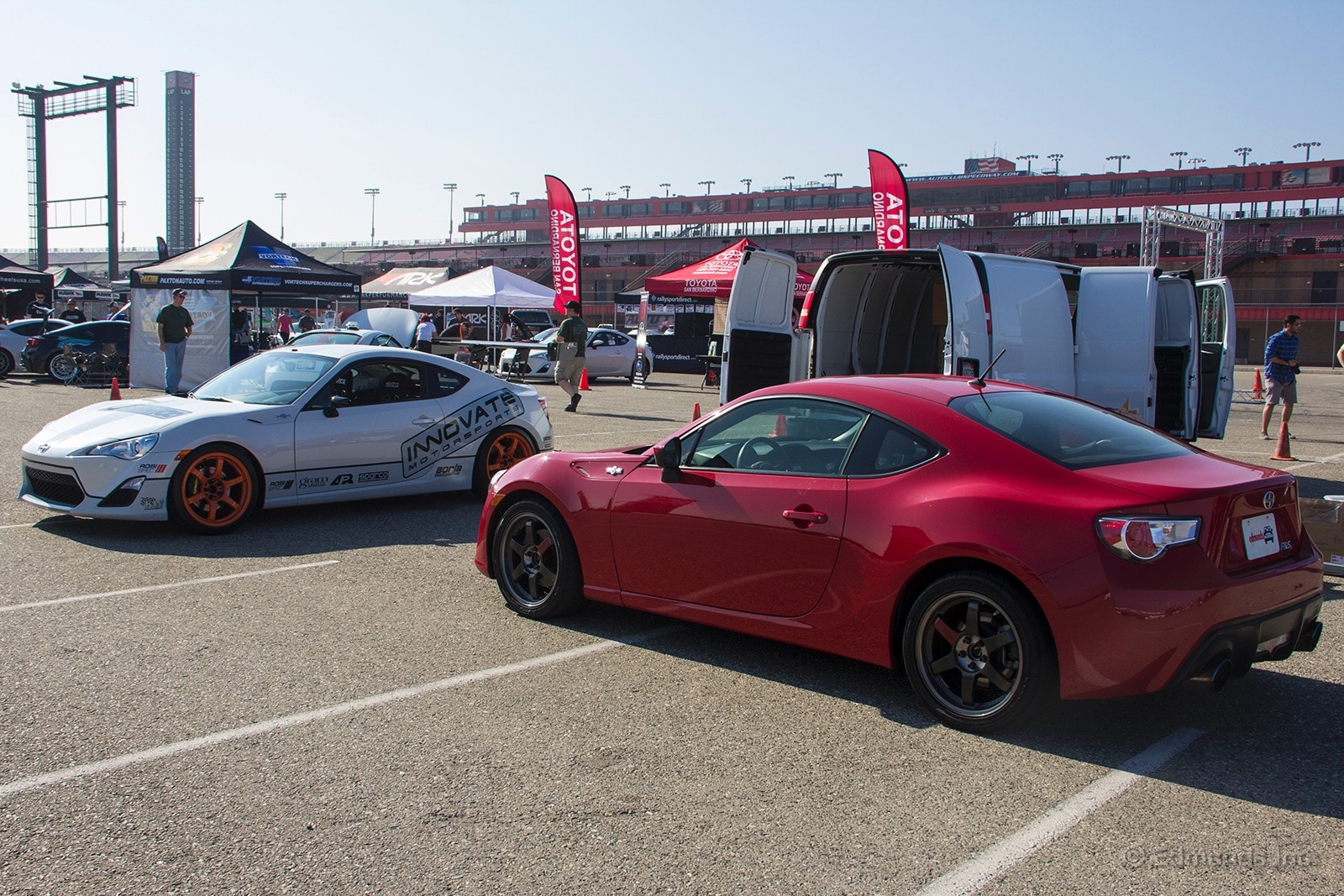
They unloaded an FR-S motor and did a quick bolt-on of their supercharger to display before the show started. This was an instant reminder of how simple it is to install the supercharger. With no jack stands, no need to pull the motor, and nothing more than a decently equipped toolbox, any FR-S owner with basic engine knowledge could install this on a Saturday afternoon in their home garage. A variety of AE86, FR-S and BRZ owners were in attendance with modifications ranging from basic wheels and tires, to full wide-body kits and plenty of function-over-form dedicated autocross cars.
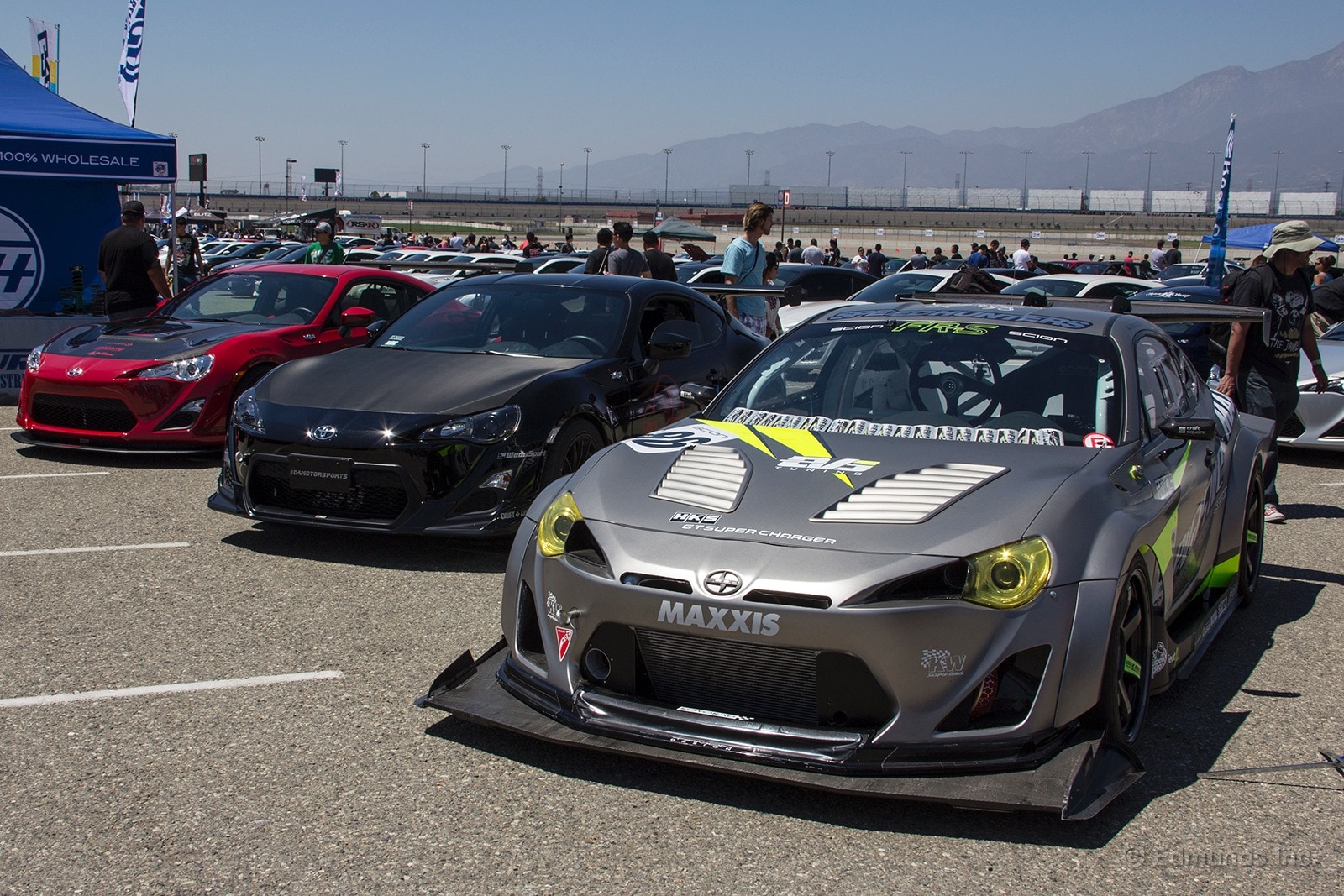
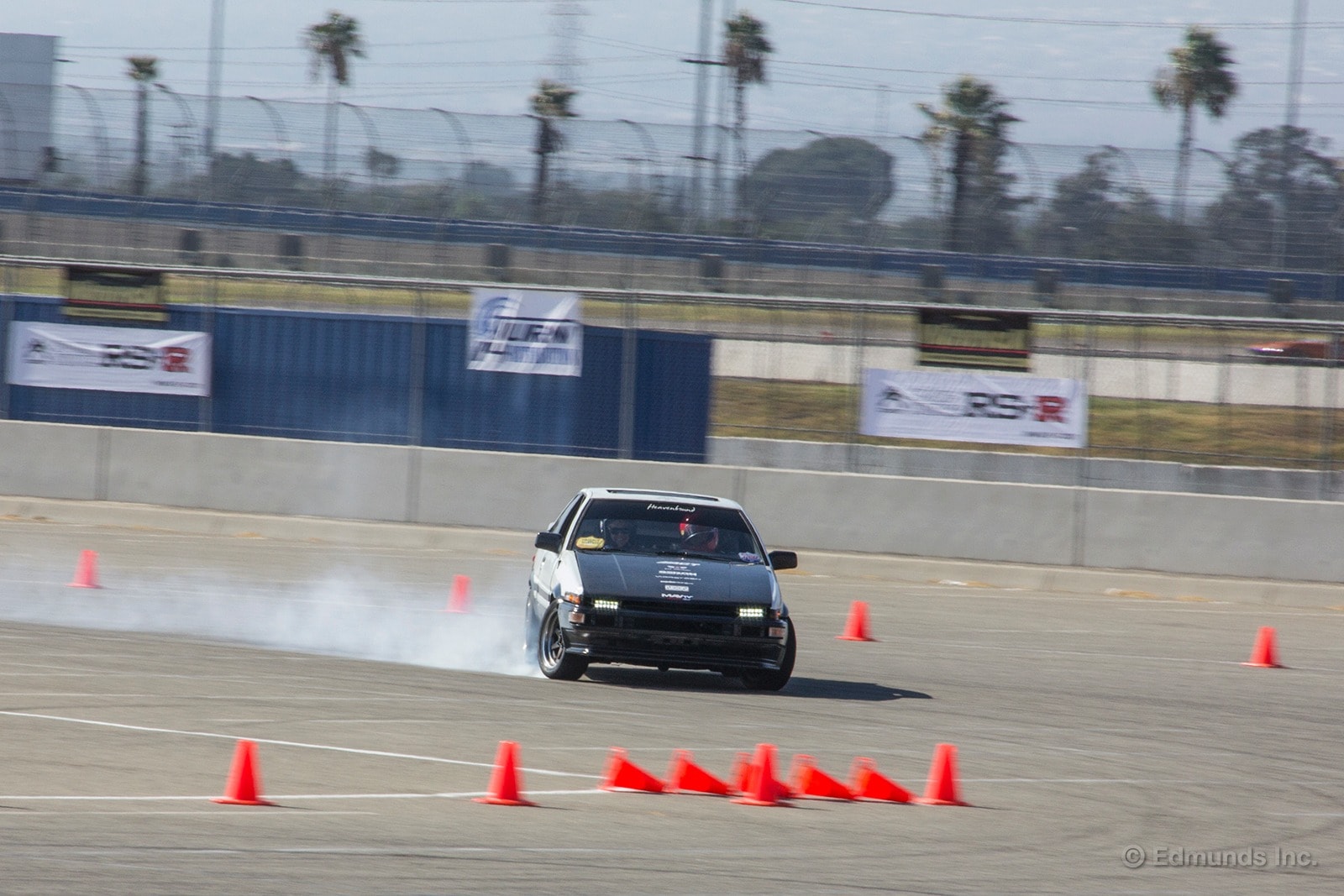
For photos of the event, check out my full Google+ album here.
Twelve months ago I left the inaugural 86fest feeling underwhelmed. Aftermarket companies had tried to develop parts as quickly as they could, but there just wasn't enough time. A year ago there were no decent options for power increases. This year was an entirely different story. The aftermarket production was in full swing on this car and it proved (to me at least) that new cars don't have to be boring to succeed. Instead of appealing to the masses by being toned down and reserved, new cars can be exciting while also being practical and comfortable.
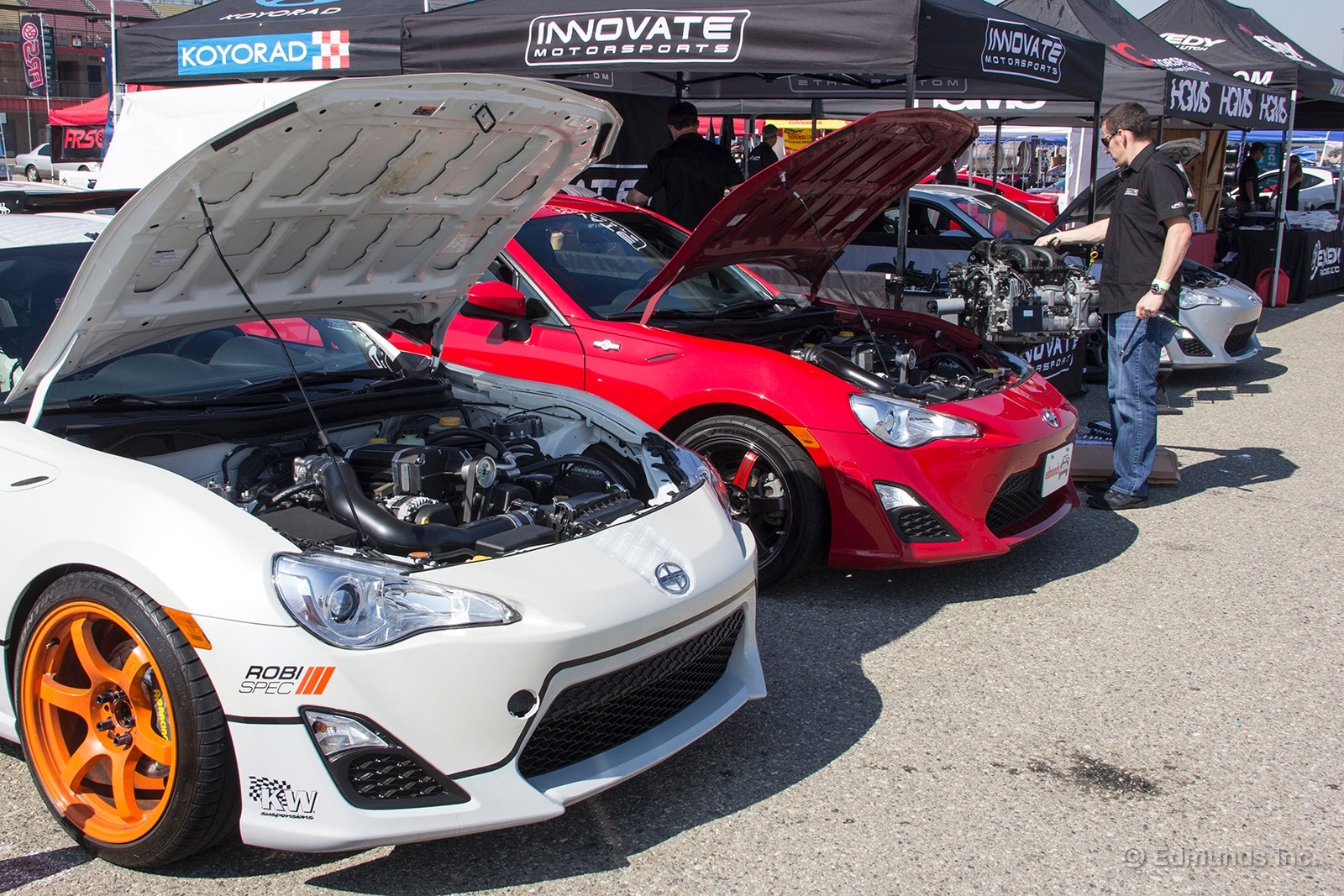
An autocross event, food trucks, raffles, posing models and product sales filled the day and I even tossed a few revs at the crowd so they could hear the supercharger whine for themselves. When the day was done, I packed up the FR-S and helped break down the Innovate booth. Even with some extra bags from a hotel stay the night before, lots of detailing supplies, and my tendency to overpack, the Scion's trunk had room to spare.
This year I left 86fest with a sense of encouragement. It confirmed that aftermarket modification isn't a dying art. It is still alive and well.
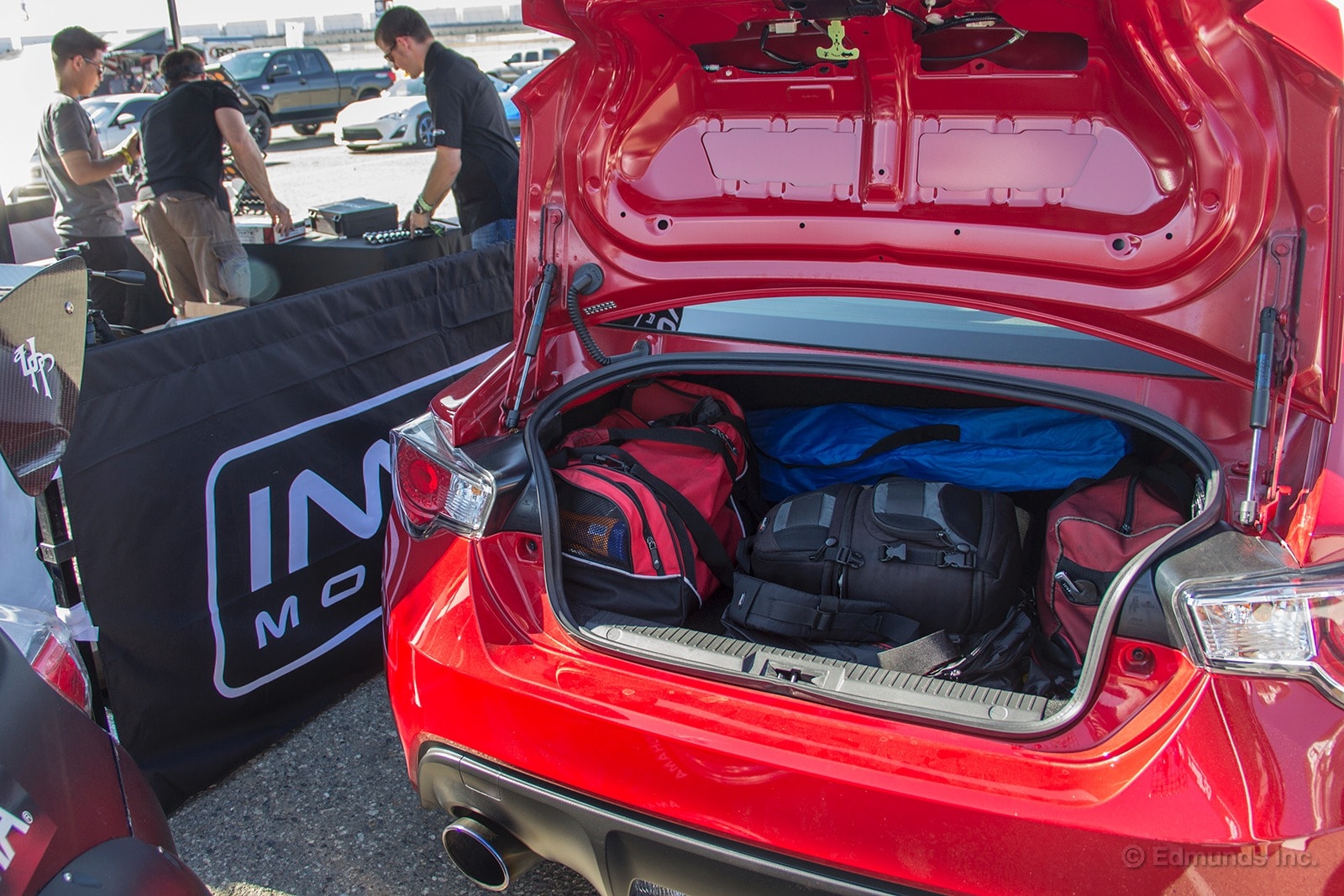
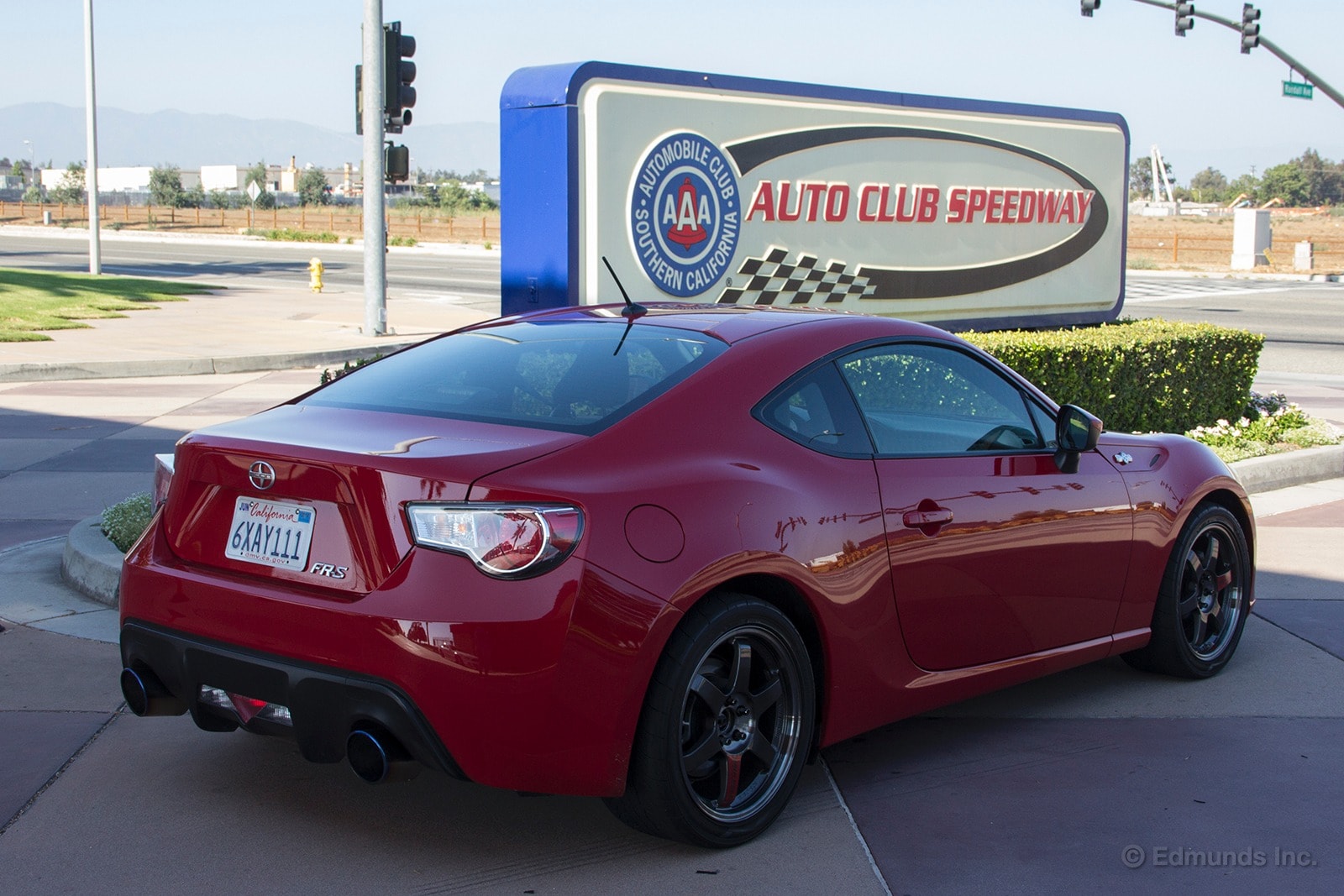
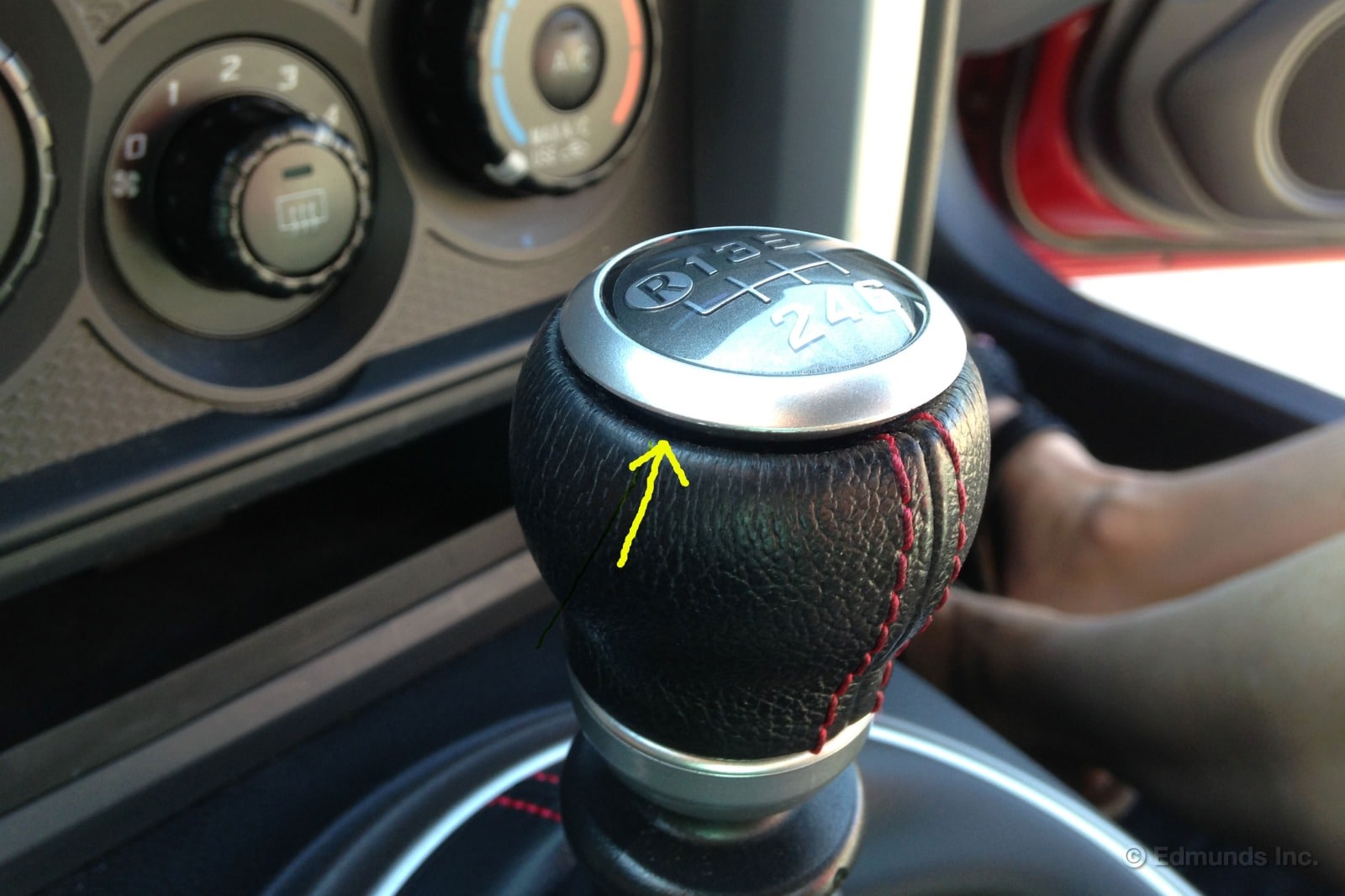
I have no idea how Magrath managed to break the top off our Scion FR-S's shifter with only one finger, but now there's a big gap between the top cap and the rest of the shifter. No amount of pounding will make the top cap sit flush with the rest of the knob, either. It might not seem like much, but that little gap between the leather and the plastic hurts.
The FR-S's shifter is precise and direct and because of those qualities it demands deliberate motions to select a gear. Deliberate motion means I push on the thing with purpose. And it hurts jamming my hand into that gap.
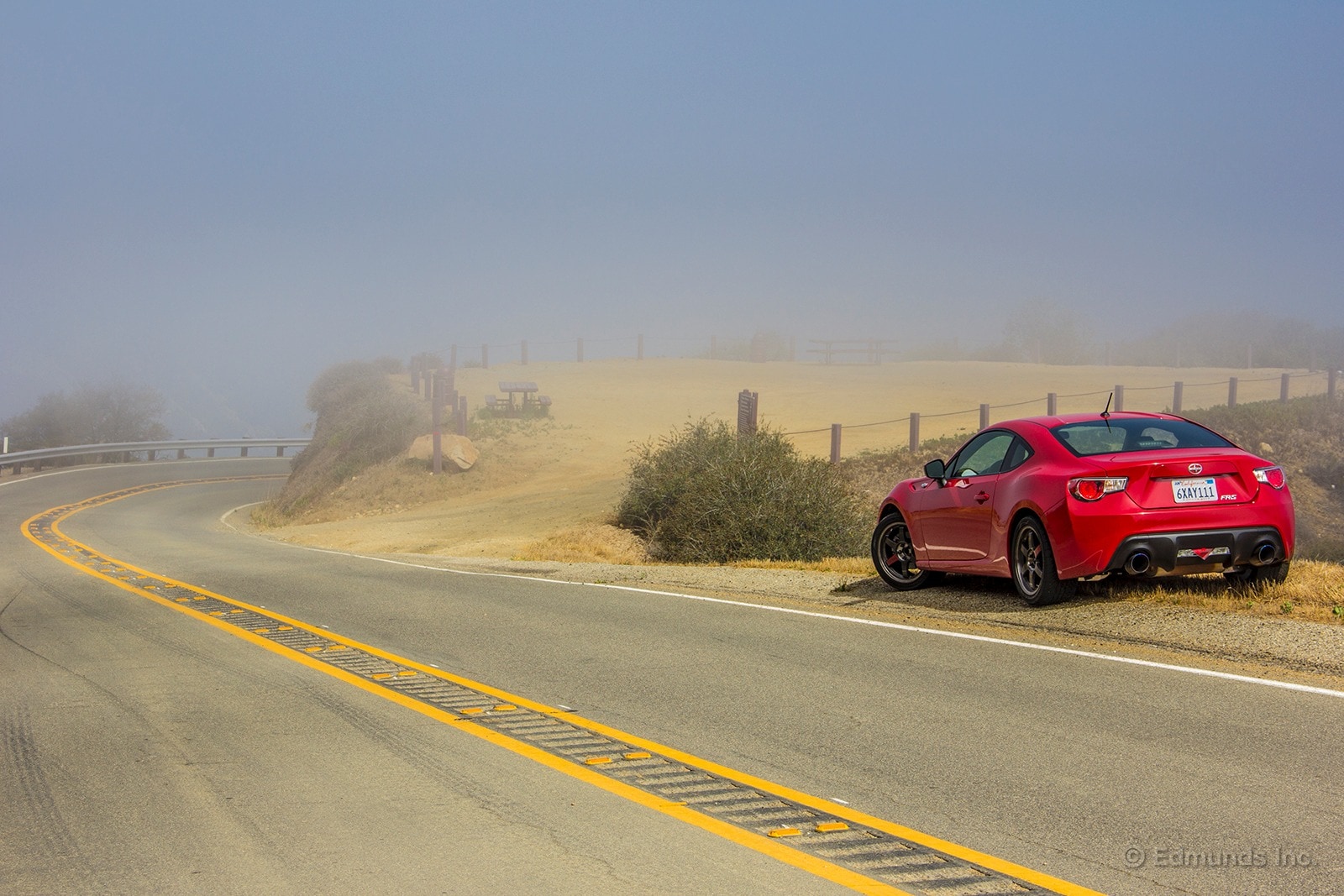
I don't usually get out of bed before 10:00 a.m. on Saturday mornings, at least not on purpose. I like recovering from the week, letting the sun leak in through the blinds and generally getting a soft start to the weekend. But last Saturday I was up early and devouring all the caffeine in sight. I had our long-term 2013 Scion FR-S and plans for a drive through the local canyons.
Typically, I'll take my personal car out with a group of Acura Integra owners (you'll recall that I'm an Integra owner, too). We'll meet up at a gas station, talk, grab a snack, check our oil levels and head out for 100 miles of back-road shenanigans. Of course, the FR-S was also built for exactly this activity.
With the supercharger, camber plates, exhaust, lightweight TE37SL wheels and Yokohama Advan AD08 tires fitted, our FR-S is now sublime on my favorite roads. Rolling over the back side of the Santa Monica mountains, the marine layer dissipated and turned into rolling clouds down the hillside. The exhaust on the FR-S wasn't audible (even with the windows down) but the whine from the supercharger was, especially at wide-open-throttle.
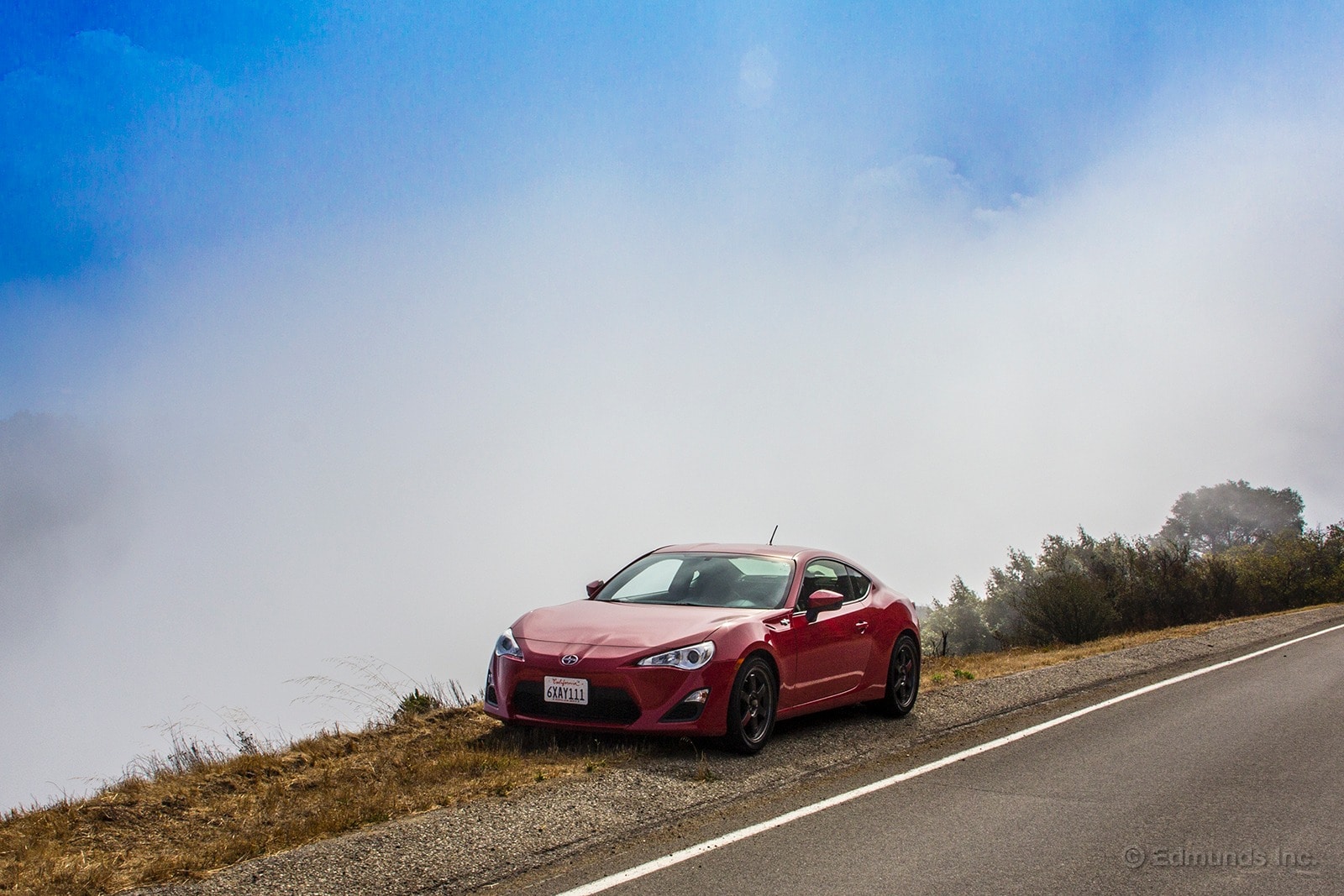
As soon as late morning hits, these roads become spillways for the nearby beaches, flooded with carbon-fiber 10-speed bike enthusiasts, tourists on rented Harleys and full-size vans with text-messaging drivers, but my alarm clock and some determination helped me avoid the crowds.
With a cool ocean breeze around every corner and the Scion's newfound power, it felt like a holiday weekend. Although the FR-S works really well as a daily driver, these glorious mountain roads filled with their long, sweeping bends, tight corners and breathtaking views call out to me every time I drive it.
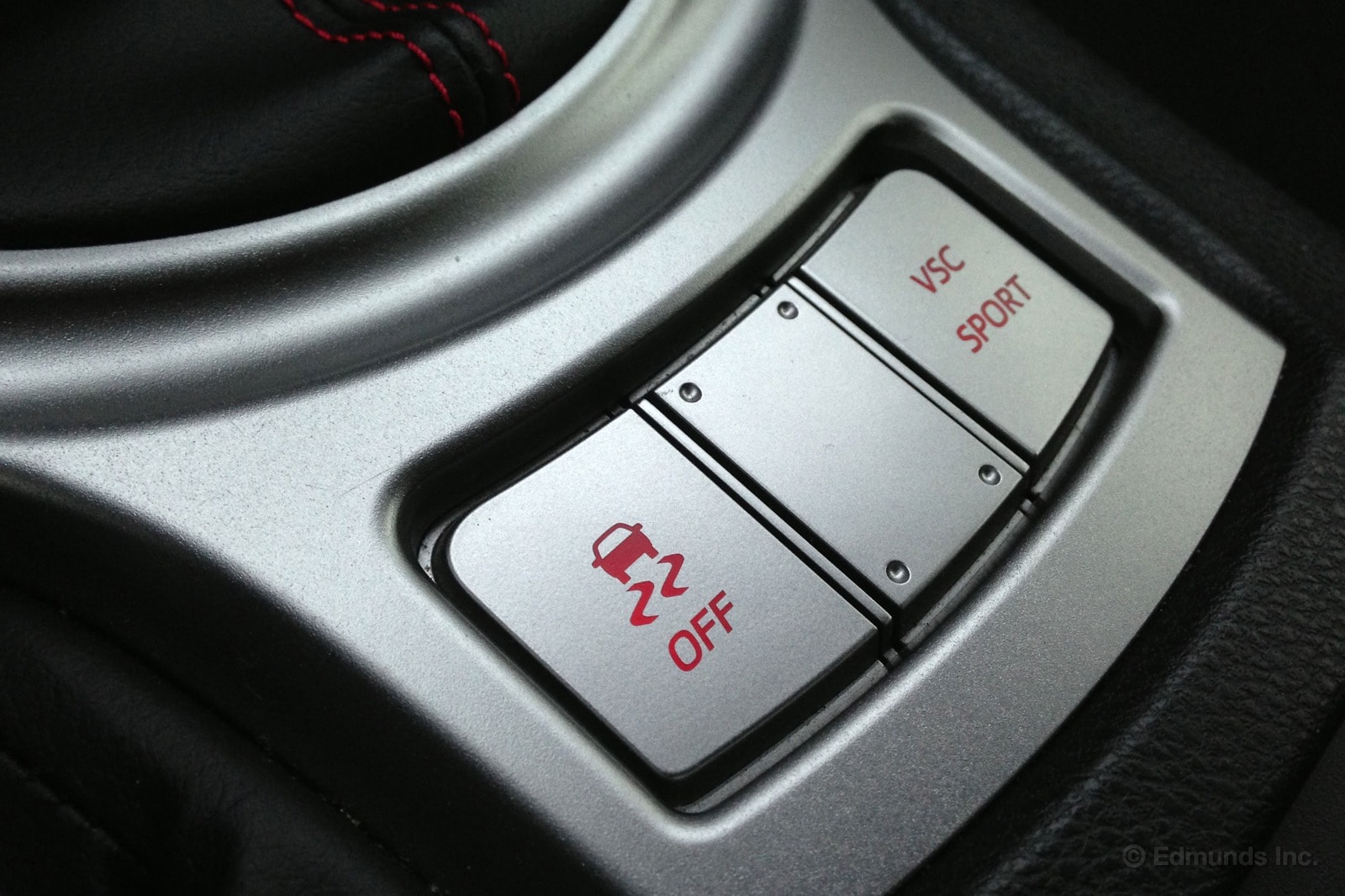
As our acceleration testing indicated, the Advan Neova rubber on our 2013 Scion FR-S is sufficiently heat cycled to have lost much of its grip. Let me clarify: Those tires are fried. The tread isn't gone, but a little fingernail investigation reveals that they're rock hard, which doesn't make for good grip. In addition to slowing straight-line acceleration, lateral grip is compromised.
Combine the reduced lateral grip with a torque-abundant power delivery and the FR-S can be a little exciting in the most normal of situations. I find stability control to be a faithful partner now. Even routine low-speed moves, like turning through an intersection and making the 1-2 shift, regularly turn into a slide caught by stability control. Honestly, it's a little unnerving. Tires, it turns out, really matter.
Part of the issue is a throttle calibration that's not spot on, but I'd bet better grip will largely resolve the problem. Fortunately, I see some new BFG rubber under Jay Kavanagh's desk.
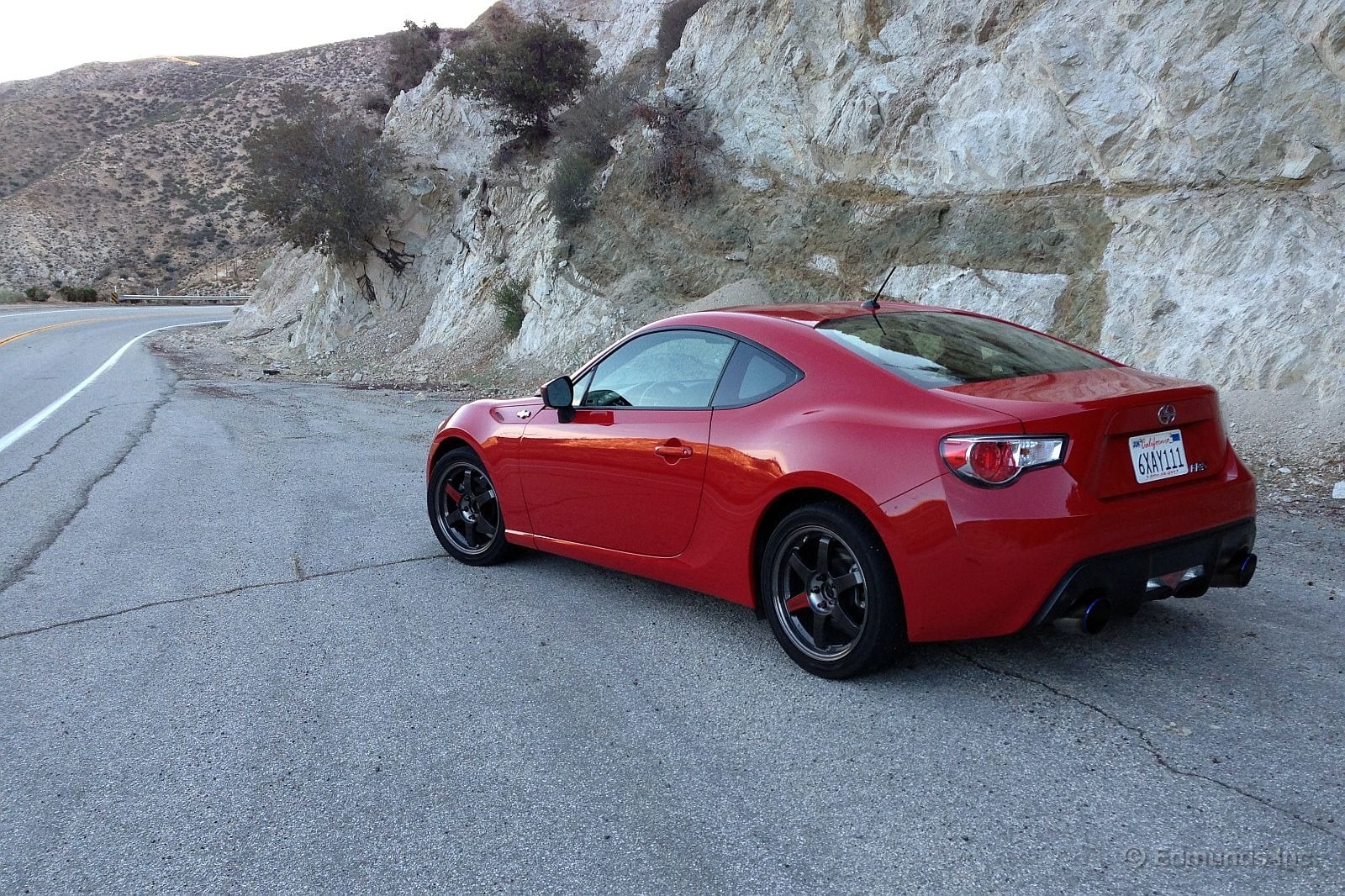
I had to get to Streets of Willow in Rosamond, California from Orange County last week for our Corvette C7 versus the world test. I had the 2013 Scion FR-S, with supercharger, at my disposal to get there.
So, of course, I took Angeles Crest to Angeles Forest to get to Highway 14 North. Any other route would've been boring.
The extra power from the Innovate Motorsports supercharger made the drive up Angeles Crest much more interesting than it would've been in stock form. Uphill on mountain roads was never the car's strong suit, and that has largely been rectified.
But the supercharger install has brought on some low-speed drivability issues. The kind of issues that when you're at full song, you never, ever notice.
It's mostly just at takeoff from a stop. There's some occasional jerkiness to the throttle delivery as you get going, and it can make the FR-S hard to drive smoothly.
I imagine with a little work this can be tuned out. Plus, it's not enough of a nuisance to make me want to stop driving this car.
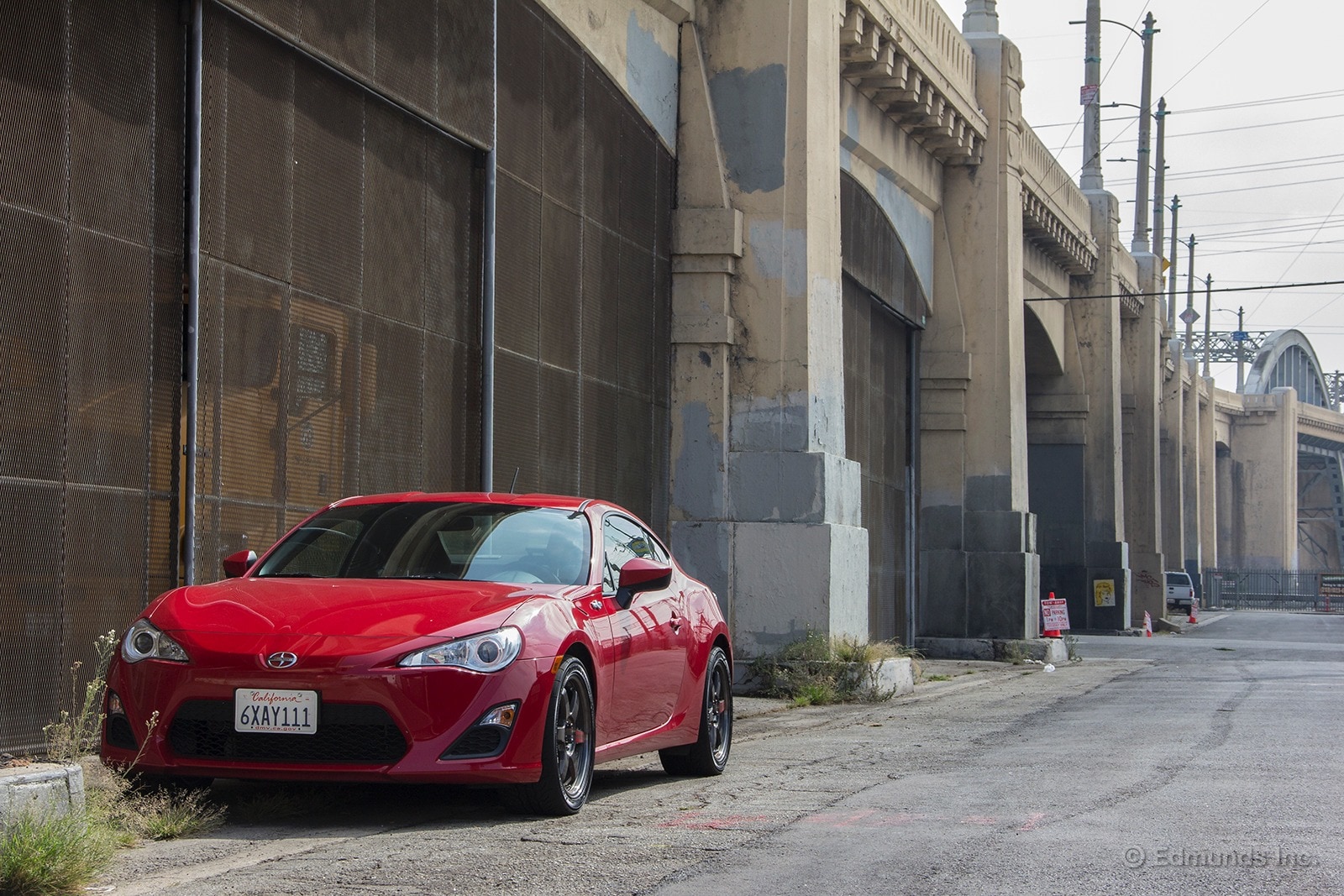
When my friend and Edmunds.com coworker Don Swertfeger asked if I could check out a second-hand cafe-style motorcycle with him, I happily obliged. I lent my moral support and helped him do a bit of price haggling, too.
After inspecting the bike, I looked around at the drab, muted, urban landscape of Downtown L.A. and saw a perfect contrast for our hot lava red 2013 Scion FR-S. Here are some of the shots.
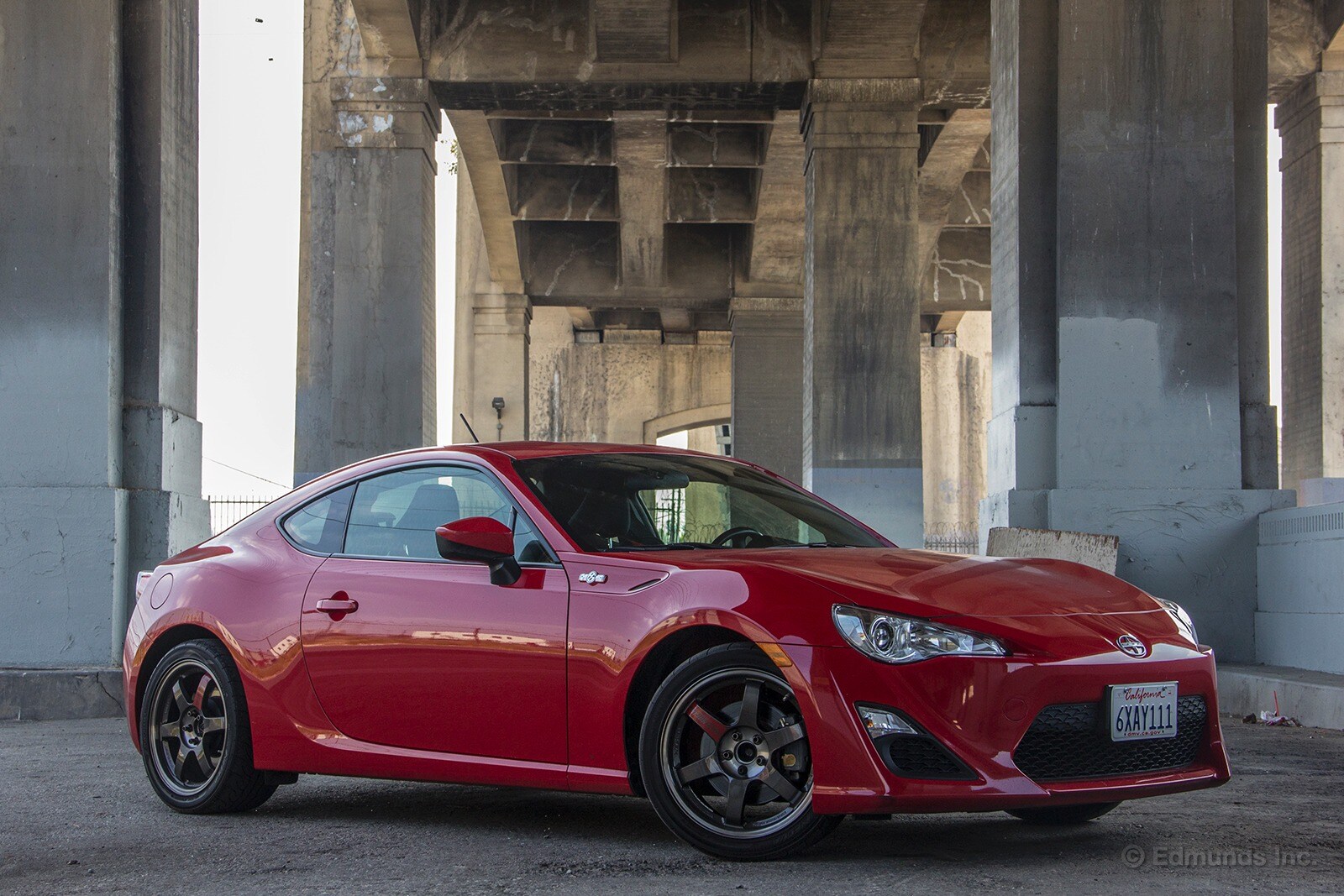
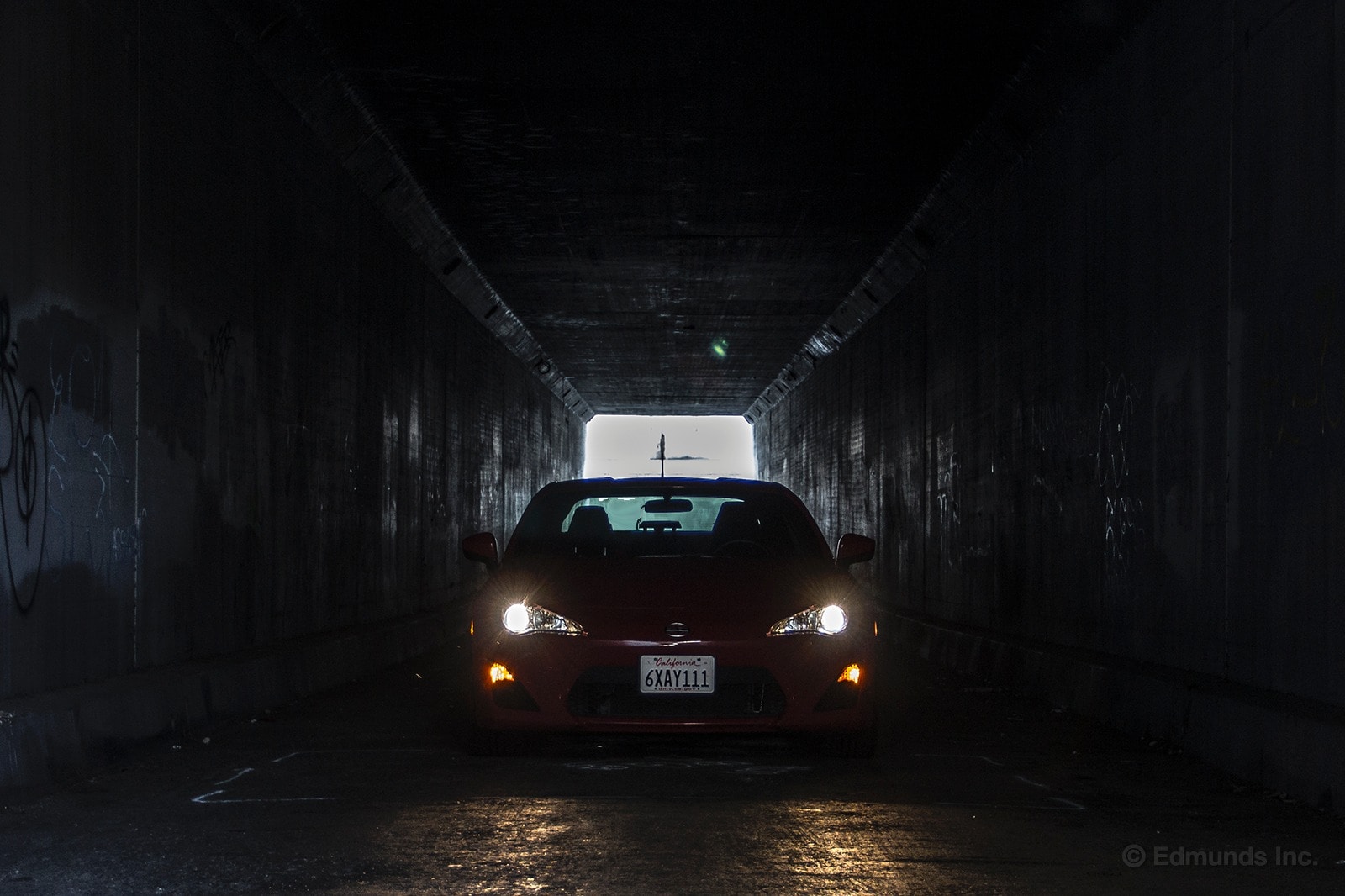
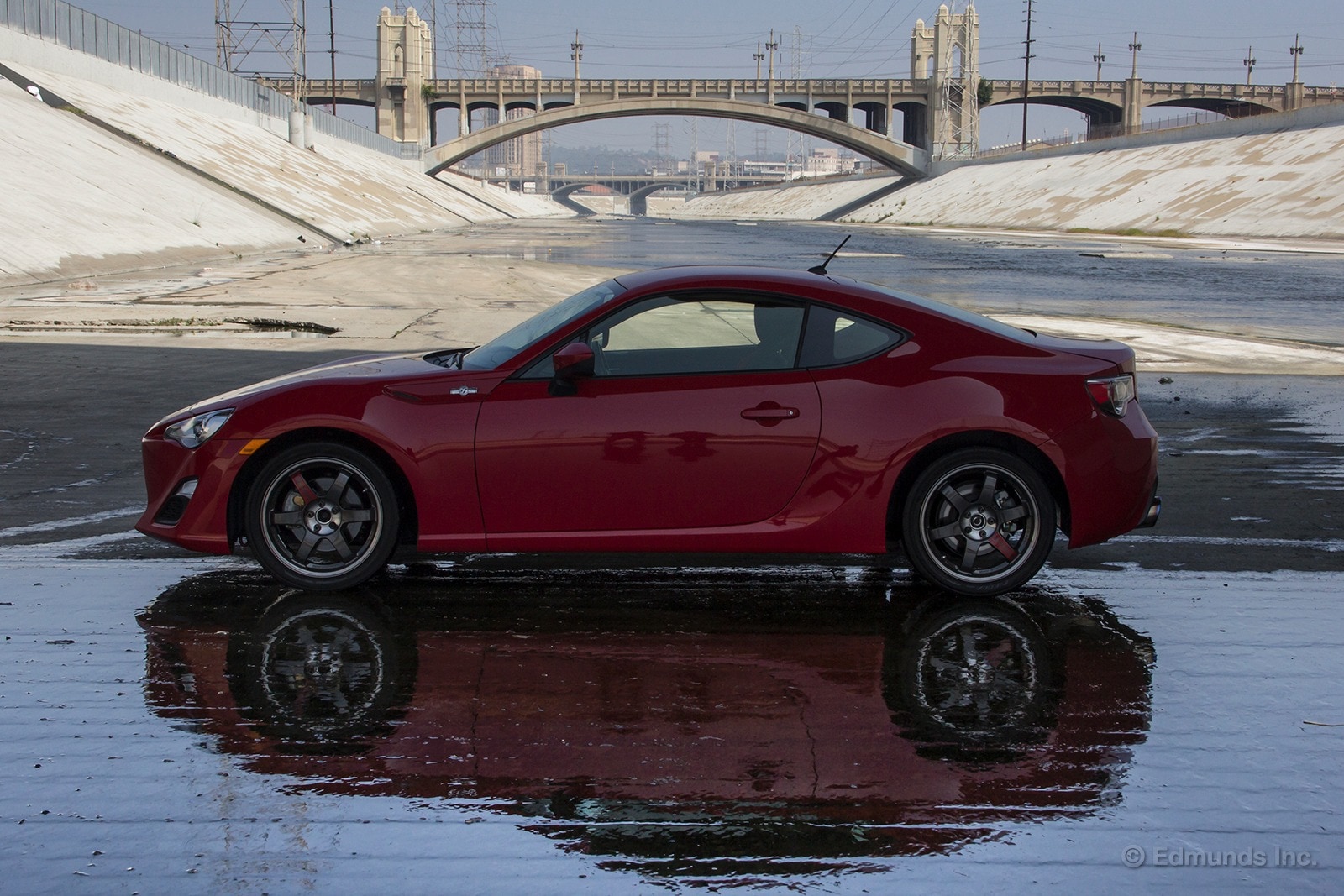
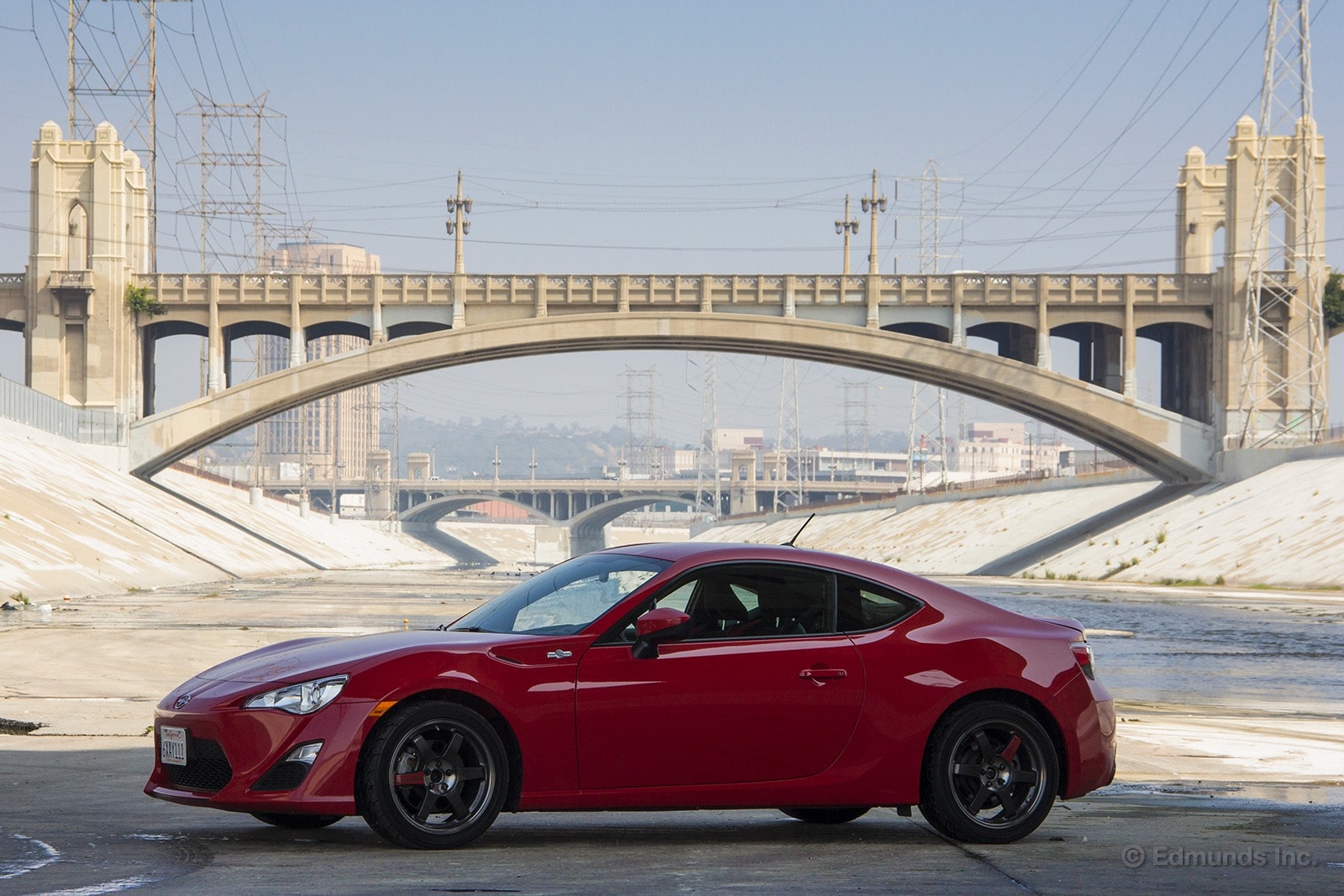
The FR-S is one of the best looking cars in our fleet and one of the coolest designs on the market today.
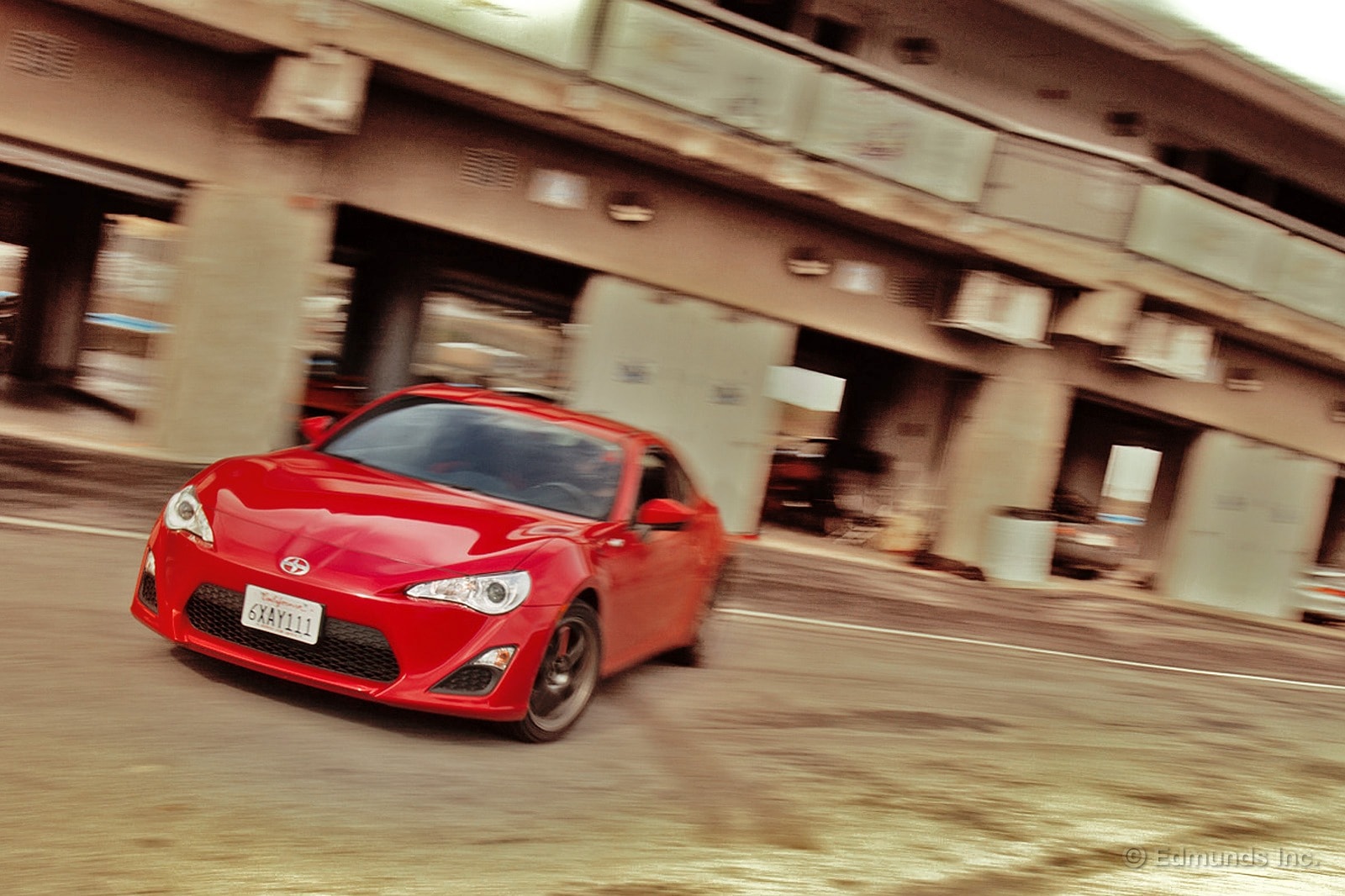
Thirty days and over 1,200 miles later, it's time for another fuel economy update on our 2013 Scion FR-S. Now with more lolz, courtesy of the Innovate Motorsports supercharger, our Scion is being driven harder than ever. How did the fuel economy fare/suffer?
It's getting the mileage I'd expect from an enthusiastically driven FR-S. As always, your mileage may vary.
Worst Fill MPG: 16.9
Best Fill MPG: 30.0
Average Lifetime MPG: 22.38
EPA MPG Rating: 25 Combined (22 City /30 Highway)
Best Range: 335.1
Current Odometer: 21,867 miles
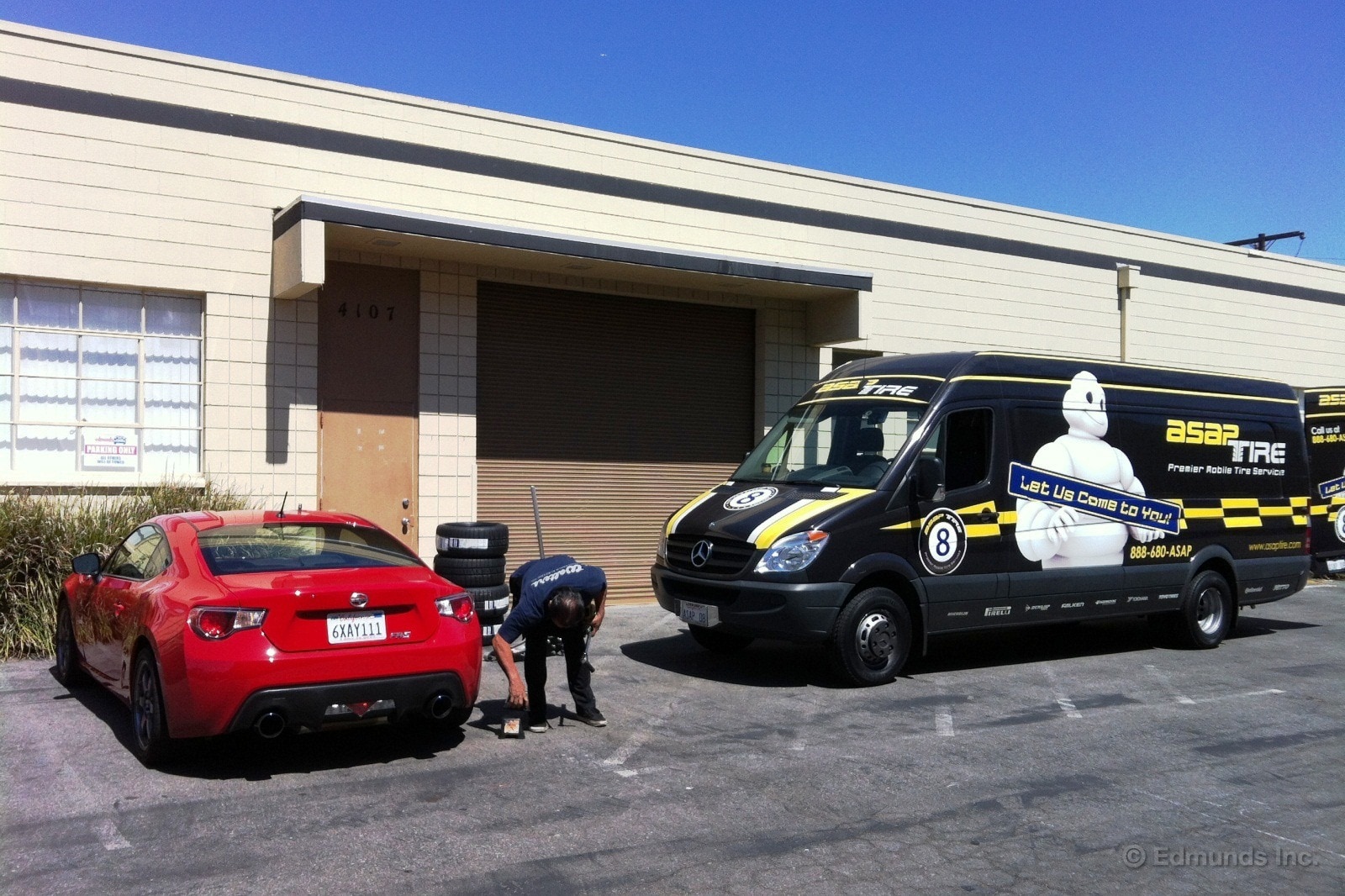
The old Yokohamas on our long-term 2013 Scion FR-S were heat-cycled to oblivion. They're being replaced by BFGoodrich g-Force Rivals, a relative newcomer in the category of high-performance summer tires. I've had previous experience with Rivals on another car and reckon they're a good fit for our Project FR-S, which is focused on being an effective dual-purpose street/track car.
For the FR-S I figured I'd give the mobile installation service of ASAP Tire a try. The idea of the tire installer coming to you just makes a ton of sense. ASAP Tire's process was simple: Schedule your preferred time and location online, and the truck comes to you to install your tires. As long as there is adequate clearance for the van's roof and a flat-enough surface, it's game on.
Our installer was friendly, knowledgeable and worked efficiently. Even arrived early. In less than an hour, our FR-S had its new skins mounted, balanced and the wheels torqued down, and the old tires hauled away. The price is pretty competitive with what you'd pay to have a regular shop mount and balance a set of tires and dispose of the take-offs, too. I'm liking this service.
We'll scrub the Rivals in and then, in couple of weeks due to some logistical complications, test them.
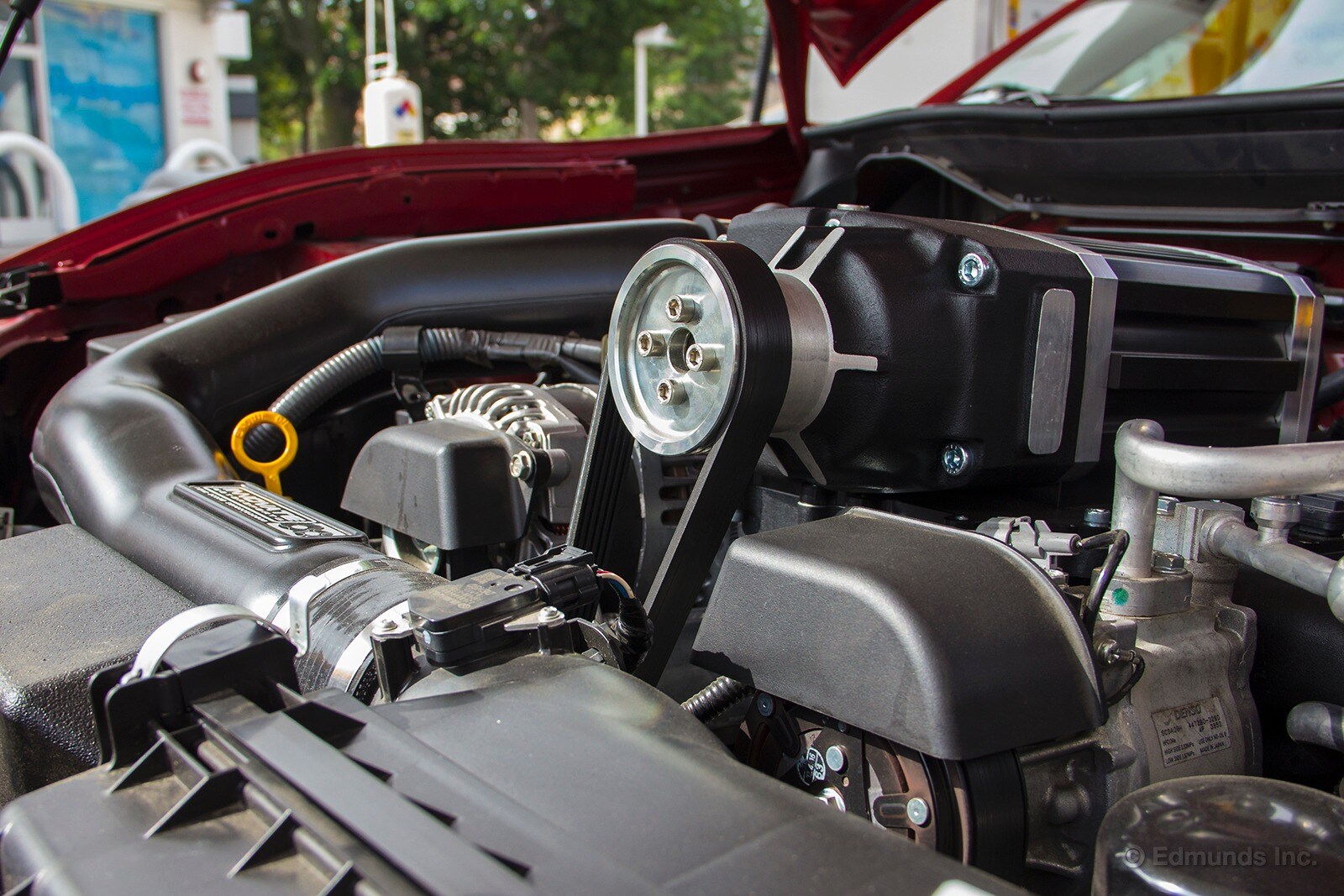
When we supercharged our long-term 2013 Scion FR-S, it did more than just change the driving dynamics. The car sounds different, too. There's a fun supercharger whine at wide-open-throttle, and the Greddy exhaust finally sounds like it should. Click through for a video.
When the car is at idle there's no discernible difference in sound. And even freeway speeds around 3,000 rpm there isn't any noise from the Innovate Supercharger (as expected). But when you bury your foot in the throttle the story changes entirely.
It takes a while to get used to the supercharger whine, but taking off from a stop light in the FR-S definitely puts a much bigger smile on my face now. For more photos and videos of our long-termers and much more, check us out on Instagram.
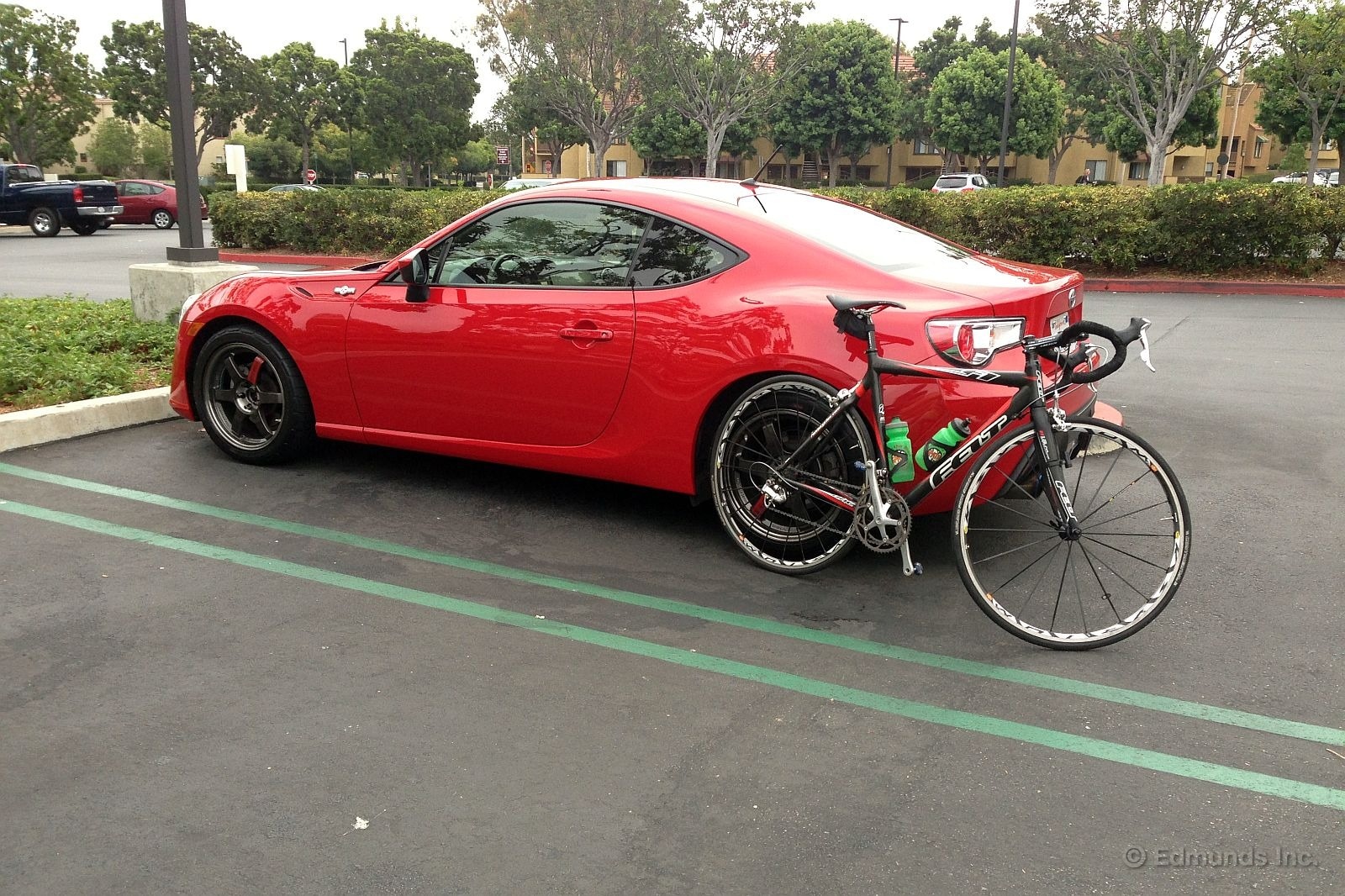
I needed to be at a group bicycle ride on the UCI campus at 6:15 this morning. Luckily I had our long-term 2013 Scion FR-S.
Lucky for two reasons:
Lucky Number 1: I was late (as usual) and needed to make up some time on the road. Thankfully, our newly-supercharged FR-S has some honest power now for squirting around traffic.
Lucky Number 2: Even though the FR-S is a small two-door sports car, the rear seats fold down and there's just enough room to squeeze a bicycle in through the trunk. Every time I put a bike in this thing, I'm kind of amazed.
Because it just doesn't look like it would be possible.
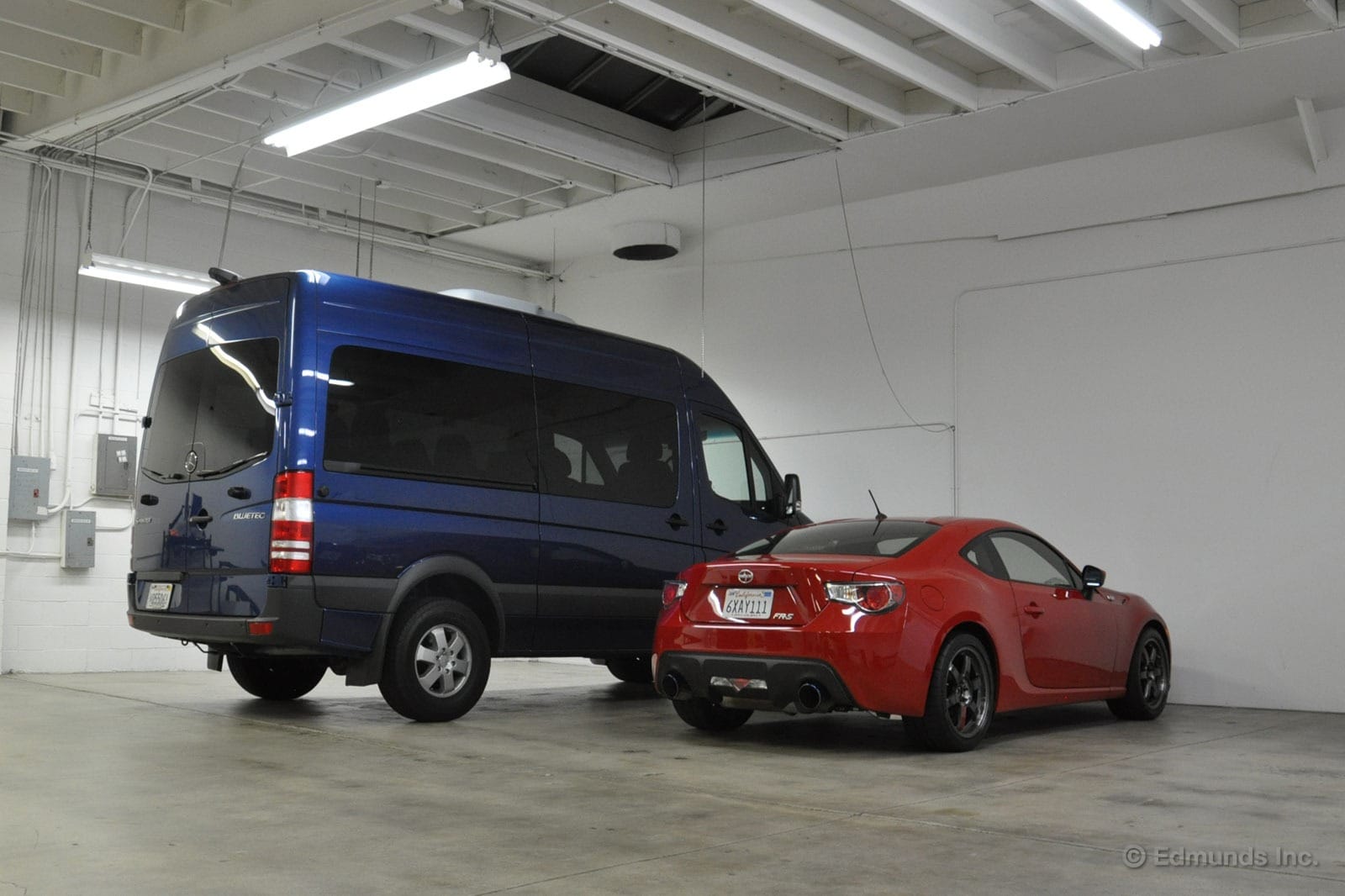
I've driven our 2013 Scion FR-S a handful of times since Jay Kavanagh installed the supercharger. You've read Mike Monticello's report on the car's heightened entertainment value on Angeles Forest Highway (one of our great roads in Southern California), and you've seen Jay put numbers behind the improvement in real-world acceleration.
And I'm here to tell you that, based on my own commuting experience, the difference is huge on the freeway. But the first time I drove our supercharged FR-S I actually managed to forget it had a blower. Allow me to explain. (The Sprinter passenger van is not part of the story. I just happened to drive both vehicles last weekend. What a difference in footprint, huh?)
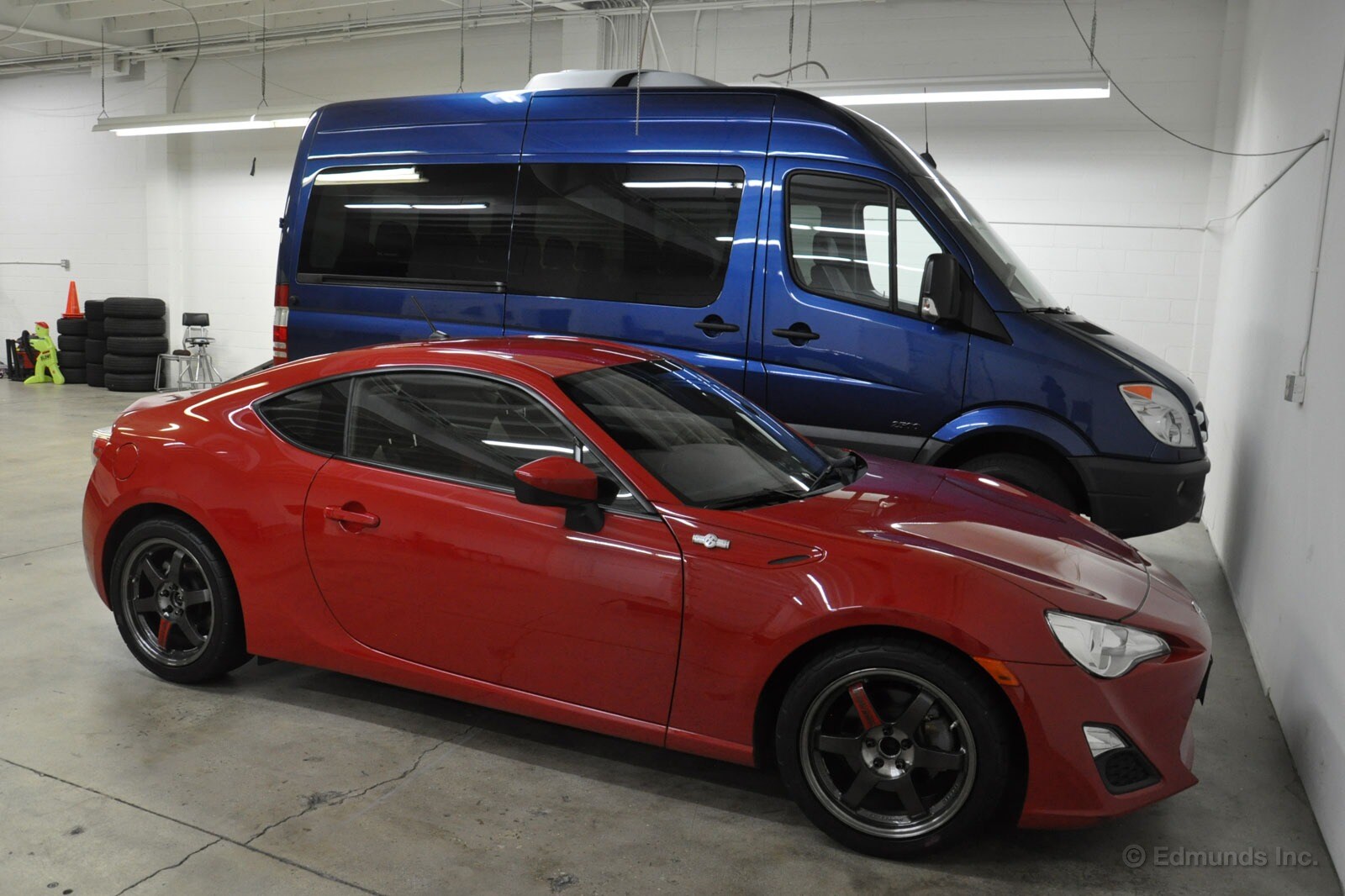
I think I first drove our supercharged Toyobaru on a Thursday evening, our worst traffic night of the week. It was after 9 p.m., but traffic was still kind of lousy. My mind was on that, plus whatever had been going on at work that day, and the Dodgers game on the radio. I wasn't even remembering that there was supposed to be something different about our Scion FR-S.
The sound system is weak in the FR-S, and I was vaguely aware that I was continually twisting the volume knob up to make out Charlie Steiner's play-by-play. "Man, this car is loud," I thought, "and tonight it's making some funny noises I don't remember. What's up with that?"
I also noticed the power wasn't coming on quite as smoothly as usual, nor were my shifts coming that smoothly, but like I said, there was traffic. So although I probably reached 65-70 mph at various points during the 25-mile drive, at no point did I use full throttle to get there.
Eventually, I reached my exit. The first major traffic light came up green and the road was clear, so I decided I'd make this right turn with some gusto. And lots of throttle.
And then, I heard this "WWHHHOAAAAHHHH!" and simultaneously felt our Scion's newfound shove. (Travis Langness made a video that gives you an idea of what this is like.)
"Oh, right, it's supercharged now!" I declared to the empty cockpit.
Our FR-S still isn't a fast car, but now it is satisfyingly quick in these situations. It's also great for cutting through freeway traffic, provided you don't forget to use the gas pedal appropriately. I don't forget anymore.
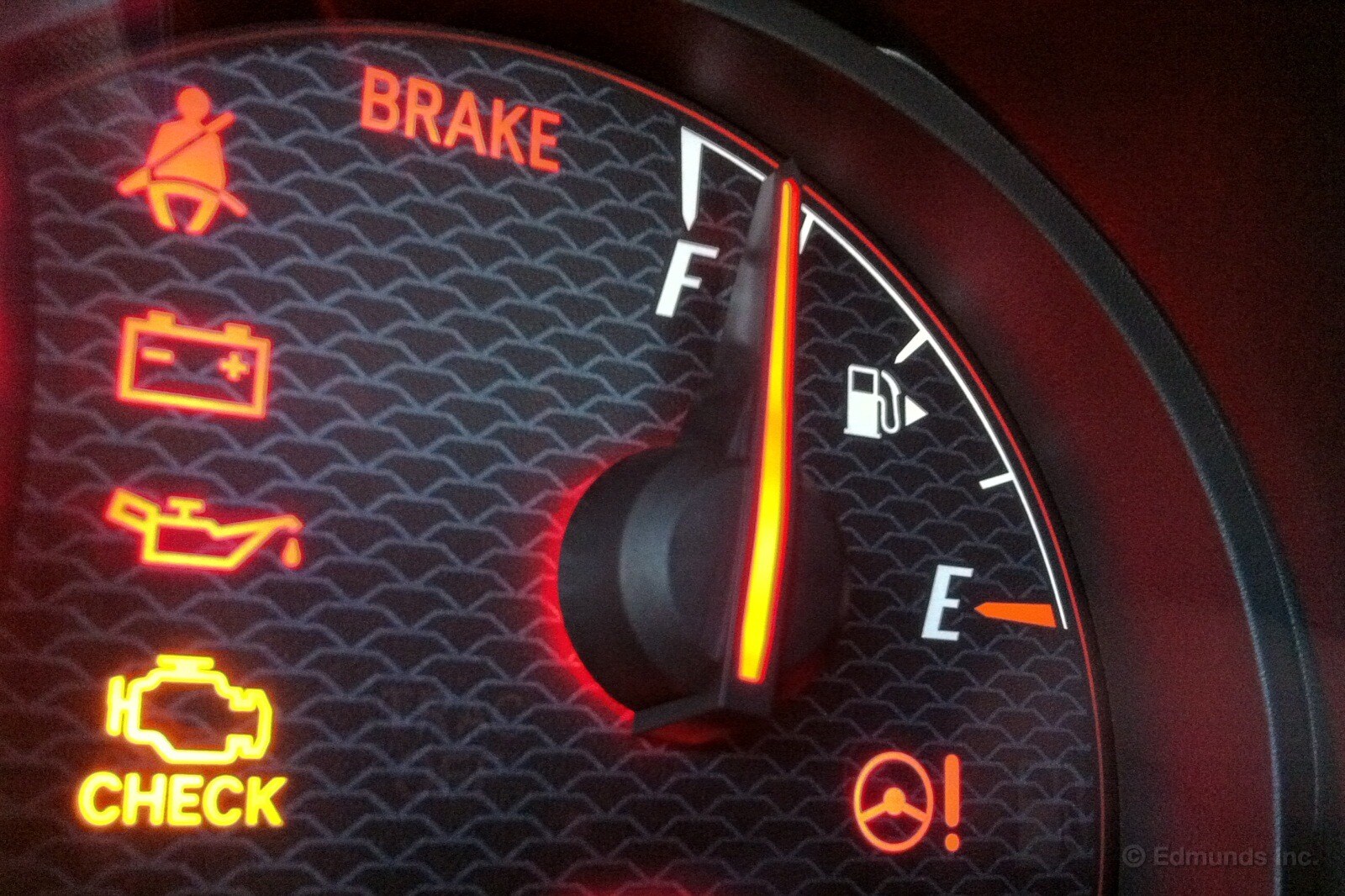
In the month of September, our long-term 2013 Scion FR-S spun an additional 1,067 miles onto its odometer and consumed 47.8 gallons of 91-octane fuel. That equates to 22.3 miles per gallon for the month, which is less than its lifetime average.
This month saw the lowest-mpg fill of its lifetime, which eroded its result for this month (and to a lesser degree, its lifetime average, natch).
Have boost; will hoon.
Worst Fill MPG: 16.4
Best Fill MPG: 30.0
Average Lifetime MPG: 23.7
EPA MPG Rating: 25 Combined (22 City/ 30 Highway)
Best Range: 335 miles
Current Odometer: 22,653 miles
Note: Cars are sometimes refueled before their fuel tanks are nearly empty. As such, "best" and "worst" fuel economy entries above are not necessarily the result of an entire tank's worth of driving.

At the end of August I drove our 2013 Scion FR-S home on dead Yokohamas and was quickly convinced that its stability control was a genuine ally.
Now, with the new BFGs, that's no longer the case.
The grip of the new tires has given the FR-S its manners back. No longer do I find myself activating the stability control at the slightest provocation. In fact, there's striking grip from a standing start. I suspect we will now fully realize the acceleration that was missing in our first test of our supercharged FR-S.
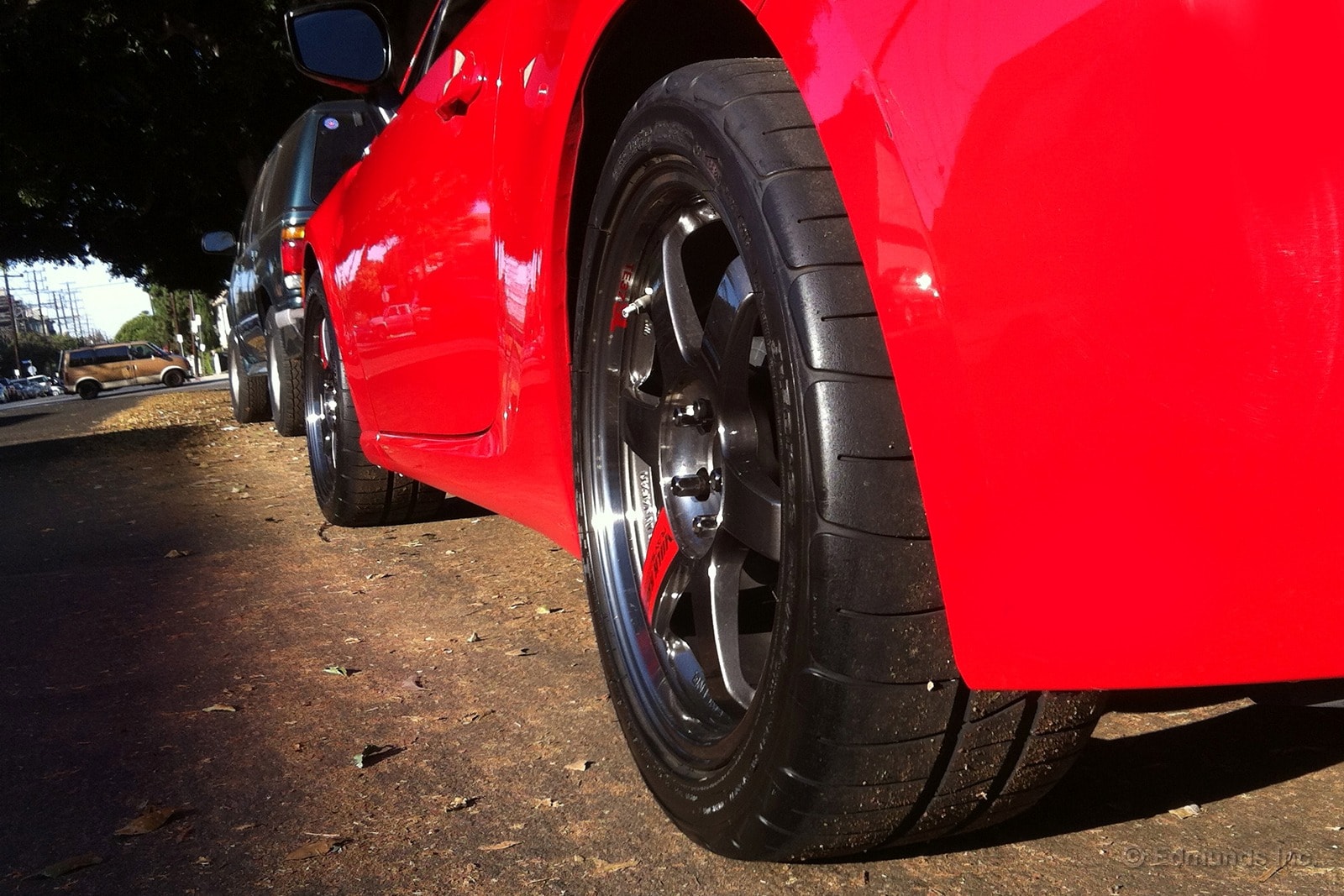
There's no doubt that the new G-Force Rivals we slapped onto our 2013 Scion FR-S are a huge improvement to the car's handling performance, and I do love cornering forces. But I'm finding myself torn between my penchant for railing through curves and whipping the tail around.
On my super-secret skidpad, I tried my usual lift-stomp of the throttle in the middle of a turn and all I got was wheelspin. No tail whip, no opposite lock, no giggles. I tried again. Wheelspin again.
It seems that once there's any lateral load, those tires just grip, you know, the way they're supposed to. And just like that, some of the magic was gone, replaced by real performance. Yes, our FR-S is all grown up now, and getting closer to being a real track car.
I'm sure that once I get to lay down some laps at a local road course, I'll be singing the praises of these tires. Until then, I'll be dreaming of swapping the rear tires out for the slippery stock rubber and powersliding my way into nirvana.

For the month of October we covered 1,144 miles in our long-term 2013 Scion FR-S with an mpg average for the month of 22.0 using 91-octane fuel.
That's below our lifetime average of 23.6, but there was an extenuating circumstance in the name of one Markus von Takahashi.
Takahashi decided to give the new BF Goodrich G-Force Rivals a workout, so he took the car on his favorite back-road loop and averaged a new low fuel economy number of 14.4 mpg for the 54-mile route.
But then, especially with supercharger, that's what this car is all about.
Worst Fill MPG: 14.4
Best Fill MPG: 30.0
Average Lifetime MPG: 23.6
EPA MPG Rating: 25 Combined (22 City/30 Highway)
Best Range: 335.1 miles
Current Odometer: 23,845 miles

"Want to drive it?"
Hook, swallowed. I was already halfway buckled into Innovate Motorsports' shop car before the company's Sean Crawford could finish getting the sentence out. Their FR-S shop car is equipped with the same twin-screw supercharger kit that's on our long-term 2013 Scion FR-S, but with a twist: The shop car's kit is intercooled.
In fact, the very car you see above was recently used to complete the CARB certification testing for both intercooled and non-intercooled kits at Automotive Research Center (the same place we ran our Raptor vs. leaf blower test). It passed with flying colors. Sean tells me that once CARB sends them the finalized paperwork in the coming months (thanks, bureaucracy!), they'll have an exemption order (EO) number for the kits. Pretty cool. Heh.
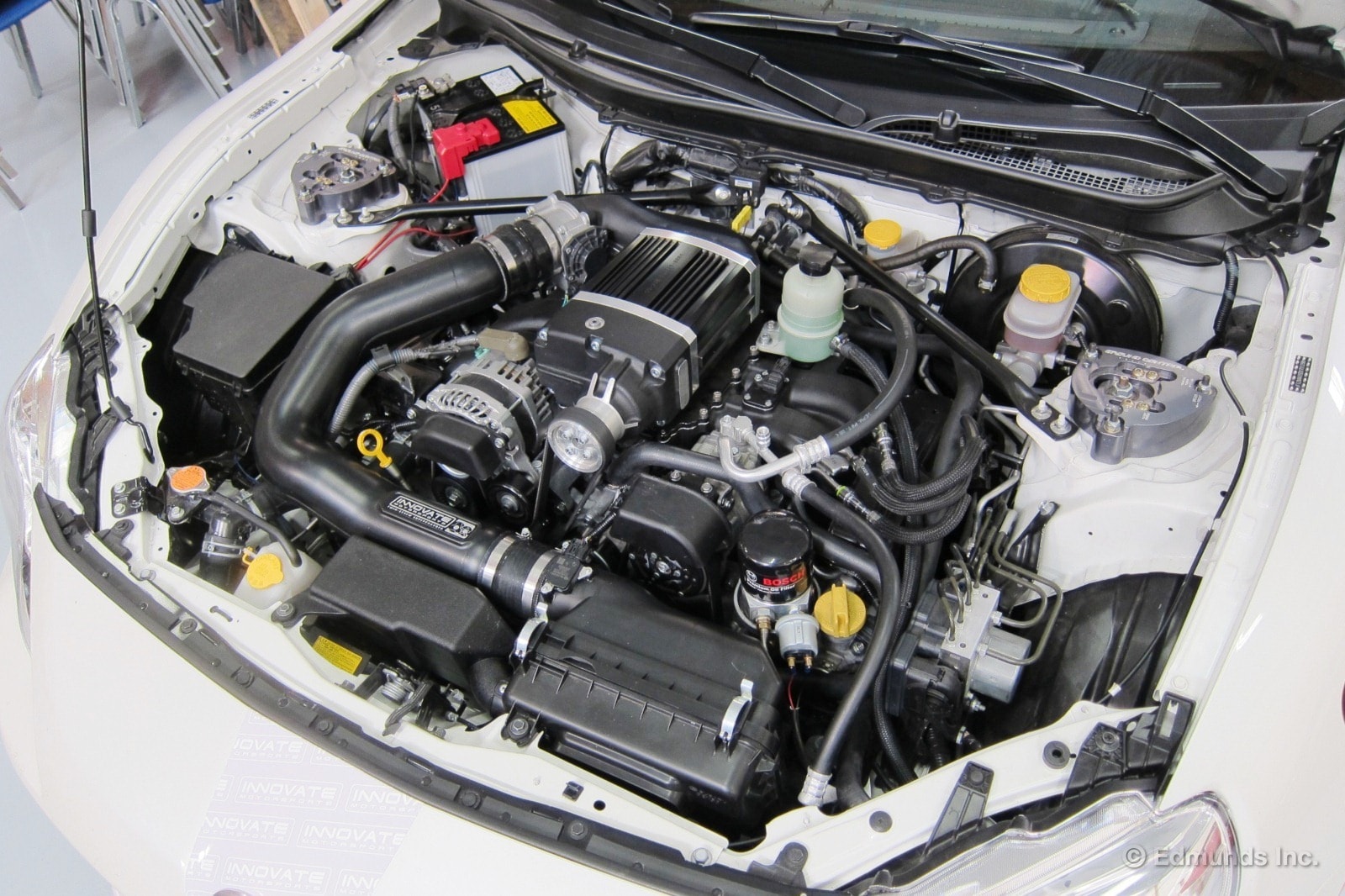
The intercooler kit is a liquid-to-air type. It comprises a Laminova core that drops straight into the Innovate Motorsports intake manifold, a low-temperature radiator, a reservoir, Bosch electric coolant pump, all required hardware and some really trick molded coolant hoses. Like all things about the Innovate Motorsports supercharger kit, the intercooler package is a high-quality, very straightforward install that can be done with simple hand tools.
Also, it can be had as a modular unit. You can buy the base kit like the one on our long-term FR-S and upgrade later to the intercooled version if you so choose.
With just the intercooled supercharger kit and a cat-back exhaust, the shop car currently churns out 245 horsepower and 200 lb-ft of torque at the wheels, roughly 30 to 35 hp more than the non-intercooled kit. Now we're talking. Oh, and that's on 91 octane, in (soon to be) smog-legal form.
By reducing the temperature of the supercharger's discharge air, the intercooler liberates more power, sure. But another benefit of the intercooler is consistency. It simply staves off heat soak, maintaining consistent power during extended full-load driving. Sean adds that the intercooler works so well that the kit can also safely use a smaller supercharger pulley for even more boost/power beyond what's on the shop car, even on 91 octane.
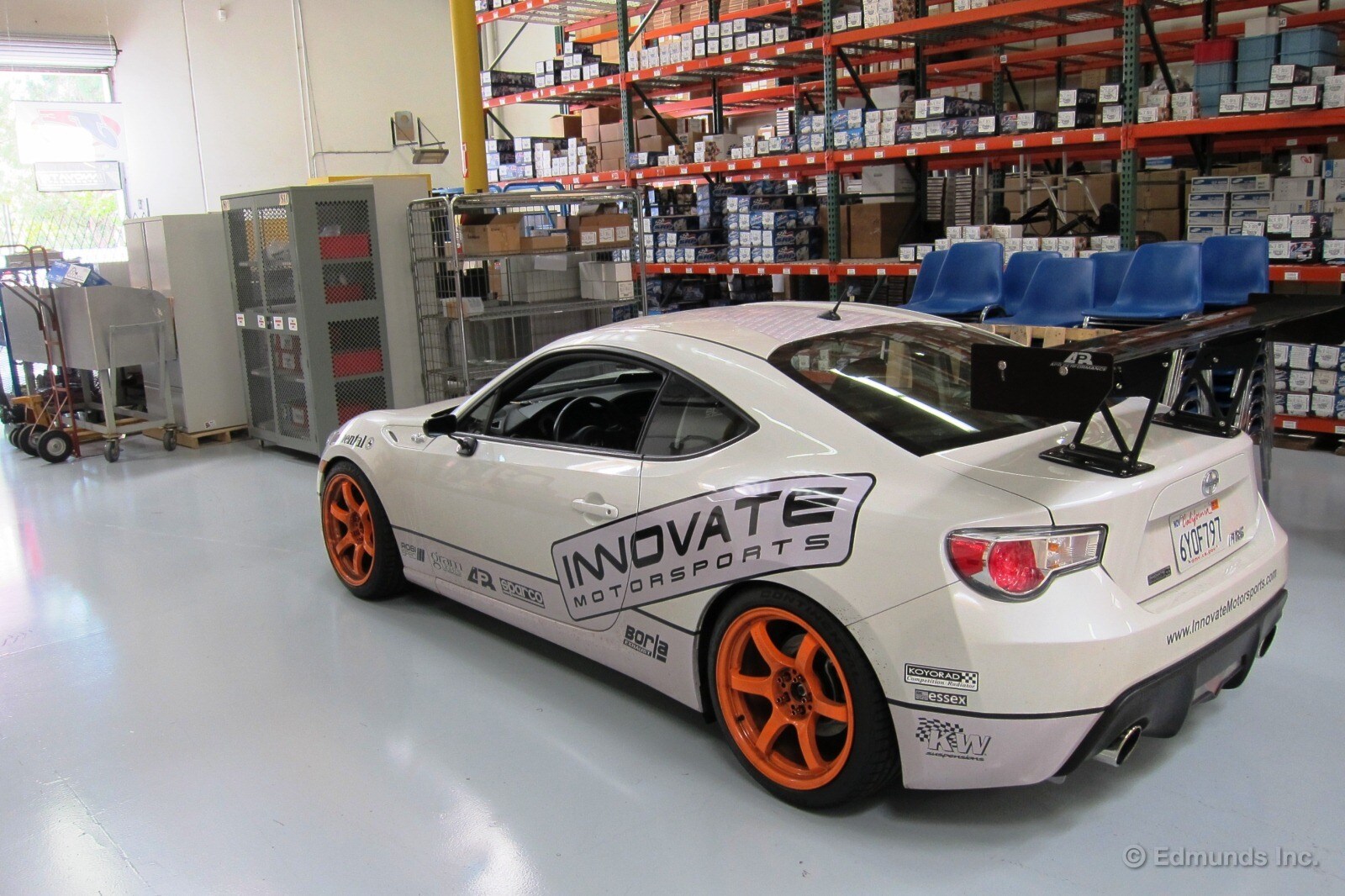
I warmed up the shop car's engine with some gentle driving and then turned off onto a closed course. Then I gave it the wood. Wow, yup, the additional urge is undeniable. It pulls with real authority all the way through the rev range, and it's sharp and totally predictable. The speed piles up deceptively quickly.
Whereas the non-intercooled kit gives the FR-S appropriate power, the intercooler gives it the kind of shove that really allows you to exploit the chassis. You can easily induce oversteer by doing no more than giving the throttle a good squeeze mid-corner. And there's enough sauce on tap to maintain the wheelspin and hold the slide all the way to corner exit.
Man, this is a fun car.
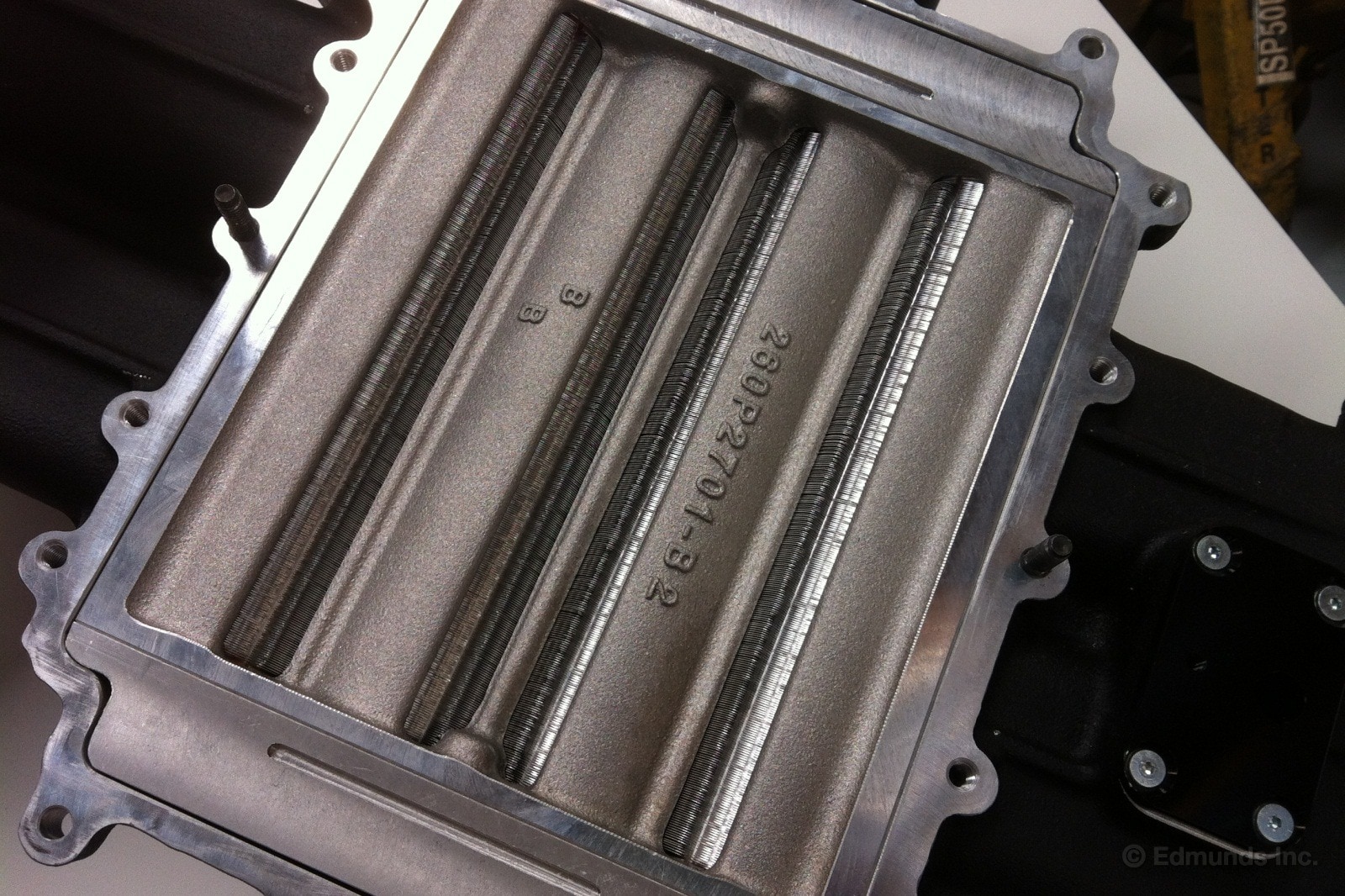
What's more, the part-throttle drivability is improved compared to our long-term FR-S. The company has refined the kit's ECU calibration since we got ours, for one. But another factor possibly contributing to the sharper throttle is the intercooled kit's reduction in throttled volume. See, the core takes up what is otherwise a big empty void in the intake manifold.
We'd do the intercooler upgrade on our long-term Scion FR-S in a heartbeat, if we had enough time. Yes, it's true, our year-plus with Project FR-S is soon coming to close. I'm really going to miss this car.
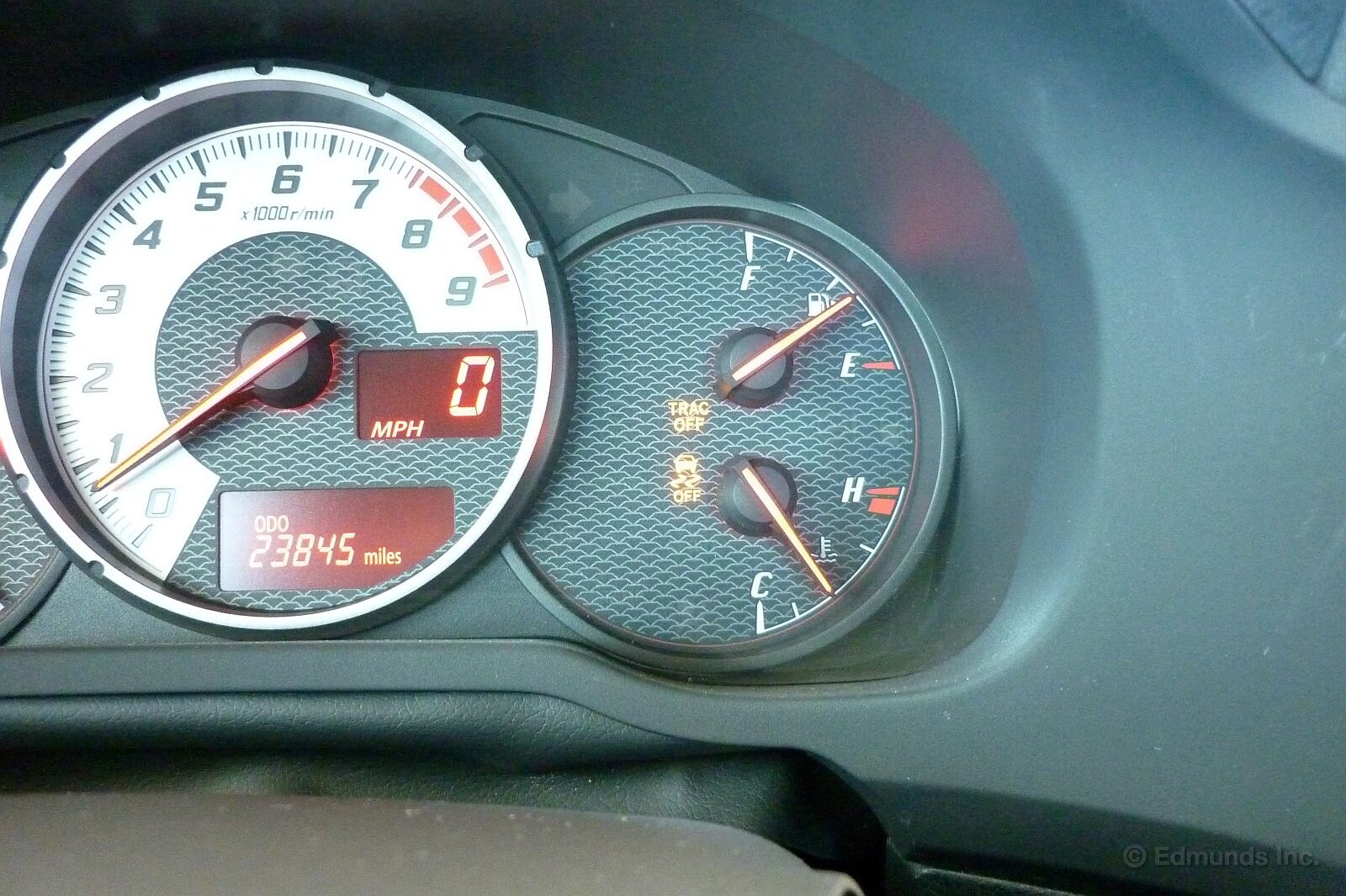
Notice anything missing from this photo of the 2013 Scion FR-S?
If you guessed "the arrow that points to the side of the car the fuel filler is on," you're right.
It's being perfectly hidden by the fuel gauge needle.
Here it is in this second photo.
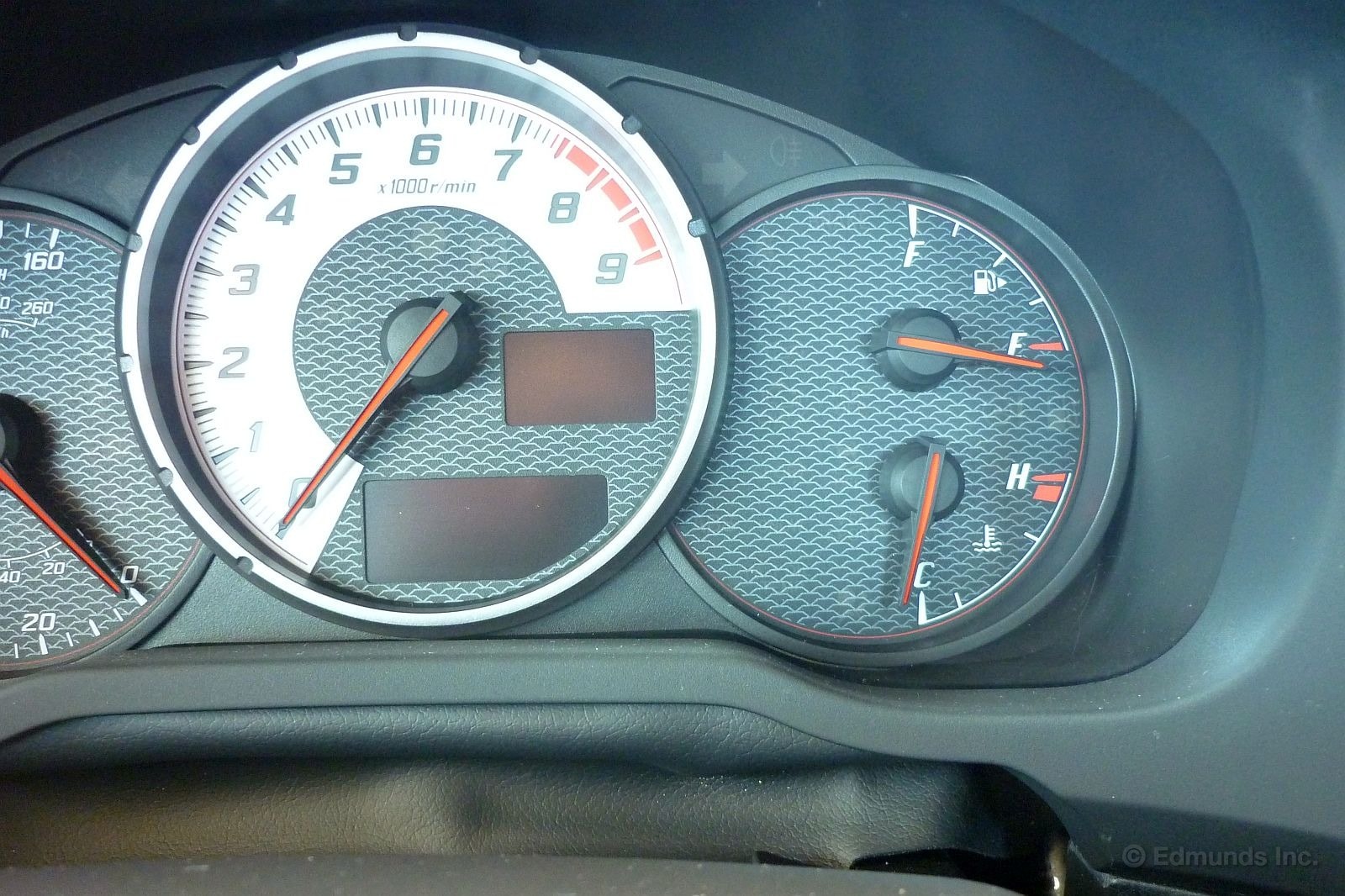
Most (but not all) cars are designed these days so that you can see the fuel arrow no matter where the needle is pointing.
Obviously, this is more important for folks like us who drive different cars all the time, but having a fuel arrow you can see is helpful to anyone as you pull into the station.
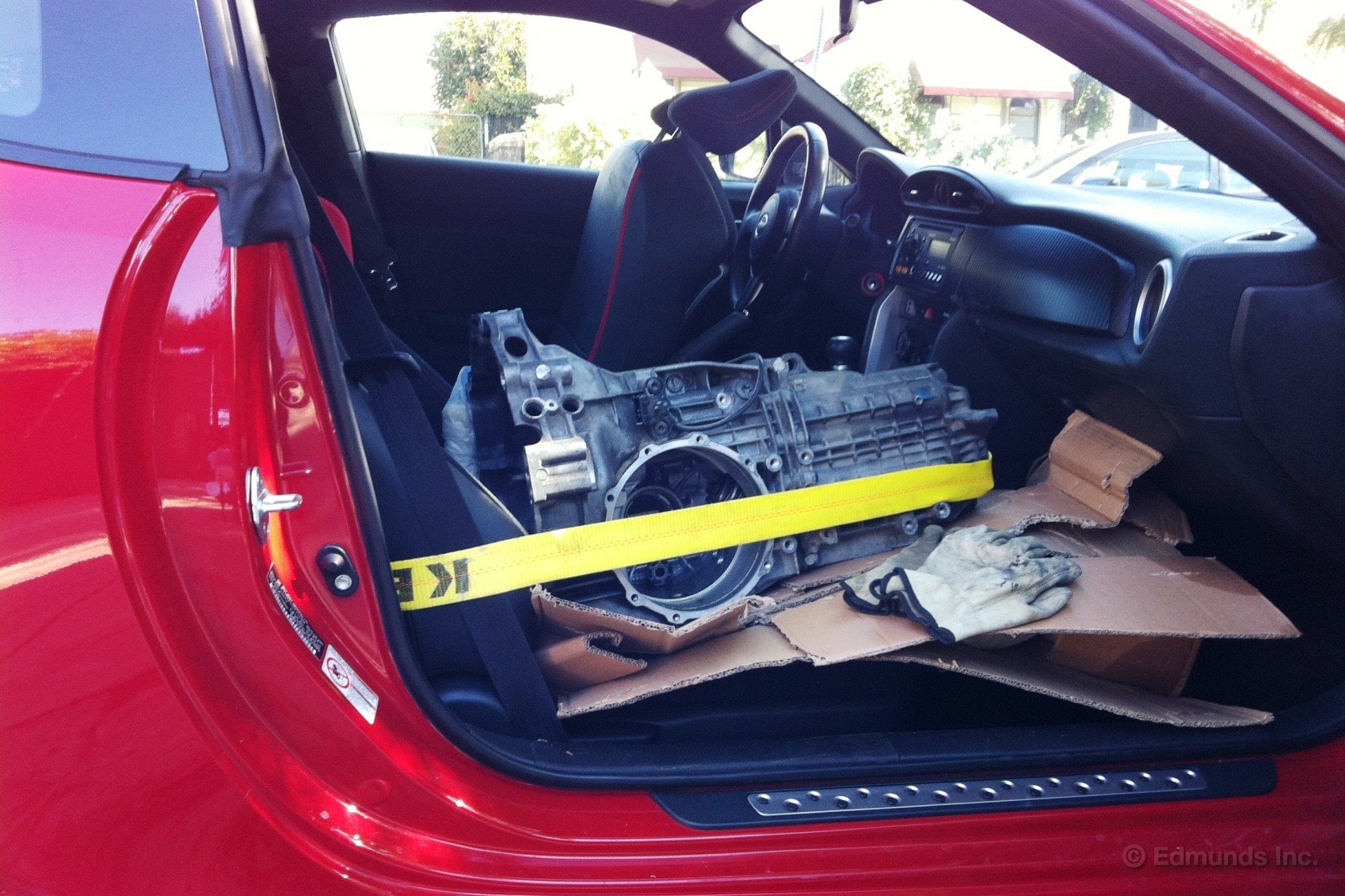
Not to worry, no Scion FR-Ss were harmed in the making of this post. I needed to measure the bellhousing features of this transaxle for a LeMons car I'm working on, which entailed schlepping it to a machine shop. I happened to have our long-term 2013 Scion FR-S at the time, so...does the gearbox fit?
Clearly, yes. I put down some thick cardboard and eased that sucker into the seat. It seemed happy. Then I threw some more between the bellhousing and the seatback, broke out a ratcheting tie-down strap and headed into the backseat.
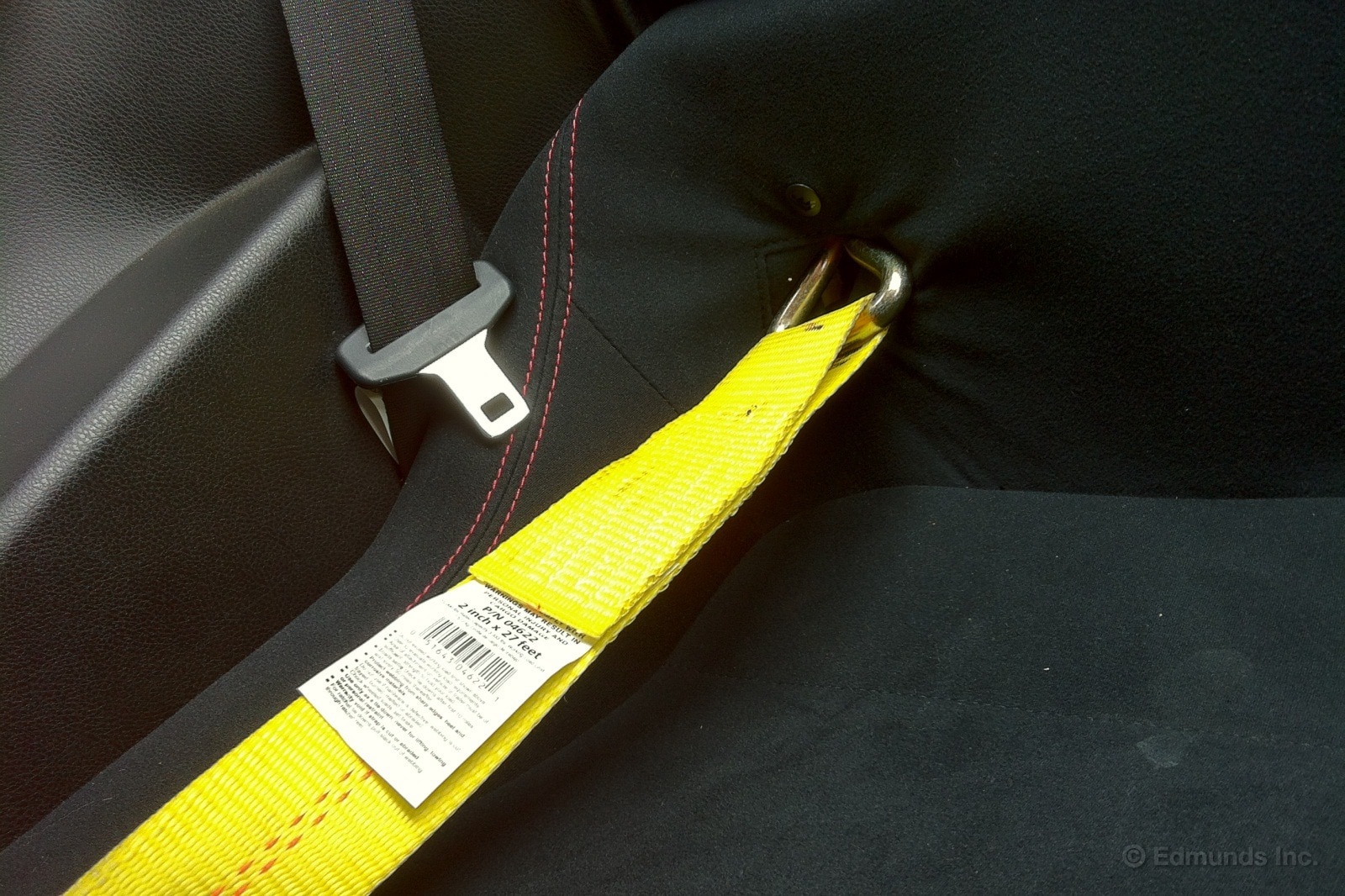
There, I hooked both of the strap's ends into the FR-S's LATCH baby-seat anchors in the rear seatback. A trashbag went over the transaxle before also buckling it in with the seatbelt. I wouldn't call it secure, per se, but with the doubled-up strappage it was somewhat restrained-ish. Managed to do the whole thing without the 'box ever directly touching any surface of the interior.
Also, don't do this. Please. It's a bad idea.
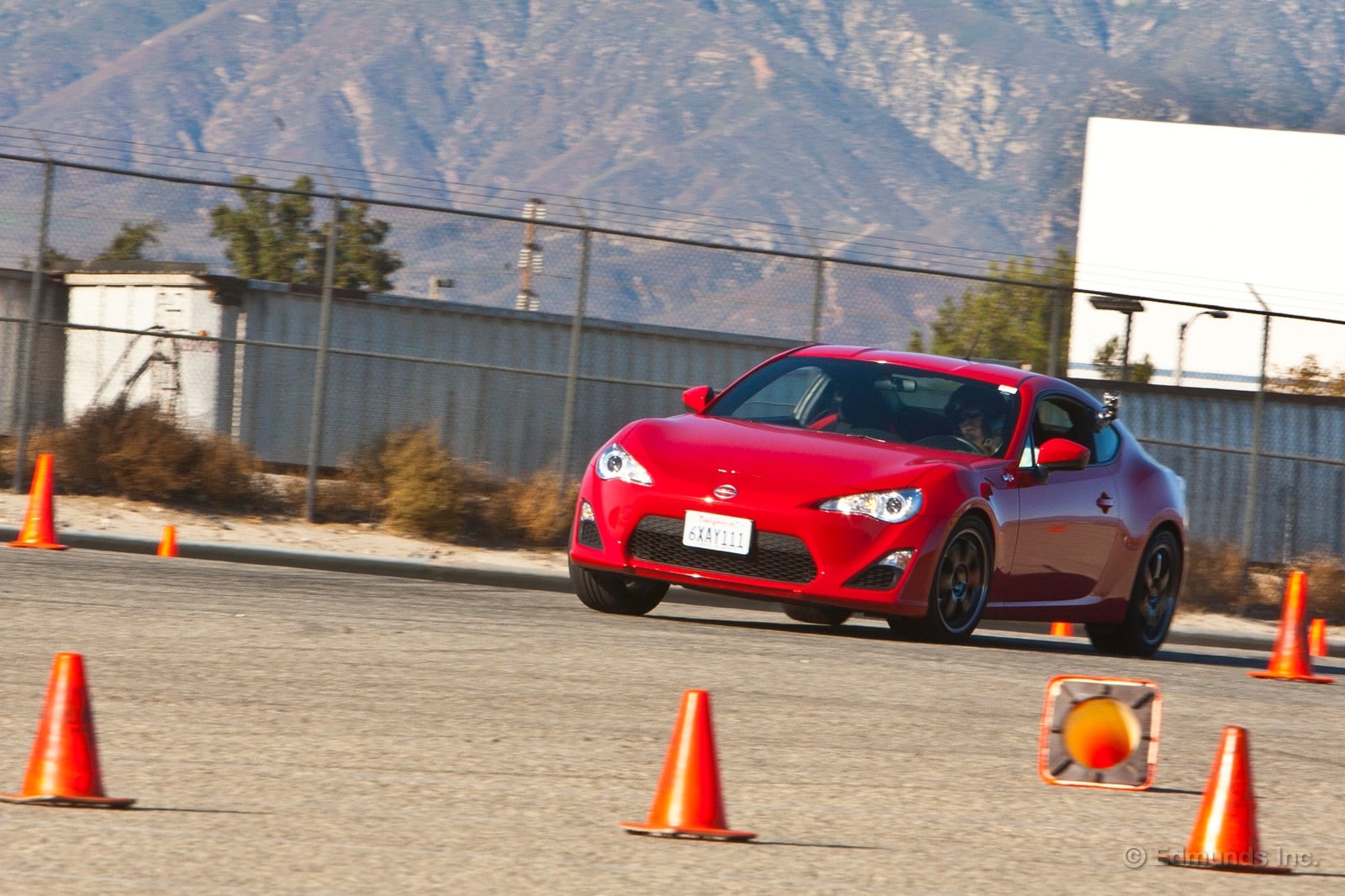
Our 2013 Scion FR-S's days are numbered in the long-term lot. It has served us well and I will miss it. I contend that it's the most fun you can have in the $25k range, and fun would be a priority for me if I were car shopping for myself. Click on through to see what about the FR-S I'll remember fondly.
Driving Dynamics: The FR-S has impeccable balance. The last car that I had this much fun in was the first BMW M Coupe.
The Stock Tires: No, they're not grippy, and that's the fun. You can get the tail whipping around without all that pesky horsepower and torque.
Styling: More than a year later, it still looks great. Sharp lines and classic sports car proportions.
Steering: Great feel and relatively quick. Just the right amount of power assist.
Pedal Placement: The gas and brake pedals are close enough for easy heel-toe downshifts. Much how I judge a Mexican restaurant by their carnitas, I judge sports cars by pedal placement.
Handbrake: It's one of the few cars that will actually lock up the rear wheels with a pull on the lever. It's important to me, okay? I'm told chicks dig it.
Seats: I logged a lot of time in those seats without going numb or becoming mean. Even more impressive is the amount of lateral support they provide without impeding entry.
Gauges: In particular, I like the tach/digital speedo arrangement. Both are instantly legible with a quick glance.
Stability Control: You can disable it on the fly and it's really truly off. Besides these likes, I also have a few fond memories that I hope will stick with me. When it was fresh to the long-term lot, I drove it on the Kulinary Mille. It was the least expensive car there, but its ability in the curves impressed plenty of other drivers. Then there was the Black Friday Autocross that Kurt Niebuhr and my sister joined me on. I couldn't beat Kurt's time in the Focus ST until I swapped out for stickier tires.
Yup, you can count me as an FR-S fan. A cousin of mine in Washington state bought one and he concurs. When it comes to bang for the buck, you'd be hard-pressed to beat it.
But...
Stay tuned for my list of things I won't miss.
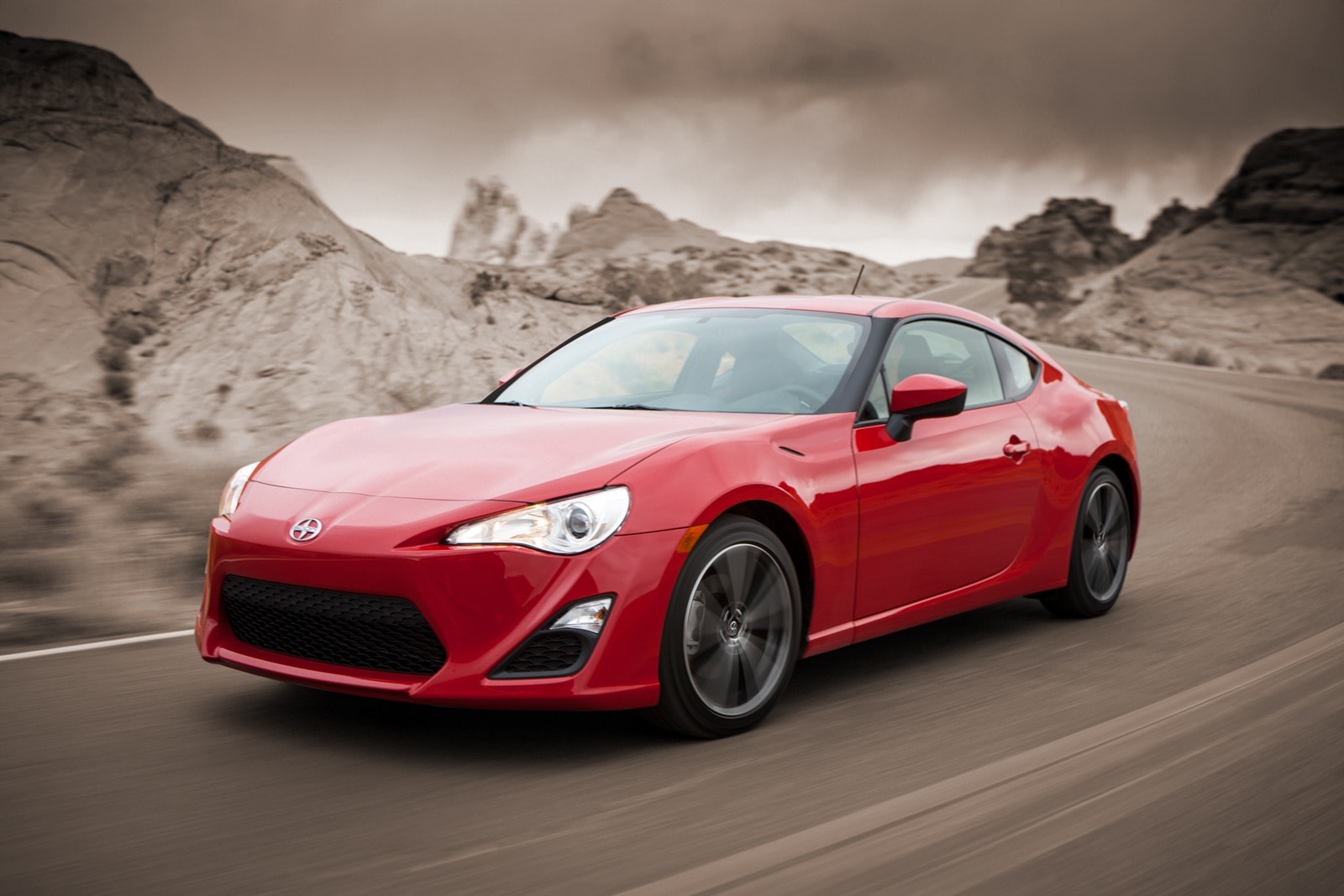
As a follow-up to my list of things I'll miss when we sell our long-term 2013 Scion FR-S, here are some items I will not miss.
Engine Sound: It doesn't sound good at all. Not even when we installed an exhaust system did it improve. It sounds like someone cross-bred a Cessna 152 with a leaf blower.
Lack of Brake Cooling: I wanted to put this car on the track. Badly. But the brakes would've overheated after two laps.
Audio Interface: The functionality was there, but thoughtful design wasn't. Buttons were small and poorly labeled and the display had all of the refinement of a 1970s-era calculator. To its credit, the Scion's head unit was vastly better than the Subaru BRZ's.
No Steering Wheel Buttons: I got grief for pointing this out last time, but I still think it needs wheel-mounted buttons, at least for the audio controls. Either that or make the main interface usable (see the above point).
Cheapo Clock: This must've been a leftover plucked from the Toyota parts bins. I think my 1982 Corolla had the same clock.
Passenger Seat Sensor: Don't put your cellphone on the seat. It triggers the passenger sensor and it starts beeping at you to fasten that seatbelt.
Shifter Knob: That plastic medallion with the shift pattern kept popping off. We really should have gotten that fixed.
Small Trunk: I don't normally haul a lot of stuff, but even the FR-S's trunk is small for my tastes. Before I knew anything about this car, I thought it was a hatchback, and that made way more sense to me.
Fake Carbon Fiber Interior Trim: You're not fooling anybody.
While it may seem that this list is longer than the things I like about the Scion FR-S, they in no way outweigh the positives. Most of these don't matter when you're using the car as it was intended.
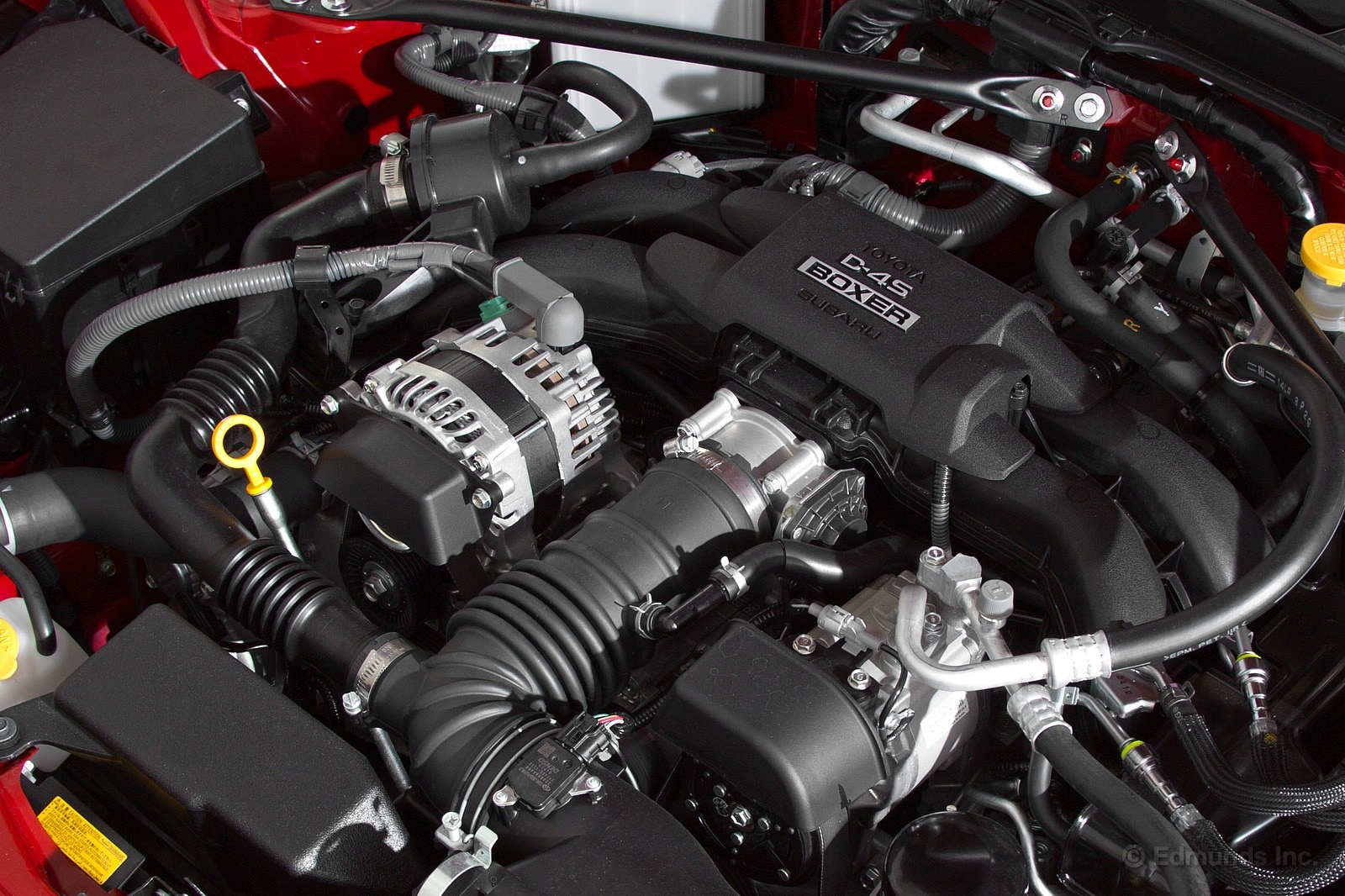
With the Innovate Motorsports supercharger stripped off, as well as the other fun bits, our 2013 Scion FR-S was a little unwanted through the month of December. I'll blame our editors' finicky obsession with power and their secret love of aftermarket exhaust for their lack of interest.
That being said, it still covered a little less than a thousand miles. Click through to see how it did in December.
While the major numbers stayed the same, the month saw us average 22.3 mpg. That's a bit below our year-long average, but I have a theory behind that difference. Sure, the supercharger used its fair share of fuel, but now that it's gone, we're having to tach the little motor out more often to make up for the loss in urgency. Whatever it is, this car is still a lot of fun.
Worst Fill MPG: 14.4
Best Fill MPG: 30.0
Average Lifetime MPG: 23.6
EPA MPG Rating: 25 Combined (22 city/30 Highway)
Best Range: 335.1
Current Odometer: 24,838 miles
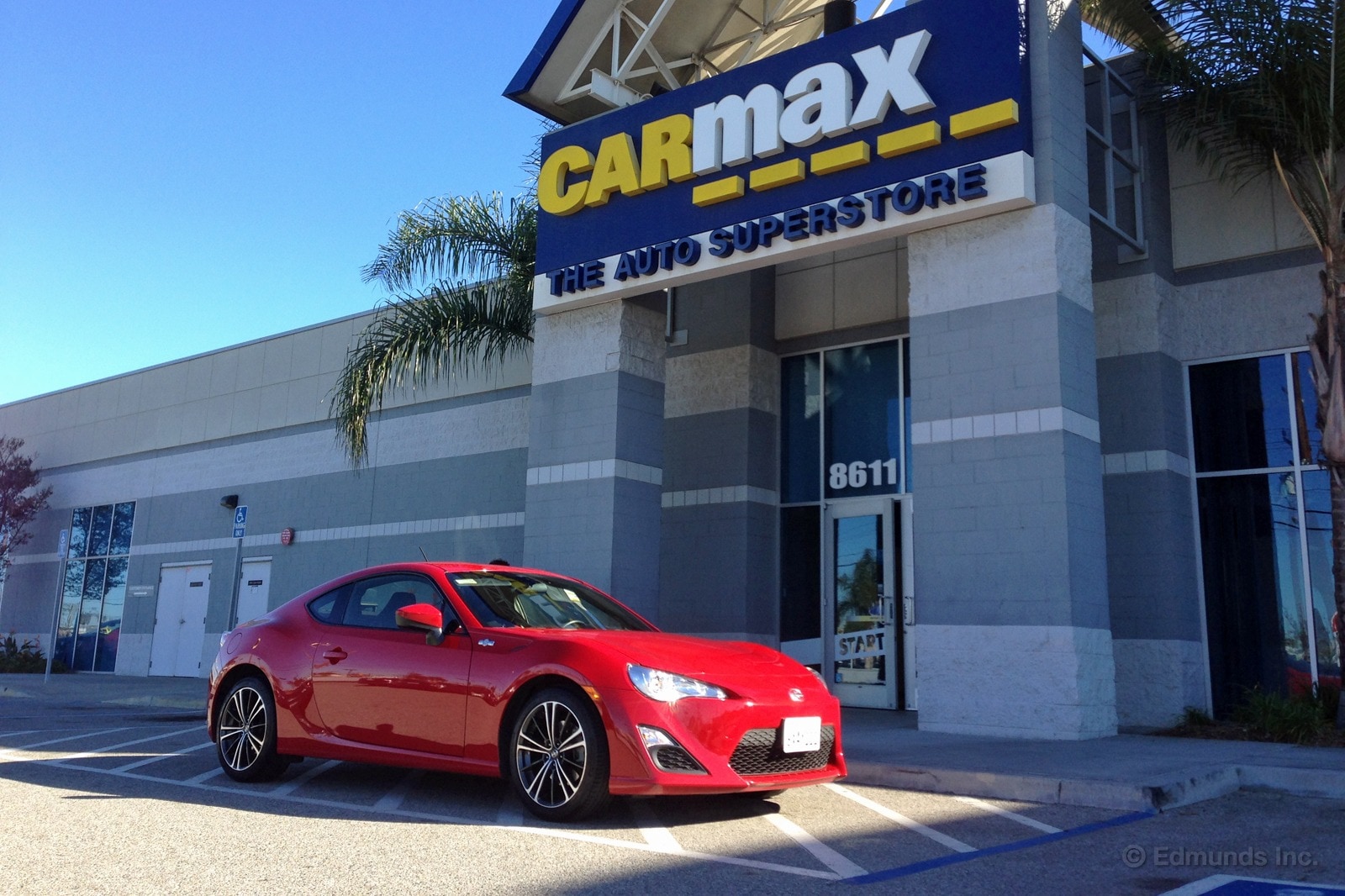
We kept our long-term 2013 Scion FR-S seven months and 5,000 miles longer than we normally do. It was a fun car to have around and as the 25,000 miles on its odometer showed, it wasn't often left to collect dust in our garage. But it's a new year, and we need some money back in our car-buying budget. This meant it was time to pay a visit to CarMax for appraisal.
"Do you have a figure in mind?" said Hamal, the appraiser. He recognized me and remembered the last car I brought in, our long-term Ford Focus ST.
"I have a number, but I'm keeping my cards close to the vest," I said. I was thinking about the saying, "He who speaks first loses."
Hamal told me that someone had recently traded in a red FR-S with about 10,000 miles. It sold in three days. I was originally expecting an offer of $17,000, taking into consideration the high miles on our FR-S. I thought they would impact its value. But when I heard that the other FR-S sold so quickly, I upped my guess to $18,000. For reference, we paid $24,930 (before tax and title) when we bought the car last year. Edmunds trade-in TMV is $18,831.
Before you hit the jump, take a guess on the offer.
CarMax said it would give us $19,000. It was a solid offer, so we took it.
Our Scion FR-S depreciated about 24 percent. Our fleet average is about 22 percent. If you're curious as to what this car would retail for when CarMax re-sells it, I found a white FR-S at a CarMax in Las Vegas, with the same miles, selling for $21,998.
And so the 2013 Scion FR-S leaves the fleet. Its ride was too firm for my tastes, but it was a fun car to drive and I'm glad we had a chance to test it.

Let's call it a knob cap.
Whatever it is, I fixed it. Before we sold it to Carmax. And yeah, some, if not all, of the tools pictured above were used in its repair. I'll let you ponder which of them I actually made use of, but suffice it to say they worked like a charm.
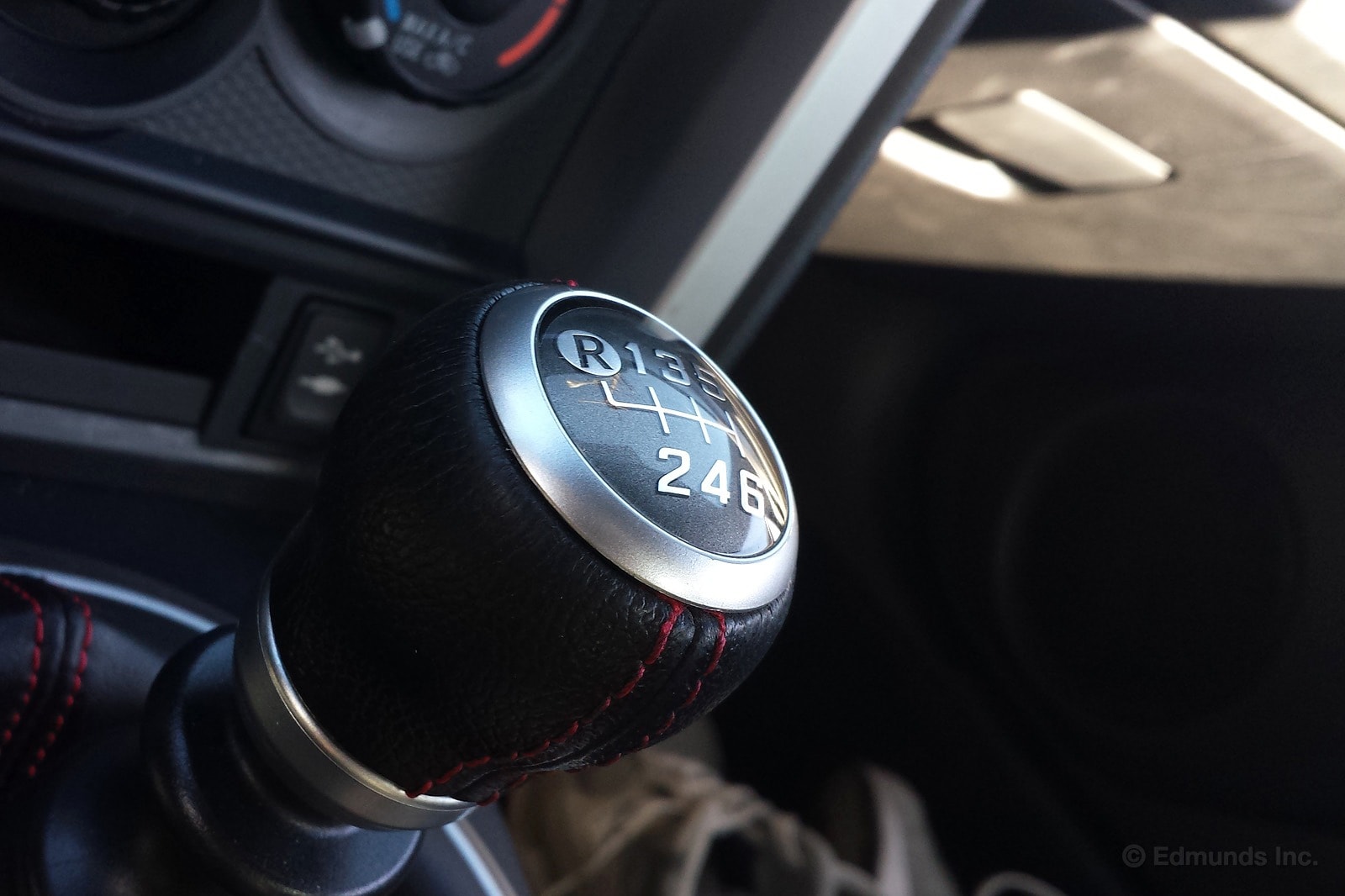
As you can see, the knob cap fits better than it did when it rolled out of the factory. It's also never coming off. Never.
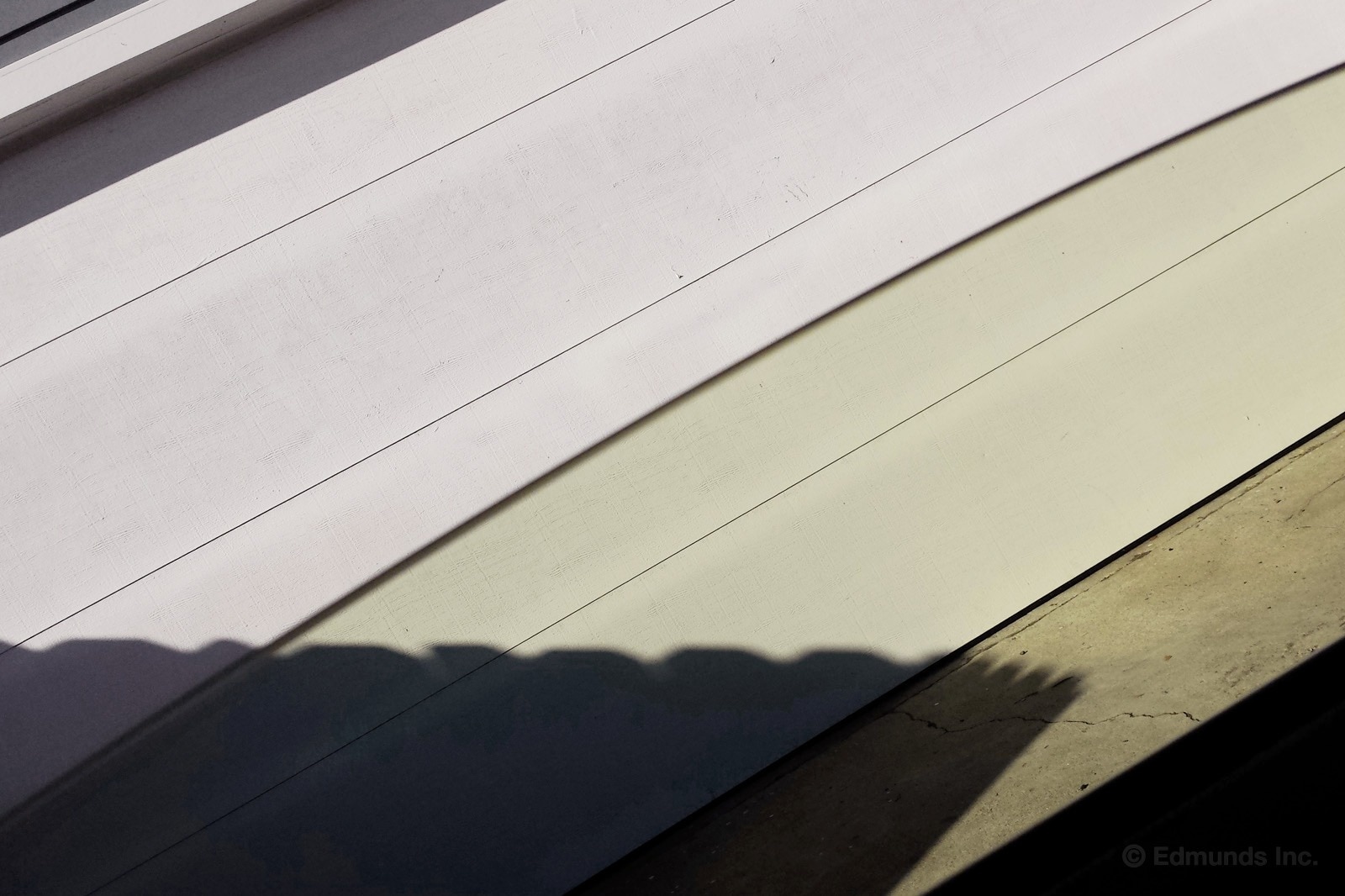
Yes, this car has been sold. But I have one more observation for you.
As a matter of course, I'm fairly tuned into colors, so I was rather surprised it took me so long to take notice of the factory tint on our 2013 Scion FR-S. It's yellow.
Most cars run a very light green or cyan tint, while others simply opt for neutral grey. As far as I know, the Scion is the only car with a factory yellow tint. Can you name another?
Wrap-Up
What We Got
A 2013 Scion FR-S was an obvious choice for our long-term test car garage. It was an all-new car in an all-new category for Scion. The fact that we already had its Subaru cousin in the form of the BRZ meant we also had some leeway to do something different. With that in mind we decided to do some aftermarket upgrades to the FR-S to see how much unlocked potential there was in this two-door sport coupe.
The process of shopping for an FR-S was simplified in that, aside from an automatic transmission, the available options were minimal. So we didn't get any. We found a Firestorm Red 2013 Scion FR-S with a manual transmission and paid sticker, $24,930. This price got us the standard interior appointments, 17-inch wheels, a Torsen limited-slip differential and the 200-horsepower, 2.0-liter boxer four-cylinder. With that, our test was under way.
Our Impressions
"I continue to be impressed with the handling of our FR-S. There's the sharp and perfectly intuitive steering fed to you via a wheel that feels so right in your hands. And the precision with which the suspension works as you attack corners...the FR-S is simply a blast to point through turns. Another part of the FR-S's back-road goodness is its forgiving nature. It telegraphs exactly what it's doing. You feel it through the steering wheel and the seat, so it's easy to understand what the car is up to as you shoot for those apexes. And yeah, the FR-S doesn't have a lot of power.... But that's OK. The FR-S's speed isn't just handed to you. You have to work for it by keeping your momentum up through corners. There's nothing wrong with having to work for something." — Mike Monticello
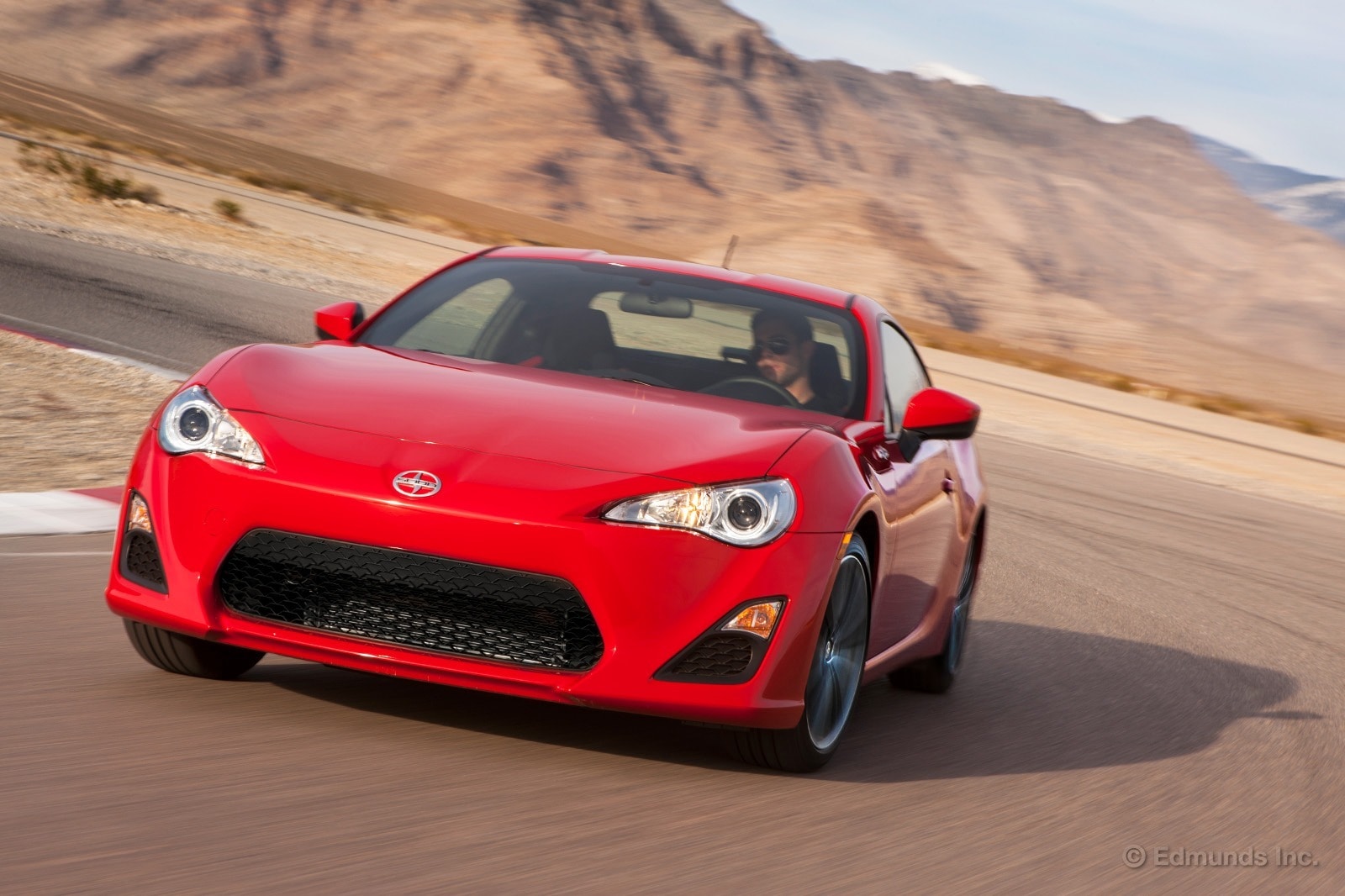
"This car is the real deal. Up until this past weekend, I'd only driven an FR-S for a few hours in Vegas, on track and in town for our Full Test. It'd made a strong impression, but there's no replacement for driving on familiar roads on your own time. This past weekend I had our long-term FR-S in my care and, unlike few real-world, attainable cars in recent memory, I didn't want to stop driving it. After a somewhat leisurely drive up Angeles Crest on Saturday with some friends, I made a more vigorous repeat trip on Sunday. It just works. The driving position, the terrific seats, the perfect pedal placement, the flat cornering, the quick steering.... It all comes together cohesively. Quite simply, there is nothing like this car anywhere near its price. I am smitten by a $25,000 Scion." — Jason Kavanagh
"What I will miss about the FR-S...Pedal Placement: The gas and brake pedals are close enough for easy heel-toe downshifts. Much how I judge a Mexican restaurant by its carnitas, I judge sports cars by pedal placement. Handbrake: It's one of the few cars that will actually lock up the rear wheels with a pull on the lever. It's important to me, OK? I'm told chicks dig it. Seats: I logged a lot of time in those seats without going numb or becoming mean. Even more impressive is the amount of lateral support they provide without impeding entry. Gauges: In particular, I like the tach/digital speedo arrangement. Both are instantly legible with a quick glance." — Mark Takahashi
"...the Advan Neova rubber on our FR-S is sufficiently heat cycled to have lost much of its grip. Let me clarify: Those tires are fried.... In addition to slowing straight-line acceleration, lateral grip is compromised. Combine the reduced lateral grip with a torque-abundant power delivery and the FR-S can be a little exciting in the most normal of situations. I find stability control to be a faithful partner now." — Josh Jacquot
"I drove our FR-S home on dead Yokohamas and was quickly convinced that its stability control was a genuine ally. Now, with the new BFGs, that's no longer the case. The grip of the new tires has given the FR-S its manners back. No longer do I find myself activating the stability control at the slightest provocation. In fact, there's striking grip from a standing start. I suspect we will now fully realize the acceleration that was missing in our first test of our supercharged FR-S." — Josh Jacquot
"The extra power from the Innovate Motorsports supercharger made the drive up Angeles Crest much more interesting than it would've been in stock form. Uphill on mountain roads was never the car's strong suit and that has largely been rectified. But the supercharger install has brought on some low-speed drivability issues. The kind of issues that when you're at full song, you never, ever notice. It's mostly just at takeoff from a stop. There's some occasional jerkiness to the throttle delivery as you get going, and it can make the FR-S hard to drive smoothly. I imagine with a little work this can be tuned out. Plus, it's not enough of a nuisance to make me want to stop driving this car." — Mike Monticello
"I returned home from my weekend at Mazda Raceway Laguna Seca with our FR-S and swapped its tracky brake pads back for the stock ones.... I noticed signs of what I experienced while on track, that the brakes got rather hot. See the melted driver side front caliper dust boot.... This happened with stock power and street tires. Though it is true that Mazda Raceway Laguna Seca is a track that's hard on brakes, more power and/or stickier tires would exacerbate the brake heat situation considerably. There's not a lick of air that makes its way to the FR-S's brakes. There are no vents in the wheelwell liner, and the little spat that deflects air away from the front tires also deflects air from the brakes. It's also got pillar-vane-style rotors, which have generally poor airflow pumping characteristics." — Jason Kavanagh
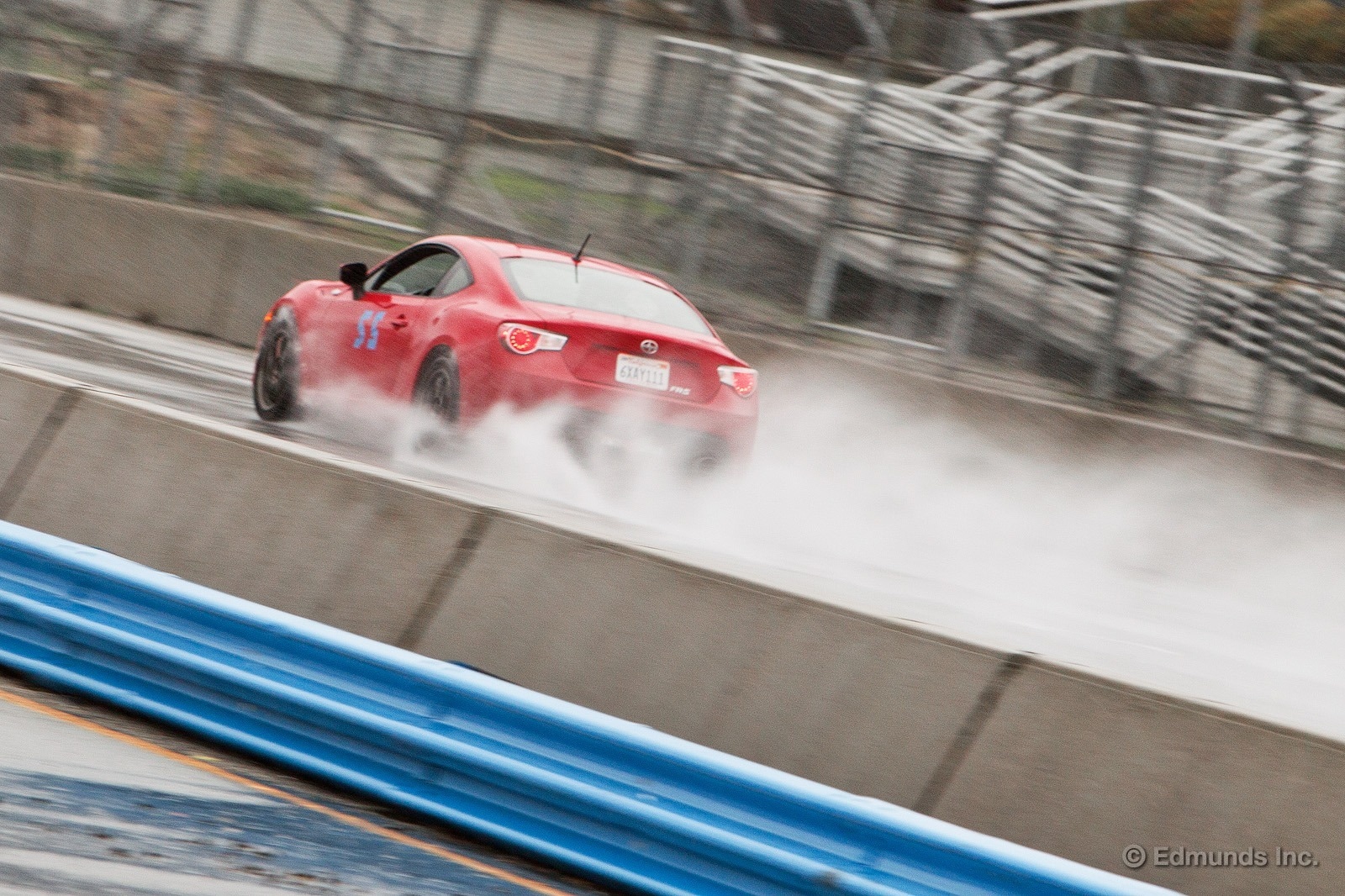
"A year later, I'm still enamored by our long-term FR-S. As a track car and, to a lesser degree, a commuter, I'd definitely consider this as a purchase. But that's because I don't take a lot of road trips.... The Scion makes quite a racket. The engine is loud and not at all refined, road noise permeates every recess of your skull and the wind noise is like listening to radio static. While I wouldn't characterize the ride quality as harsh, the suspension does contribute to some fatigue. Of course, none of that matters if you have a helmet on and you're fighting for a good lap." — Mark Takahashi
"Don't plan on sitting behind me when I'm driving the FR-S. The front seatback touches the rear-seat cushion. I could slide my seat up a notch or three for you, but there's no point. That's not enough to do anyone any good. To me it looks like the driver would have to stand well under 6 feet tall before an attempt to carry someone in the seat behind would stand the slightest chance of success.... For me the FR-S is a two-seater, plain and simple." — Dan Edmunds
"After a 12-year absence, I've decided to take up golf again.... I figured the FR-S could hold my ridiculously large bag, and it did, but just barely. I bought a new set of Callaway irons and a 3 wood a few weeks ago. I did not buy a driver because they're evil and should be destroyed. As it turns out, it's a good thing I didn't get one, because it would not have fit in the trunk of the Scion." — Mark Takahashi
Maintenance & Repairs
Regular Maintenance:
The Scion requested routine service at 7,500-mile intervals. The excellent reliability of our FR-S meant that we saw the dealer only three times during 25,000 miles of testing. Thanks to the two-year or 25,000-mile complimentary maintenance program, we paid nothing for these visits.
A broken shifter cap was the only mar on an otherwise spotless record for the FR-S. And even that was a simple DIY fix.
Service Campaigns:
Just one service campaign, for an ECM reflash, was issued during our test. This was a minor adjustment to meet California Air Resources Board (CARB) standards, and we had it performed during the 15,000-mile service.
Fuel Economy and Resale Value
Observed Fuel Economy:
EPA estimations for the manual transmission FR-S were 25 mpg combined (22 city/30 highway). Over the first 19,000 miles we averaged 24 mpg overall. Our best single tank garnered 30 mpg and covered 335 miles.
The final 5,600 miles of our test were supercharged. We averaged 22 mpg during this stretch, with a best tank of 28 mpg. The farthest we reached on a single tank of gas was 282 miles.
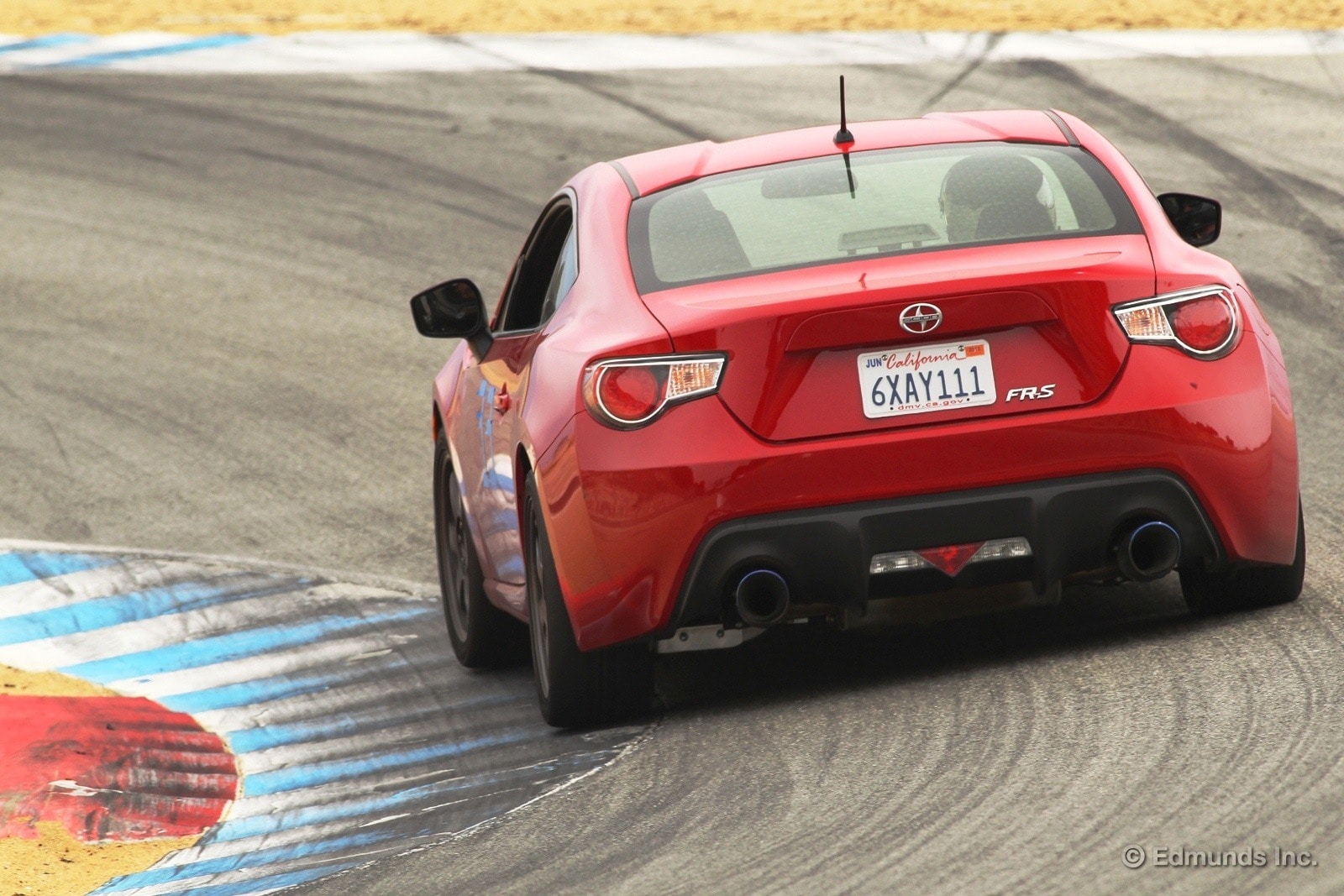
Resale and Depreciation:
Our 2013 Scion FR-S cost us $24,930 18 months ago. According to Edmunds' TMV® Calculator, it was now worth $20,173 based on a private-party sale. The Scion wore a "For Sale" sign for a stint before we ventured to CarMax. They offered us $19,000. This was ultimately a good deal for us. We signed it over and noted the 24 percent depreciation in our log books. For reference, our long-term BRZ depreciated 16 percent.
Summing Up
Pros: Lots of fun on a track and nearly as fun on the streets; great driver seat; free scheduled maintenance; chassis and engine welcomed performance upgrades.
Cons: In stock form it has average power for a sports car; stock tires offer minimal grip; small trunk; loud interior; radio controls are very basic.
Bottom Line: The 2013 Scion FR-S makes driving fun, even in stock form. It handles the needs of daily use, though it is most comfortable on canyon roads or on a track. Performance mods offer a glimpse of its true potential.
| Total Body Repair Costs: | None |
| Total Routine Maintenance Costs: | None (over 18 months) |
| Additional Maintenance Costs: | None |
| Warranty Repairs: | None |
| Non-Warranty Repairs: | None |
| Scheduled Dealer Visits: | 3 |
| Unscheduled Dealer Visits: | None |
| Days Out of Service: | None for normal maintenance |
| Breakdowns Stranding Driver: | None |
| Best Fuel Economy NA: | 30.0 mpg |
| Worst Fuel Economy NA: | 16.9 mpg |
| Average Fuel Economy NA: | 24.0 mpg |
| Best Fuel Economy S/C: | 28.4 mpg |
| Worst Fuel Economy S/C: | 14.4 mpg |
| Average Fuel Economy S/C: | 22.3 mpg |
| True Market Value at service end: | $20,173 (private party sale) |
| What It Sold for: | $19,000 |
| Depreciation: | $5,930 (24% of paid price or original MSRP) |
| Final Odometer Reading: | 25,175 miles |
Edmunds purchased this vehicle for the purposes of evaluation.